Travels with Erica
A Solo Traveller's Guide to the World

What I Wish I Knew Before Taking a Solo Trip to Japan
This post may contain affiliate links. If you click on my affiliate link and purchase something (at no additional cost to you!), I may earn a small commission that helps me keep the blog running. Thank you so much for your support!
Japan is one of the most popular tourist destinations in the world. Most people dream of going to Japan, but there are a few important things you need to know before planning a solo trip to Japan.
Compared to lots of other Asian countries, Japan is super easy to travel in and great for people who are new to travelling alone .
Don’t get too confident yet though because there are tons and tons and tons of mistakes I made when I was in Japan solo, and I’ve been travelling alone since 2015.
Japan is unique. Things that typically hold true for travel in other parts of the world don’t always hold true in Japan. Even things that work in Japan’s neighbour South Korea don’t necessarily work in Japan.
So, I’m going to share everything I learned on my solo trip to Japan with you to hopefully save you some mistakes.
Actually, at this point, I’ve been to Japan three times and feel like I definitely know what mistakes not to make. I’ve made nearly every mistake you can.
Let’s get into the nitty gritty of solo travel in Japan! Hopefully by the end of this article you’ll feel confident and prepared and be able to travel in Japan solo like a pro.
Table of Contents
Stay Near the Main Train Station
The biggest mistake I made on my first solo trip to Japan was not staying near a major train station.
I know when you travel to most countries around the world, you don’t really have to stay near a major train station. As long as you’re near some sort of public transportation, you’re good to go.
That isn’t the case in Japan.
If there is only one thing you take away from this post, it is that you need to stay near a major train station. Ideally, about a ten minute walk away. That way you’ll be super close to the train station but far enough away that it’s quiet.
Most Japanese cities have one major train station. It’ll typically be the name of the city followed by the word station. Like Osaka Station or Kyoto Station of Fukushima Station. You get the point.
Tokyo is a huge city. Huge doesn’t even describe it. Since it’s so large, there are many major train stations.
The two I recommend staying near are either Tokyo Station or Shinjuku Station . They’re pretty central and have access to lots of different metro and JR lines.

Why is it Important to Stay Near a Major Train Station?
There are two main reasons it’s important to stay near a major train station:
- Access to lots of different metro and JR lines so getting around is quick and easy
- Lugging luggage around on Japanese metros is a hassle. Even if you only have a carryon bag, the trains are often crowded and have lots of stairs. Staying near a major train station means you can just leave the train station and easily walk to your hotel or Aibnb and avoid having to transfer to the metro, JR, or bus to get to your hotel.
Trust me. It’s 100% worth it to stay near a major train station even if it means you have to pay a little bit more for your accommodation.
It is the one tip I give everybody when they’re planning a trip to Japan. Whether it’s a solo trip to Japan or a group trip to Japan.
My Favourite Hotels Near Train Stations
- Tokyo Station: Via Inn Prime Nihonbashi Ningyocho
- Shinjuku Station : Hotel Sunroute Plaza Shinjuku
- Kyoto Station : Hotel Kanra Kyoto (definitely a splurge but worth it!)
- Osaka Station : Hotel Monterey Le Frere Osaka
- Kanazawa Station : Hotel Resol Trinity Kanazawa
Get Outside Tokyo and Kyoto
On my first solo trip to Japan, I only went to Tokyo , and that was a big mistake. Tokyo is nothing like anywhere else in Japan. It’s extremely busy, hectic, and overwhelming.
Kyoto is the next most popular city in Japan for tourists, and I honestly found it a big overrated. Please don’t crucify me for that!
I think that one of the best things you can do when in Japan solo is get outside these two major tourists hubs and see a little bit more of what Japan has to offer.
Osaka is super close to Kyoto, and it has a totally different vibe to Tokyo and Kyoto. It is way more relaxed and laid back and has a lot of interesting tourist attractions. Including Universal Studios Japan !
The food in Osaka is also top notch, and it’s known as the foodie capital of Japan.
If you visiting Kyoto is your dream because it looks beautiful and full of ancient temples and things to do, I recommend visiting Kanazawa.
It’s everything I thought Kyoto would be and more. Kanazawa is my favourite city in Japan and one I wish more tourists visited. Plus it’s way more affordable than Kyoto, which is a huge plus for solo travellers on a budget.
I don’t really care where you go, but I do highly encourage you to get outside of Tokyo and Kyoto and see a little bit more of Japan.
You won’t regret it. There are so many interesting things to do in Japan that most tourists don’t know about because most people only go to Tokyo.
And trust me when I say that I don’t know a single traveller who says Tokyo is their favourite city in Japan.
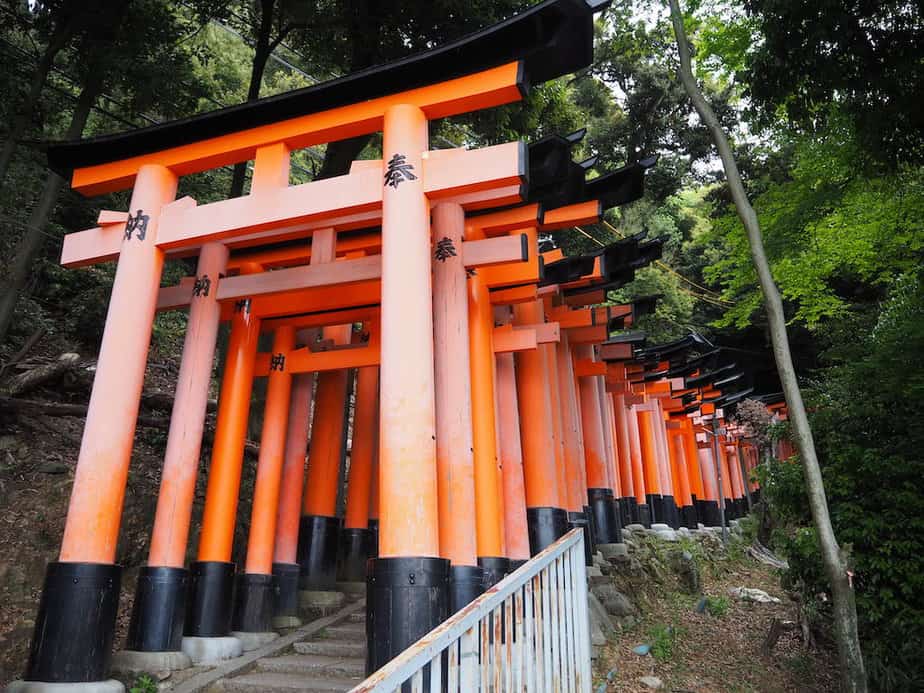
Install an Esim on Your Phone
Having access to the internet with data on your phone is an essential part of your solo trip to Japan. It’ll make your life so much easier.
To easily travel around Japan, you need access to the internet. To get around, to figure out what train to take, find tourist attractions, and make sure you pick the perfect place to eat.
Luckily, there is an easy solution on how you can have data on your phone everywhere in Japan.
That’s by installing an esim on your phone. An esim allows you to purchase local data for whatever country you’re visiting. In this case, Japan. You buy an esim, and you can use your phone’s data just like you do at home but without any high roaming fees.
All you have to do is purchase an esim either online or through the app , install it on your phone, and make your esim your main source of data. The entire process takes less than five minutes and is very intuitive and easy. You can even install an esim on your phone before you arrive in Japan, and it’ll automatically activate when you turn on your data in Japan, and you phone connects to a Japanese network.
I like to purchase my esim online because it gives you a QR code. You just scan the QR code on your phone, and your esim is set up in a few easy clicks.
Esims allow you easy access to phone data without having to rent a wifi egg , purchase a local sim card, or incur high roaming fees with your local carrier.
I recommend esims to all my friends and family when they travel, and they all love it as much as I do.
Install an esim on your phone to make getting around Japan easier and stress free.
My Favourite Esim
Since esims are a relatively new technology, there aren’t a lot of reliable companies offering them yet. And you do not want to purchase an esim from an unreliable company and be stuck stranded without phone data.
I love Airalo . It’s my go-to esim provider, and I purchase all my esims through them.
They have the most esims available for the most countries compared to competitors. They also offer incredibly good prices and always have reliable data. You purchase a certain amount of data up front. If you’re close to running out of data, you can purchase more data to be added to your esim with one quick click in the app.
Another option you can look into is Drimsim . Unlike Airalo, Drimsim charges you per MB used rather than charging you for a certain amount of data up front.
If you don’t plan on using much data, Drimsim may be the better option. I highly recommend if you choose Drimsim to turn off your data whenever you’re not using it. This will prevent data accidentally being used in the background and running up your bill.
I tend to use a fair amount of data when I travel between Google Maps, texting, and scrolling social media while eating alone, so Airalo is my esim of choice.
I’m normally in a country for three to four weeks at a time and purchase the 5GB plan. I’ve never gone over before, but there have been a few times when I’ve been close. If you’re only in Japan for a week or two, you should be fine purchasing a 1GB or 3GB plan.
The 3GB plan is probably your best choice. It’s only a dollar or two more than the 1GB plan and gives you the peace of mind that you won’t accidentally run out of data while out and about exploring one day.
Plus it’s likely more expensive to purchase a 1GB top up if you run out of your pre-purchased 1GB data than it is to purchase a 3GB plan.
Anyways, whatever amount of data you choose to purchase is up to you. The important thing is that you install an esim on your phone, so you can easily access the internet when out exploring. This is especially important as a solo traveller !
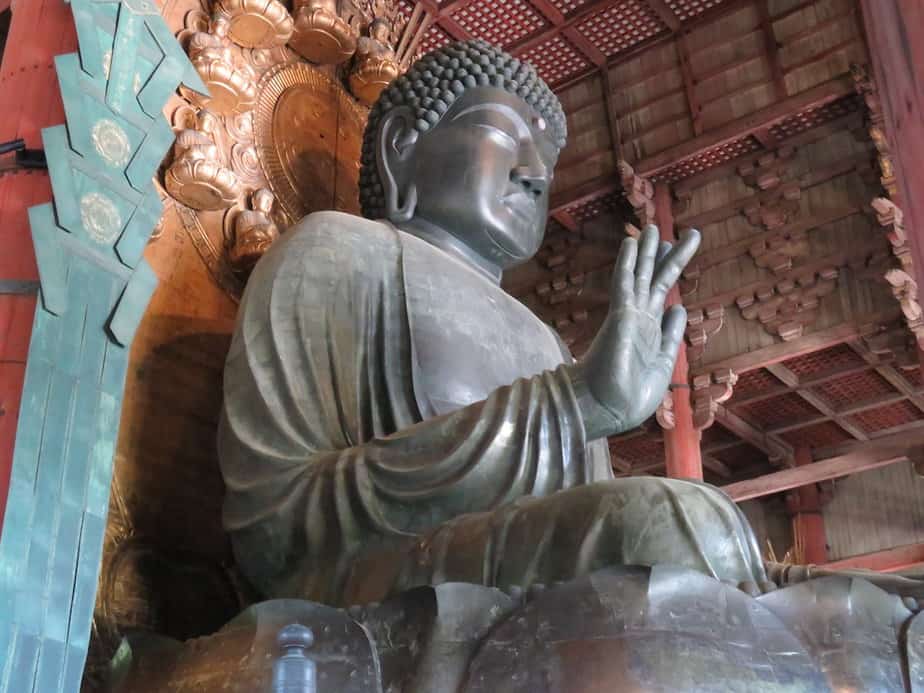
Google Maps is Your Best Friend
You’re probably already acquainted with Google Maps, but it’s going to become your best friend when you’re travelling Japan solo.
Google Maps in Japan has some of the most comprehensive information of any country I’ve visited.
Especially when it comes to public transportation, which some people find overwhelming and confusing the first time they come to Japan.
Here is some of the information Google Maps tells you when riding the metro in Japan:
- What entrance to take to get to the metro
- What exit to take when leaving the metro. This is very important information. Please don’t ignore it!
- The exact train car number you should get on for the quickest transfer or exit
- What platform your train is departing from. This is very helpful in major train stations where there can be over 20 platforms
- How busy the train is, is the train has AC or not, and whether or not there are delays on the route
Google Maps can also navigate indoors in Japan. This is super useful when trying to find a store in a massive shopping mall. It’ll guide you to the nearest escalator to the store you’re looking for and take you right to the entrance.
It’s fabulous. Google Maps may be your most used app while on your solo trip to Japan!
Major Train Stations are Difficult to Manage
Major train stations are extremely difficult to manage. You 100% need to use Google Maps if you’re trying to find what exit to use or something inside a train station.
Before you start thinking I’m dramatic and how hard could a train station possibly be, Shinjuku Station has 200 different exits.
So, yeah, complicated. You can easily get lost and spend an hour or two wandering around trying to find what you’re looking for.
Trust me. I once spent half an hour looking for a tempura restaurant in Tokyo Station and ended up giving up and leaving.
Whenever you have to exit a major train station, be sure you know what exit you want and watch the signs carefully.
Some major train stations like Kyoto Station and Kanazawa Station are easier to manage. Some like Tokyo Station and Osaka Station are more complicated.
Be prepared. Be patient. And if all else fails, find your way to an information booth, and someone will be happy to help you find what you’re looking for.
Be Prepared to Queue
I hate waiting in lines and avoid waiting in them at all costs. The Japanese don’t seem to have the same aversion to lines that I do. There are lines everywhere, and people don’t mind waiting for them.
There are lines for food (these are often the longest lines at popular restaurants). Lines for tourist attractions. Lines for no apparent reason.
It’s just something that comes with a solo trip to Japan.
Hopefully you don’t have to wait in too many lines but bring your patience just in case. If you know you’ll be waiting in a line on a particular day, consider bringing a book (or audiobook) or something to entertain yourself with.

Avoid Golden Week at All Costs
Golden Week is a national holiday in Japan where people get an entire week off of work. Japanese people use this as an opportunity to travel, and a lot of people travel within Japan rather than going abroad.
This means three things:
- The most popular cities like Tokyo, Osaka, and Kyoto are very, very, very busy
- If you’re visiting a less popular tourist destination, things like restaurants may be closed
- It will be difficult to find an affordable hotel even if you’re booking months in advance. I wanted to go be in Sendai durning Golden Week and couldn’t find an affordable hotel even though I was looking 5 months in advance.
I was in Japan during Golden Week in 2023 and experienced both those things. I spent the majority of Golden Week in Fukushima. Not the most popular tourist destination. A lot and I mean a lot of the restaurants were closed. Some were open until 2pm, but many were closed all day. Not great.
Then I was in Tokyo for the last two days of Golden Week. It was madness. I’ve never seen a city so busy in my entire life. I cannot imagine how busy it was during the height of Golden Week because I assume some people already went home to get ready for work in a couple of days.
Moral of the story is to avoid Japan during Golden Week at all costs. Don’t think to yourself that it won’t be too bad because it will be. Trust me.
On the flip side, going to Japan right after Golden Week is probably the best time of the entire year to be in Japan. I was at Tokyo Disney Resort the four days following the end of Golden Week, and I’ve never seen it so quiet before. It was magical.
Golden Week changes dates every year and is sometime in either April or May. Just do a quick Google search before planning your solo trip to Japan and make sure you aren’t planning it during Golden Week.
Avoid Golden Week at all costs. Ideally visit Japan right after Golden Week for the lowest crowds.
The JR Pass Probably Isn’t Worth it
You’ve probably heard a lot about the JR Pass and how it is essential when travelling in Japan. How you’ll save so much money with the JR Pass.
But, honestly, that isn’t the case for most people.
If you’re only travelling between Tokyo and Kyoto, you likely won’t get your money’s worth out of the JR Pass.
If you’re in Japan for two or three weeks and spending more than a day or two in each city, you probably won’t get much value out of the JR Pass.
You need to be using the JR a lot in a short period of time to get value out of the JR Pass. Especially now that the price is increasing by about double!
I spent 3 weeks in Japan in 2023 and took the JR or Shinkansen between each city I visited. I used JR trains to travel within each city. Even though I would have used the JR Pass a lot, it still didn’t make financial sense for me to get one.
That’s because I wasn’t using the JR enough or on expensive enough lines that purchasing a JR Pass made sense.
Be sure to do the math and use a JR fare calculator before purchasing a JR Pass to make sure you’re getting enough bang for your buck by buying the pass.
The benefit of the JR Pass is that you can pre-reserve seats on the train, which is a huge plus if you have luggage and have to reserve luggage space.
Although, when I was in Japan, I never had to reserve luggage because you only have to reserve it on the most popular and busiest routes like Tokyo to Kyoto or Tokyo to Osaka.
You don’t have to reserve luggage space on most Shinkansen trains.
And if you’re going from Osaka to Kyoto without a JR Pass, just get on the slower JR train rather than the Shinkansen. It’s a third of the price and only takes 10 or so minutes longer if you get on a super rapid train.
JR Fare Calculator (see if the JR Pass saves you money)
Be Internet Safe
Even if you get an esim for your phone, you’ll still be relying on public wifi during your solo trip to Japan. Even if it’s only while at your hotel.
Please don’t waste your esim data and use it at the hotel rather than the complimentary hotel wifi!
And since you’re going to be using public wifi at least part of your trip, I’m going to lecture you about the importance of using public wifi safely.
Public wifi networks are just that. Public. That means anybody with the code can access the wifi. From my experience, a lot of hotels in Japan don’t have a password on their wifi. Anybody can access the wifi even if they aren’t staying at the hotel.
This means that there are countless people using the same unprotected wifi network as you. That puts you personal online information (like you’re banking information) at risk of being stolen.
All it takes is one person with bad intentions, and you’re dealing with the headache of cancelling bank cards while abroad. Trust me when I say that’s no fun.
The only way to protect yourself when using public wifi networks is by installing a VPN on your devices. A VPN essentially puts an invisible forcefield around your devices that makes it impossible for prying eyes to access your personal online information.
A VPN makes using public wifi networks just as safe as using your home wifi where you’re the only person who knows the password.
One of the most important things you should so when preparing for your Japan solo trip is install a VPN. It’s the simplest safety precaution you can take.
The cost per month for a VPN subscription on a two-year plan costs less than a latte and cake pop at Starbucks. You have no excuse not to protect your online information.
I always say that if you can afford to travel, you can afford to protect your online information with a VPN.

My Favourite VPN
I’ve used a lot of VPNs over my many years of travel. Most of them, frankly, suck. VPNs are notorious for slowing your devices down, and you really feel the different in internet speed when using a VPN.
That’s not the case for NordVPN . It’s consistently ranked the fasted VPN on the market and the only VPN I’ve ever consistently used. You don’t feel like your internet speed is slowed down at all when using NordVPN.
You can install a single NordVPN subscription on up to six devices. That makes it super easy to protect all your devices for one low price.
One of my favourite feature of VPNs is being able to cloak my location. That allows me to watch Netflix from different countries and watch Canadian sporting events while abroad.
There are really no downsides to installing a VPN on your devices. It’s an extremely small price to pay for the peace of mind you get by knowing your private information is safe and sound while you’re abroad.

Get the fastest and most reliable VPN on the market for an extremely low price.
One of the first things you’ll notice on your solo trip to Japan is how quiet it is. In terms of volume. Not in terms of people. There are always tons of people in Japan.
It’s a widely known rule that people are quiet and respectful while out in public. This means no talking on the metro and no loud conversations at restaurants.
And please, please never answer a phone call while on public transit. It’s considered quite rude to speak on the phone in nearly every indoor public setting in Japan. But if you talk on the phone on the metro, you will definitely be getting dirty looks.
Just be sure to be quiet, reserved, and respectful while in public in Japan. I know you’re on a solo trip to Japan, but I also know a lot of you like to make friends while travelling alone. So, if you go out with a group (or while you’re alone), please be quiet.
There is a time and place for loud conversations, and in public is not it.
Oh, and small talk isn’t really a thing in Japan. I know my American friends love starting small talk with strangers, but you’ll be getting weird looks if you try that in Japan.
Taxis are Extremely Expensive
Taxis are never the most affordable way to get around, but in a lot of places they’ve not super expensive. They’re affordable enough that you can justify taking a taxi if it’s going to be super convenient or save you a lot of time.
Japan is not one of those places.
Japan has the most expensive taxis I’ve ever seen in my life.
There is no circumstance I could ever see justifying me using a taxi instead of the metro other than being physically injured and needing to get to a hostpial.
And even in that circumstance, I may still take the metro because the taxi fees are so high.
If you normally take taxis when you travel, you’ll need to get used to the idea of using public transportation or walking.
See point one about staying near a train station if you need a refresher. 😉
The good news is that Japan has one of the best public transportation systems in the world. It’s so easy to get around. You won’t even miss taking a taxi.
Most major cities have large metro systems. Tokyo, Osaka, and Kyoto all have metros where you can easily get around. Smaller cities in Kanazawa rely on buses. But they’re smaller cities, so it’s easy to walk everywhere if you’re staying in a central location.
Just be prepared to use public transportation and walk a lot while in Japan. Taxis are a luxury not a normal thing to use.
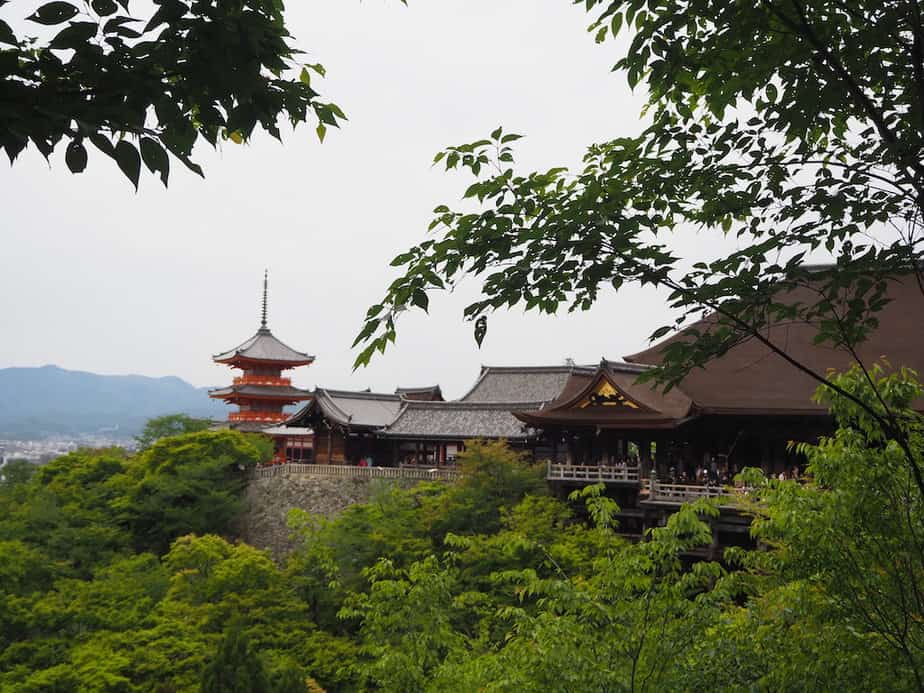
Purchase Popular Tickets Online in Advance
As we’ve talked about in this article, Japan is busy, and there are often queues. To cut down on your time waiting in line, there are two things you can/should do:
- Get to attractions earlier in the day to avoid crowds
- Purchase tickets online in advance if you can
These two things will save you heaps of time on your solo trip to Japan. You’ve got a lot to see and do while in Japan alone, and you don’t want to be stuck waiting in a line if you don’t have to.
There are also some things you need to pre-purchase tickets for. As in you can’t get them at the door or they’re likely to be sold out. Those two main things are Universal Studios Japan in Osaka and Tokyo Disney Resort .
This is especially true for Tokyo Disney. You have to purchase your tickets in advance. You can’t buy them at the gate. Universal recently reintroduced buying tickets at the gate, but it’s a super small park and sold out in advance more days than not.
Other Tickets You Should Consider Buying in Advance
- Tokyo Skytree
Shibuya Sky
- Tokyo Tower Observation Deck
- TeamLab Planets (hugely popular and likely to sell out)
- Sanrio Puroland
- HARUKAS 300 Observatory
- T eamLab Botanical Garden (Osaka’s version of TeamLab Planets)
- Osaka Museum of Housing and Living
Narita is Very Far Away from Central Tokyo
Narita is very, very far away from central Tokyo. Haneda is closer to central Tokyo, but the majority of international flights fly in and out of Narita.
This means you need to have a solid plan on how you’re getting from the airport to your hotel. Sometimes it can take up to two hours depending on where you’re staying.
You can either take the metro or a limousine bus. I prefer the bus. You’re guaranteed to get a seat, probably drops you off closer to your hotel, there is no need to transfer, and you don’t have to deal with your luggage. It just sits nicely under the bus.
Taxis aren’t an option unless you’re rich because they’re so expensive. A taxi from Narita to central Tokyo will cost you a few hundred dollars!
And the last thing you want to do on a solo trip to Japan is break the bank taking a taxi just because you didn’t plan properly!
The fact that Narita is so far away from central Tokyo also means that you need to be strategic about when you book your flight.
If you land late in the evening or depart early in the morning, you might have an issue. Maybe the buses aren’t running early or late enough or maybe you don’t want to drag your butt out of bed super early or be trying to find your hotel in the dark.
If you’re arriving late or departing early, I highly recommend staying at a hotel near the airport for a night. It’s so much more convenient. I’ve done it before for a flight departing at 11am and would do it again in a heartbeat.
Plus the hotels near Narita are surprisingly affordable. I loved my stay at the Hilton Narita . It was super nice and seemed like it should have costed more than it did.
Most airport hotels offer a bus to and from the hotel, which is super convenient. The hotels say it takes about half an hour to get to the airport. From my experience, it takes about 15, but it’s better to be early than late!
Go to Tokyo Disney on a Tuesday or Wednesday
Tokyo Disney is a must do for any theme park or Disney fan. Heck the theme parks are so well done that even people who hate Disney enjoy them.
Tokyo Disney Resort has two theme parks: Disneyland and DisneySea. DisneySea is the more unique one of the two, but they both have rides you don’t want to miss.
TDR is hugely popular. Not only with tourists but also with Japanese people. This means that it’s always busy. The most popular rides often have wait times between 90 and 180 minutes.
That’s just on a normal day. Not even during the busiest times of year.
So, you definitely need a strategy when going to Tokyo Disney. It may be your only trip, and you want to get the most out of it.
There are way too many tips and tricks about Tokyo Disney to put into this short(ish) blog post. You’ll have to do a deep dive on that on your own. TDR Explorer is a great place to start!
One important tip I will give you is to visit Tokyo Disney on either a Tuesday or Wednesday.
This is when the parks will be the least busy. You’ll be able to get a lot more done on a Tuesday or Wednesday than on the weekend.
Mondays and Thursdays are normally medium busy. I’ve noticed that a lot of the times school groups are filling up the parks on Thursdays leading up to the weekend, and they’re a lot busier than Wednesdays.
Mondays have carryover from people visiting over the weekend. They’re not as busy as a Friday, Saturday, or Sunday but are still quite busy.
So, if you have flexibility in your schedule, try to arrange your trip to Tokyo Disney for the middle of the week. This will give you the best chance at having lower crowds.

Make Sure You Have Health Insurance
Health insurance is an essential part of travel, and you need to make sure you have health insurance that covers your solo trip to Japan.
You may have travel coverage through your work plan. If you do, you just need to make sure it covers the entire duration of your trip. Most policies only cover the first 21 or 30 days of your trip.
If you’re like me and don’t have insurance through your employer, you have two options.
First Option
The first option is perfect for people who are only going abroad for a shorter period of time. This is buying travel insurance from a major company in your home country.
You can normally get insurance through a bank, company that sells house or life insurance, your local healthcare insurer (like Blue Cross), or through a company like AAA or AMA or CAA.
All these places will let you purchase a travel health insurance policy to cover the duration of your trip.
These are normally reasonably affordable. Especially if you’re only gone for a week or two. They offer decent coverage, but they often make it a headache to make a claim.
You can also get a multi-trip policy that covers you for every trip you take abroad in a year as long as the trip is under a certain amount of days. You get to choose the amount of days when you purchase the policy, and they range anywhere from 7 to 60 days.
This is what my retired parents use, what I used when I was a student, and what most casual travellers use.
Second Option
The second option is for long-term travellers and digital nomads. That’s purchasing health insurance through a specialized company that solely provides insurance to travellers.
There are a couple of companies you can get this type of insurance through. I personally use Safety Wing and think they’re the best option you there.
They’re very affordable, have a low deductible, make it easy to make a claim, and even provide you coverage in your home country for 30 days as long as you’ve been abroad for 90 days.
I love the flexibility of Safety Wing and being able to cancel anytime I want. If I’m going to be in Canada for a few months, I can cancel my policy and then reinstate it when I start travelling again. They even let you purchase your insurance while you’re abroad and already on your trip, which is quite rare.
Again, this option is best for people travelling for a long period of time. It’s much cheaper in the long run than the first option and provides better coverage.

Bonus: Try the Melon Fanta (Trust Me)
This may sound like a weird thing to throw into this article but hear me out. The Melon Fanta in Japan is the best soda I’ve ever had. And I’m a soda girlie.
I know. I know. It isn’t healthy, but it just tastes so good!
Melon Fanta is incredible . It’s a bit hard to find in convenience stores, so you may have to order it at a restaurant, but it’s so worth it.
I tell all my friends who go to Japan to try it, and they all love it.
I know it sounds like an odd flavour of soda, but please trust me and try it!
My Favourite Things to do in Japan Alone
Tokyo Disney Resort
Shinjuku Gyoen
Todaiji Temple
Fushimi Inari Shrine
Kiyomizu Temple
Museum of Housing and Living
Universal Studios Japan
Osaka Castle
This article ended up being way longer than I thought it would! I guess I just have a lot to say about taking a solo trip to Japan and being in Japan solo.
Japan is a super unique country and requires a bit more planning and understanding than a lot of other countries. It’s so easy to accidentally offend someone because you don’t know the social norms.
But I hope this article helps you better understand what a solo trip to Japan will be like and how to best prepare for being in Japan solo.
It’s an amazing country, and I have no doubt you’ll love it. Basically everybody does. That’s why it’s so popular!

Related Posts
- 9 Key Things to Know Before Your Solo Trip to Ireland
- 9 Tips to Know Before Taking a Solo Trip to Copenhagen
Solo Traveler
Solo travel tips, destinations, stories... the source for those who travel alone.
Solo Travel Japan: 32 Tips You Need to Know
April 2, 2018 by Janice Waugh
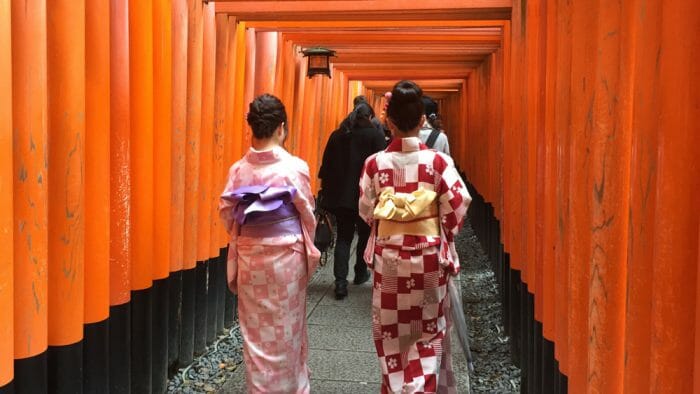
Walking through the vermillion Fushimi Inari-taisha shrine is considered purifying to Buddhists.
Japan is a beautiful, welcoming, friendly country. It's also quite different from any country I've visited. Before I start sharing the tales of my 10-day trip there, I want to give you my top tips for traveling solo to Japan.
Japan is actually quite an easy country for travelers. People line up for things. Trains run on time. And there is just enough English on signs and in announcements to help you get by.
But that doesn't mean that navigation is easy or that what the Japanese consider to be good manners are obvious to the traveler from abroad. That's why I've put together this information on traveling in Japan.
With just 10 days experience, I cannot say that this post is comprehensive. I'm sure that many readers, in their Japan travels, have noticed differences from other countries that could be shared in the form of more tips for travelers who are yet to go.
Please leave your tips in the comments.
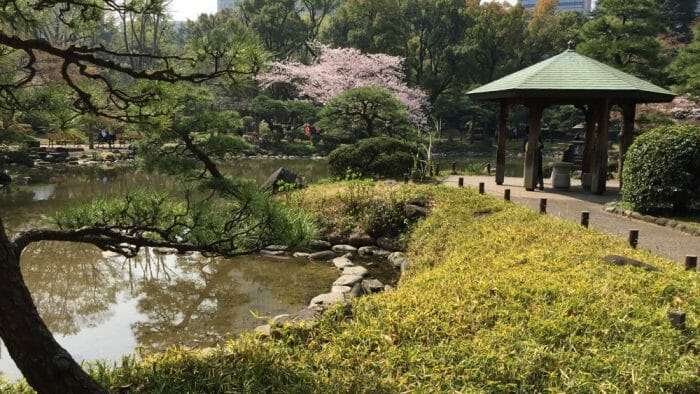
Inokashira Park in Kichijoji, Tokyo.
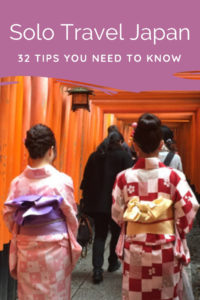
Pin it on Pinterest!
Table of Contents
Tips for Traveling Solo in Japan
- Have cash . Everything I had read said that Japan is a cash society. I found that many places take credit cards including the hostels and ryokans where I stayed, 7-Elevens that are everywhere and many restaurants. While I used my credit card a lot, having cash was an imperative. In 10 days I spent about US$300 in cash.
- Watch on your right when crossing . Cars drive on the left in Japan. However, foot traffic is sometimes on the left and other times on the right. Escalators were consistently on the left and then, I found an exception in Tokyo when it was on the right. Default to the left but be prepared to be wrong.
- Shoes are for the street . If you see slippers at the entrance of a building you are expected to take your shoes off and put slippers on. At every point along the way, should you see slippers you repeat the process. For example, when you go to a Ryokan you will leave your shoes at the door change into the slippers provided and go to your room. You'll leave these slippers at the entrance of your room and use socks or bare feet in the room. When you go to the bathroom, you'll find another pair of bathroom slippers that are only used there. If the bathroom is down the hall you will put the house slippers on as you leave your room, walk to the bathroom and change to the bathroom slippers, then change back to the house slippers as you leave and then leave the house slippers at the entrance to your room.
- Toilets are interesting in Japan . Yes, enter a cubicle and the sound of a gentle waterfall and birds will typically start playing. Sit down and you'll often find the seat to be heated. A control panel will let you turn off the sound and, in women’s washrooms, give you a variety of bidet options. You'll have two or three spray options and often be able to control the intensity of the spray. There is also toilet paper. Many public toilets do not have paper towels or blow dryers for you hands. People often carry a small facecloth with them for this purpose.
- A culture of public baths. There are thousands of natural hot springs all over Japan. These are called onsens and are used as public baths. When you arrive at one, you strip down (everyone is naked in an onsen) soap up and wash down completely and only then enter the pool (or pools). I’ll be giving you a more detailed article on onsens soon. They are a Japanese experience not to be missed. Read How to Onsen: The Naked Truth About Japan’s Best Cultural Experience
- Juicing up . Power outlets are the same as in North America so if that's where you're from you don't need an adapter.
- Don't assume that a taxi driver or anyone will speak English. Whenever possible, get your logistical information, hotel name, address and telephone number, written in Japanese for you.
- There’s more English than I expected. Train station names are written in Japanese and English scripts. The essential announcements on trains and subways are also made in English.
- Chain hotels can be a huge help . If in doubt, go to a large hotel for assistance where there will most certainly be English spoken. I went to the Shangi-La in Tokyo when I first arrived to get help finding my hostel. I was carrying a backpack and yet this high-end hotel treated me very well. They wrote the coordinates for my hotel on a card in Japanese and got me a taxi.
- Miss your pet? If you miss your pet or simply want some quiet time, try a cat cafe. There are also owl cafes (with real owls on hand) and dog cafes. Pay approximately 1300 yen per hour for a drink and the pleasure of sitting with the animals.
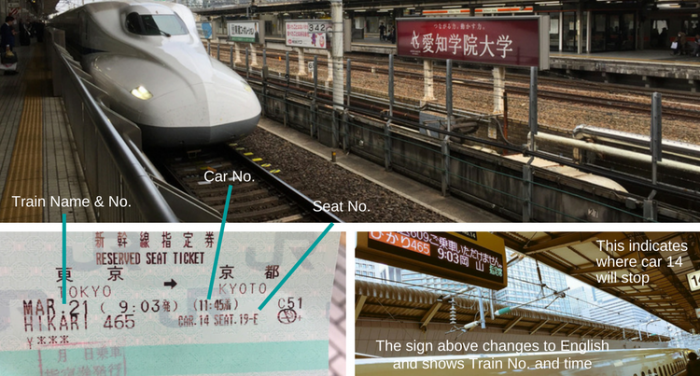
The Shinkansen, also known as the bullet train, takes you from Tokyo to Kyoto in under 3 hours. If you're going in that direction, sit on the right side of the train for a view of Mount Fuji on a clear day.
Solo Travel Japan: How to Get Around by Train and Metro
Traveling solo in Japan, with just enough English on the signs, takes patience. Here's what you need to know.
- The Monorail connects to the subway system to take you anywhere in the city.
- The Keikyu Line goes into central Tokyo. Get off at Takaracho Station and you're close to Imano Tokyo Ginza Hostel where I stayed.
- Bus to Tokyo Station and other points . At arrivals there is a very obvious bus ticket counter on the left. I bought my ticket to Tokyo Station for 1,000 yen. Cdn$12.
- Taxis . Taxis are available but expensive. It seemed to me that 20 minutes in a taxi cost about ¥2,000 in both Tokyo and Kyoto. You can use Google maps to estimate the length of your trip. Make sure that you have your destination written in Japanese on a piece of paper, as drivers will not necessarily speak English or read western script.
- Buy your JR Rail Pass voucher before you go . Rule of thumb is that if you are taking more than one train trip it is worth it.
- Trade your voucher for your JR Rail Pass . Go to ticket office at train station. There will be a wicket specifically for getting your JR voucher turned into a pass.
- Get your train ticket. Once you have the pass you need to go to a regular wicket to get a ticket for your train. Note: If you're taking the train from Tokyo to Kyoto, ask for seat on right side of train for view of Mount Fuji. On left in opposite direction.
- Plan ahead. When you arrive at your destination, go to the ticket office to get your next train ticket so that you get a reserved seat and don't miss out should you want to travel on a particularly busy day. This is important on weekends.
- The information on your ticket . Your ticket indicates your train number, car number and seat number.
- Matching your ticket with the platform . Find the platform for your train number by looking at the digital signs or asking an agent of which there are many. Be mindful that the next train to your platform may not be your train. Look for the electronic signs indicating the number of the next train to come so you'll know when your train has arrived. Once your train is next, look for where you should stand on the platform for your car number. They also have signs indicating where your car number will stop along the platform. Wait at the entrance for your car number. When it's arrives, enter and you'll easily find your seat.
- Listen to the announcements . Announcements on the train are in English as well so you don't need to worry about missing your stop. They also tell you what side of the train you'll disembark on.
- Smoking permitted in designated areas . The Shinkansen train has smoking rooms on certain cars and food trolleys. Not all regional trains have either.
- Your JR Pass and city travel . There are times when you'll transfer to a JR Train to get to your destination outside a city. You can usually use your JR Pass for this and save on your metro costs.
- A transit card . You can get a transit card in just about any city. The ICOCA card for Kyoto costs ¥2,000 or about Cdn$12/US$10. You can buy it from a ticket machine. ¥500 is a deposit on the card which you can get back from a kiosk along with any balance before leaving the city. My research says that you can use it in Tokyo as well however you cannot cash in the card in that city.
- A day pass . Depending on your plans a 24-hour day pass can be a good idea. In Tokyo be careful as there are two Metro companies. A day pass for the Tokyo Metro is 600 yen. For the Tokyo and Toei subways the price is 900 yen.
- Pay per trip . Buy your ticket at every station based on your destination. The farther you go, the more you'll pay.
- Ticket machines offer English . There is a button in the upper right corner of the display that will turn the information into English. There is an image of the metro near the ticket machines. Look for your destination station and the price of your ticket will be marked in a circle. Buy your ticket for that amount.
- Using the transit card. Because you pay for your ride based on distance you need to tap in at your starting point and tap out when you leave the subway. The balance remaining on your card will show every time you tap.
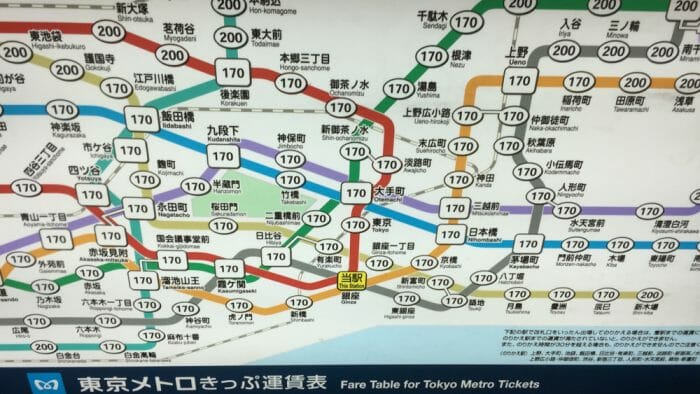
If you're buying a single-fare ticket, look on the map for your destination station and the map will indicate the value of the ticket you need to buy. 170 means you buy a ticket worth 170 yen.
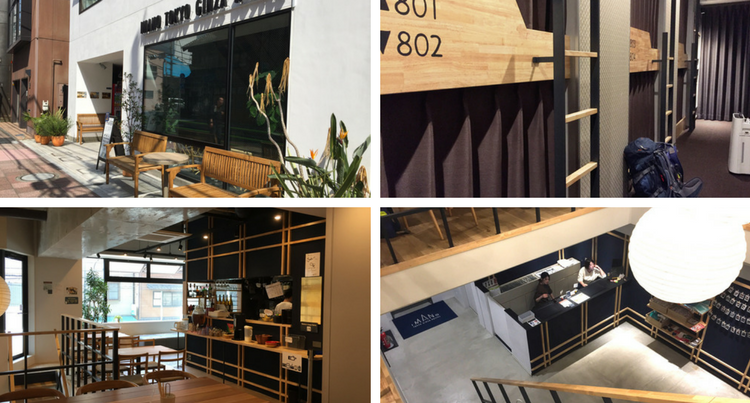
I was really happy with the Imano Tokyo Ginza Hostel as well as its location.
Accommodation for Solo Travelers: Japanese Ryokan and Hostels
Naturally, all the major hotel chains in the world are present in Japan. However, there are many more local accommodation experiences that are well worth it.
- the “agari-kamachi” (after opening the door guests step into this small area and take off their shoes)
- “shoji” (sliding paper doors) which separates the agari-kamachi from the room
- “tatami” mat flooring (reed floor matting)
- low wooden tables
- “zabuton” (sitting cushions)
- futon (sleeping quilts)
- a “tokonoma” (an ornamental alcove built into the wall used for placing flower vases and hanging scrolls)
- an “oshiire” (a closet for futon sleeping quilts)
- an “engawa” (a glass enclosed sitting area separated from the room by a shoji)
- Hostels . I also stayed in two hostels, Hostel Niniroom in Kyoto and Imano Tokyo Ginza Hostel in Tokyo. Both were less that six months old which I chose just by chance. Both were beautifully designed with very private bunks with blackout curtains. Security is fine with both requiring codes to enter the rooms. In each case the cost was about Cdn$50. I was very happy with my choice. Excellent value!
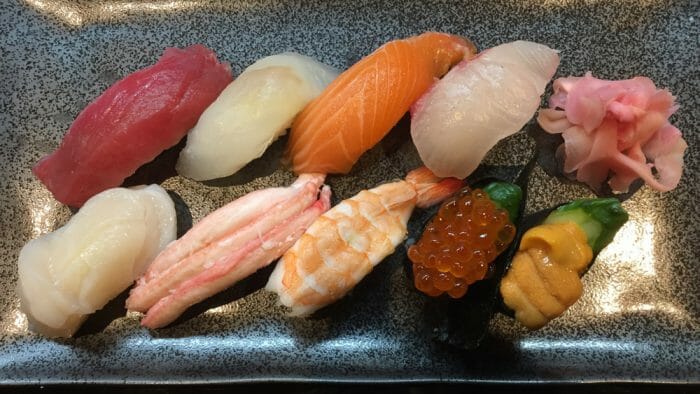
Sushi is an option in most places but it is not in every restaurant. It's not as common as I expected.
Tips on How and What to Eat in Japan
I expected to love Japanese food and discovered that, for me, eating was a challenge. First, I eat fish but not meat and, despite being an island, the Japanese eat a lot of meat. If you eat meat, especially beef, you'll be in heaven.
- Sushi is available . I expected to eat so much great sushi but I only had it twice. It was wonderful but sushi restaurants aren’t found everywhere as I expected they would be.
- Picture your meal . Pictures are available outside restaurants and on menus as well, so if you are without a food allergy or a preference like vegetarianism, it's easy to choose and to order.
- Buddah bowls . You'll often find restaurants serve rice bowls with any variety of vegetables and protein on top whether that be meat, seafood or tofu.
- There is a coffee culture . I found cafes everywhere and the coffee was quite good.
- Grocery stores. The fruit and vegetables in stores were, for me, unfamiliar, large, very brightly colored and frequently vacuum-packed in a liquid. It was strange and worried me a bit. With all information written in Japanese and no one who could explain things to me, I found myself paralyzed in the grocery stores. I'm embarrassed to say that on one occasion I walked out with a small jar of peanut butter and bananas for dinner.
- Looking for something special. Just like at home, you'll find restaurant reviews online.
- A wet towel will be provided to wash your hands before your meal. Use it then fold it neatly and leave it beside your place.
- Take food from the serving bowl and add to your own bowl.
- Sushi is eaten in one bit. Don't use too much soy sauce or wasabi as it might insult the sushi chef.
- Hold bowls in one hand, chopsticks in the other.
- It is good manners to eat everything on your plate to the last grain of rice.
- When you've finished return all dishes to how you received them with lids on, etc. Place your chopsticks back on the chopstick rest.
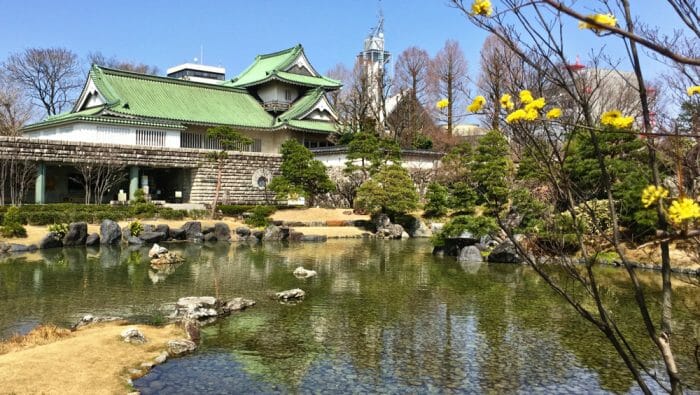
Toyama City Sato Memorial Museum in Toyama Castle Park. This was my destination for a day trip I took from Takayama.
For more on Solo Travel in Japan travel read:
- Omotenashi: Japan is Welcoming for Solo Travelers
- Japan Solo: Trip Planning Resources, Itinerary and Budget
- Solo Travel Destination: Nara, Japan
- Solo Travel Destination: Kyoto, Japan
- Solo Travel Destination: Furano & Nakafurano, Japan
Sharing is caring!
Publisher Janice: info @ solotravelerworld.com
Editor Tracey: tracey @ solotravelerworld.com
Sales Simon: simon @ solotravelerworld.com
Get Solo Travel News & Deals
- Create Your Advertiser Account
- Login to Your Advertiser Account
- Solo Travel Statistics
- Media & Speaking
- Privacy Policy & Disclosure

The content of Solo Traveler and any resources published by Solo Traveler are meant for entertainment and inspiration only. Please note that while we have advertising clients promoting destinations, products, services, trips and tours on Solo Traveler and that we endeavour to only work with companies in which we have confidence, we are not responsible for the delivery or quality of their products or services. Every person and every travel situation is different. Your safety, satisfaction and fun traveling solo are your responsibility alone and not that of Solo Traveler, its publisher, editor and/or writers.
PRIVACY POLICY & DISCLOSURE: In accordance with FTC guidelines, I disclose that I may be compensated if consumers choose to utilize links located throughout the content on this site. Additionally, some posts might be sponsored to support this site. Please do the appropriate research before participating in any third party offers. All opinions are my own. Please read our full Privacy Policy here.
Solo Travel in Japan
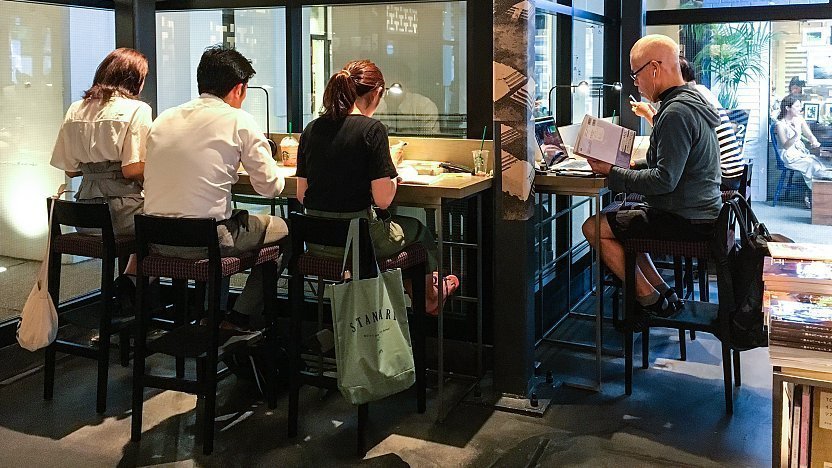
In past decades, most solo traveler in Japan used to be the ubiquitous salarymen (office workers) on business trips. These days, however, many locals, especially the younger generations, are increasingly traveling alone or doing things by themselves, creating a unique market aimed at singles.
If it is your first time traveling alone or visiting Japan, it might be simpler to base yourself in one place and make multiple day trips out or mix in an overnight trip or two. Sticking mainly to the city may make it easier and cheaper, but venturing out into the countryside allows for different experiences.
As much as you may want to see everything in a limited space of time, it is advisable to incorporate some flexibility into your daily itinerary. This is to allow for things to go wrong and to have some extra time to rest or enjoy beautiful things. Below are some basic points to note for those who travel in Japan alone.
Safety issues
Japan has a reputation for being a safe country, a place where locals leave their belongings at the table unattended, where lost belongings get returned with their contents intact, where it is generally safe for women to walk alone at night, even down dark alleys and where children typically commute to school with minimal adult supervision.
But the low crime rate does not mean that you should let your guard down. It is imperative to always be aware of your surroundings, especially when walking along dark streets. A good gauge is: if you would not consider doing something alone in your home country, you should not do it in Japan either. Just because a majority of the people tend to be friendly and helpful towards visitors does not make the minority less dangerous.
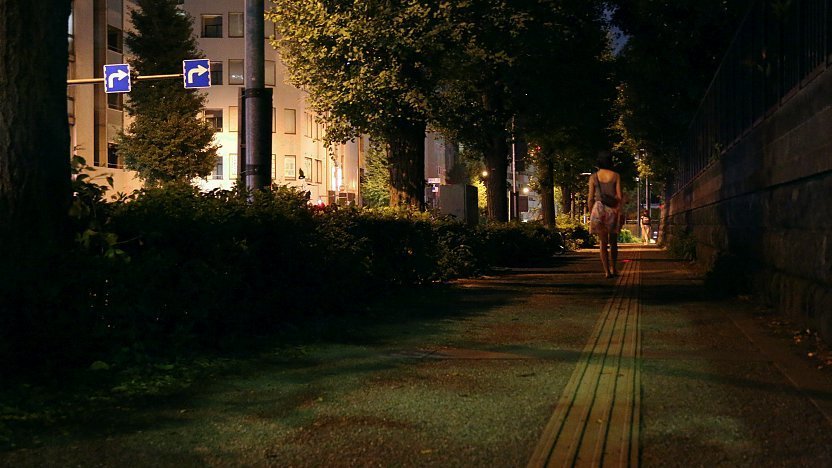
Visitors should be vigilant. Avoid providing potential perpetrators with opportunities, be aware of your surroundings and listen to your gut instinct. Remember that offenders come in all shapes and sizes and can be Japanese or not.
Police boxes, or koban as they are known in Japanese, can be found in all neighborhoods. Police officers stationed there are usually the first to react to a distress call in the neighborhood, and the koban is also a safe place to run to in case of emergencies.
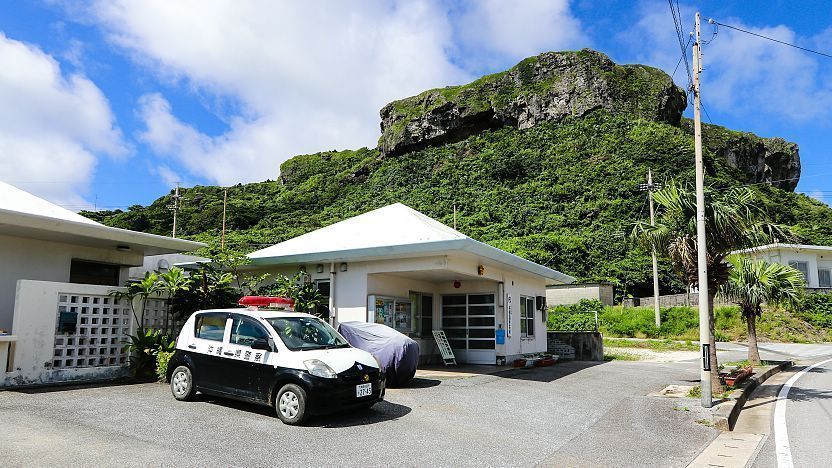
Accommodation
Business hotels and hostels are the best options for single travelers looking for economical and no-frills accommodation , short of staying in a capsule hotel . These lodgings are readily found in most cities across Japan and offer basic sleeping furnishings.
Ryokan let staying guests experience traditional culture and hospitality, as well as local cuisine and hot springs . Ryokan have traditionally not been catering to single travelers, and many still adhere to this tradition. However, things are changing, and the number of ryokan that offer plans for single travelers has increased a lot over recent years.
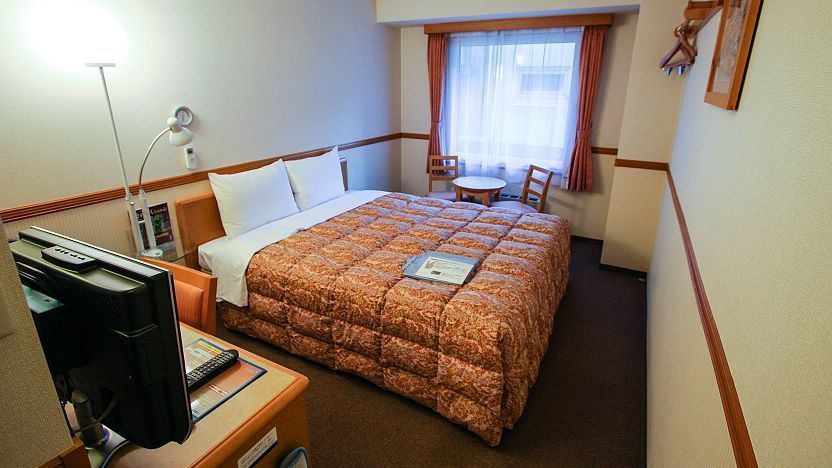
Dining alone has never been easier in Japan, and many places are well equipped to serve the solo diner. Restaurants have come to acknowledge the increasing trend and will typically accept reservations for a single diner. Casual dining establishments, like some ramen -ya even offer individual cubicles, and coffee shops and fast food restaurants are often filled with single customers. Some restaurants and izakaya may seat single diners at a counter in order to keep tables available for groups.
Nervous solo diners note that staff and fellow customers are used to single travelers, especially in the big cities where solo diners abound, and will not cast curious or pity looks. Staff tend to be patient with non-Japanese speaking customers who attempt to navigate the menu and order in a foreign language. That said, it also pays to do a bit of menu research before entering a restaurant , in particular those that utilize ticket vending machines for orders , to avoid the added stress of holding up those behind while you decide what to get.
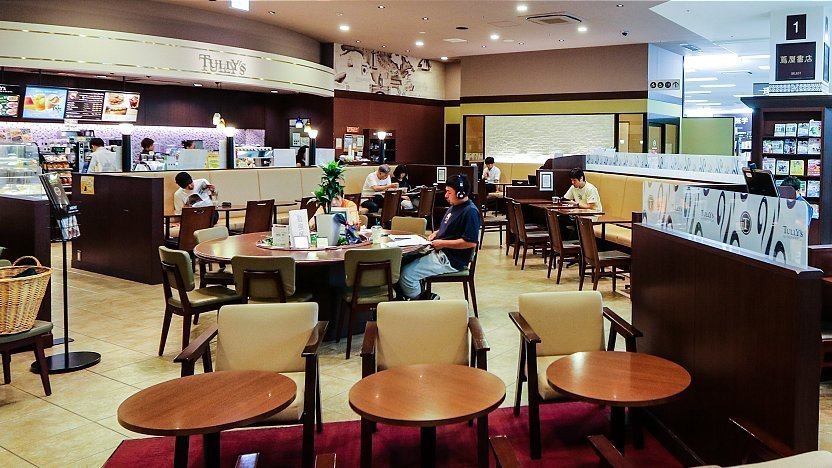
Meeting people
Joining a day tour or staying at a hostel are some easy ways to meet like-minded travelers. Signing up for a tour with a local volunteer guide or participating in a home visit could add a different element to your solo travel and allow you to meet local Japanese.
Saving your seat
Leaving your seat and your personal belongings unattended is a big no-no in many countries, but in Japan it is not uncommon to see customers leave expensive phones and bags at their restaurant table or shinkansen seat unattended. Nevertheless, it is not advisable to leave personal items unattended if you have to leave temporarily. Take at least your most important items like wallet and passport with you and use an item that you wouldn't mind losing to save your space instead.
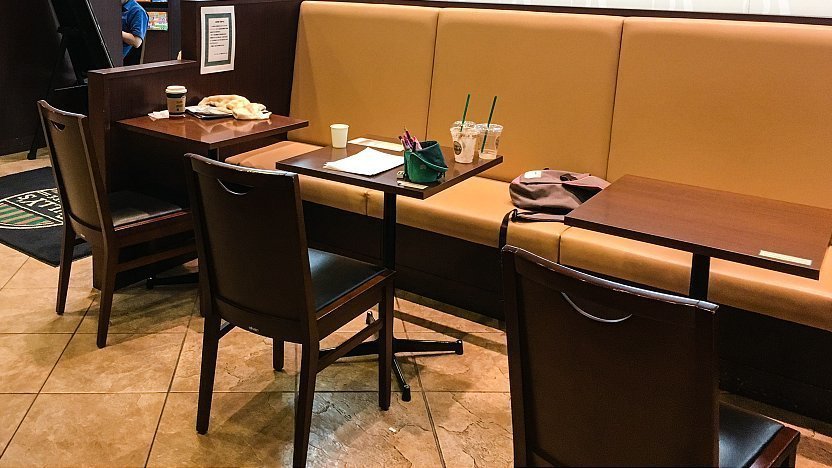
Outdoor activities
Outdoor activities like hiking can easily be completed by solo travelers. Even if you are a seasoned mountaineer, it is always prudent to inform someone of your hiking itinerary and to register your hike before starting on the trail. Having a working phone on your person is recommended in case of emergencies while having a bear bell can be a useful addition in some parts of Japan. Of course, if you have never hiked or are not a regular hiker, it is best to stick to short, easy routes or join a tour .
Water sports can be split into those you can do on your own and those that require joining a tour. Swimming at beaches is a typical water activity that can be done on your own, but make sure to pay attention to the tides and water currents so as to not endanger your life or others. Guided tours may require a minimum number of participants. Otherwise, be prepared to pay additional for a private tour.
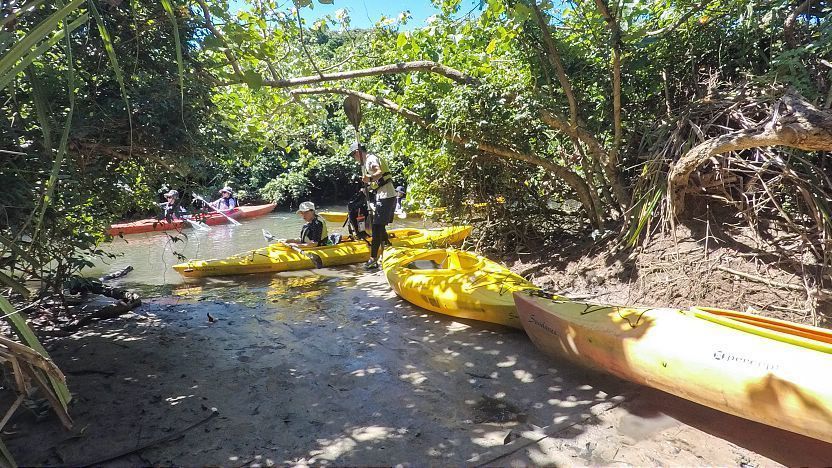
Tips for solo female travelers
Japan is admittedly one of the safest places to attempt as a first-time female solo traveler, and the probability of being harassed by locals is quite low. A steadily shrinking number of locals - mainly in the remote countryside - may stare at those who look and talk differently out of curiosity. Below are some tips for the solo female traveler.
Traveling alone
Targeted at the solo female traveler, our Solo Female Travel series introduces travel itineraries that have been put to the test by the author to answer the questions "Can a girl do this alone?", "Is it safe to visit alone?" and "Would the pace be too demanding?" amongst many others. Introduced destinations tend to be slightly off the beaten track, but still manageable by the average female.
Despite the popular images of Japanese youth using fashion as a creative expression, the general fashion for the average Japanese tends to lean towards the conservative side. A typical female outfit is usually quite modest with shoulders covered and a relatively high neckline even during the warmer seasons. The coverage protects the skin from getting tanned and avoids bringing attention to the body shapes. Hemlines tend to be shorter for the younger generation but typically fall around the knees for most, and socks or stockings are commonplace.
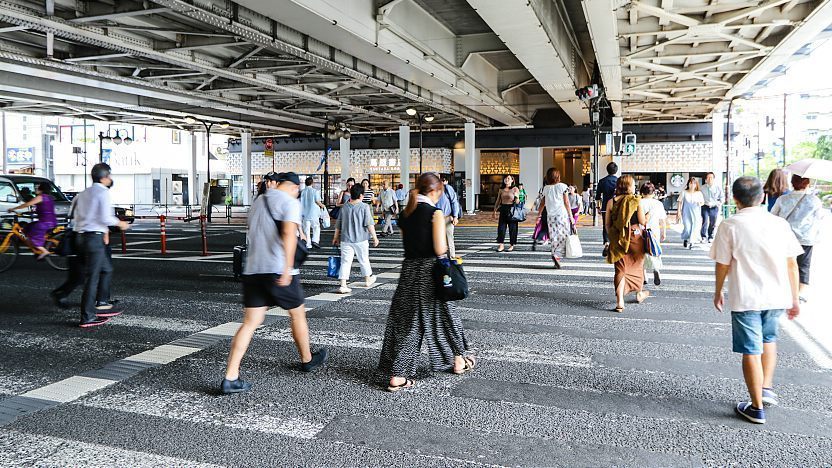
Sleeping on public transport
Traveling can get tiring, and it is common to see people sleeping on buses , trains and even on the train platforms. Theft on sleeping passengers remains relatively low, but as a solo female traveler there are a few additional things to look out for. If you are asleep, you will not know what is happening around you, and more often than not, fellow passengers will remain silent even if there are creepy people around you. Make sure that you do not expose yourself accidentally or invite intrusive gazes with your choice of clothes in addition to making sure that your belongings are secure. You cannot go wrong by erring on the conservative side when it comes to packing your travel wardrobe.
Sexual Offenses
Despite the seemingly low rate of provocation against women, there are certain areas where that ratio is skewed. Groping - inappropriate touching - and taking pictures from under a skirt or shorts (upskirting) are not uncommon occurrences especially on crowded trains.
Chikan is the Japanese term for groping and can refer to both the act of groping and the culprit. Sexual offenses on public transit have become prevalent enough that train companies especially in the bigger cities have introduced female-only train carriages to combat the issue (often during rush hours only). As a general rule of thumb, if you are worried about unwanted advances, it is best to avoid peak hours as a tourist and stick to the female-only carriage.
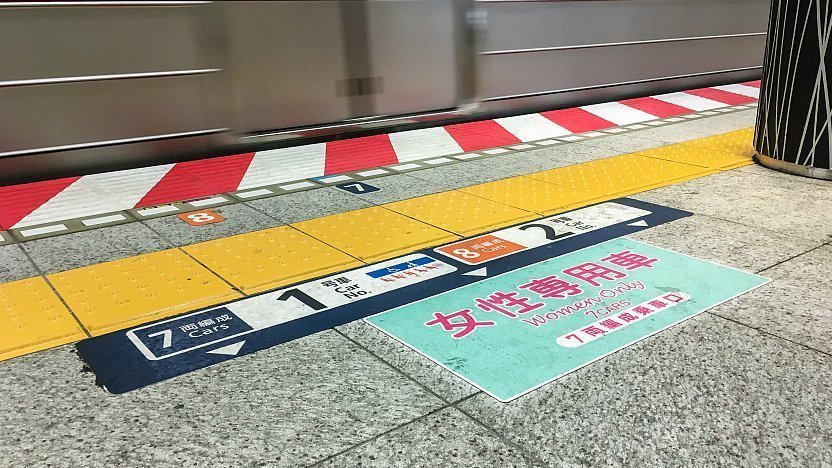
- Say "Stop!" or "Chikan!" to the culprit as keeping silent may escalate the situation and encourage the culprit to carry on
- If you are unable to identify the culprit, leave your spot and move somewhere else
- Grab the offender if possible or take note of any distinguishing marks or accessories on their person for future identification purposes
- Report the crime immediately to the train station staff or police
Questions? Ask in our forum .


- Privacy Policy
- Galapagos Islands
- Philippines
- Africa Overland
- New Zealand
- Solo Travel
- Backpacking
Japan , Solo Travel
Solo travel in japan: 16 helpful things to know.
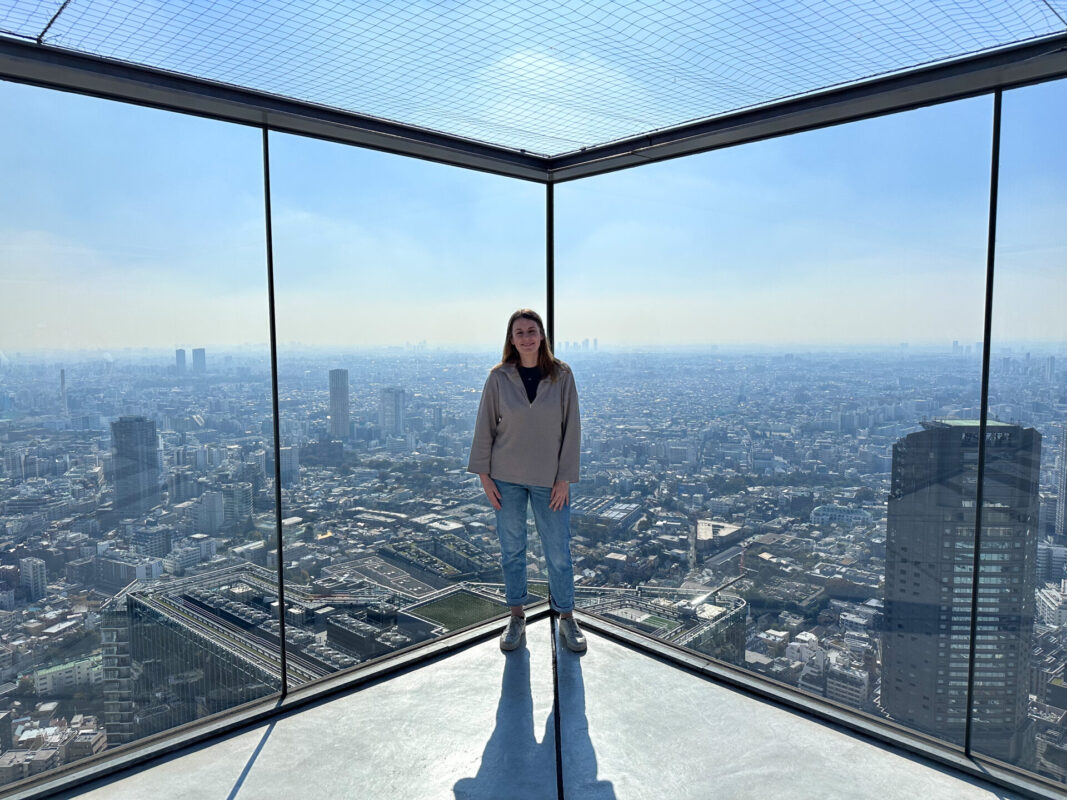
Table of Contents
Japan is like no other country in the world. It’s full of unique wonders, unforgettable experiences, and has a fascinating culture. Japan is often named one of the best countries in the world for solo travel. This makes it a popular destination for solo travellers, especially solo female travellers.
I spent almost four weeks solo travelling in Japan. I absolutely loved it. But I’d be lying if I said it wasn’t challenging at times.
In this post, I’ve shared all you need to know about solo travel in Japan. I’ve also attempted to answer the question: ‘Is Japan good for solo travel?’. While many blogs online say it is, I do think it’s important to also look at the negatives. Yes, Japan is an amazing country for solo travel. It’s safe and full of incredible sights. However, with many cultural and language barriers, it can be an isolating experience.

Despite the challenges of travelling solo in Japan, I do believe it’s a fantastic solo travel destination. I can’t wait to return one day and would happily go back as a solo traveller.
If you’re questioning whether travelling alone in Japan is right for you, I hope you find the below post useful. I’ve tried to be as honest as I can, sharing some of the disadvantages of solo travel in Japan as well as the many positives.
Japan is safe for solo travel
When it comes to the safest countries for solo travel, it doesn’t get much better than Japan. According to the Global Peace Index , Japan is the 9 th safest country in the world.
Serious crimes and petty crimes are infrequent occurrences in Japan. Many tourists happily walk around at night with no problems whatsoever. It’s even common for locals to leave their phones and laptops out in coffee shops while they go to the bathroom. Theft is that uncommon!
Of course, crime is always a possibility wherever you are in the world. While Japan might be on the safer side, it’s still important to be aware of your surroundings and not take any risks. This is especially true for solo female travellers.
The best time of year to visit Japan
Deciding when to visit Japan is a big decision. Each season offers something unique and special. Whenever you visit Japan, it promises to be an epic destination.
If you’re struggling to decide when to visit, here are some things to consider:
Spring (March to May) – spring in Japan marks the famous Cherry Blossom season (Sakura). As the weather warms and the days grow longer, Japan’s landscape is filled with beautiful cherry blossoms. This is the busiest time of year in Japan. Unless you’re desperate to see the famous cherry blossoms, I’d avoid visiting during this time. It can be very crowded and accommodation prices are much higher.
Summer (June to August) – the summer months in Japan can be hot and humid, especially in Tokyo. If you can cope with the heat, the summer is a great time to visit Japan. The Typhoon season in Japan is from May to October. This can sometimes have an impact on transport and activities, but it’s not an everyday occurrence by any means.
Autumn (September to November) – Autumn is the best time of year to visit Japan. The weather is cooler, the crowds are fewer and Japan lights up with red, orange and gold as the fall colours put on a show. Autumn in Japan is also the best time of year to see Mount Fuji. While the weather can never be guaranteed, the month of November boasts regular clear skies and sunny days.

Winter (December to February) – the winter months are a unique time to visit Japan. In areas such as Hokkaido, there is often heavy snowfall making it the perfect ski destination. Major cities such as Tokyo and Kyoto are also no strangers to snow. While the snow doesn’t tend to settle, it’s still a pretty sight. Winter is the quietest time to visit Japan, just remember to wrap up warm.
As you can see, Japan is a year-round destination. Depending on what you want to see and do, there’s not a bad time to visit as such.
How to get around Japan as a solo traveller
The best way to get around Japan is by using its fantastic train system. Japan is renowned for having one of the best rail networks in the entire world. It can take a bit of getting used to, but once you’re familiar with it, it’s a great way to get around Japan.
Most of the major Japanese cities have extensive public transit systems. Tokyo alone has one of the world’s biggest Metro systems. There are train and bus connections all around the city making it easy to get around. I didn’t use a taxi once while in Japan.
Japan Rail Pass
Many visitors to Japan opt to purchase a Japan Rail Pass. Depending on which pass you buy, the JR Pass allows unlimited use of its rail network. This includes the famous Shinkansen (bullet train).
Explaining the ins and outs of a JR pass is an article (or three) in itself, but there’s a helpful guide here . I’m working on a guide to answer the question ‘Is a JR pass worth it?’, but here are a few things to consider:
- The JR Pass can only be used on the JR Network. Many train connections in major cities and between cities aren’t operated by JR Rail. For example, it’s not going to be the most useful for getting around Tokyo.
- Other rail operators offer similar services between cities. These are often cheaper and depending on the route, don’t take that much longer.
- Consider looking at regional JR Passes rather than one that covers everywhere. I only bought a JR Pass that covered the Kansai area and this worked perfectly for me.
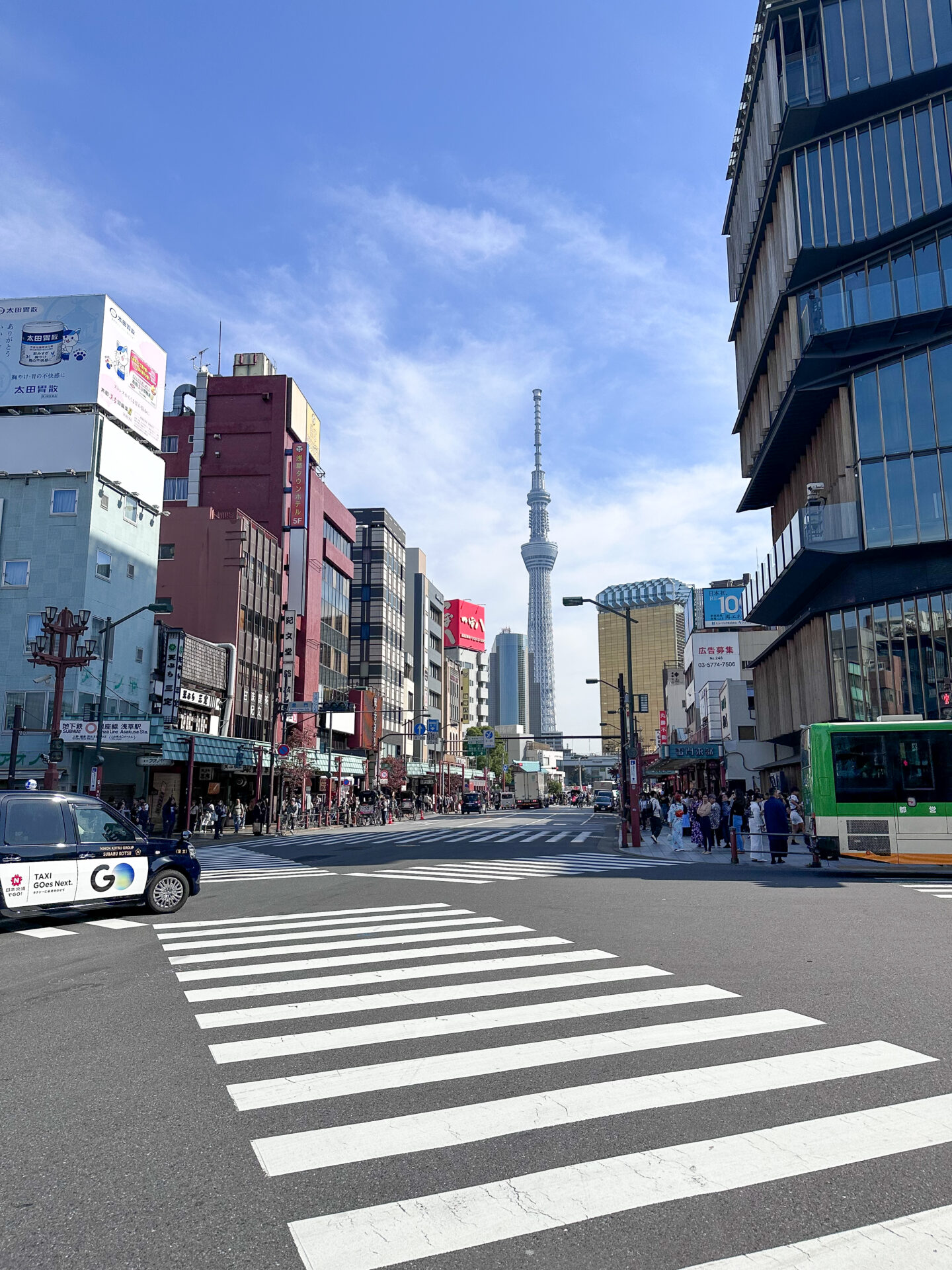
Pasmo or Suica Card
The Pasmo and Suica cards are both pre-paid travel cards. Think of them a little bit like an Oyster card in London. However, they can be used in many tourist destinations in Japan.
I only got a Suica Card on the last week of my trip and wish I had bought one sooner! You simply add money using a vending machine at a station, then tap in and tap out on your train and bus journeys. You can also use the cards to pay for lockers at stations and even in some shops such as 7-11.
Pasmo and Suica are generally interchangeable. I’d recommend waiting until you get to Japan to buy one. I found them to be a lot more expensive on the likes of Klook compared to buying one at the stations.
Tips for getting around Japan as a solo traveller
Download the J apan Travel App by NaviTime . This was a lifesaver on my trip.
Metro passes can save you money . All the major cities such as Tokyo and Kyoto offer 24-hour & 72-hour passes.
The trains in Japan are very punctual, don’t be late .
The train stations in Japan are HUGE and can be very overwhelming, especially the likes of Shinjuku and Tokyo Station. Arrive in plenty of time to find your platform .
Avoid travelling in rush hour , the trains can be very crowded.
The station staff are very friendly and helpful. Don’t be afraid to ask for directions or help .
The best places for solo travel in Japan
Building an itinerary for Japan is no easy task. I spent days and days (if not weeks) trying to figure out where I wanted to go in Japan and how long to stay in each place.
The truth is, it’s impossible to see Japan in one trip (unless you have months and months). You could spend a week in Tokyo alone and only scratch the surface of what the city has to offer.
Each of Japan’s cities has its own distinct charm with hidden gems waiting to be discovered.
Here are some of the best places to visit on a solo trip to Japan.
Tokyo is the capital city of Japan. It’s also the most populated city in the entire world!
There are mixed opinions on whether Tokyo is worth spending much time in. I personally love Tokyo! It’s a vibrant city with so many amazing and unique things to see and do . If it’s your first time in Japan, I highly recommend spending a few days here.
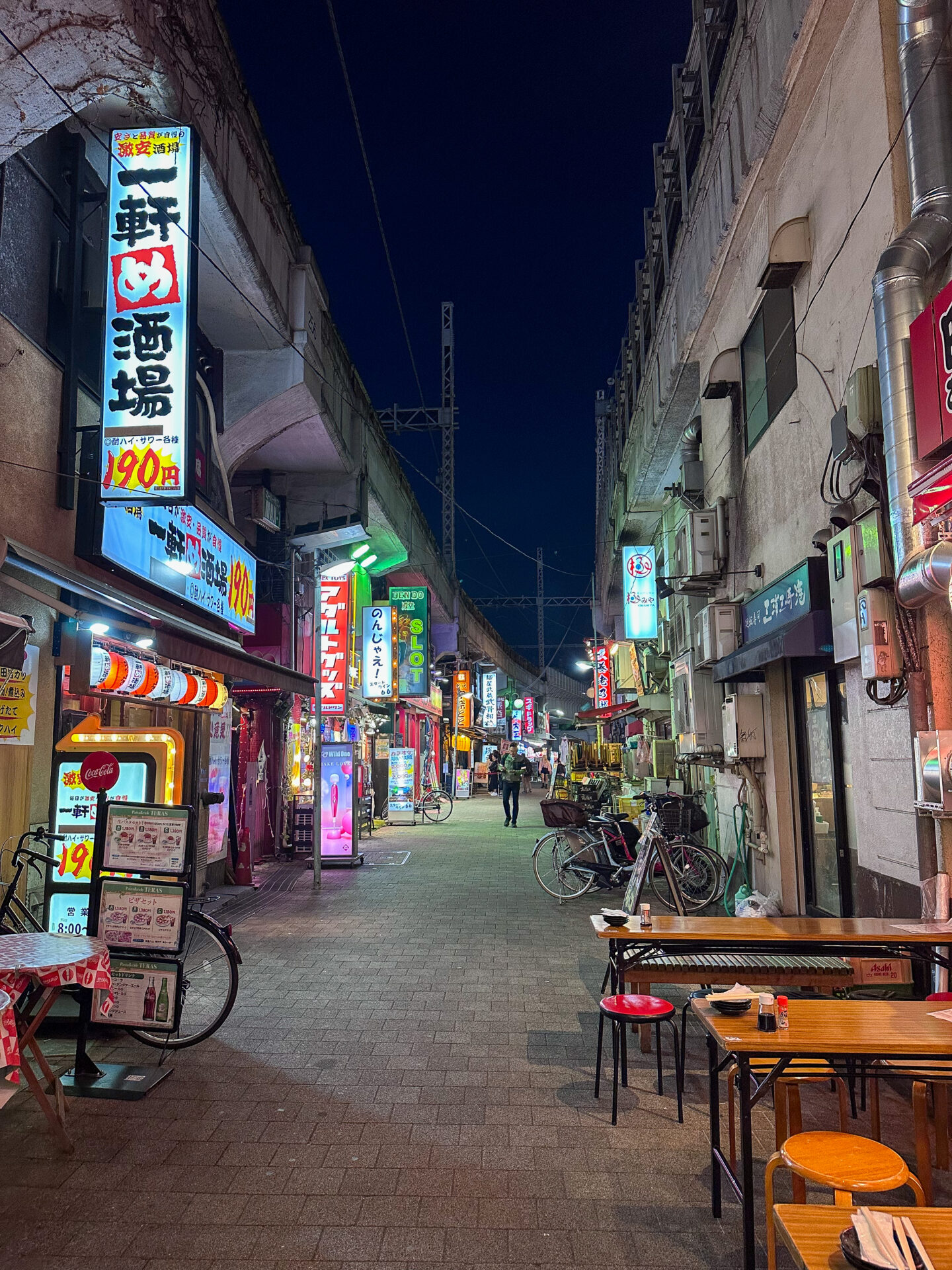
There’s an endless list of things to do in Tokyo, but don’t miss some of the highlights including Asakusa , Tokyo Skytree , Shibuya , Akihabara , Harajuku or Yanaka Ginza .
Suggested time to spend in Tokyo : four days
Best place to stay in Tokyo for solo travellers : I recommend staying at either Wise Owl Hostel in Shibuya or Nui Hostel in Asakusa.
Hakone
Hakone is my favourite place I visited on my solo trip to Japan. This beautiful area is nestled in the mountains and boasts some incredible scenery. Hakone is known for its relaxing hot springs (Onsen), traditional culture and epic views of Mount Fuji .
The area feels completely different to anywhere else in Japan (that’s on the tourist trail at least). It’s serene, laid-back and shows off an entirely different side to the country.
Hakone is the perfect day trip from Tokyo , but I’d recommend spending at least one night there to fully experience the area. There’s so much to do in the Hakone area and it would be impossible to see it all in one day. It’s also the perfect place to relax for a couple of days.

I have to say Hakone wasn’t the most social of areas. If you’re a solo traveller looking for nightlife and to meet other people, Hakone isn’t the place. But it’s beautiful nonetheless and a must-visit in my opinion.
Highlights in Hakone include the Lake Ashi Sightseeing Cruise, views of Mount Fuji , the Owakudani Volcanic Valley and the Mishima Skywalk .
Suggested time to spend in Hakone : 2 days
Best place to stay in Hakone for solo travellers : the Azito Guesthouse is the best hostel in Hakone
Related read: check out my suggested itinerary for Hakone
Kyoto is one of Japan’s most famous cities and an absolute must for anyone visiting Japan. If you’re interested in Japan’s history, Kyoto should be at the top of your list. There are 17 UNESCO World Heritage Sites in Kyoto, each offering a unique insight into Japanese culture and history.
Kyoto is home to many must-see attractions. From the famous orange Torii Gates of the Fushimi Inari Shrine to the Bamboo Forest of Arashiyama, Kyoto has a range of incredible sights. The Southern Higashiyama area of Kyoto is one of the best places to immerse yourself in Japan’s history. The area is known for its ancient temples, small boutiques and wooden tea houses. It’s also where you can sometimes see a Geisha.
While in Kyoto, don’t miss a trip to the Kiyomizu-dera Temple , a UNESCO World Heritage Site. This was one of my favourite temples I visited in Japan. It can get VERY crowded though, so go as early in the day as possible.
Suggested time to spend in Kyoto : 2 to 3 days.
Best hostels in Kyoto : Piece Hostel is one of the best hostels in Osaka. Len Kyoto is another good option.
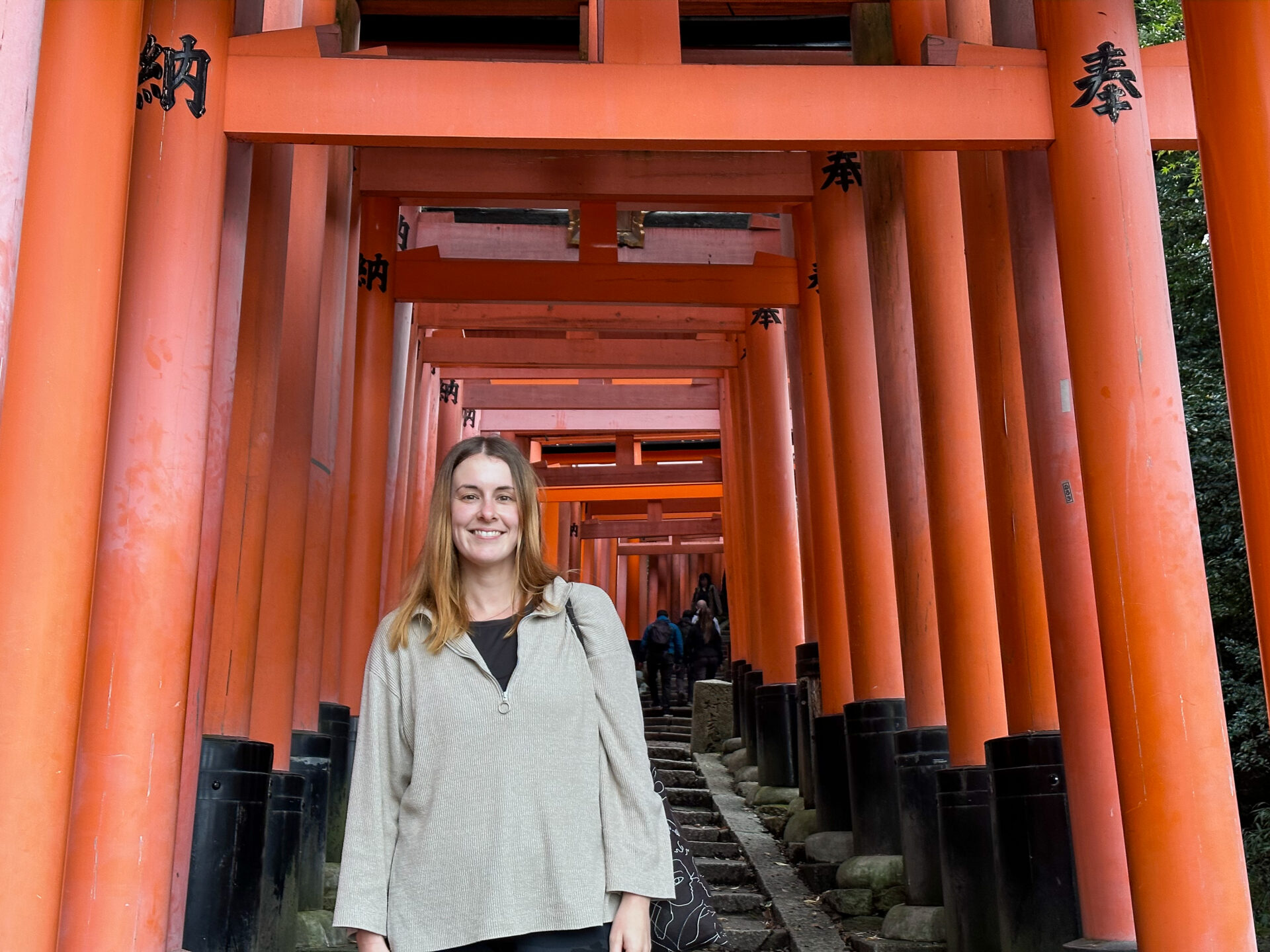
Osaka
Osaka is the perfect place to base yourself for a few days. It’s one of the biggest cities in Japan and has a completely different feel to it than Kyoto. The city is modern and vibrant but still has plenty of history attached to it. It also has some of the best food in Japan.
Osaka is a great base for day trips. There are so many epic day trips from Osaka including Nara , Kyoto , Hiroshima , Himeji and Kobe . While in Osaka, don’t miss a trip to the stunning Minoo Park . It’s a great escape from the crowds of Osaka.
Highlights in Osaka itself include Osaka Castle , the Umeda Sky Building , and the amazing street food .
Suggested time to spend in Osaka : at least 3 days
Best hostels in Osaka : I recommend staying in The Pax or Imano .
Hiroshima
A trip to Hiroshima offers a unique insight into Japan’s past. The city was the victim of a nuclear bomb back in 1945. Despite being destroyed, the city rebuilt itself.
One of the best things to do in Hiroshima is visit the Hiroshima Peace Museum . It educates visitors about the devastating incident, but also shows the resilience of the Japanese.
While in Hiroshima, a trip to Miyajima is a must. This beautiful island is home to the Itsukushima Shrine, one of the most beautiful shrines in all of Japan.
Suggested time to spend in Hiroshima : 2 days (or a day trip from Osaka, but you’ll struggle to see everything).
Best hostels in Hiroshima : I stayed at Akicafe Inn , it’s one of my all-time favourite hostels.
Related read: Plan your trip to Hiroshima and Miyajima with this 2-day itinerary suggestion

Okinawa is a great place to relax for a few days. This stunning area of Japan is home to white sand beaches and crystal clear water. It offers an entirely different experience for your trip to Japan.
There’s not a huge amount of things to do in the area, but if you want to relax on the beach and snorkel in the ocean, Okinawa is the perfect destination.
Suggested time to spend in Okinawa: 3 days
Best hostel in Okinawa : MyPlace Guest House
There are lots of hostels in Japan
Staying in hostels is a fantastic way to meet other travellers when on a solo trip to Japan. The Japanese hostels are some of the nicest hostels I’ve ever stayed in. They are clean, modern, and often have privacy curtains on the beds. For solo female travellers, many also have female-only dorm rooms as well as private rooms.
Staying in hostels is a great way to meet new friends and fellow travellers who share similar interests. However, I have to say I didn’t find the hostels in Japan the most social of places.
This might have just been my experience, but I found it harder to meet people in hostels here than in other countries. I think this was due to a combination of things.
Japanese hostels very much cater to Japanese locals as well as tourists from Western countries. I spent nearly four weeks staying in Japanese hostels. There were only a handful of nights when other Westerners were in my dorm room. Of course, this isn’t an issue, but there was a big language barrier which made it hard to be social.
Japan also isn’t the most popular destination for backpacking. I assume this is due to the cost and being out of the way of the traditional Southeast Asia backpacking route. Yes, there are solo travellers in Japan. But nothing like the amount you’ll find in countries such as Thailand, Vietnam and Australia.
As I said, this was just my experience. I know some people who have travelled solo in Japan and met lots of other people. I also know many people who had the same experience as me. They found it harder to make friends than in other countries.
Another great accommodation option in Japan is the capsule hotels. These tend to offer a little more privacy than dorm rooms. They’re very popular with the locals and much cheaper than a hotel room.
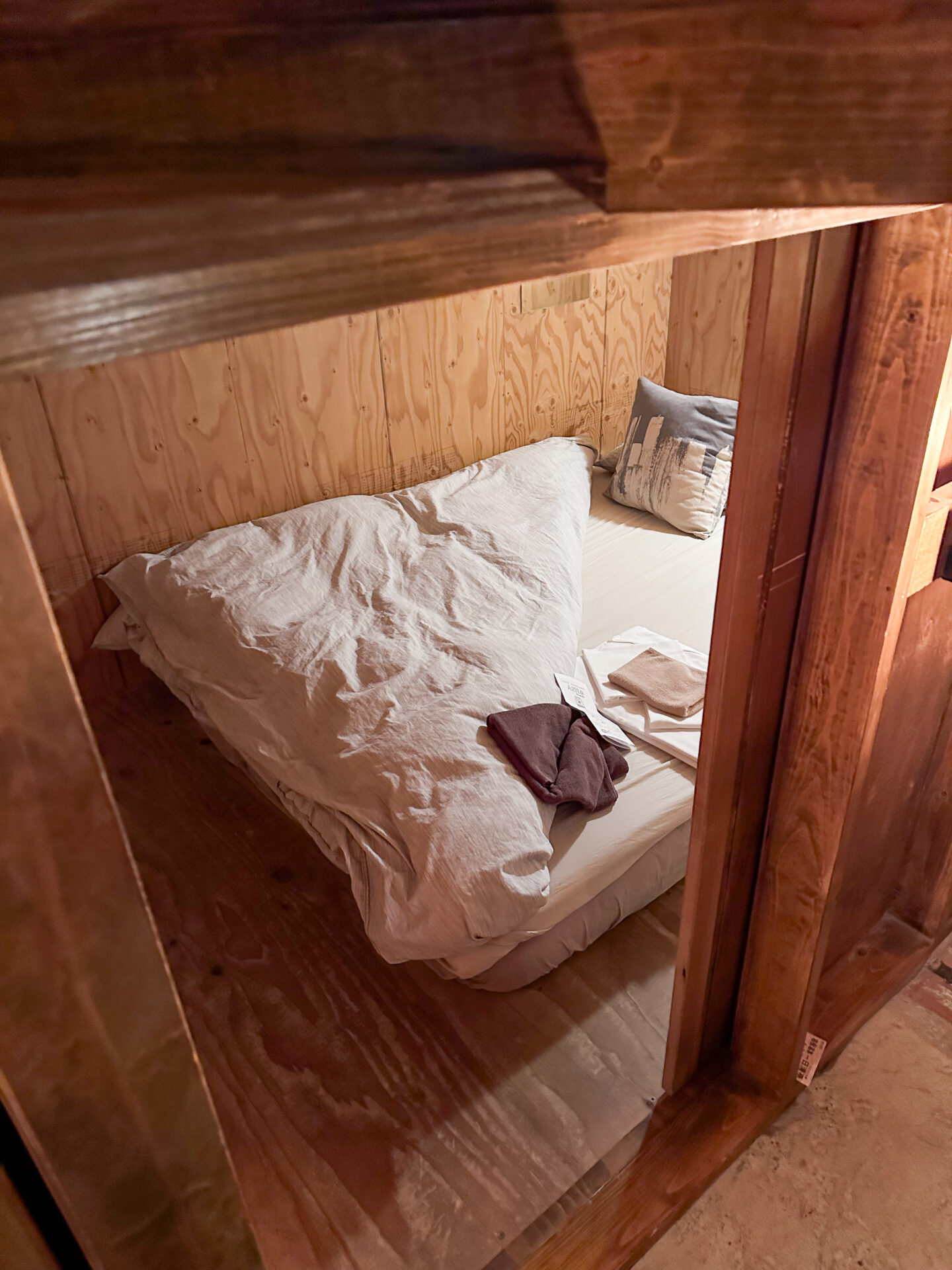
It’s important to do some research beforehand
Visiting Japan can be an overwhelming experience. I don’t think it’s the type of place where you can turn up and ‘wing it’ without doing any prior research. This is especially true when it comes to solo travel in Japan.
Even if you want to keep your itinerary open for some flexibility, here are some things I believe it’s important to research before your trip to Japan:
- Where to stay in each city : Japan’s cities are HUGE and there are many different areas to choose from. Do some research to make sure you choose the right spot.
- The cheapest way to get around Japan : many people assume a JR Pass will save them money. This wasn’t my experience. Spend some time calculating the cheapest method to get around for your itinerary.
- Social norms and rules: Japan has a unique set of social norms. Spend some time researching this beforehand. For example, did you know it’s considered rude to eat food in the street while walking?
- Top things to do in each city : there is an endless list of things to see and do in Japan and some of the activities require some planning or booking ahead. Don’t miss out on experiencing something because you researched it too late.
Have an open mind
Travelling solo in Japan can push even the most confident of solo travellers out of their comfort zone a little bit. The country has a unique set of social and societal norms and it’s important to keep an open mind.
Try the unusual foods, ask the locals questions and immerse yourself in their culture.
One of the best ways to experience Japanese culture is to stay in a Ryokan. These traditional Japanese accommodations often include tatami-matted rooms and communal baths. Staying in a Ryokan is an absolute must while in Japan.
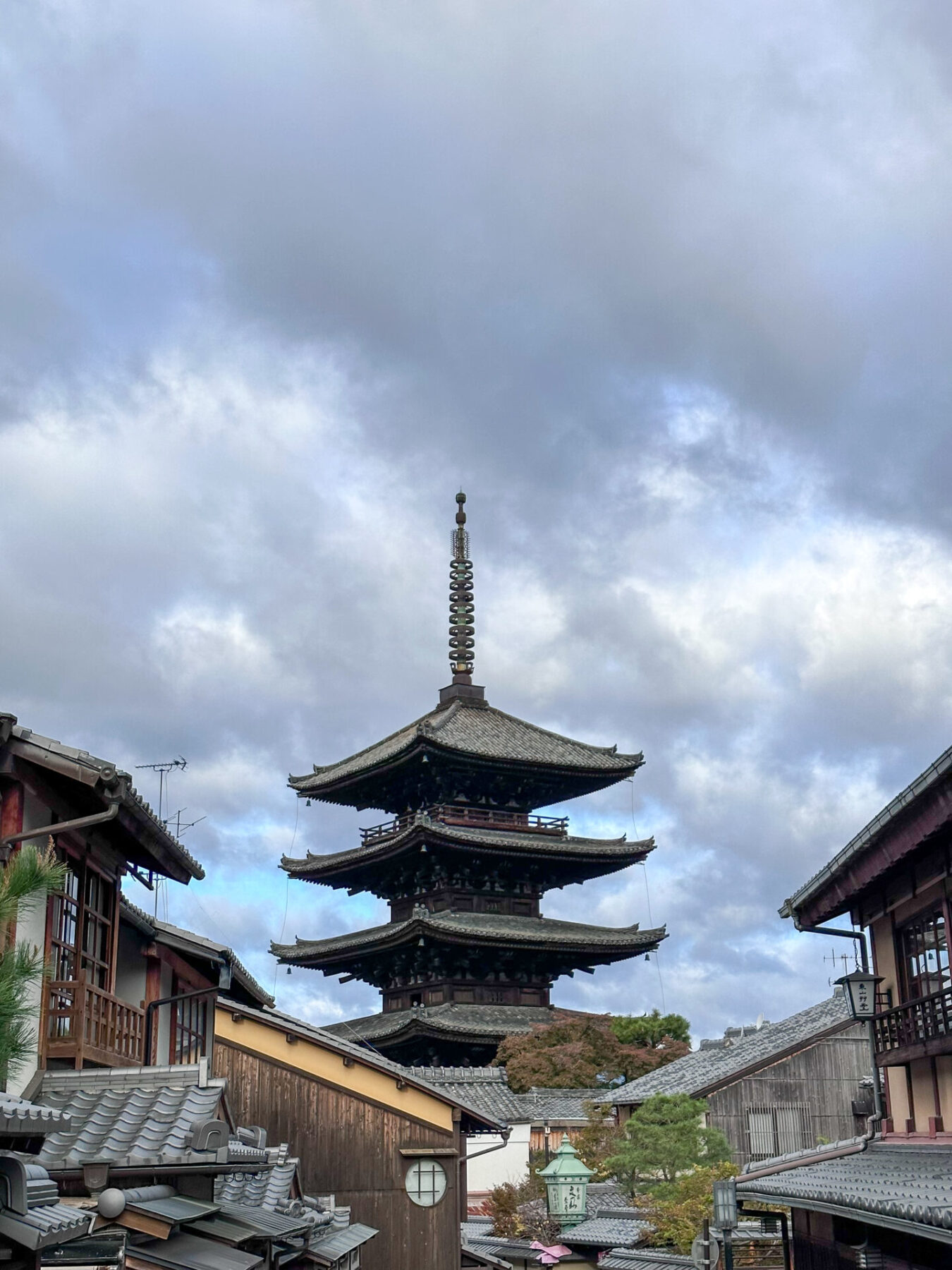
It can feel isolating
Solo travel in Japan can be isolating and challenging. When planning my solo trip to Japan, many blogs only stated the benefits, so I want to talk about the negatives too.
If you’ve never travelled solo before or you’re a bit nervous about travelling solo , I don’t believe Japan is the best place to start. The country has a very unique culture and while this is fascinating and wonderful, it can feel isolating.
As I discussed above, the hostels in Japan aren’t always the most social of places and it can be difficult to make friends. There’s also a big language barrier with many of the locals not speaking English.
While solo travel is perfectly normal and accepted by Japanese society, I did sometimes feel a little on the “outside”. Even little things like working out how the restaurant vending machines worked or buying a train ticket can be difficult.
I don’t want to put anyone off from travelling alone in Japan. It can be an incredibly liberating experience. Most solo travellers love their time in Japan.
There are so many benefits to solo travel and Japan is no exception to this. However, I think it’s important to share the challenging side of solo travel in Japan as well.
The food is amazing
The food in Japan is some of the BEST in the entire WORLD. If I had to eat one cuisine for the rest of my life, it would be Japanese food! A big part of your solo adventure in Japan is experiencing this incredible food.
Contrary to popular belief, there is so much more to Japanese cuisine than fish. I don’t eat fish but this didn’t affect my experience in Japan at all. Many people also assume Japanese food is expensive. If you’re going to go to fancy restaurants every night and eat Kobe beef or fresh sushi then yes, it’s expensive. Likewise, the restaurants catering to Western tourists also have a hefty price tag.
However, there are *so* many hidden and affordable food gems in Japan. Some of my favourite meals were in tiny restaurants with only a few reviews on Google.
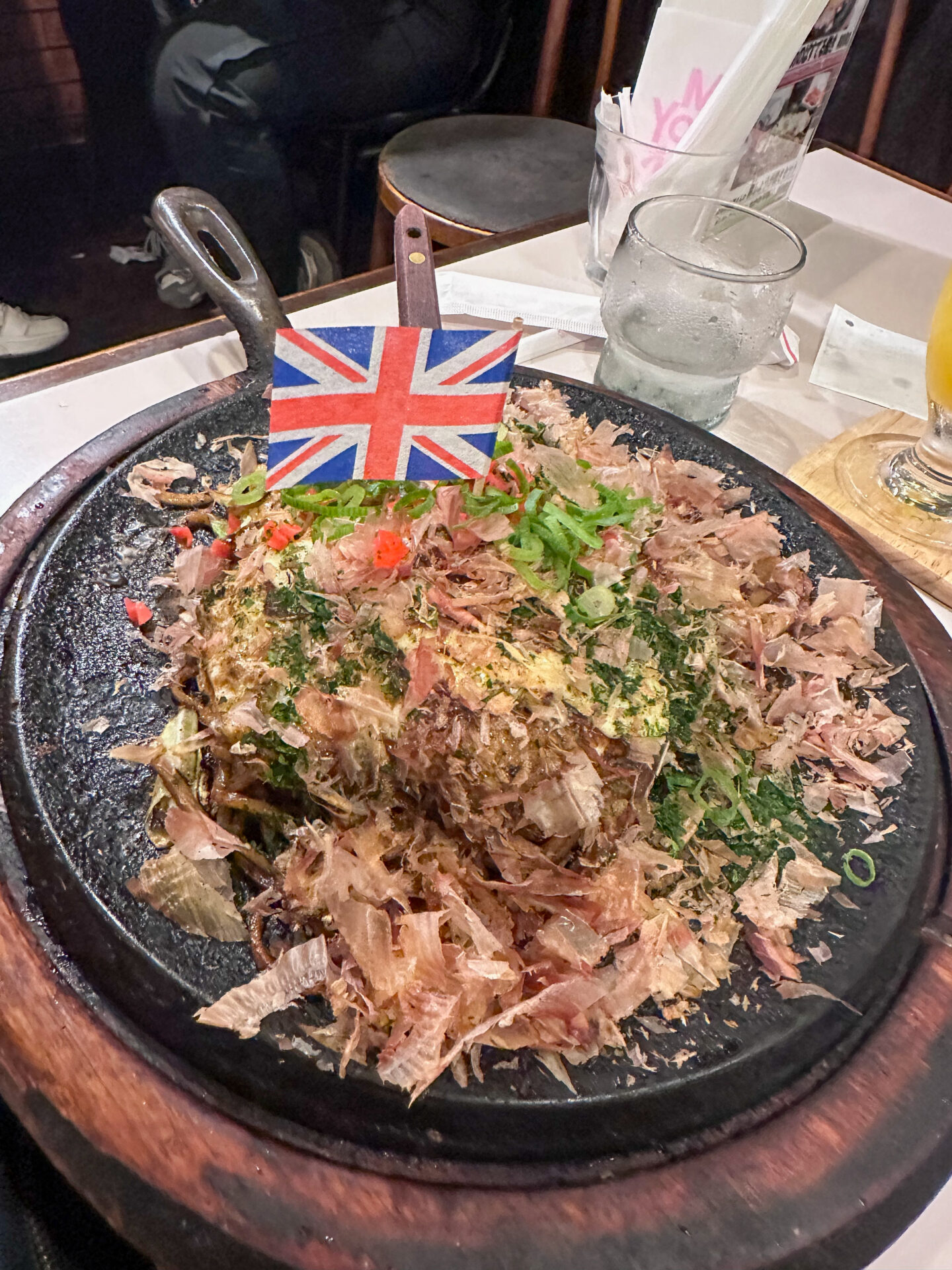
My best advice is to avoid the tourist spots and look for where the locals are. Most of the meals I bought were around the $7 mark.
Tip : TikTok raves about Gyukatsu, but this was one of my least favourite meals in all of Japan.
Street food in Japan is another good way to eat on a budget. Each area of Japan has its unique foods and style of cooking. This means the street food never gets old and there’s always something new to try.
My favourite budget food spots in Japan
- Curry bread from Tokyo Curry Pan in Asakusa (this was amazing)
- Gyoza from Nishiki Market in Kyoto .
- Beef and cheese croquettes from Kuroge in Asakusa
- Taiyaki (fish-shaped pastry stuffed with red beans or cheese). This can be found all over Japan
- Okonomiyaki (savoury pancake) from Doraju in Osak a
- Yakisoba from Mr Young Men in Kyoto
- Japanese Curry from Cocoro in Hakone .
- Curry Udon Tachibana in Osaka .
If you’re on a tight budget, the convenience stores in Japan are a great option. They have a range of delicious and high-quality sandwiches, sushi, salads, bento boxes, smoothies… the list goes on. It’s all very affordable. The 7-11 in Japan is unreal and you’ll find one on every corner. I also recommend trying Family Mart (who I think do the better coffee).
Tip : when planning a solo trip to Japan, it’s fair to question if it’s normal to eat out alone. Luckily, eating out by yourself is almost completely normal in Japan. Ironically, the only places I felt a little uneasy were the Western restaurants full of tourists. It’s completely normal for Japanese people to eat dinner by themselves. Many restaurants even cater to solo diners by having solo booths or tables with one seat.
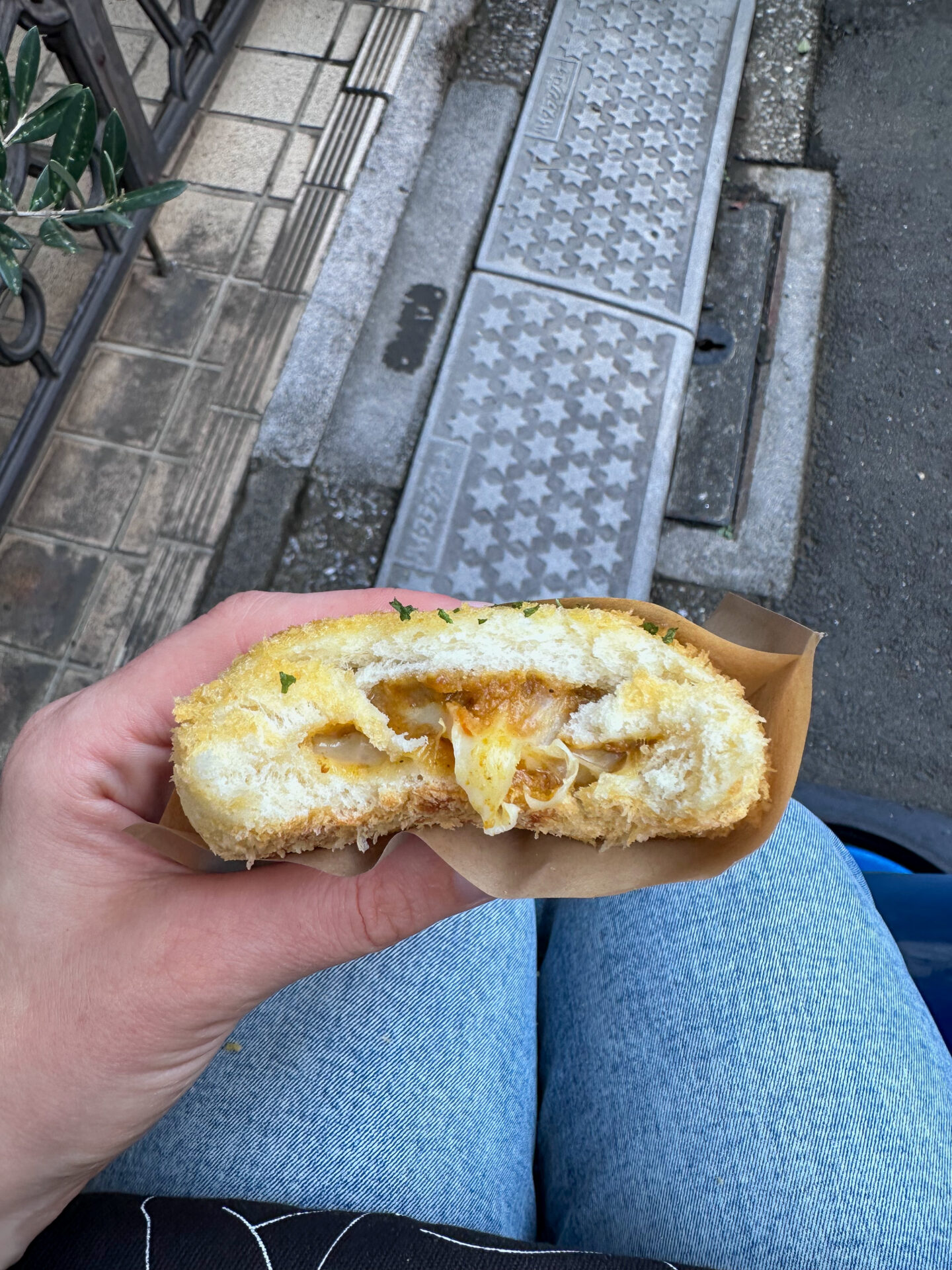
There are several helpful apps to download
Before embarking on your solo trip to Japan, there are a few helpful apps to download.
Japan Travel by Navitime
If I could only use one app in Japan it would be this one. The Japan Travel app is incredibly useful. It’s similar to Google Maps in that it will tell you how to get somewhere, but I found it to be a lot more accurate. It tells you the best place to sit on the train and which exit to use to get to your destination. I’d have been lost without this app.
The best part about the Japan Travel app is you’re able to say which rail pass you have. Whether it’s a JR pass or a regular Metro pass, it will tell you if the route is included on the ticket or not.
It makes travelling in Japan so much easier and less stressful.
Google Maps
While the Japan Travel app is useful for bus and train journeys, I’d still recommend downloading Google Maps for navigating the cities on foot. Download the maps offline in advance first so you can get around Japan without the internet.
Google Translate
This is another app I could not have lived without while in Japan. There are a couple of major language barriers in Japan. The locals don’t speak much English, but you’ll also find many menus or shopping items are only in Japanese. The Google Translate app is a great solution for this. You can type in what you want to say and show it to the locals. It’s also possible to take photos of writing and the app will translate it for you.
Many Japanese locals also use a translation app when communicating with tourists.
The tap water in Japan is clean and safe to drink. However, I found it tricky to fill up my reusable bottle during the day. Thankfully, the Mizu app is here to solve that problem.
The app shows you the nearest place to fill up your reusable bottle. This is sometimes water refill stations or cafes that will happily do it for you even if you’re not a customer.
Always carry cash
Despite being home to many major cities and modern inventions, Japan is still very much a cash-first country. Many local restaurants and cafes only accept cash.
It’s important to always carry cash with you in Japan. Some places will accept debit or credit cards, but I had a few issues so would recommend sticking to cash as much as you can.

Be aware of scams and crime
Japan is a very safe country, but crimes and scams do occur, especially in the big cities. When travelling solo in Japan, it’s important to exercise some caution.
One of the most common types of scams in Japan is nightclub scams. This is when tourists are lured into bars and clubs. The staff keep the drinks coming and then charge an excessive amount on the bill. The receipts are nearly always in Japanese which means many victims fail to notice until it’s too late. They often add random charges such as charging for seats or charging for being there on a weekend. If you’re invited into a bar, the best thing is to say no.
If you’re a female solo traveller, it’s always important to follow some basic safety guidelines wherever you are in the world. Yes, Japan is very safe and the chances of something happening are low. But that doesn’t mean it’s a good idea to go walking down dark alleys alone at 3 am.
You might need to book ahead of time
One of the best things about solo travel is having the freedom to do what you want and change your plans. However, this isn’t always the case in Japan.
Each year, millions and millions of people head to Japan to explore this amazing country. If you’re visiting Japan during the peak season, you may need to book your accommodation, transport and activities ahead of time. The busiest months in Japan are March, April and May. The summer holidays and autumn months can also see a spike in visitors.
I booked my accommodation about six weeks before my November trip. I found many of the budget hostels with a good rating had almost sold out (and some had completely sold out). Activities such as TeamLab Tokyo and the Harry Potter Studio Tour had also almost sold out.
Solo travellers without a fixed timeframe might not need to worry about booking ahead. However, if you have a set amount of time and there are specific things you want to see and do, I’d advise booking ahead.
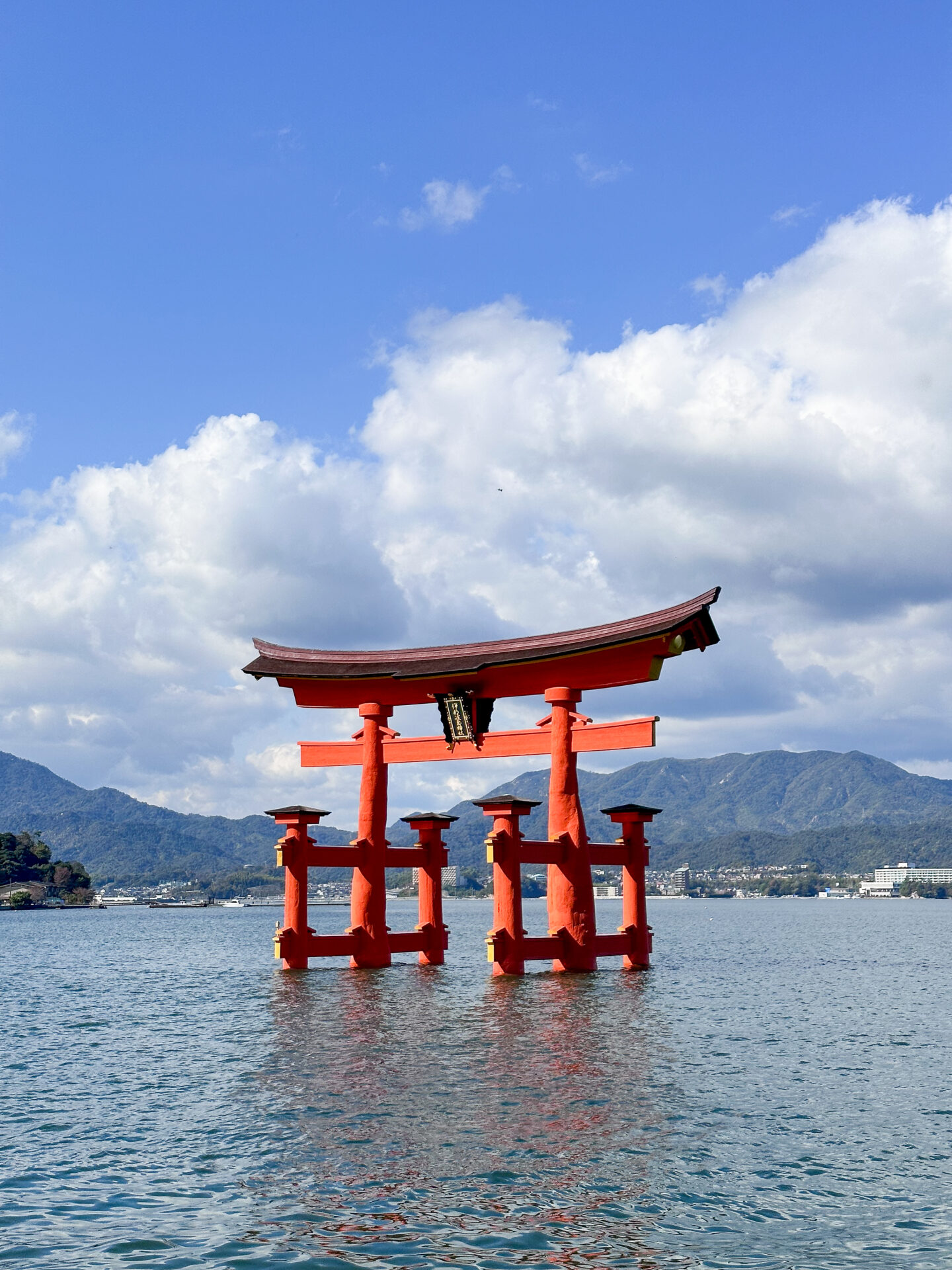
Avoid tourist traps
Solo travel in Japan is a great opportunity to immerse yourself in Japanese culture and local life. You have the complete freedom to do what you want and at your own pace.
One thing I noticed in Japan was the amount of tourist traps. These were usually destinations only popular thanks to TikTok and other social media platforms. As a solo traveller, you have the choice to completely avoid these and don’t need to worry about what someone else might want to do.
Consider going off the beaten track while on your visit to Japan. You can still visit the likes of Tokyo and Kyoto, but consider exploring some lesser-visited areas of the cities such as Yanaka Ginza or Uji . There are also plenty of amazing day trips from Tokyo and Osaka to lesser-visited destinations. I was gutted I didn’t get to explore more of these destinations.
My next trip to Japan will certainly be more focused on escaping the crowds and discovering hidden spots.
Consider group tours in Japan
If you’re nervous about solo travel in Japan, consider a group tour. Small group tours are an amazing way to explore a country if you’re too nervous to travel completely alone.
Related read: everything you need to know about group tours
There are several small group tour operators in Japan. Each of the tours includes a tour guide, accommodation, transport and some activities. Some of my favourite small group tour operators in Japan are G Adventures , Intro Travel and One Life Adventures . Intrepid are another fantastic option, and they tend to cater towards an older demographic.
If you want to visit Japan but are nervous about going alone, group trips could be the answer!

Buy an eSim
It’s a good idea to stay connected while in Japan. As a solo traveller, it’s good to have a way of contacting someone in case of an emergency. In Japan especially, I found myself using my phone more than ever. This was mainly due to using the Google Translate App, or quickly researching something while out and about.
SIM Cards in Japan aren’t quite as straightforward as in other countries. Tourists can only buy data plans and they are very expensive.
The best solution is to buy an eSim. It’s still expensive, but it removes the need to worry about a physical SIM.
Normally, I’d recommend using the trusty Airalo. For Japan, I suggest using Ubigi . Ubigi has a much better network in Japan compared to Airalo.
Summary: is Japan good for solo travel?
Yes, Japan is great for solo travellers. When it comes to safety and getting around, it doesn’t get much better than Japan. Not only is Japan one of the safest countries in the world, but it has a great infrastructure making it an easy country to navigate.

However, I don’t think Japan is the best destination for every first-time solo traveller. Japan can sometimes feel very isolating. You need to be confident in the busy cities, deal with cultural differences and overcome the language barrier all by yourself. You also need to be comfortable with your own company and happy to explore Japan by yourself.
I haven’t said that intending to discourage solo travel in Japan. I just want to be entirely honest based on my experience in Japan. It’s a completely different solo travel experience to the likes of Thailand, Mexico or Australia. Having said that, solo travel in Japan is an amazing way to push yourself out of your comfort zone and immerse yourself in the culture.
If you’re a confident solo traveller, then Japan is one of the best solo travel destinations in the world. With a low crime rate, fantastic public transportation and unique attractions steeped in history, it is an incredible destination.
Ultimately, only you can decide if Japan is the right solo travel destination for you. Put it this way, I’m glad I went to Japan alone. But I’m also glad it wasn’t my first solo trip. However you travel in Japan, it will no doubt be an unforgettable experience!

Related Posts
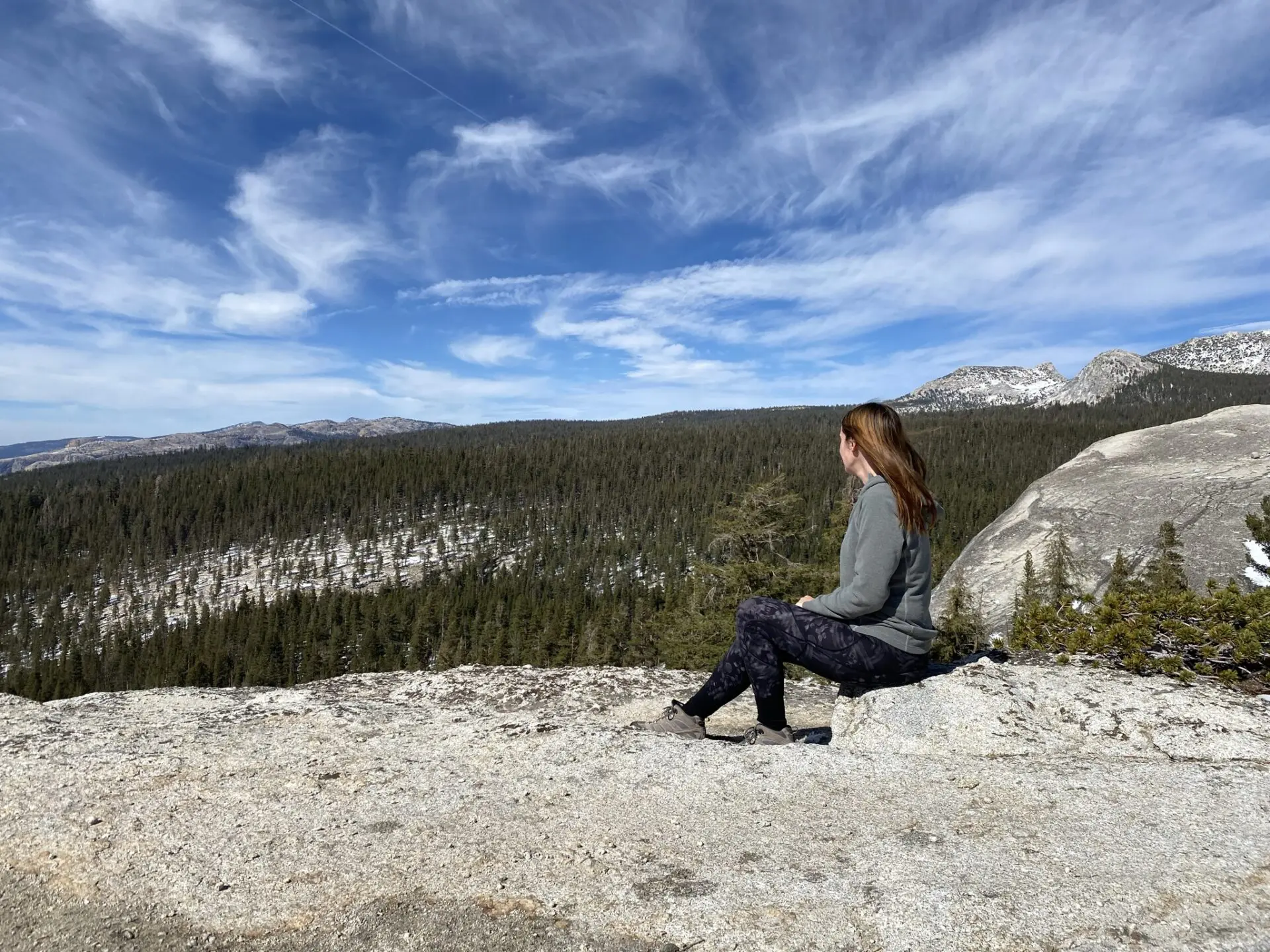
Solo Female Travel: 13 Helpful Tips for Hiking Alone
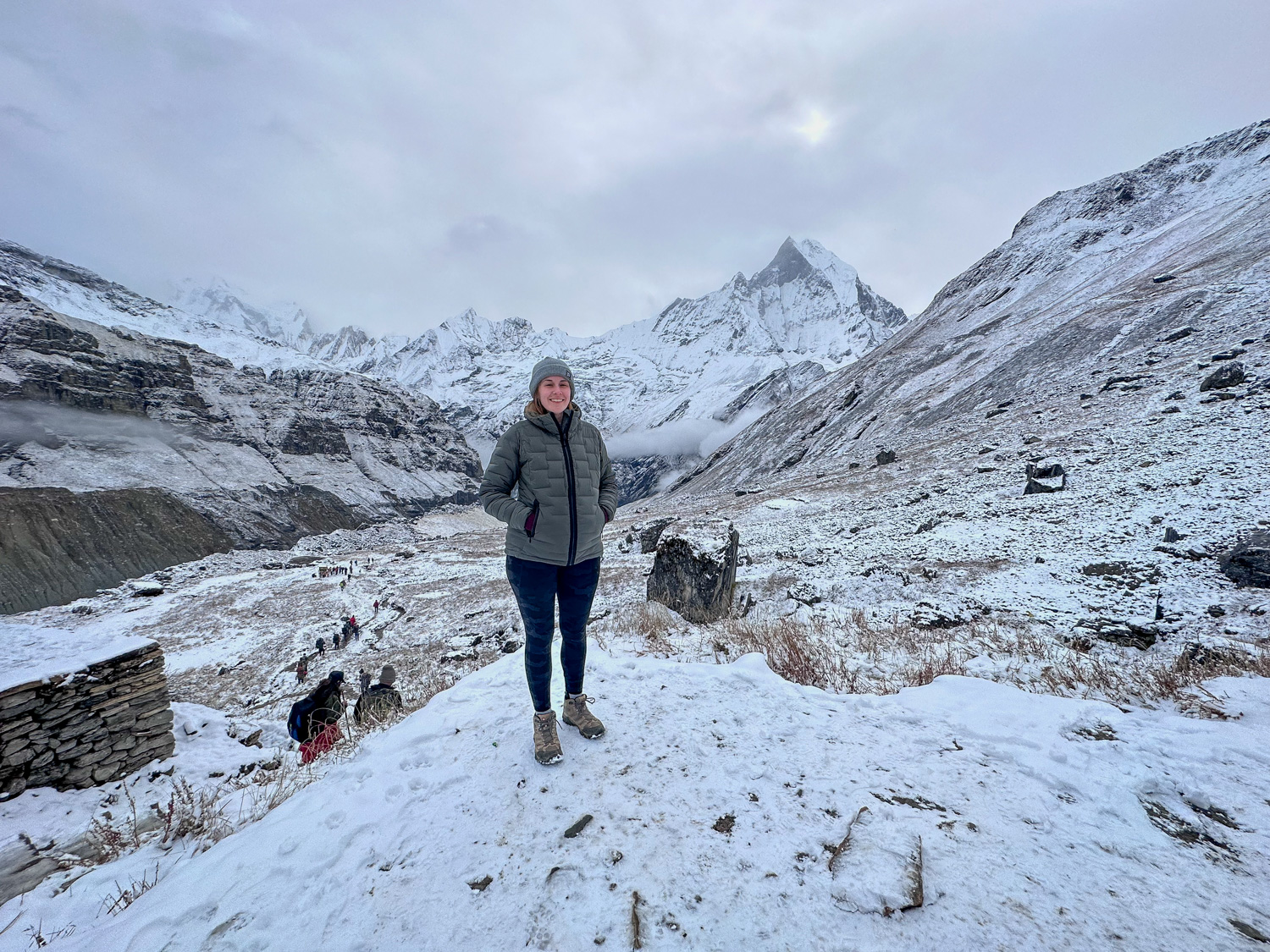
Solo Travel in Nepal: Everything You Need to Know in 2024

Is Ecuador Safe for Solo Female Travellers? A Guide to Solo Travel and Staying Safe
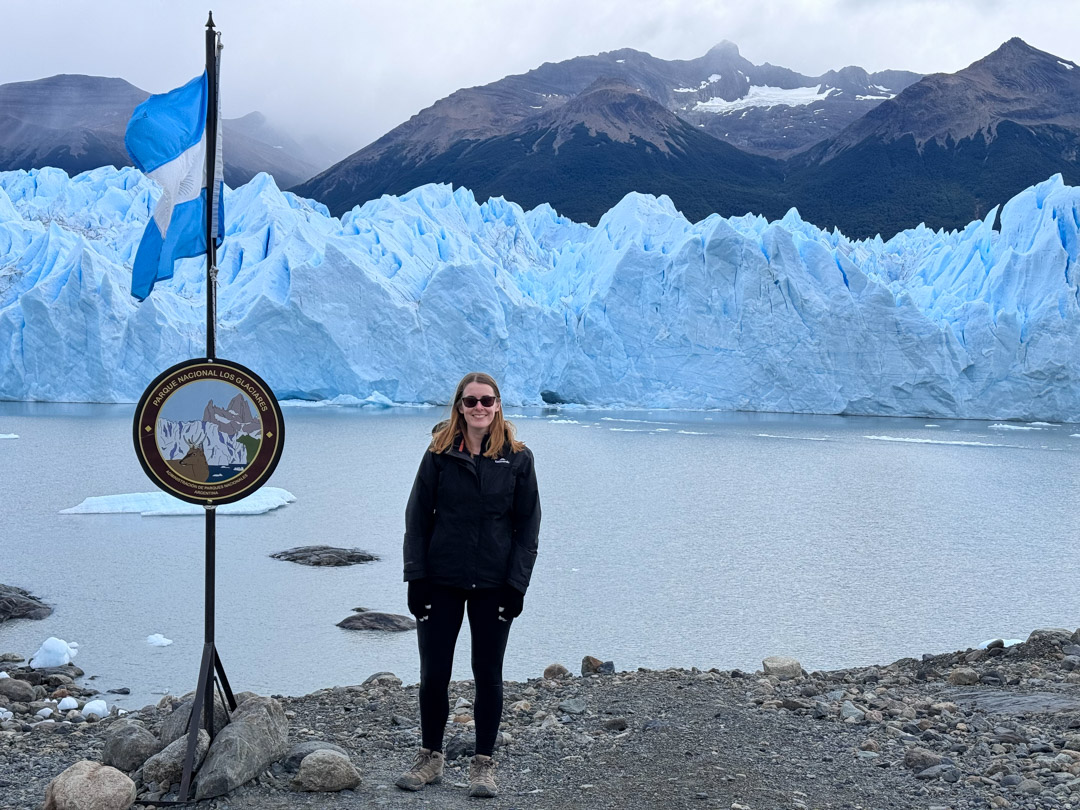
Solo Travel in Argentina: 12 Helpful Tips For Your Trip
- Meet the Team
- Our Manifesto
- Work with Us
- Budget Travel
- Personal Development
- Work & Travel
- United Kingdom
- More of Europe
- Philippines
- More of Southeast Asia
- More of South America
- More of Central America
- South Korea
- More of Asia
- More of North America
- New Zealand
- Pacific Islands
- More of Oceania
- South Africa
- More of Africa
- More of the Middle East
- Travel Essentials
- Travel Gear
Home » Asia » Japan » ULTIMATE Guide to Solo Travel in Japan | Destinations & Tips for 2023
ULTIMATE Guide to Solo Travel in Japan | Destinations & Tips for 2023
Japan is the DREAM for many curious travelers. Manga, anime, sushi, cherry blossoms, Nintendo, Toyota, hot spring pools, Buddhist temples; the thought of these lit a fire in me! But with no one willing to tag along for the ride, I had to start planning a Japan solo travel trip.
There’s nothing like relaxing in hot spring pools, listening to Japanese patrons, eating real Japanese sushi under Tokyo Tower. And believe me, visiting Japan is even better solo .
You can take your time. You’ll get to know the locals and test your language skills. Japan is also extremely friendly and safe.
It’s perfect for lone wolf adventures through her many islands. You can experience it all by taking in the beauty of her rural landscapes or venturing into her busy cities at the forefront of high tech.
With all the excitement of traveling to Japan, I’m here to jump-start this new endeavor as you plan this journey to experience the beauty of Nihon and Nippon for yourself. So, let’s start with how to make the most of your solo traveling in Japan, the best places to stay, where to go, and how to survive in this unique country.

The Broke Backpacker is supported by you . Clicking through our links may earn us a small affiliate commission, and that's what allows us to keep producing free content 🙂 Learn more .
7 Things to Do in Japan When Traveling Solo
5 best solo destinations in japan, the best travel apps for solo travel in japan, safety tips for solo travelers in japan, tips for solo traveling in japan, how to meet people when solo traveling in japan, final words for solo travelers in japan.
Backpacking Japan is EPIC. Can’t find a buddy to go with? Go alone!
I’m here to show you that traveling solo in Japan is a breeze . However, there are seven things that you should consider when traveling around the country. These can be things to do alone, taking full advantage of your solo experience, or activities you could do with your new travel friends.

Unlock Our GREATEST Travel Secrets!
Sign up for our newsletter and get the best travel tips delivered right to your inbox.
Hangout in Hostels
One of the best solo travel tips is to stay in one of the amazing hostels in Japan !
You can meet fellow travelers while staying in a great place on a reasonable budget. You can save money and rely only on your bedroom to sleep, with the option to socialize with others in shared lunging areas or use those extra funds to see more of Japan. Hostels also have various accommodation options, so even a solo female traveler is well cared for.
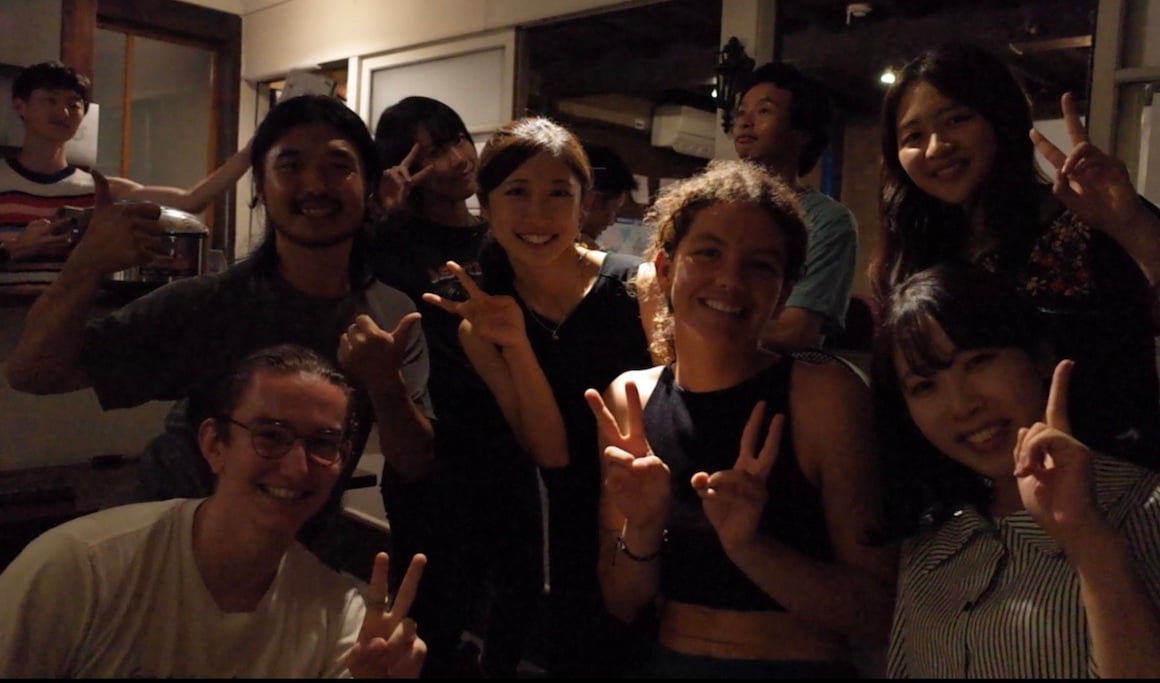
Take a Group Tour
Even if you ride solo in Japan, taking a group tour is a great way to break up the experience and keep yourself sane with socializing. Sometimes it’s nice to relax and let a tour guide take you to some unique attractions as you lay back and have a yarn with a fellow traveler.
I loved the bus tour of Tokyo because I could sit and chat to all my new buddies while escaping the rain.
Stay as a Home Stay With a Japanese Family
If you want to test your Japanese and get a taste of traditional life in Japan, the best way to do this is to organize a homestay with a Japanese family. Despite it being more common for younger adults and teenagers, there is no age limit for homestays. There are many brilliant companies like Go! Go! Nihon that makes it easy.
Spend a Relaxing Day at an Onsen Hot Pool
One of Japan’s most famous past times is relaxing in an Onsen Hot pool, and considering this is often a solo experience, it is one of the best ways to relax on holiday. There are many places in Japan that host hot pools. However, the most famous is Kurokawa Onsen, found in Minamioguni.
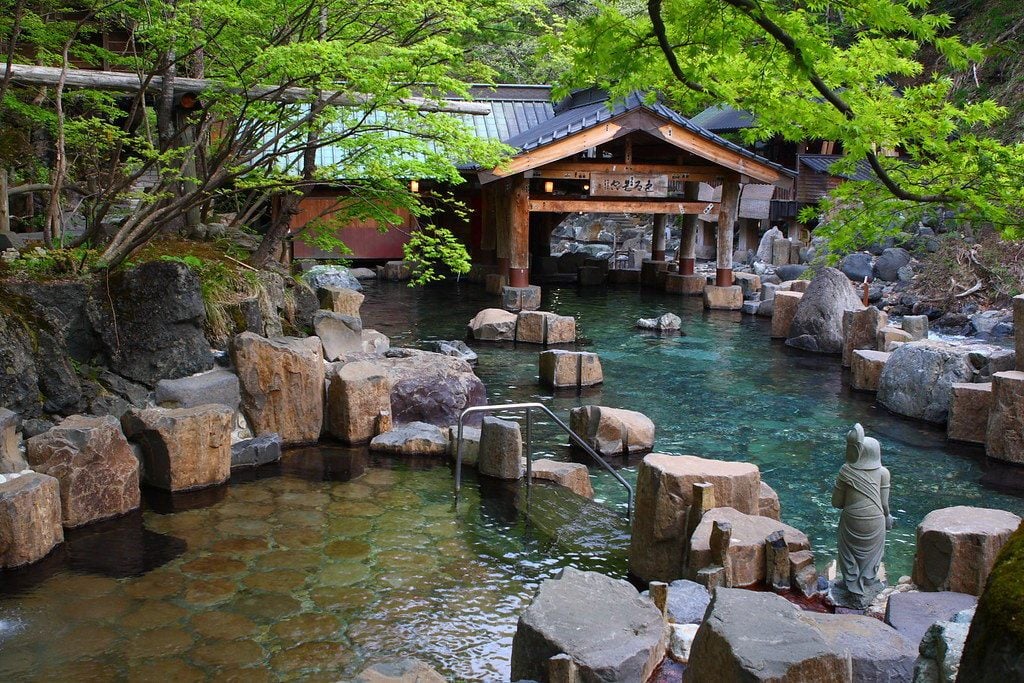
Have a Quiet Trip to a Traditional Japanese Shrine
Wherever you find yourself in Japan, you are likely to encounter a traditional Japanese shrine, and what better way to learn about the cultural heritage of its people and spend some quiet alone time than a trip to these places! In Tokyo, a popular shrine is Ise Jingu, a beautiful 4 th -century BC shrine dedicated to public happiness.
Relax With a Traditional Tea Ceremony
Experience the ancient tradition of ‘way of the tea’ as you taste one of Japan’s most sacred ceremonies. This quiet Japan solo travel experience allows you to witness first-hand the ceremony and the delicious taste of tea. Kyoto and Uji have various places for tourists to experience this tea ceremony.
Attend a Japanese Language Class
If your language skills could do a little more work, attending a Japanese language class is a great solo adventure in Japan. You can meet others trying to learn the craft and practice at your own pace, then test what you’ve learned in your solo ventures around Japan.

We’ve tested countless backpacks over the years, but there’s one that has always been the best and remains the best buy for adventurers: the broke backpacker-approved Osprey Aether and Ariel series.
Want more deetz on why these packs are so damn perfect? Then read our comprehensive review for the inside scoop!
Japan is like nothing else. But why? It’s a place I found where you’ll find something magical, futuristic, and unexpected around every corner.
The people and their culture will make you understand why Japan is a special place to so many people (including ourselves). I have hand-picked five of the best solo destinations in Japan to ensure you still have a brilliant time on holiday without feeling like you are missing out on a complete experience—and to make the most of riding alone.
Staying in Tokyo is the best option for solo travelers in Japan because, as you may already know, it is the capital city. Here you will find an ultramodern megacity intermixed with traditional Japanese cultural heritage, world-class hospitality, attractions, and public transport. I also love that it’s super visitor-friendly and safe for solo travel.
I can guarantee it’s a breeze to get around, but that is not all! It is the place to be to see the famous Japanese tech industry, be served by a robot waitress in a mall, or gaze at the headquarters of the big tech and gaming giants.
However, to experience a slice of their older attractions, I recommend the many Buddhist temples, such as Senso-ji. Oh, and you cannot beat the high city views from Tokyo Tower and Mount Fuji.
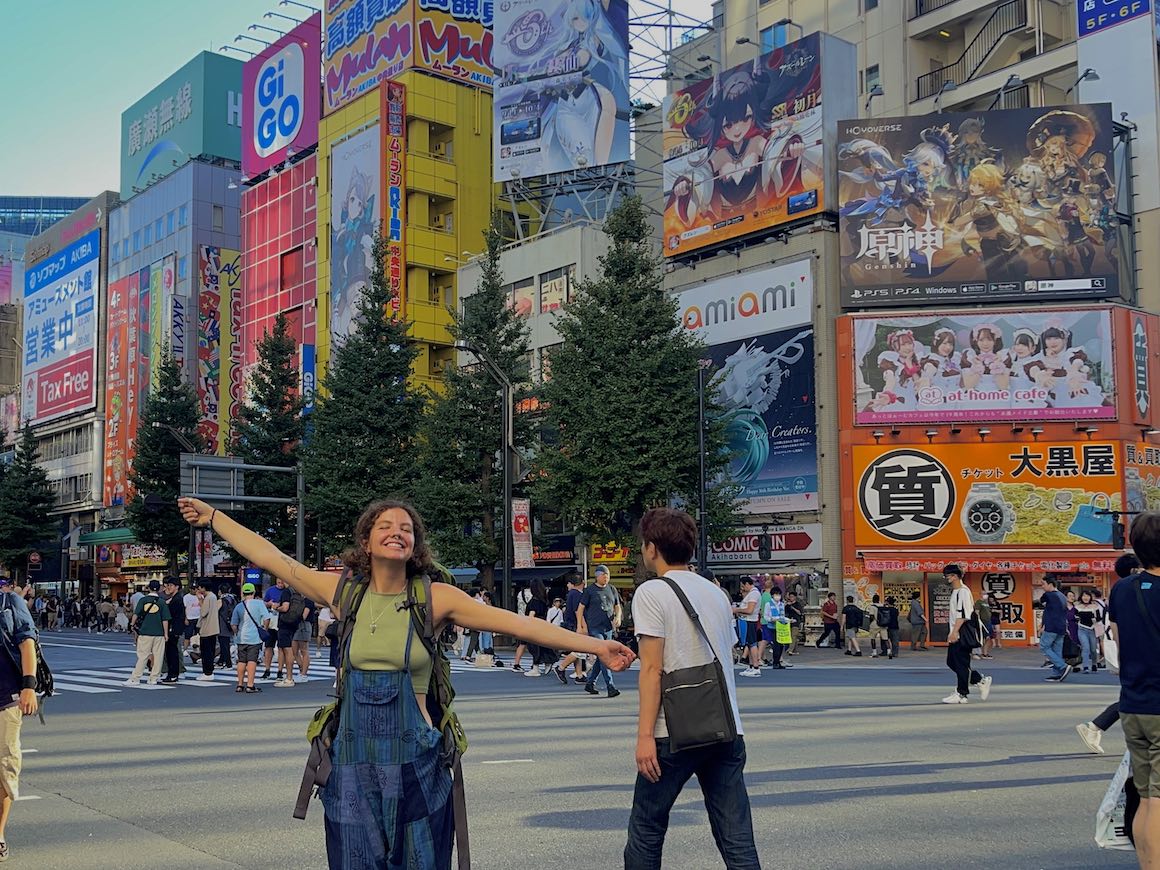
When staying in Tokyo, one of the best hostels for Japan solo travel I found was the Tokyo Guesthouse Oji music lounge . Not only was this two-star hostel easy on my budget, but it was also perfect for meeting fellow travelers while playing the lone wolf.
Heading to the former capital of Japan, Kyoto is another brilliant place for solo travelers to experience Japan. I can tell you that its famous Buddhist temples, Shinto shrines, palaces, and gardens help the city live up to its UNESCO World Heritage Site, without a doubt! My must-see attractions for visitors include Kyoto Imperial Palace, Kiyomizu-Dera, and Kyoto Tower (you can compare notes with a visit to its Tokyo sister).
Another reason why I adore Kyoto so much is its entirely visitor-friendly, with excellent public transport and friendly locals who are happy and willing to interact with a mixture of miming and simple Japanese. All these things make it an easy solo traveling experience.
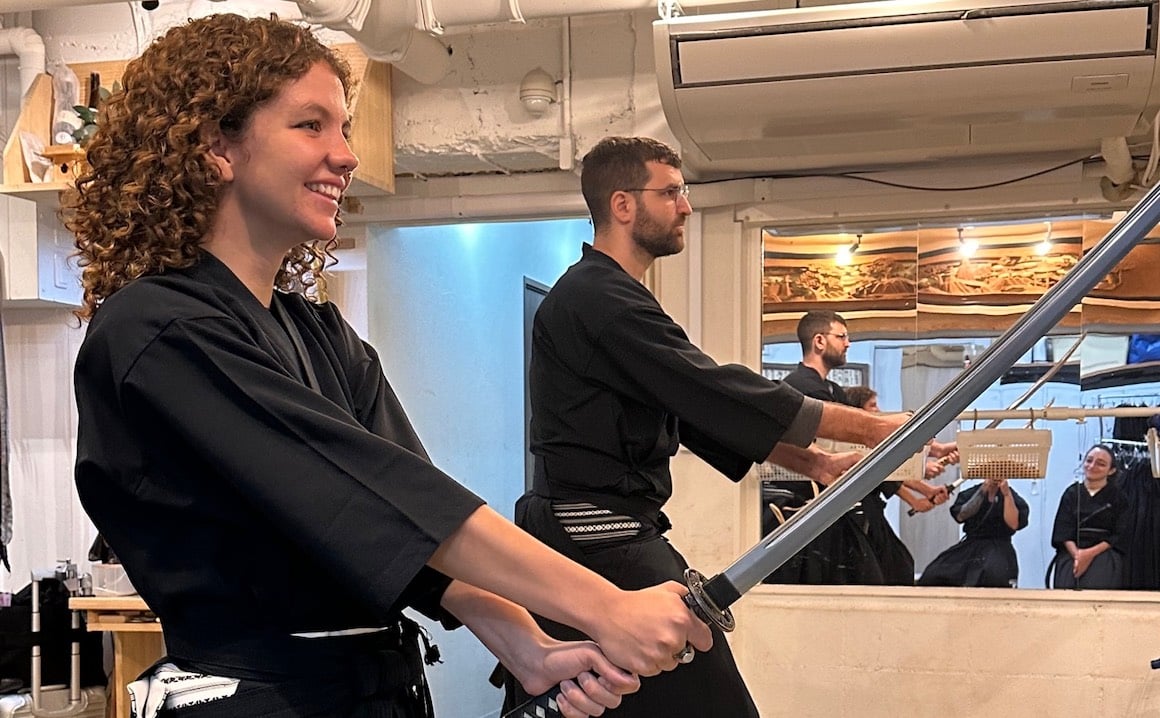
So where should you stay in Kyoto ? You will be ecstatic to learn they have MANY solo travel-friendly hostels where you can relax.
The Kyoto Hana Hostel is my top pick; this hotel isn’t just a budget-friendly choice, with a five-minute walk from Kyoto Station Central. I love the opportunities to meet others in their range of shared bunk rooms, with the option for female-only. They even have a Japanese sleeping experience if you pick a private room with a shared bathroom. Kyoto hostels are epic!
Visiting Japan’s second-largest city Osaka, you will find a wonderful Japan solo travel experience that is hard to beat! All the while being treated to an affordable travel experience with excellent public transport and an endless list of things to do and see!
During my visit, I adored learning about Osaka’s origins dating back to the 3rd Century AD and how it quickly established itself as a significant port. Today this old-timer still holds a strong sense of modernity. However, it isn’t all about its industry when you come here.
Osaka offers SOOO many things for solo travelers, including its mouth-watering food and the iconic Osaka Castle. I particularly recommend a stop by the Osaka Museum of Natural History , its numerous parks, and Buddhist temples.
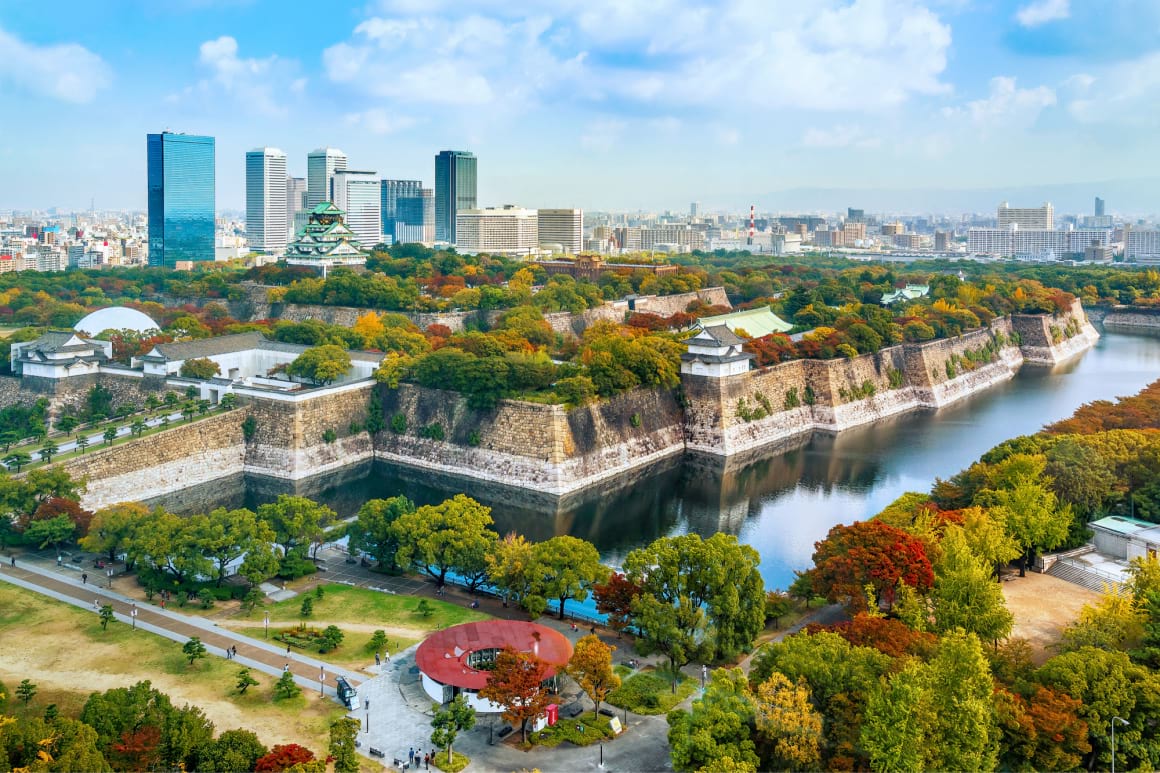
When you stay in Osaka as a solo traveler, I can rest your worries with their range of hostels waiting to welcome you to this iconic city. Notably, The Stay hostel is my favorite, as a great budget-friendly choice, all while being treated to shared bunkrooms, a rooftop terrace, a shared kitchen, and dining and lounging areas.
My favorite place to go on a solo mission through the rural parts of Japan is Hakone.
The best thing about this place is, of course, it’s… HOT SPRINGS! This little 1892 village may have this as its main tourist drive, but it’s certainly not the only thing. You will adore its location in the Fuji-Hakone-Izu National Park just west of Tokyo with gorgeous lakes and mountain forests.
It is a perfect solo destination! You can make the most of its tranquility, take a solitary walk, and relax in the hot springs at the end of a sweaty hike. Adding to this, it’s just a short stop outside of Tokyo.
In my mind, it makes it even better as you could take a day out of city life to taste rural Japan. So if you take the dive to Hakone you need to check out Lake Ashinoko, Hakone Shrine, the Botanical Garden, and of course, Hakone Onsen (the to-die-for hot spring).
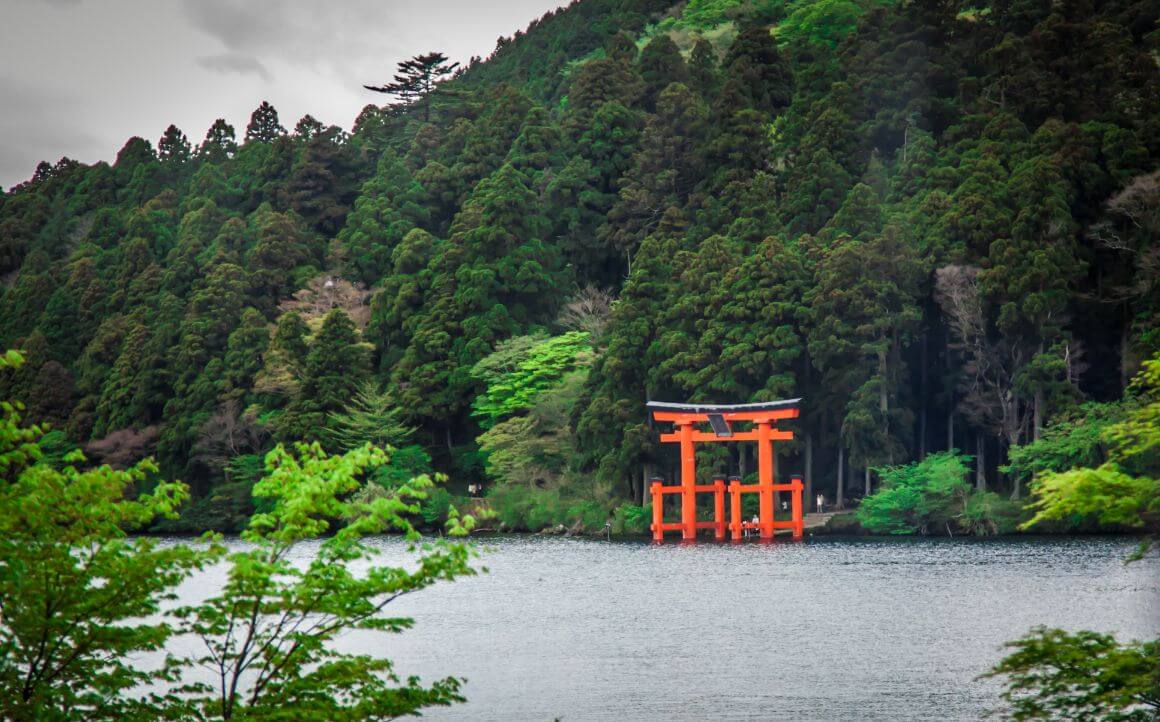
If you decide to stay in Hakone, I recommend the Guest House Azito is in the heart of the town. Here you can choose several sizes of shared dormitories, traditional Japanese beds, and even a little apartment for those wanting that complete Japan solo traveling experience.
Hokkaido is a real treat for solo travelers in Japan. This isn’t just because it’s the second largest, most northern island of the Japanese archipelago; it’s a poorly kept secret that we tourists are taking advantage of every year come winter!
Why is it so desirable? All solo travelers can admire this wild haven for nature lovers and ski enthusiasts with over seven national parks and numerous ski fields.
In my opinion, the best place to see it all is the largest national park Daisetsuzan. Here, you will be gifted with stunning views at their peak season in Autumn. In Daisteuzan, you MUST visit Mount Niseko (the largest mountain), with its brilliant views as you venture out into the untouched wild landscapes.
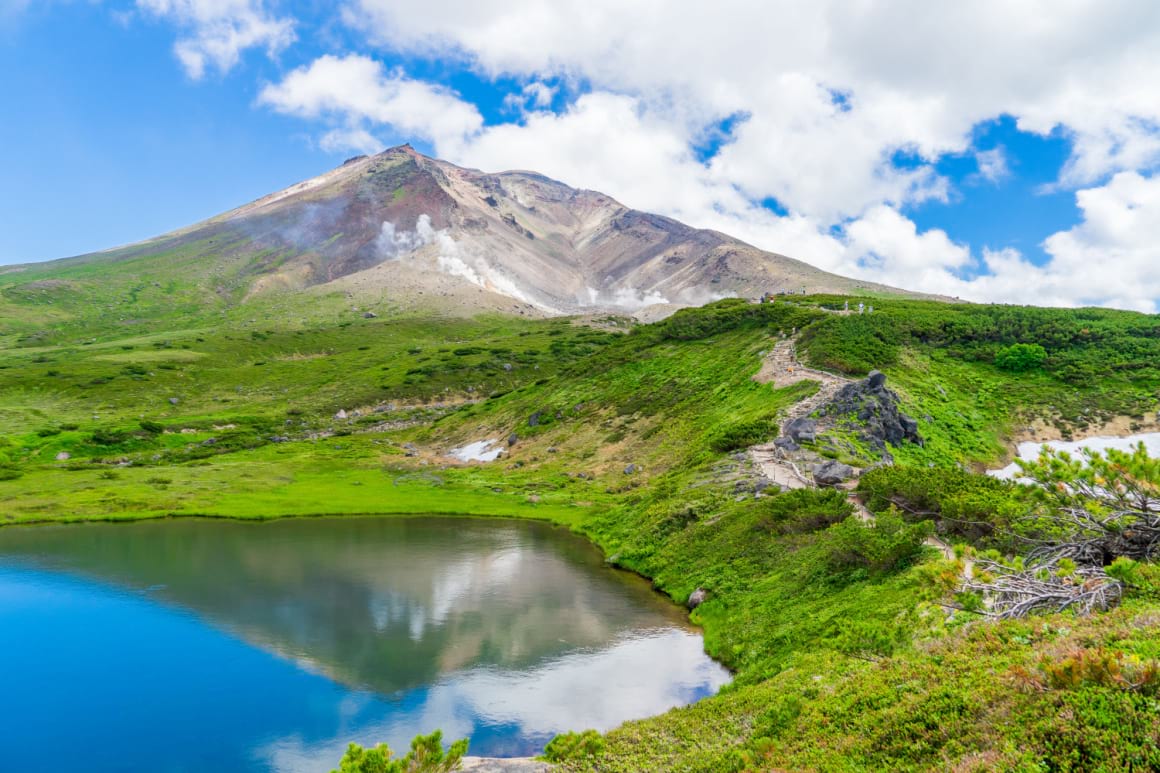
Although say you want something more ‘chill’? For those wanting a slice of busy city living, I recommend visiting the largest city in Hokkaido, Sapporo. Not only is this a great place to make your base while exploring the island’s wonders, but it also has many fun things to do inside its walls.
Sapporo is a mountainous city famous for its beer, skiing, and the annual Sapporo Snow Festival, so to say there is a lot to do here would be an UNDERSTATEMENT. Learn about the rich brewing history or dive deeper into the snowy attractions that make the region so famous.
During a stay in Hokkaido one of the best hostels to stay when traveling solo is Ten to Ten , found Sapporo. They have shared bunk rooms with an option to pick female-only or private rooms, so this is appreciated! They also have a laidback and friendly attitude which is perfect for a solo traveler in Japan which makes it a highlight of a trip to Hokkaido.
Having the right travel apps on hand when traveling solo in Japan will make the whole experience a blast. But what are the best travel apps for going solo?
- Japan Official Travel App. The perfect tool on hand to give you a must-see travel inspiration.
- Jorudan. The official Japan travel app for getting around Japan.
- Hostelworld . The best place for finding hotels at a moment’s notice.
- Japan Wireless. A place to get pocket Wi-Fi or a mobile SIM.
- Couchsurfing . Find a couch to sleep on for a cheap way of travel.
- Dating Apps. Apps like Tinder, Grindr, and Bumble allow you to make friends and date while traveling.
- Ho lafly . An e-SIM application that allows you to download a data-only SIM card without installing a physical card.
If meeting like-minded travellers is your goal, check out the current popular Facebook groups for travelers in Japan. Or, just do it the old-fashioned way and head to a hostel bar and introduce yourself!

Stop stressing about your phone service when you travel abroad.
Holafly is a digital SIM card that works smoothly like an app — you simply pick your plan, download it, and voilà!
Roam around Europe, but leave the roaming charges for the n00bies.
When traveling anyway, it’s important to know how to travel safely . Being solo in Japan is no exception, although it is known that this country is a very safe place to visit with a low crime rate. Travelers shouldn’t get complacent.
I want to share several tips to ensure that your dream trip doesn’t turn into a nightmare. Let’s go.
• When traveling solo in Japan, don’t travel alone at night ; if you must, keep to well-lit and populated areas. This is particularly true if you don’t know where you are or are unfamiliar with the area.
• Japan still has its handful of bag snatchers, so keep your bags tightly closed and buttoned u p, and never let it out of your sight! The same goes for cash; make sure you don’t keep it all on your person at any one time and keep it locked up securely at your hostel or hotel.
• Speaking of cash, it’s also a great idea to have cash on you in case your phone breaks, your card stops working, or you find a shop that only accepts money.
• Female solo travelers in Japan can opt to stay in hostels with female-only dorm rooms or pay a little extra for a private room if they feel unsafe being in shared spaces. However, don’t let these worries ruin the experience of staying in a hostel.
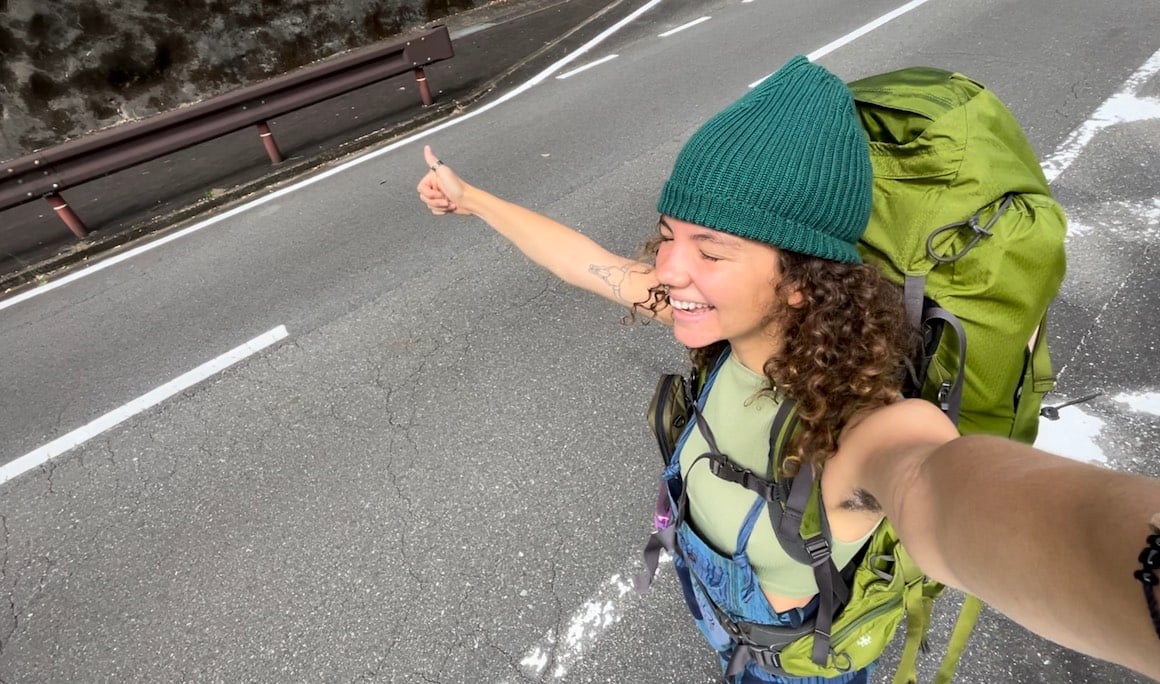
• The public performers of the geisha and maiko don’t like their photos being taken, so don’t even ask for a selfie! Also, as extra respect for their culture, don’t misuse your chopsticks and try to learn the art before you go. Plus, learning Japanese will make the locals love you!
• When you go out, watch your drinks and don’t accept food or drinks from strangers.
The final Japan solo travel tip I can offer is much more general…. Make sure you assign a safety person back home that you tell them where you are going regularly, so if something were to go wrong, they could ring alarm bells.
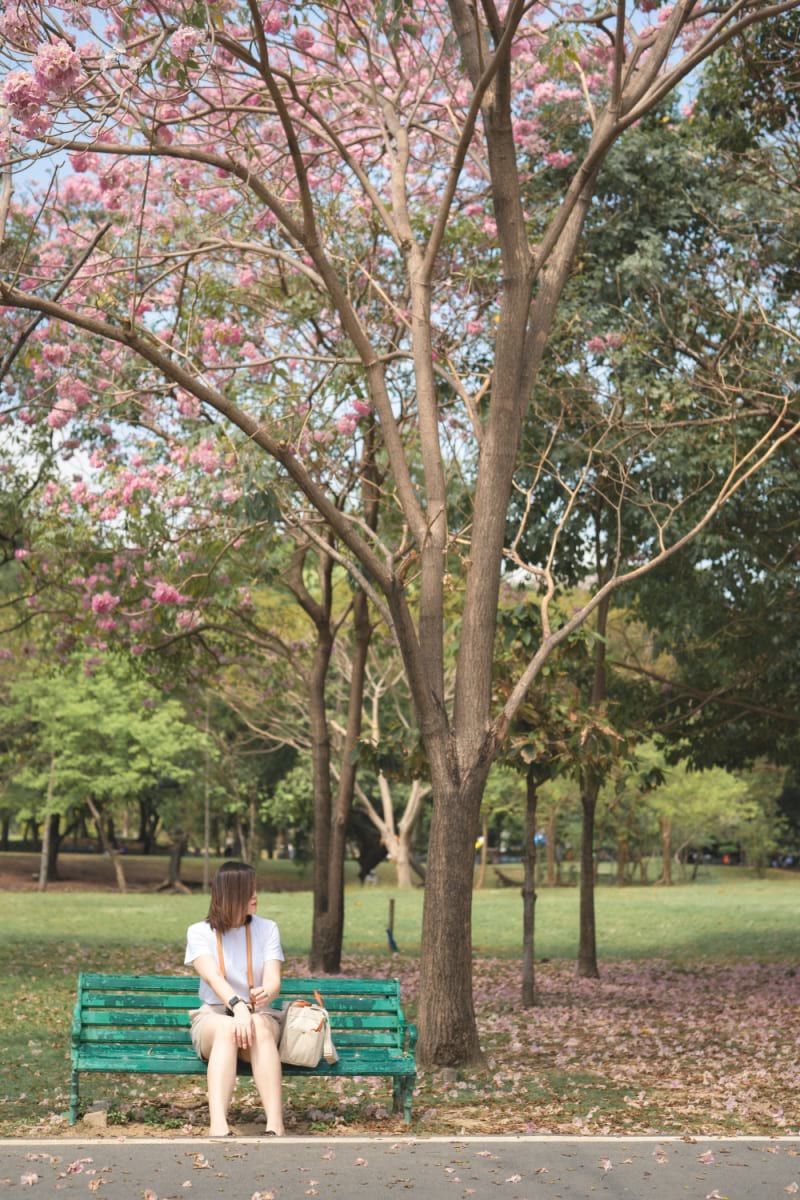
- Get an IC card ASAP. You will quickly find (as have I) our golden ticket to galavanting around
- Japan’s public transport with this prepaid card!
- Buy Yourself a SIM (I particularly love the air sim) or something less finicky like a portable pocket Wi-Fi. I believe that a SIM or portable Wi-Fi is a must when traveling solo in Japan. TRUST ME! You will save a lot on roaming fees and never get lost.
- Get a JR rail pass. I found this pass was a lifesaver. It allows you to see ALOT of cities by train, all for one fee, that will take you all over Japan.
- Polish up your Japanese . Knowing basic phrases in Japanese is a must. I can assure you making the effort to talk with locals in their mother lounge will go a long way!
- Don’t let someone else plan your trip. I find the most fun you have when traveling is when you forge your own path. It allows you to make the most of your solo trip to Japan and see it all!
- Become the lion of your own adventure. Don’t be afraid to get a little crazy and throw aside those set plans if something even more enticing rears its head from behind the tall grass!
- Crime may not prowl in Japan as much as in other places, but… Be aware of what is around you, and don’t do anything too crazy!
- Travel insurance is a MUST. Trust me, it can save your trip. Would you want to be stuck in an airport without a plan B?
ALWAYS sort out your backpacker insurance before your trip. There’s plenty to choose from in that department, but a good place to start is Safety Wing .
They offer month-to-month payments, no lock-in contracts, and require absolutely no itineraries: that’s the exact kind of insurance long-term travellers and digital nomads need.

SafetyWing is cheap, easy, and admin-free: just sign up lickety-split so you can get back to it!
Click the button below to learn more about SafetyWing’s setup or read our insider review for the full tasty scoop.
Meeting like-minded people is one of the best things about solo travel. Here are some of my favourite ways to meet others on the road.
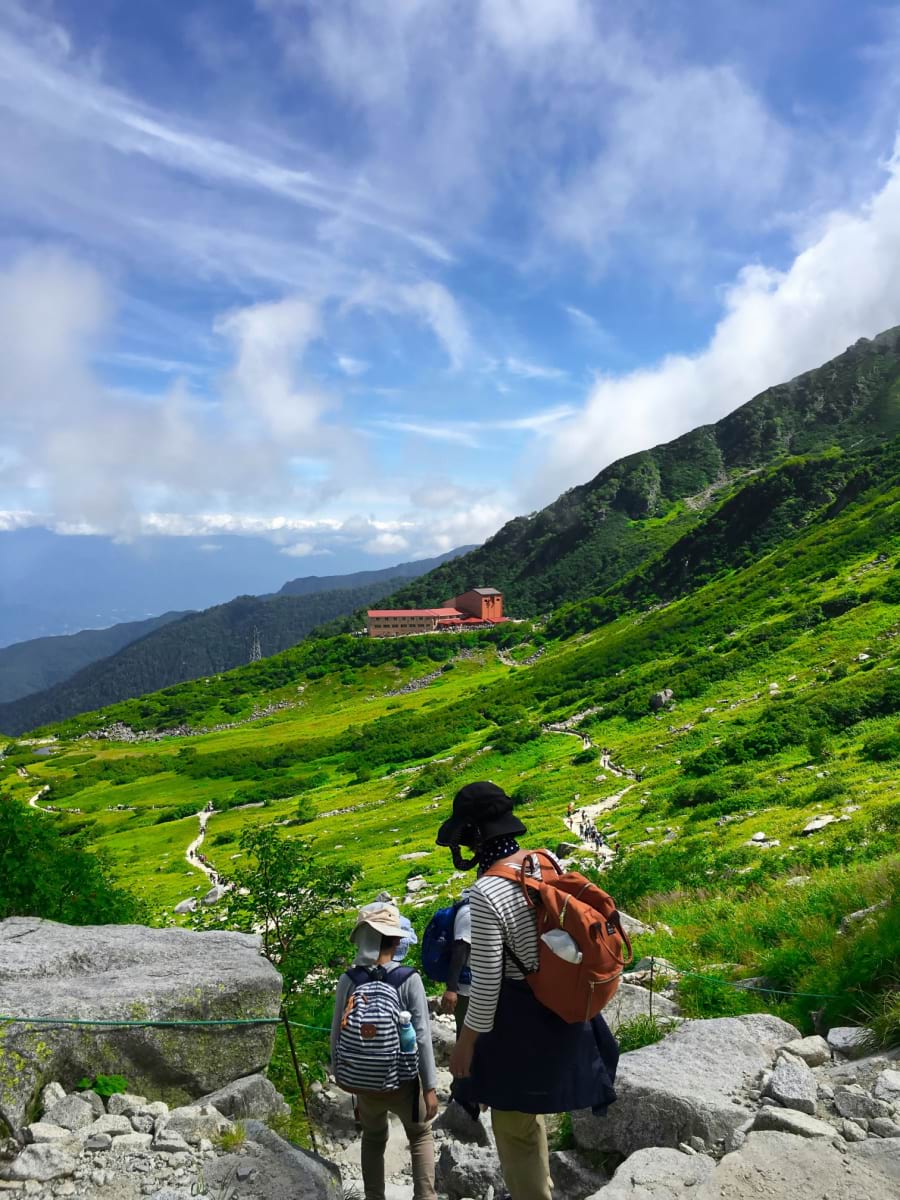
- Keep your eyes peeled for events . I find events a great way to meet people even if solo traveling Japan. You never know what might be going down when you’re in town!
- Make social connections through apps. Whether you are looking for a fun hook-up or are a solo female traveler , I find these offer endless ways to satisfy your social juices. So even you internet lurkers have no excuse!
- Take advantage of short-term memberships. Sure, even if you are JUST in Japan for a few days, there are countless reasons I say why you’d benefit from these. You can work out at a gym or sports club and meet others while getting toned.
- Check out the brilliant Facebook groups. You can bet Japan has many Facebook groups to forge tight networks between foreigners. But what ones? These particular ones are nifty: Japan Travel , Friendly Discussion Group , Destination Japan , Japan Travel Community ?? , and For Foreigners Living in Japan .
- Be open to making friends! The number one thing I would say that will keep you from meeting people in Japan is being shut away. The best advice is to be present, friendly and say yes to every opportunity! You will soon find making friends while traveling solo will be a thing of the past!
Japan is a great solo travel destination with many fun things to do and a rich cultural heritage, making it one of the best places to go on holiday. There are not many terrible things to say about it as a place to go when you are visiting by yourself; however, with these tips we have offered, the small downsides can easily be avoided with a little planning.
Japan highlights the best things about traveling solo as you forge your path and make your own choices. If you want a lazy hot pool, you can do it! If you want to use this trip to improve your language skills and have meaningful discussions with locals in Japanese, you can also do that.
It does live up to its reputation, and if you get the chance, you won’t regret visiting Japan for a solo experience.
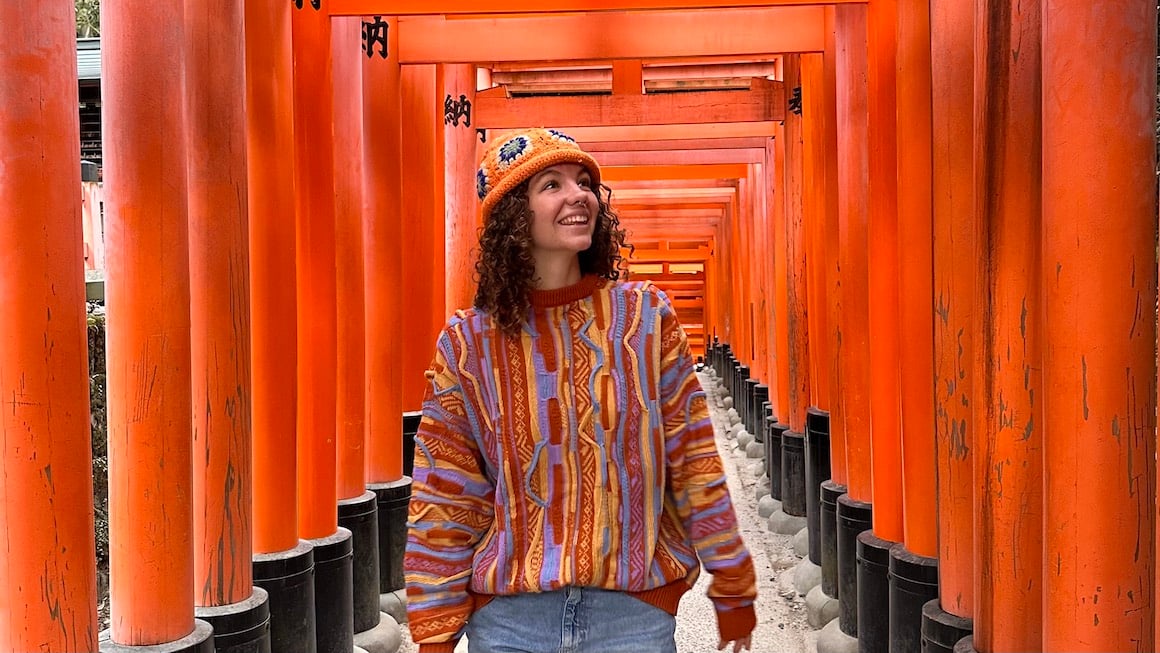
Made it this far? You get 15% OFF to book a place to stay ! Offer valid exclusively for Broke Backpackers 😉

Share or save this post

Leave a Reply Cancel reply
Your email address will not be published. Required fields are marked *
Save my name, email, and website in this browser for the next time I comment.
Notify me of followup comments via e-mail.
Solo Trip in Japan: Complete Guide to Itinerary, Attractions, Cost and More
How to start a person traveling to japan for the first time, how did you travel to japan alone for the first time.
There are many things in daily life that always experience the first time, such as traveling to Japan with friends for the first time, going to Tokyo for the first time, going to Kyoto for the first time, taking the JR train for the first time, and taking the Shinkansen for the first time Trains, learning to ski in Japan for the first time...
Then suddenly, for some reason, it became the first time to travel to Japan alone, and suddenly there was only one person to deal with all the issues such as air tickets, accommodation, itinerary planning and so on. At this time, you will unconsciously ask, is it safe to go to Japan alone? How should a person go to Japan to arrange accommodation, attractions, and itinerary planning? What should I pay attention to when traveling to Japan alone? Also, who else would choose to go to Japan alone?
Perhaps for you who will go to Japan alone for the first time, this trip may be a major test in your life. Because you need to face a language barrier environment alone, and you have to solve all the things that will happen during the entire trip alone.
Difficulty of traveling alone in Japan
However, according to my many travel experiences in Japan in the past, traveling alone in Japan is not as difficult as I imagined. As long as I can overcome the first time I go to Japan alone, I will learn how to arrange the second and third trips . Just like I have been to the top of Mount Fuji, Hokkaido, Tokyo, Kyoto, Fukuoka, Hiroshima, Kumamoto, Nagasaki, etc. in the past, basically only a small part of Japan has not been visited
At the same time, I also tried to live in Japan alone, deal with different problems in daily life in Japan alone, and so on. In fact, traveling alone to Japan is not a terrible thing, but something that you will fall in love with unconsciously.
As I said at the beginning, there is a first time for everything. So whether you are "the first time to travel to Japan" or "the first time to travel to Japan alone", as long as you have not been to Japan many times, today's article will sort out one for you Japan itinerary planning. First of all, it will start from the most basic itinerary planning, and then to accommodation arrangements, scenic spot selection, and then to Japanese culture, what needs to be paid attention to when traveling in Japan, etc., will share past experience with you.
I hope that after reading this article, you can plan a Japanese travel itinerary that belongs to you. Whether it's your first trip to Japan alone, or your first trip to Japan with your family or friends, you can complete the entire itinerary at the end and return home safely with good memories.
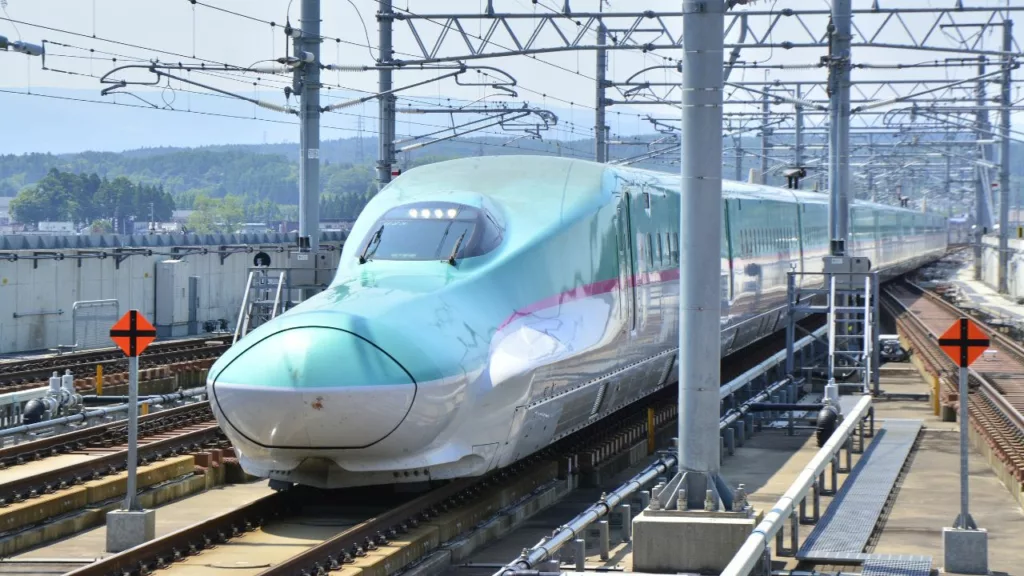
One ticket, unlimited travel throughout Japan! [Best Deal] JR Pass All Japan Rail Pass A must-have ticket for a long-distance trip to Japan!
Is it safe to travel in Japan?
People often ask: Is Japan a safe and tourist-friendly country?
This is a question that many people who plan to travel to Japan for the first time will ask. To put it simply, Japan is different from other countries. Japan is a country that attaches great importance to tourism, and crimes against overseas tourists are very rare. If some unavoidable natural disasters and accidents are excluded, Japan is a very safe country on the whole.
In addition, the Japanese are a nation that attaches great importance to laws and regulations and the feelings of others, so even if you lose your wallet, mobile phone, or a coin, you can find it back with the assistance of the police and station staff thing.
More in-depth, as long as you concentrate on activities in popular tourist attractions and shopping areas, and do not walk into some residential areas or private land, the chances of accidents are basically very low. At the same time, try to avoid going to some unknown restaurants, izakayas, and places suspected of being pornographic places and gambling places, so that you can minimize the chance of accidents.
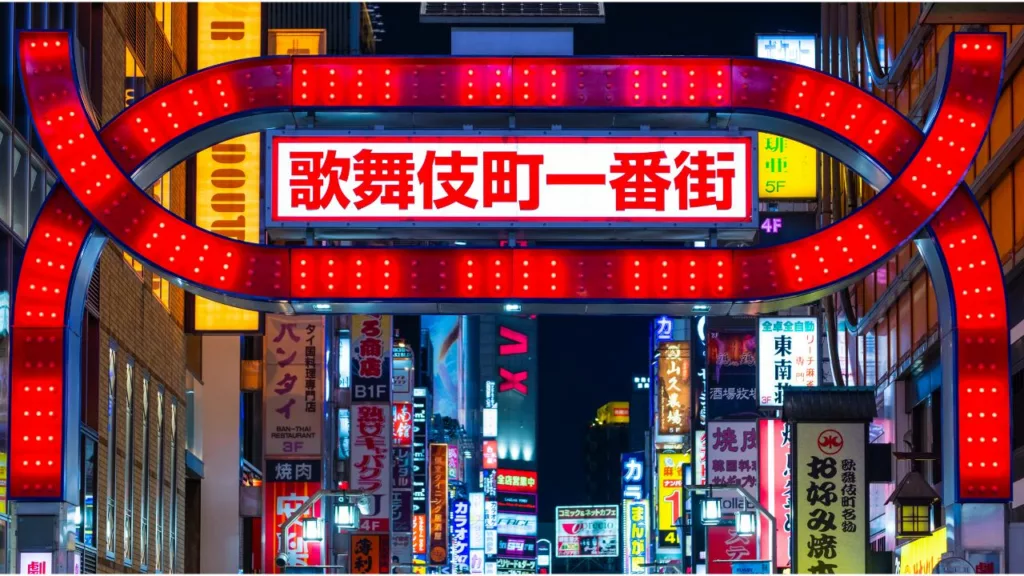
Is Japan suitable for traveling alone?
If you are traveling to Japan for the first time, and there is only one person, you don’t need to worry too much in just a few days in Japan.
Because Japan is a place with very developed railway construction, you will definitely find JR stations or local railway stations near almost all scenic spots. Therefore, there is no need to worry about transportation arrangements. Traveling to Japan by yourself can actually solve transportation planning easily.
In addition, in major cities in Japan such as Tokyo, Osaka, Kyoto, etc., there are also many accommodation plans and restaurants suitable for one person, and many of them are very cheap and good quality accommodation and restaurants. So even if there is only one person going to Japan, it is not like other countries where only double rooms and double packages can be booked.
Another point is that as long as your actions don't affect other people, basically the local Japanese don't care whether you come to Japan alone or in a group. As long as you follow their instructions, whether you are in a hot spring hotel, taking JR, or going to some high-end restaurants alone, they will serve you according to the usual standards.
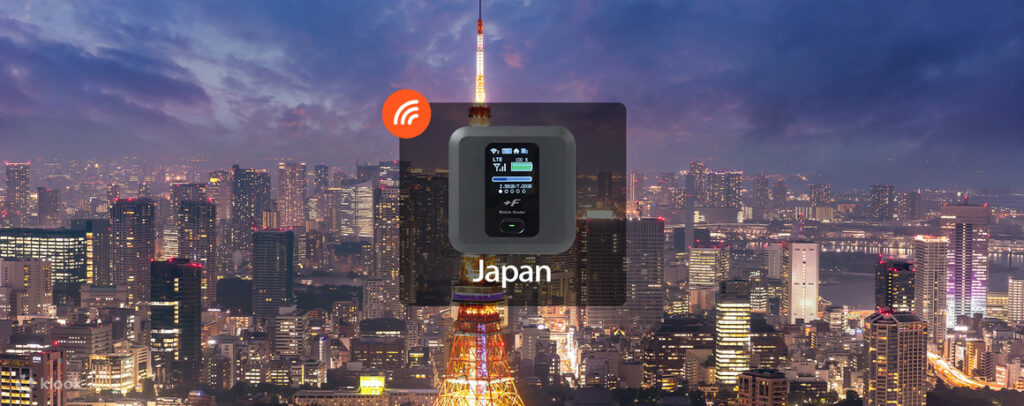
One device, shared by multiple people! [New] NTT Docomo Unlimited Mobile Data Sharer Service Plan Faster and more convenient to receive!
Can I travel to Japan without knowing Japanese?
The answer first: If you only go to some popular tourist spots, this is totally fine. However, if you want to go to some scenic spots suitable for in-depth travel, learning some basic Japanese is a necessary condition for setting off to these scenic spots.
If you are going to Japan with your friends
To put it simply, if you are traveling to Japan with your friends, and you only go to popular tourist attractions in Tokyo, Osaka, and Kyoto, there will be no problem even if you only speak English. Because many of the clerks who can work in tourist areas are people with certain English skills, there will be no problem in ordering food, checking out, or inquiring about scenic spots in simple English. And because you are going to Japan with a group of friends, even if there is an accident, they will help you, so if you can communicate in Japanese, it will be helpful for the itinerary, but it is not a necessary skill.
However, if you are traveling to Japan alone, or plan to go to places other than popular attractions and stay in accommodation other than major hotels, your Japanese ability will completely affect your itinerary experience.
If you go to Japan alone
For example, take the itinerary in Tokyo as an example. If you go to some independent small restaurants, izakayas, etc. in residential areas this time, basically you must understand the Japanese on the menu before you can order food. Or if you want to book some cultural experience activities, you need to have Japanese communication skills to participate.
More importantly, if you are going to Japan alone and plan to leave popular tourist areas such as Tokyo, Osaka, and Kyoto, whether you can speak Japanese will determine your chances of getting help. Because Japanese people in other regions may not be able to understand complex English sentences, especially when you miss the last JR train and need help when you are injured, Japanese will be the fastest language for you to get help.
Of course, if you are on an itinerary that mainly focuses on popular attractions, you can also say "すみません-Sumimasen", "これ- kore", "ありがとうございます- arigato gozaimasu", etc., which will be better than "Excuse Me / Sorry" , "This" and "Thank You" make it easier to get help from the store staff.
What attractions can you choose when you go to Japan for the first time?
It's the first time to travel to Japan, but after opening the map of Japan, I still don't know which places are worth visiting? In fact, the whole of Japan is mainly divided into two main parts, the city and the suburbs. You can decide which place to go according to your knowledge of Japan.
major cities in japan
If you are going to Japan with your friends this time, if you have never traveled to Japan, and if you don’t speak Japanese, Tokyo, Osaka, and Kyoto are all very suitable places for you to go.
Because these three places are very mature tourist areas, besides there are many scenic spots that allow you to arrange a itinerary for a week, and there are also people from different countries working in these areas, so even if you only speak English and Chinese The whole journey can be completed smoothly.
And between Tokyo, Osaka, and Kyoto, I will recommend you to go to Tokyo or Kyoto first, and save Osaka for the next time you come to Japan.
Because the attractions and characteristics of Osaka are actually similar to those of Tokyo, what can be experienced in Osaka can be experienced in Tokyo. However, what you experience in Tokyo may not necessarily be experienced in Osaka. A simple example is like sightseeing at a high-altitude observatory. Tokyo has Tokyo Skytree, Tokyo Tower, and Shibuya Sky, but Osaka only has Osaka Tsutenkaku and Umeda Sky Observatory, but they cannot compare with Tokyo Skytree in terms of height.
In addition, Tokyo and Kyoto represent both modern and traditional Japan. If you are going to Japan for the first time, you want to experience Japan’s big cities, anime, shopping, or Japan’s ancient capital, kimono wearing experience, tea ceremony experience, geisha performance, some traditional Japanese activities and so on.
To sum up, Tokyo and Kyoto are places with very complete tourism resources. Even if you don’t spend too much time researching the itinerary, basically you don’t have to worry about transportation, accommodation, attractions, etc. place to go and get bored.
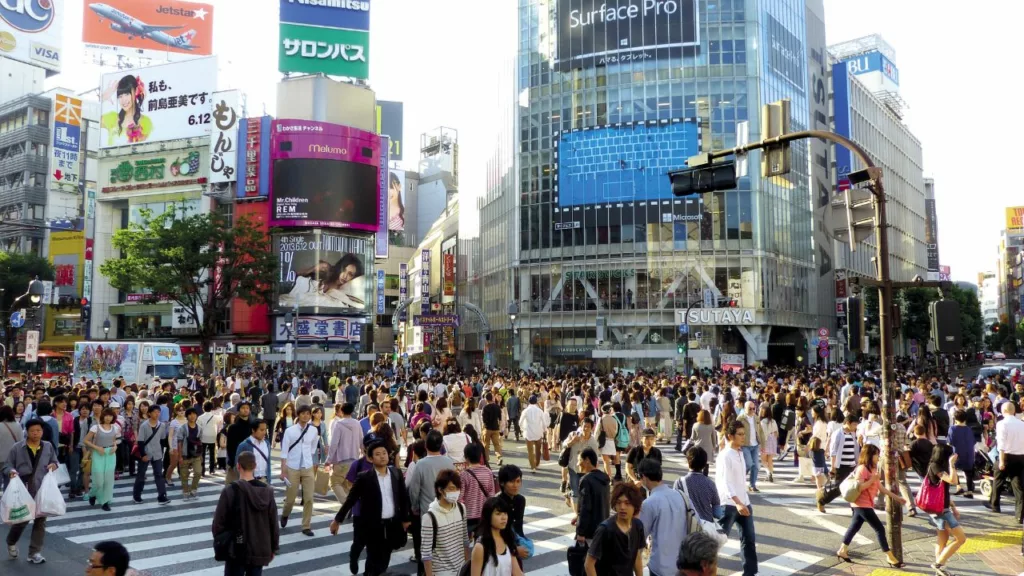
Japanese regional cities
Of course, for you who will be going to Japan for the first time, you don’t necessarily have to go to places like Tokyo, Kyoto, and Osaka. If you have enough preparations before departure, in fact, Fukuoka, Hiroshima, Kumamoto, Nagoya, Shikoku, Hokkaido, etc., some places with natural attractions are worth your consideration. However, because the transportation facilities in these places are not as developed as Tokyo and Kyoto, there may only be one JR train passing by every hour.
In addition, because these places are not places that some overseas students would choose to go, sometimes it may be a little difficult to communicate in English. In addition, there are many places where the explanations are only in Japanese, which is not like the habit of providing Japanese, English, and Chinese multiple languages at the same time in Tokyo.
So for you who are going to Japan for the first time, if you still choose to go to these places, you need to have a certain level of Japanese ability, and have enough time to study each day's itinerary before departure, so that you can ensure that you are in the itinerary There will be no surprises along the way.
For those who travel to Japan for the first time, unless there are other people who have been to these places who can serve as tour guides and can quickly identify some important traffic and scenic spot information, it is best to have a certain level of Japanese ability, otherwise Should save it for the next time I visit Japan.

What are the attractions to choose when traveling to Japan alone?
If you have traveled to Japan several times, but this time it happens that only one person goes to Japan, and it is the first time to go by yourself, Tokyo, Kyoto, and Osaka are some places suitable for departure at any time. The shopping malls, restaurants, and different attractions are sure to be enough for you to arrange a long-distance trip. If you want to challenge yourself, you can also consider using the JR Shinkansen train to go to Tokyo and Kyoto at the same time to experience two completely different Japans.
In addition, in summer, Mount Fuji, Hokkaido, Hiroshima, and Fukuoka are some places where you can enjoy the natural scenery. Or in Hakone and Nikko in winter, there are many hot spring hotels you can go to. As long as you book the required tickets and accommodation in advance, it is basically as simple as planning a trip to Tokyo.
However, it is not recommended to go alone for some relatively high-risk activities, such as going skiing in winter alone, climbing a mountain in Japan with only one person, or going into some suburban areas alone, all of which must be avoided.
How to arrange accommodation when going to Japan alone?
If you choose to go to areas such as Tokyo, Kyoto, and Osaka, business hotels and youth hostels are some accommodation options worth considering. The characteristic is that the housing price is cheap, and the distance from the station is not very far. Even if you need to drag your suitcase, it is very convenient.
If you want to have enough private space, there are APA Hotel Both are great accommodation options. If you want to communicate more with other people, youth hostels will be a good accommodation solution, but not every city in Japan will definitely have this kind of accommodation option.
For example, I often Agoda The advantage of booking APA hotels in different areas above is that you can apply for free cancellation when you need to change your itinerary. In addition, you will also recommend other hotels, youth hostels, and even capsule hotels in the same area. When the APA hotel has no rooms available, I can immediately book other hotels instead of spending time calling each hotel to check availability.
However, you should pay more attention when you book some high-end hot spring hotels, because most of the hot spring hotel rooms are sold as double rooms, and the meals are mainly set meals for two people. In other words, no matter if you are alone, you still have to pay the cost of a double room before you can stay in those high-end hot spring hotel rooms.
Check Prices and Discount Offer: Book hotel accommodation in Japan
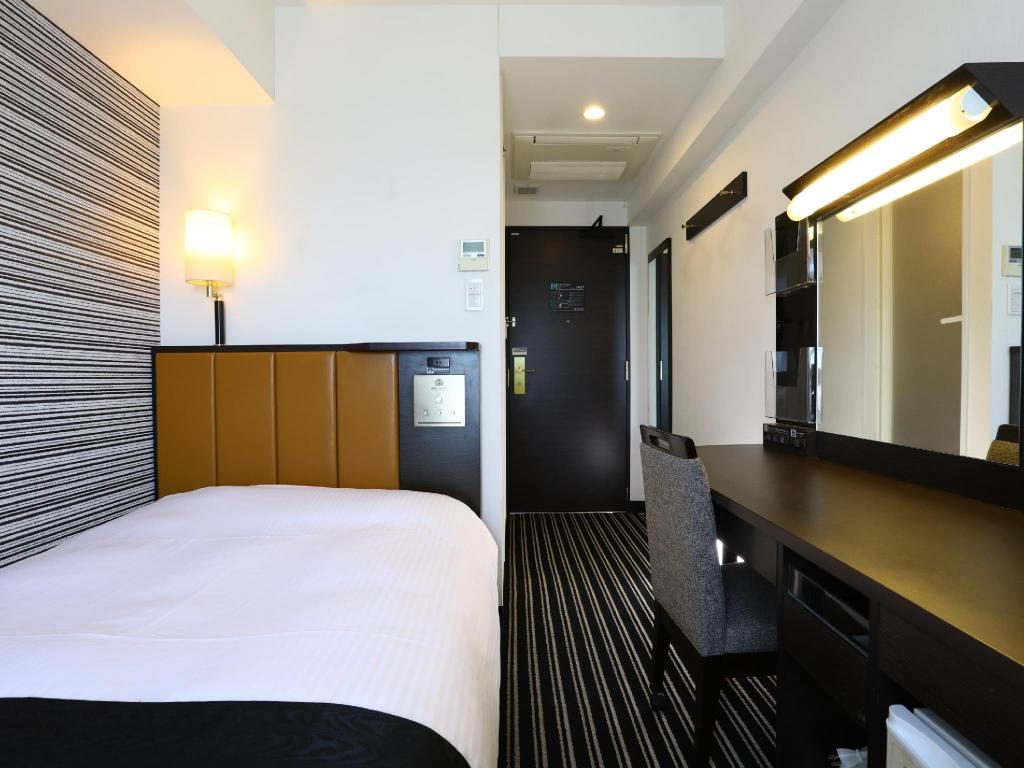
What should I pay attention to when traveling to Japan?
Since Japan is said to be a very safe country, why do we need to pay more attention during the tour?
The reason is simple, because the language and culture of each country are different, which may cause misunderstandings due to some cultural conflicts. Moreover, many people will overestimate their abilities during the trip, or lack of planning, and finally encounter some accidents that could have been avoided.
Therefore, whether you are going to Japan with friends or by yourself, you should pay attention to the following points when you go to Japan for the first time.
Knowing basic Japanese will enhance your travel experience
Since Japanese is the common language in Japan, if you want to get help from the shop staff quickly, the effect of asking questions in Japanese will be much better than English. In addition, making good use of translation software can help you break the language barrier, and the efficiency will be much better than simply using English to inquire with the clerk.
Avoid eating while walking in Japan
Japan is not a country that is used to shopping and eating at the same time, but is used to eating near restaurants and small shops before continuing to go shopping and shopping. If you're used to walking into different shops with your drink in hand, definitely avoid it when you're in Japan. Otherwise, you may need to pay before you can leave when the goods are wet.
Pay attention to the departure time of the last railway train
Regardless of whether you are traveling to any part of Japan, you must pay attention to the departure time of the last train on the railway. Because JR railways in different regions will have different last train times. For example, for JR trains in some remote areas, it is not impossible for the last train to leave at 18:00 in the afternoon.
Although the last JR train in Tokyo will end around 00:10 in the middle of the night, the distance between different stations in Tokyo is actually very far. If you don’t want to spend money to take a taxi, it will take a lot of time to walk there. So before you plan to arrange some night activities, it is better to check the departure time of the last bus of the day.
Avoid being alone on the street late at night
Although Japan is a country with very good law and order, it does not mean that there will be no crimes at all. Especially in some bar areas and nightlife-based areas late at night, if you are not familiar with Japanese culture, you must try to avoid going there late at night. This is the best way to ensure your own safety.
In addition, if you go to Japan alone, when you go to some remote places, try to stay in some main shopping streets after nightfall, so that even if you encounter an accident, you can get help immediately.
Avoid going into residential areas, private land, farmland
The Japanese attach great importance to private land, so even if you see a lot of sunflowers planted in some farmland, it is not recommended to go to touch or take pictures. Just like the Christmas tree in Biei, Hokkaido, you can't actually go in and take pictures, because the location of the Christmas tree is within the scope of private land.

Avoid going into some unknown restaurants
If you go to places where izakaya are concentrated in Tokyo, Osaka, and Kyoto, and you meet some people who entertain you warmly on the street, or tell you that you don’t need to spend time queuing up, hoping that you will go to some specific restaurants, then you must careful. Because those restaurants are likely to be some restaurants that charge high fees. Seats, ice cubes, drinking water, snacks, service fees, etc. will be calculated independently, and they will also give you a high bill.
So if you are traveling to Japan for the first time, or if you are only traveling to Japan alone, it is recommended that you go to some restaurants in department stores, which will be safer and more convenient.
Avoid taking pictures of other people's faces
The Japanese are not a very enthusiastic nation, so when taking pictures in Japan, you must avoid taking pictures of other people. And according to Japanese law, they have the right to refuse to let you take pictures, and they can also ask you to delete photos that include their appearance, which must be paid attention to.
don't force yourself to go to any itinerary
For you who are traveling to Japan for the first time, sometimes you will want to visit several different attractions in one day. But it is often easy to underestimate the travel time required in the middle and whether your physical strength can handle it.
In fact, Japan is a country that is suitable for visiting again and again. Whether you go to a certain scenic spot today or next year, there will still be no big difference in this scenic spot. So when you really have no way to go to a certain scenic spot, it is actually the most appropriate choice to give up decisively.
cheap dining options
Although prices in Japan are not cheap, there are also delicious and cheap bentos sold in convenience stores and supermarkets. For example, there are many branches in Tokyo Kitchen Origin , provides a lot of bento options around ¥500, which is cheaper than lunch and dinner in many restaurants.
In addition, some beef rice restaurants, ramen restaurants, Chinese cuisine restaurants, etc., are all places where you can eat for less than 1,000 yen. If you don't have a lot of travel budget, restaurants like Matsuya, Otoya, Hidakaya, etc. will be your best restaurant choices during your travels in Japan.
Tickets and internet devices required in Japan
If you have never traveled to Japan, you can go first klook.com Book the required Internet devices, tickets, and then depart for Japan. The feature is that it can save the time of queuing up to buy tickets, and sometimes you can get additional discounts, which are basically cheaper than buying tickets on the spot.
and klook.com Basically, it contains most of the packages you need to use during your travel in Japan, from theme park tickets, JR train passes, to different one-day tour guide groups. As long as you plan your itinerary, you can start immediately with these packages.
Japan is a country suitable for traveling in any season and at any time. No matter whether you are going to Japan for the first time or whether you are going to Japan alone, you will always find a way that suits you best to experience different aspects of Japan. local culture.
If you are planning your next trip to Japan, you must check out more travel information articles on this website. Maybe you can get a new experience in this Japan travel itinerary!
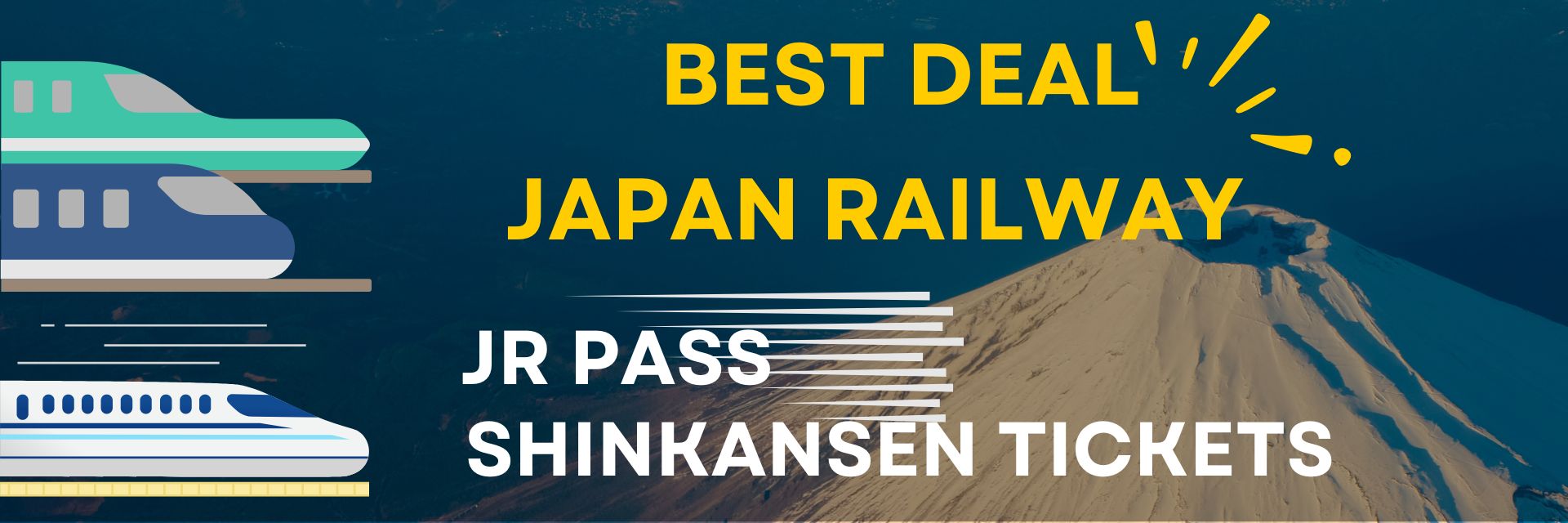
More Japanese fun tips
communication, transportation
How to Use Suica Card with Apple Pay on iPhone? Low-cost method to call to Japan by Skype: Step-by-Step Guide Japan Internet SIM Card Recommendation "Which phone card is the best among plans with unlimited data and unlimited speed? Which Side Should You Stand? Rules in Escalator in Japan Best Japan Travel Apps: Public Transport App, Rail Route App , Weather Forecast App and More
Shopping Advice, Offers
Where to Buy Japanese Sake? Complete Guide to Buy Sake in Japan Best Sake for Beginners: Complete Guide to Pick the Best Sake for Yourself
Itinerary suggestion
Itinerary suggestions for visiting Japan for the first time and traveling alone 5 Cat Islands in Japan: Meeting Cats in Tokyo, Shikoku and Fukuoka
More Japan Travel Information: Tokyo | Kyoto | Hokkaido | Climbing Mt.Fuji | Hakone | Lake Kawaguchi Tips for Traveling in Japan | Japan Hotel Deals | Klook Latest Promo Code
Ryu_C@RakuRakuJP
RakuRaku, which is 楽々 in Japanese. This site is committed to providing the most authentic travel information in Japan, bringing you a different Japan travel experience!
60 Things to Do in Tokyo: Complete Guide for Beginners in Tokyo
Shinjuku gyoen national garden: review, garden map and more, more different travel information, 5 cat islands in japan: meeting cats in tokyo, shikoku and fukuoka, best sim for japan: complete review on esim, unlimited data sim for japan, 7 steps to add suica card into apple wallet, low-cost method to call to japan by skype: step-by-step guide , which side should you stand rules in escalator in japan, where to buy japanese sake complete guide to buy sake in japan, best sake for beginners: complete guide to pick the best sake for yourself, 7 apps for traveling in japan: get this weather/transportation/map apps before you go.
RakuRakuJP , is a website dedicated to sharing articles about in-depth travel experiences in Japan.
I believe that before you travel to Japan every time, you will hope to get the most comprehensive travel information, and then be able to successfully complete the entire travel itinerary.
And our goal is to gather all practical itinerary information, discounted accommodation, and tickets, so that you can plan the entire Japan travel itinerary in the most convenient way.
useful link
- About RakuRakuJP
- RakuRakuJP All Articles
- Privacy Policy
- Website Terms of Use
- Agoda booking offers
- Klook Booking Offer
Editor's Picks
Latest useful travel articles.
©2017- 2024 RakuRakuJP. All Right Reserved.
- Contact us to advertise

Solo Travel to Japan (Tips and Etiquette)
By: Author Guest author
Posted on Last updated: August 6, 2024
Home » Travel Destinations » Asia » Solo Travel to Japan (Tips and Etiquette)
Natoya from the travel website Her Lifestyle Travel is guest author with her advice and tips on traveling to Japan alone. Afraid to travel to Japan by yourself? Fear no more! Natoya’s got you covered with this handy Japan solo travel guide that will give you the knowledge and confidence you need to tour around Japan on your own.

Solo Traveler’s Guide to Japan
I’ve had my share of meltdowns while solo traveling around the world, but one of my memorable meltdowns was less than an hour after getting off my flight to Tokyo, when I stopped at a convenience store to buy a bottle of water.
Like any other country, there were a variety of drinks to choose from: You got your mineral water, flavored water, and energy water, etc.
But it was all in Japanese (I know, duh, right?). Which one was the right one?! I just needed some spring water!
The thing is, I didn’t have this massive freak out over the fact that I couldn’t choose the right drink, I freaked out because I was wondering: how the heck was I going to travel around Japan solo if I can’t buy a bottle of water?!
I’ve had more freakouts like that than I can count (I lived in Japan for two years), and this is why I’m writing this guide. I don’t want you to freak out over something as simple as a bottle of water!
This is a list of tips from one gaijin (foreigner) to another on what you need to know about solo traveling in Japan.
I’ve visited about a dozen prefectures, and it doesn’t matter if you’re partying it up on a karaoke binge in Tokyo or getting sun-kissed in Okinawa, these tips will help you survive your first solo trip to Japan and have an awesome time.

In Japan cash is king
Although Japan is known for its futuristic gadgets and seen as technologically forward throughout the world, most restaurants only accept cash. Instead of going to a currency exchange kiosk, I recommend you open a checking account with no foreign transaction fees, like Capital One 360. Then when you arrive in Japan, you can withdraw money from a 711 ATM. The fee is around $3-$4.
These three phrases will save you
These three Japanese phrases will help you in many different situations so please memorize it:
Sumimasen: Excuse me. It’s used the same way we would use excuse me in English. You will most likely use this one the most. When in doubt…use sumimasen!
Arigatou Gozaimasu: a formal way of saying thank you.
Gomenasai: I’m sorry.
You should learn as much Japanese as you can before arriving in Japan, but seriously, these three phrases will get you far.
Don’t underestimate the Japanese public transportation system
Using public transportation in Japan is the best way to get around any prefecture, as it’s cheap and reliable. Don’t be smug like I was and underestimate the complexity of the metro! It’s confusing even for someone like me that lived in Japan for two years.
There’s the rail that runs long distances outside the city, and the metro that runs within the city. The rail is more expensive than the metro since it goes further.
Please watch this video from the Youtube channel Tokiyuyu about using Japanese public transportation, it’s a lifesaver! Download the Hyperdia app to help you get around Japan. You can use it for free for 30 days.
And FYI, trains do not run 24-hours a day in Japan. There’s the last train called “shuden”, which stops running a little before 12 am.

Getting around Tokyo Japan is easy when you know how!
Flying domestically is more affordable than the shinkansen
I know you probably want to try out the famous Shinkansen but that sucker is expensive! The Shinkansen is meant for Japanese businessmen, not for budget travelin’ solo travelers like you and I!
Use domestic budget airlines like Peach, Jetstar or Vanilla Air if you plan on traveling around Japan. Also, make sure you read your baggage allowance.
Just like budget airlines in Europe, you will have to pay for just about everything (seat selection, meals, baggage).
Get used to Mottainai
Mottainai which roughly translates to ‘what a waste’ or ‘how wasteful’, sums up the Japanese views of environmental conservation and overall respect for the environment. Respecting the environment by not wasting, destroying or abusing, but reusing and recycling.
You might hear someone exclaim mottainai! In response to someone that’s wasting food by throwing it away. When you understand this aspect of Japanese culture you will understand how to interact with Japanese culture.

Think of the group: ‘wa’
Another aspect that you need to know to survive Japan, is understanding ‘wa’, which roughly translates to harmony.
Creating harmony within the group and conforming with the group you are a part of. Japanese people strive to make things work for the group.
Understanding ‘wa’ and ‘mottainai’ will help you make sense of things when navigating throughout Japan and help you make smart decisions.
Keep the volume down in public
While you will most likely see women putting on a full face of makeup or someone drinking a cold one, in Japan it’s inappropriate to have a conversation in certain public places — in particular on public transportation.
This is where ‘wa’ will come in for you as a solo traveler.
You can’t talk on the phone, and if you do need to speak to someone, you should whisper.
And I know this seems harsh, but it’s quite nice that the trains are always silent, a perfect time to take a cat nap!

Take a solo trip to Japan and visit the Sensoji Temple located in Asakusa Tokyo
Taking taxis is a luxury experience and you’ll pay for it
Taking a taxi in Japan is like no other taxi experience because it is a fancy-schmancy experience. The taxi drivers wear white gloves, and they can open and shut the passenger doors right from their front seat!
It’s an interesting experience, however, you’ll pay with your right kidney for that ride. Unless you miss the last train, I’d skip using a taxi in Japan.
Get used to bowing
Get ready to start bowing for the first time in Japan! Even if you are a foreigner you are expected to bow.
The length of the bow and the degree of your bow depends on the importance of the person you are bowing to. 90-degree bows are for officials like medical doctors, police officer, or your boss.
But for the average joe you encounter while solo traveling in Japan, a 30-degree bow will do.

Tokyo Gion Matsuri festival lasts the whole month of July. An annual event since the year 869
Call Japanese people by their last names
This one surprised me when I moved to Japan, because other than Ghana, Japan is the only country that I’ve visited where it’s rude to call someone by their first name.
When you are addressing both Japanese men and women, put san after the person’s last name. For example, Yamaguchi San.
Proper etiquette when dining in Japan
Here are few etiquette rules that are a must follow when dining in Japan.
Say cheers: Never drink first, wait for everyone to get their drink. After everyone in your group has their drink then you can cheer by saying kampai.
Wait for everyone to be served: this is pretty much in every culture but it’s just so important in Japan. And if you’re up for it, before eating say: itadakimasu (let’s eat!).
No need to tip: There is no tipping in Japan.
You might need to take your shoes off: I’m sure you’ve heard that you should take your shoes off before entering a Japanese person’s home but you might have to do it in some restaurant too.
You will be given an indoor pair of shoes to wear in the restaurant. There is usually a shoe cubby space in the restaurant.
A few chopstick dos and don’ts: Never stick your chopsticks in your food standing straight up, never lick your chopsticks, and never use your chopsticks to take food out of a common dish.
If you have a common dish use a clean pair of chopsticks, or you can turn your chopsticks around and use the opposite end to take out food.
Slurp away!: Slurping your noodles is not rude in Japan. Slurping not only helps you to easily eat your bowl of steaming hot noodles, but it also lets the cook know that you are lovin’ it! So prepare to hear people slurping when dining in Japan.
Don’t be alarmed at the noise in the bathroom
Don’t be alarmed by the white noise you will hear when using the bathroom. No, it’s not a toilet monster coming to get you!
The white noise you will hear is used to cover up the sounds of people using the bathroom if you know what I mean…Every bathroom stall has a button that you can press to start the white noise.
Get used to people wearing medical face masks
Don’t be alarmed if you’re walking through the streets of Tokyo and see people wearing medical masks.
When Japanese people are sick and don’t want others to get sick they wear the masks (remember ‘wa’). They even wear a medical mask if they want to avoid getting sick.
Bring a small towel
While you’ll find that most restrooms in Japan to be spotless, you’ll find that many public restrooms don’t have paper towels or a hand dryer.
That’s why you will see Japanese people pulling out a small towel to wipe their hands, or even to wipe away sweat.
Japanese sizes might not fit
If you are over a size 8 in shoes (Euro size 38), and above a size 12/L in clothes, you have to make sure you pack everything you need for your solo trip to Japan.
As Japanese people tend to be smaller in overall size, there just isn’t a market for larger sizes. When I lived in Japan, I had to buy all my shoes online!

Imagine seeing Mt Fuji from your airplane seat – Fuji-san is Japan’s tallest mountain and an active volcano
Things that are hard to come by in Japan
Fluoride toothpaste, tampons, and strong deodorant are hard to come by in Japan.
I usually recommend that solo travelers pack light and buy what you need when you run out, but it’s hard to find these unless you go to an international store.
What not to wear in Japan
While it’s okay for women to wear super short skirts, wearing sleeveless shirts will get you stares. For some reason, it’s a faux pas to show you’re arms as a woman.
Honestly, I don’t get it, and it’s not fun during the steaming hot summers, but I just follow this cultural norm.
Don’t hand Japanese people money directly
When you are making a purchase, don’t hand the money directly to the cashier. You place the money on a small container and the cashier will pick it up.
The cashier will place your change and receipt there as well.
Make sure you stand on the correct side
I get this one confused when I have not been to Japan for a while.
When you are standing on an escalator or walking up a staircase in Osaka you should stand to the right, giving people room to pass by if they need to.
While in the rest of Japan you should stand on the left. No one really knows why it’s different in Osaka, but it’s this unspoken rule everyone follows.
When you’re on time, you’re late
Finally, the one thing that will make you lose friends in Japan quickly, is being late. If you make friends while solo traveling in Japan, and plan on meeting them at a certain time, arrive 15 minutes earlier.
I promise you that if you arrive 15 minutes earlier you will see the person you are meeting waiting for you. When you are on time, you are already late.
These are the most important things you need to know to have a stress-free solo trip to Japan.
As a solo traveler, it’s difficult navigating through a new culture on your own because you have to figure everything out by yourself, and sometimes, you don’t know — what you don’t know.
Use these tips to have a fabulous time in Japan, make friends, and enjoy all aspects of Japanese culture.
You may also enjoy reading 13 Best Places in Southeast Asia for Solo Travelers or 2-Days in Melaka Malaysia Itinerary
Save it on Pinterest!

About the author: I’m Natoya – a Brooklyn girl here to help newbie solo travelers take their very first solo trip abroad. I created my travel blog, Her Lifestyle Travel to help travelers learn the skills they need to affordably travel, and to gain the confidence to keep traveling solo…whenever and wherever the heck they want!
Tuesday 4th of October 2022
Thanks for this valuable information. I wish I had it when I was traveling for work. Now I want to go back to Japan and travel like an informed guest!
Monday 19th of October 2020
Really interesting insights - the more I hear about Japan the more intrigued I get - it's certainly somewhere I'd like to visit in the future. Thanks for sharing this 🤗 the 'no tipping' will make a nice change!!
Susan Moore
Hi Cherryl, Thanks for your comment, and happy to know you found the info helpful. There are so many great reasons to visit Japan! Hope you do get to visit in the future. Cheers, Susan
Ryan K Biddulph
Saturday 23rd of March 2019
Super interesting how cash is king there. I would see credit cards being popular, such a fast exchange of dough. But I reckon debt is frowned on in Japan.
Totally surprised me too! I didn't think about the debt factor, maybe so. But I guess they are trying to move towards cashless payments before the 2020 Olympics in Tokyo. Maybe I should visit Japan now to see how it's going :)
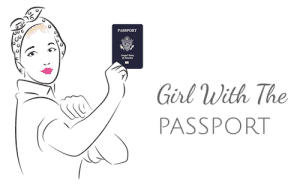
The ULTIMATE Guide to Solo Travel Japan
By: Author Girl with the Passport
Posted on Last updated: February 3, 2024
Categories Asia , Solo Female Travel
HEEY-YOO! And welcome to the whimsical world of solo travel in Japan!
Are you SUPER stoked?
And, BTW, the only correct answer to that question is an emphatic yes since Japan is ALL things wonderful!
You’ve got hedgehog cafes, ramen, sushi, kimonos, REAL LIVE MARIO KART, arcade games, beyond quirky fashion, ancient Buddhist temples, ethereal mountain ranges, capsule hotels , and SO MUCH MORE. Just be sure to learn exactly how to take solo travel photos before you go.
This way you have ample photographic evidence of the wicked awesome time you had.
But to REALLY seal the deal:
You’ll be beyond delighted to know that yes, Japan really does have it’s very own, Wizarding World of Harry Potter!
All my fellow Potterheads out there, feel free to rejoice, and give praise to all things Japanese.
Let’s slowly move away from my slightly random obsession with all things Harry Potter, and towards something slightly more helpful.
Like this SUPER awesome guide to all things Japan solo travel, which you can use to help you plan the perfect Japan 2 week itinerary and introduce you to some of the best places to visit in Japan .
Because in this post, not only will you find a ton of tips on how to stay safe in Japan, but you’ll also learn how to use public transportation in Japan, discover the best time to visit Japan, find out where to go in Japan, and even get a TOTALLY FREE, 7 day Japan itinerary!
Because yes, I too love all things free (Minus diseases, those are never lovely).
So, let’s make like a piece of sushi and ROLL our way into this post about all things Japan solo travel.
Sorry, but for me, wickedly lame puns never go out of style.
This post may contain affiliate links. Please see my disclosure for more information. As an Amazon Associate, I earn a small commission from qualifying purchases.
Solo Travel Japan 101: How to Stay Safe During Your Solo Trip to Japan
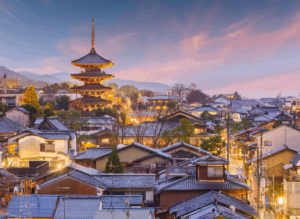
Learn how to stay safe as you solo travel Japan!
Thinking of embarking on some Japan solo travel and planning a 2 week Japan itinerary in Autumn ? Excellent! Because Japan really is one of the safest countries in the world for solo travel (#winning).
BUT it’s not 100% perfect….
Sure, Japan is known for its low crime rates, its next level organization (at the bureaucratic level since nothing is late here…EVER) and polite, friendly people,
That doesn’t mean that you shouldn’t remain vigilant as you solo travel Japan.
Use all of that awesome common sense that I know you have and take the same precautions that you would in any country.
Continue to do super obvious things like avoid walking down dark alleyways alone late at night, keep an eye on your personal belongings, don’t get too intoxicated, etc.
You know, all the usual stuff.
Because like basically every other country on the planet, Japan definitely isn’t immune to organized crime.
Yeah, I had no idea either. But apparently:
The ‘Yakuza’ is well known in Japan and is involved in murder, corruption, petty crime, and overall, high levels of not-so-nice mayhem.
And while it is unlikely that they’ll ever target a group of selfie stick-wielding tourists, it’s still a good idea to be aware of their presence, especially as you do some Japan solo travel in big cities, like Tokyo.
1) Be Prepared…You Won’t Be Able to Read Anything
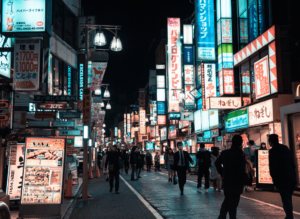
As you solo travel Japan, you’ll quickly see that there is a distinct lack of English signage.
‘It’s cool I’ll just follow the signs’… said no one in Japan.
Well, unless of course, you can actually read Japanese. OBVS.
In general though:
English is NOT universally used throughout Japan, a fact that can make getting around more than a little bit tricky.
Have your Google maps app handy and be prepared to get lost, more than once, during your solo trip to Japan.
Always have the address of your hotel handy (in both English and Japanese), just in case you get lost and need to share this information with a super helpful local.
This should help with that awkward language ‘what the hell are they saying’ barrier.
Always take the directions you are given with a pinch of salt.
Traditional, Japanese culture dictates that it’s better to give wrong directions than admit you are unable to help.
To avoid this mildly annoying possibility, try and ask for directions at a nearby hotel, where it’s highly likely that staff members speak English fluently.
And remember:
In Japan, hotel curfews are actually a THING.
That’s why:
Smaller, family-run accommodations may lockup between 10:00 pm and midnight.
Definitely research those policies BEFORE enjoying a wild night out on the town (Excuse me while I trade in my granny panties for a pair of ultra-rad glow sticks and a Monster energy drink. Because yes, staying up past 10:00 pm really isn’t my “thing”).
When traveling solo at night, always have your route back “home” planned out BEFORE you down some Sake and sing your heart out at a Japanese karaoke joint.
You really don’t want to be doing any serious travel planning when you’re inebriated AF in a foreign country.
And if you do decide to drink:
Never leave your drink unattended since it could easily be spiked while you’re not looking; a trend that is, sadly, becoming all too common in the Tokyo and Kyoto bar scene.
2) Cash is King
Well, you might expect a tech hub like Japan to be card crazy, Am I right?
Surprising though, that is actually NOT the case.
It’s actually quite the opposite.
Do yourself a solid favor and grab some cash before you head out for the day, at least if you wanna avoid being penniless and having to frantically search for an ATM that accepts foreign cards.
Thankfully though:
Most hotels, 7-Elevens, and restaurants all accept cards.
A lot of smaller places won’t.
Be prepared and ALWAYS have a bit of cash handy.
3) You WILL Experience Culture Shock
Because if you’re not, then you better be.
See, things in Japan are done a whole lot differently then they are in the Western world.
From toilets (Take my word on this one, because you will see what I mean) to local taboos like answering a phone call while riding public transportation (Yeah, don’t do this), there are a lot of things about Japan solo travel that you’ll need to get used to.
Don’t freak yourself out about these taboos since Japanese people are really considerate and will take the fact that you’re a visitor into account.
It’s still a good idea to brush up on your Japanese customs/etiquette BEFORE your visit, just so that you don’t cause unnecessary offense.
And if you can:
Always try and avoid doing anything that will draw too much attention to yourself since this is a big no-no in Japan.
4) Unwanted Male Attention
Oh, h ell to the no!
Don’t panic though because it’s really not that bad.
Because thankfully:
Catcalling is not a thing here. Thank f*cking God.
That being said:
And Ladies out there should try and avoid using public transportation during peak hours since instances of sexual harassment and groping are quite common on crowded trains.
To resolve this issue, some cities have started using ladies-only carriages during rush hour, which can be found by following signage along various train platforms.
5) Avoid Common Scams
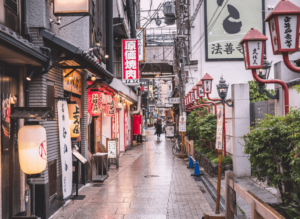
Japan is an incredibly safe country for solo travelers. However, there are some common scams that you’ll need to watch out for.
Well, the main one to watch out for is the ‘Japanese nightclub scam’, especially when visiting well-known nightlife hotspots, like Tokyo’s Kabukicho.
What happens is, a street tout will invite you into a club and shower you with attention and drinks…before swiftly presenting you with a not-so-awesome bill for a few thousand yen.
You will be expected to foot the bill for all those drinks (and for your “new found friend’s” precious time).
And if you refuse to pay?
Well, then things could get a bit dangerous and threats could be made.
To avoid this scam, just walk away. Don’t even respond to anyone who invites you into a club.
Because even the most well-trained touts will take the hint and leave you alone.
You also don’t have to be rude either. Just politely decline and move on.
And when in doubt:
Always remember the age-old adage that if it seems too good to be true, then it definitely is.

6) Watch the Weather
And I’m not talking about the rain.
See, unfortunately, Japan can be prone to freak weather conditions, like typhoons and earthquakes.
Before doing any solo Japan travel, it’s always a good idea to be aware of the seasons and know what to expect from the weather.
So, just a little FYI for you.
Typhoon season usually falls between May and October and peaks in either August or September.
Because earthquakes are quite common in Japan, it’ s a good idea to prepare yourself for an earthquake emergency.
And no, not by practicing hiding under tables (lol).
Just try and familiarize yourself with your hotel’s evacuation policy and always follow locals to designated safe areas if the worst should happen (Because yes, you guessed it. All public safety announcements will be in…Japanese.)
And the rain?
Well, it’s slightly less catastrophic, but sudden downpours are fairly common.
Grab a cheap umbrella from the nearest konbini to keep yourself dry and avoid wandering around like a drowned street rat (Anyone else reminded of Aladdin right now? No? Just me? Right, swiftly moving on).
SOLO TRAVEL JAPAN: EVERYTHING YOU NEED TO KNOW ABOUT PUBLIC TRANSPORTATION!
Japanese trains are known for being some of the most efficient in the world. Yup, just one of many things to look forward to when planning your Japan itinerary .
They can also resemble an unsolvable puzzle if you’re from out of town.
Here are some general transportation tips to help you make the most out of your time in Japan.
1) Getting to the Center of Tokyo from the Airport
Whatever you do:
Do NOT take a taxi from the airport to your hotel.
Not only are they very UN-cheap:
But many taxi drivers actually can’t speak or read English, making communication more than a little difficult (Hello? Google Translate?).
Whenever possible, try and use the city’s monorail system, which connects directly to the subway.
You can quickly, easily, and somewhat cheaply get anywhere in the city that you need to go (You can also take the Keikyu Line directly to central Tokyo).
But, what if I wanna catch an Uber?
Well, Japan has technically had Uber since May 2018.
I still wouldn’t use it as your “go-to” mode of public transportation since it’s not really widely used by locals.
Things may be changing!
Because In 2020:
Tokyo will be hosting the summer Olympics.
And to ensure that spectators can easily move throughout the city, both Uber and Didi (A Chinese rideshare app) will be providing Tokyo with extra transportation services.
As a result:
Uber may become a viable transportation option when traveling to and from the airport.
I wouldn’t bother using it for inter-city travel since the Tokyo metro is WAY cheaper.
But, until Uber becomes more popular:
You can always just download the ‘Japan Taxi app” before you go to Japan.
It has over 60,000 taxis that cover all 47 prefectures of Japan.
You should definitely be able to find a decently priced taxi, no matter where you are in the country!
Standard taxis in Japan really aren’t THAT bad, especially when traveling within cities since using a taxi over short distances is pretty affordable.
And added bonus?
Not only are they EVERYWHERE, but most of them also accept credit cards as a form of payment.
Which is great since I for one am all about minimizing my cash withdrawals and the foreign transaction fees associated with them.
***When traveling in Tokyo, be sure to download the ‘Takkun Tokyo Taxi’ app since most Tokyo-based cabs are on here. However, when using this app, you will be charged a small pickup fee.***
2) Platform Trickery
Just to amp up your level of Japan solo travel confusion:
Transportation services with similar-sounding names tend to be grouped together on the same platform.
Many platforms will have several different categories of trains (e.g. local and rapid trains) arriving within a minute or two of each other.
Which can be insanely confusing since the names of all these trains SOUND EXACTLY THE SAME!!
You should definitely do your research BEFORE you arrive and know the difference between various train services.
Because while informational displays DO indicate the category of the next arriving train, they aren’t always in English!
Making them slightly impossible to read if you don’t speak Japanese.
If you can, try and identify different services using their Japanese names to avoid getting on the wrong train and ending up in some beyond random part of town.
3) The Great JR Rail-Pass Debate
Well, it’s not actually that great, but still.
Because a question that I often get is, “Should I get a JR rail-pass?”
And the not so straightforward answer is that, well, it depends.
JR passes are great for Japan solo travel since they allow you to be flexible with your itinerary.
If you’re not sure where you’re headed or when, then the JR pass is your new best friend, especially if you wanna take a ride on a bullet train.
If you purchase a JR rail-pass , what do you actually get?
- Unlimited use of all JR trains from Kagoshima in the south to Hokkaido in the north.
- This includes the Shinkansen (bullet train) but not the Nozomi or Mizuho bullet trains. And while these trains are technically faster than the Shinkansen, I doubt you’ll actually notice the difference.
- You can also use local JR commuter trains, JR buses, and JR ferries.
- The JR rail pass is also valid on all five of Tokyo’s main railway lines!
The JR Pass is costly, so definitely make sure that you plan on doing at least a few long-distance train journeys, on premium trains, if you want to get the most out of the money that you spent on this pass.
But wait, how much does a JR Pass actually cost? Well, as of winter 2019:
A 7- Day pass costs $273.83
A 14- Day pass costs $436.37
A 21-Day pass costs $558.29
And this is all PER PERSON. So yeah, NOT cheap.
For many travelers though:
Riding on a long-distance bullet train (Shinkansen) is kind of like a right of passage.
So, if this sounds like you:
Then plan on taking at least two different trains per week.
It would actually be cheaper for you to buy individual tickets and not a 7-day JR pass.
Some other JR-Pass tips:
- If you are just staying in Tokyo, then this isn’t the pass for you since local trains in Tokyo are pretty cheap (around $1 per journey).
- You can pay more for a ‘Green pass’ (a first-class pass), but it’s not really necessary since the standard trains in Japan are immaculate.
- Don’t be late!! In fact, be EARLY since Japan takes time management VERY seriously.
If you do decide to get a JR rail-pass, then save yourself some time and buy it in advance ( GET YOUR JR PASS RIGHT HERE, RIGHT NOW! )
You actually HAVE to get your Japan Rail Pass BEFORE you arrive in Japan (AGAIN, to be SUPER CLEAR. You CANNOT get a Japan Rail Pass within Japan!!)
Definitely order it online, prior to the start of your trip, and then just have it delivered to an address outside of Japan.
And once you finally arrive in the country:
You can easily get it validated at any local ticket office.
Tell me more about this ticket validation process.
Before you board a train, you will first need to trade in the voucher that you received in the mail for your actual JR Pass.
And once you have your JR Pass:
Do try and reserve your JR pass train tickets in advance, especially on busy days/peak seasons/weekends since no one wants to get to the station, only to find out that their train is completely sold out!
To do this:
Just write down all the trains that you want to take (or bring a Hyperdia print out with you) and then bring this info to the JR Office at the station.
To make life easy:
Just make your train reservations when you exchange your online voucher for an actual JR pass.
If you don’t have it all figured out, not to worry.
Because the official JR pass website ONLY recommends reservations when traveling between April 27th- May 6th, August 11th- 20th, and December 28th- January 6th.
And the rest of the time?
Well, you can easily board a train without a reserved seat since the designated, JR Pass seats will be clearly marked on the train.
And if you’re still not sure whether the JR rail-pass is right for you, then just run your route through hyperdia.com and compare the cost of one-way tickets with the cost of a JR Pass.
And just go with whichever option is cheaper.
Bonus tip #1!
Most Japanese trains have limited storage space. Therefore, travel light and DO NOT pack everything except the kitchen sink.
Bonus tip #2!
Looking for that Insta-perfect shot of Mount Fuji?
Yeah, I feel you.
If so, then when traveling from Tokyo to Kyoto, ask for a seat on the right-hand side of the train.
Sit here and you are guaranteed to have the best seats for maximum camera snapping action.
And yes, feel free to thank me later.
Other Ways to Get Around as you Solo Travel JAPAN
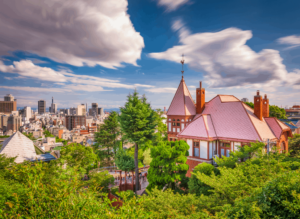
Japan is an amazing country. But sometimes using its transportation system can be more than just a little tricky.
1. TOKYO METRO (THE BEST WAY TO GET AROUND TOKYO)
The Tokyo subway system consists of two interconnected networks, the Tokyo Metro and Toei Subway .
Trains and subways in Tokyo also run between 5:00 am and 1:00 am daily, are religiously on time, and arrive every 3 mins during peak hours (Peak hours are on weekdays between 8:00 am and 9:00 am and shortly after 5:00 pm. Morning rush hours also tend to be more concentrated and heavier than evening rush hours).
Oh, and girl, (and guys) don’t forget…
- Swipe your passcards both on the way in AND on the way out. The digital screen is awesome and will display the remaining balance on your card.
- Most train stations have multiple exits- so remember to take the right one!
- Consider the “Tokyo Subway Ticket“ which provides unlimited use of all subway lines. Pick it up at either Narita Airport or Haneda Airport for the ultimate freedom during your Japan solo travels.
- Queuing is an art form here and you will be expected to do so on the platform. Just be prepared because there will be a mad dash to nab a seat during rush hour.
- The most useful line in Tokyo is the JR Yamanote Line, which is commonly referred to as the “Tokyo Loop Line” or just the “Loop Line.” You can use your Japan Rail Pass on this line.
- Another great way to pay for trains and subways in Tokyo is with a prepaid Pasmo or Suica card since it is WAY cheaper than buying individual tickets.
Thought trains were complicated?
Well, think again!
Because Japanese buses are a little bonkers!
- You need to board the bus from the middle and not the front
- You will collect a plain, slip of paper as you board the bus. This piece of paper will have a number on it. And…TADA, this is your bus ticket
- The electronic board displaying ever-changing numbers at the front of the bus may confuse you! But, please use it before you hop off the bus since the cost of your bus fare will be displayed under your seat number, AKA the number that is printed on your ticket
- The driver will expect you to deposit both your bus fare and your ticket, into a designated collection box BEFORE you leave the bus.
You could always just skip all this confusion and get a Pasmo card instead.
Remember though:
This card is only valid in the Tokyo/Yokohama region and is sort of like a Metro/Travelcard/Oystercard for Tokyo’s metro/buses.
Now, if you do purchase one:
Try and put at least $30 on the card since this will cover quite a few journies.
All you need to do is tap your card when you board a bus (or metro), and then again when you get off.
See! Super simple!
And while buses are great to use in small cities and in the countryside, I would avoid using them in major cities, like Tokyo, since there’s a lot of traffic and it will take you forever to get anywhere.
I would also avoid using buses over long distances.
EXCEPT IN KYOTO!
Yeah, don’t ask me why but it’s actually cheaper to use the bus than the train in Kyoto.
Some of the different types of buses that you’ll find in Japan are:
- Route buses (which operate within cities and towns),
- Highway buses (which operate between large cities),
- Limousine bus (which operate between the airport and a major bus station)
And out of all of these different types of buses, you’ll probably end up using route buses the most.
But, are they really worth using?
Well, like with all forms of public transportation, they have their own set of pros and cons!
A major pro is cost.
Because you can definitely use buses as a low-cost alternative to the train.
For example:
You can catch a bus from Tokyo to Kyoto, for just 1,599 JYP ($15) which is WAY cheaper than the train.
Buses are also insanely comfortable and come with wicked awesome, reclining seats (Some ever have full-on SALONS!!).
However, one GIANT con is time!
Because the above journey will take you over 7 hours by bus and just 2 hours and 15 minutes by train.
A lot of long-distance bus journeys also take place overnight, which is great for saving money, at least if you’re comfortable doing this alone.
If you wanna save money, take the bus.
If you wanna save time, take the train.
Because it really just depends on which one of those things is more important to you.
***PSST: Don’t discount sightseeing buses since The Chuo Bus from Sapporo to Shikotsu and the Toya Lakes is a great way to see some of Japan’s most amazing scenery.***
3) Plane Travel
Thinking of cutting down on your travel time by flying across Japan?
While it is doable, it’s definitely not the most cost-effective way of traveling through Japan.
When traveling between cities, I’d still recommend the train.
For longer journeys, like the one between Fukuoka and Sapporo, I’d consider flying since it’s the fastest way to travel.
And if you do decide to fly:
Try using smaller, domestic airlines, like Skymark and Jetstar Japan, which usually have cheaper fares.
You can also check with the airline operator of your international flight (BEFORE you arrive in Japan) and see if they offer discounted domestic fares to passengers who fly on their international routes to Japan.
Yup, something that is definitely worth checking out.
We all know that Japan is an archipelago.
And as such:
Ferries are a constant form of transportation between islands.
- Some smaller islands, like Naoshima can only be reached by ferry
- Ferries can be useful for traveling among Japan’s four major islands. But, information on ferry routes (including schedules and fares) is almost always in Japanese ONLY!
- If you ‘re interested in traveling by ferry, instead of train, then the ‘Japan Ferry Pass 21’ is the sea equivalent of the JR Rail pass. Covering 14 routes over 21 days, it’s about a third of the cost of the rail pass is just $192 per person.
But is it right for me?
Well, if your route/time schedule allows for ferry travel, then this can be a viable transportation option.
Just plan on making at least two trips to some of Japan’s other islands if you want the Japan Ferry Pass 21 to be cost-effective.
I would ONLY recommend this option if you’re looking for a slower form of transportation.
Because if getting to your final destination QUICKLY is more important than the journey itself, then this isn’t the option for you.
***Another added benefit of traveling by ferry is that you can save money on overnight accommodations, something that is never cheap in Japan! Plus, ferry cabins are usually relatively comfortable, modern, and clean.***
WHEN IS THE BEST TIME OF YEAR TO SOLO TRAVEL JAPAN?
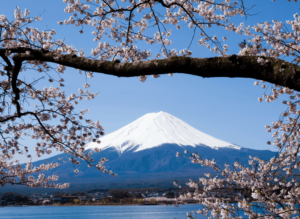
Any time between March and May (minus Cherry Blossom season) or between September and November is probably the best time to solo travel Japan.
It’s never really a bad time to do a bit of Japan solo travel.
You will definitely get a very different vibe from the country, depending on when you visit.
If at all possible, try and plan your visit between March and May (Minus cherry blossom season, which varies depending on where you are in the country) or between September and November, when weather is mild, prices are at their lowest, and when crowds are not as crushingly huge.
If you do decide to visit during the spring, psych yourself up for it because this is THE most famous (and busiest) time to visit Japan.
Why?
Two words. Cherry blossoms. Obvs.
Travel to Japan during this time of year and expect to be bombarded by hordes of tourists and locals who are all out celebrating the beautiful blossoms during hanami (blossom viewing) picnics.
If you’re not fazed by epic levels of heat and humidity, then summer is a great time to visit Japan.
That’s because:
There are a ton of festivities that take place during this time of year.
From dazzling fireworks displays to al fresco munching on street food, summer is definitely a fun time to visit Japan.
Can’t deal with the crushing crowds of spring but still want to experience some of Japan’s insane, natural beauty?
Then considering visiting during autumn, AKA the season of red and gold leaves.
Japan’s countryside will come alive with vibrant colors, making it the perfect time to get outside and do a bit of hiking.
What if you’re really a snow bunny at heart?
Then Japan totally has you covered!
Just head up to Hokkaido in the North and enjoy some beyond epic mountain ranges that will make any snow-loving traveler drool.
Because yes my friends.
Hokkaido really is known as the ‘Swiss Alps of Asia’ for a reason and is the perfect place for any solo traveler who is desperately searching for ALL the Christmas feels (which are sometimes lacking in other parts of Asia TBH).
WHAT TO SEE IN JAPAN: 10 AMAZING PLACES TO VISIT
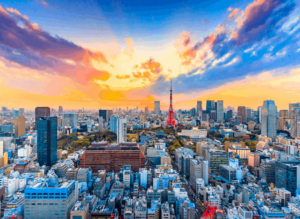
Tokyo Tower and the iconic skyline of Japan’s amazing, capital city.
You know those images that you have in your head of futuristic skyscrapers, neon lights, quirky fashionistas, video-game obsessed individuals, and over-the-top, one-of-kind activities?
I’m 100% referring to owl, goat, and hedgehog cafes, as well as a real-life version of Mario Kart (FYI: You can also do this in Osaka AND Kyoto).
You’ll find all that and more in Tokyo since this modern AF city really does sit at the beating heart of contemporary Japan
That being said though:
There are also a ton of surprisingly traditional aspects of this city too, like sumo wrestling in Tokyo .
Tokyo really is a place full of contradictions.
When you visit Tokyo, be prepared to battle your way through crazy busy pedestrian crossings, to be overwhelmed by the sheer size of this place (Tokyo is truly MASSIVE), and fall in love with the city’s beyond divine 7-Eleven egg sandwiches (strange but true).
If you swan dive headfirst into Tokyo’s fast-paced lifestyle, all this awesomeness can result in total sensory overload.
From robot restaurants to amazing, panoramic city views atop the Tokyo Metropolitan Government Building in Shinjuku (free and deffo worth it!), this crazy busy city really does have it all.
Try and take it easy while enjoying all the sights, sounds, and flavors that this vibrant metropolis has to offer.
You are forbidden (do you hear me? LOL) from leaving this city without doing the following.
- Visit the Akihabara district for arcade games, ‘cute’ cafes, and delicious ramen.
- Walk across the famous Shibuya Crossing- if you dare!
- Wear some of the city’s fashions in Takeshita Street, Harajuku (Gwen Stefani eat your heart out)
- Try the soup dumplings and espresso tonic in Yokohama Chinatown (SO GOOD!!)
- Visit the CupNoodle Museum and make your own.
- Get your real-life Mario Kart on while driving through the crazy streets of Tokyo, in a go-cart, and dressed as your favorite Mario character. Slightly mental but hilarious. You also will need an international driver’s license for this so plan accordingly because they are strict about this.
- Explore the colorful Digital Arts Museum TeamLab Borderless.
Tokyo also gets extra brownie points from me since eating alone here is easy and uber-tasty too!
Solo diners can happily, and not-so-awkwardly, eat at the bar of any Sushi, Tempura, and ramen joint in the city.
Yes, my friends, we call this living the dream.
And if you really want to live it up, you could even take an amazing Mt. Fuji tour from Tokyo .
Nine Hours Woman Kanda (Budget) – The Shinjuku and Ginza neighborhoods are perfect areas for solo travelers to stay. However, If you’re not careful, accommodations here can be pricey. And that’s where Nine Hours Woman Kanda comes in. With quirky, fun, and totally bonkers rooms, that start at $55 per night, this capsule hotel is the perfect place to stay in Tokyo. And while these establishments are traditionally for men only, many capsule hotels are now opening their doors to women (sorry but no men allowed), making this a fantastic, extra-safe, budget hotel option for any of my fellow, solo female travelers out there. I also love that this place has a cozy, minimalist vibe about it and is conveniently located near both Tokyo Station and the popular, Akihabara area.
Shibuya Granbell Hotel (Mid-range) – Want a stylish, boutique hotel that is also affordable? Then check out Shibuya Granbell Hotel near Shibuya station. Rooms here start at $110 per night and have this incredible, pop-art, minimalist design that is beyond cool. All rooms here also include free WIFI, flat-screen TVs, complimentary breakfast, and bike rentals, for an additional fee.
Want your Japan solo travel to be served to you with a side of geishas, temples, zen gardens, and cobblestone streets?
If so t hen Kyoto is for you!
Sure, Kyoto has its fair share of ugly high rise buildings, like any other major city.
It won’t take long for an intrepid solo traveler like yourself to venture past those less than stellar buildings and discover vast mountain ranges, as well as various aspects of traditional Japanese culture.
While you’re here, you cannot miss out on:
- Temples. Kyoto is brimming over with temples!! So, choose the temples that you visit wisely. Also, try and visit first thing in the morning to avoid large crowds. My personal faves include Kinkaku-ji (Golden Temple), where you can actually get your fortune from a vending machine (SO Japan), and Kiyomizu-Dera Temple .
- Visit the iconic red torii gates of the Fushimi Inari Shrine.
- Take a morning stroll through the Arashiyama Bamboo Grove .
- Visit the home of a geisha in Gion and partake in a traditional tea ceremony/learn how to make matcha tea.
- Explore the beauty of Yasaka-jinja at night.
And if you’re hungry (because we all know that I always am):
Then be sure to try some of Kyoto’s famous ‘ okonomiyaki’, a crispy, made-to-order pancake that is served to you with your choice of fillings.
Simple, yet oh so tasty!
And if you really want to get your foodie swerve on, then stop by Menya Gokkei (Northern district) for some authentic, beyond delicious, Japanese-style ramen.
You can also hit up any I chrian (AKA 24 hour booths where you can consume ramen totally by yourself) in town since this is basically any ramen loving, introverted traveler’s dream.
Slurp away my friend because you totally deserve it!
Now, for the best gyozas in town, visit the one and only Sukemasa . Not only is the food here delicious, but you can get a couple of gyozas, miso soup, rice, and pickles for less than $7.
Talk about an epic steal!
Tanaka-ya (budget) – With rooms that start at $52 per night, T anaka-ya is a cute, budget-friendly, traditional, Japanese-style homestay that features tatami-mat flooring, paper sliding doors, and Japanese futon bedding. It is also conveniently located in Gion Miyagawa-Cho, making this the perfect home base for which to explore Kyoto’s iconic old town.
The Sekura Terrace (Mid-range) – Conveniently located near Kyoto Station, Sakura Terrace is an awesome place for any solo female travelers out there to stay. I mean, not only do they offer a comprehensive ‘ladies plan’ that includes meals, but rooms here are bright, start at just $84 per night, and feature floor-to-ceiling windows, flat-screen TVs, and free WIFI. There’s also an on-site, coin-operated laundry facility, just in case your clothes are starting to look a bit dingy.
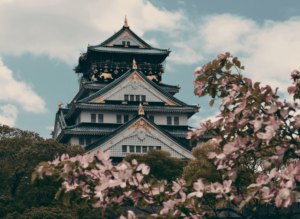
The old-world charm of Osaka Castle, one of the best places to solo travel Japan.
Another sprawling neon city:
Osaka is a mass of bright lights, amazing food, and affordable prices, at least when compared to its big brother. Tokyo.
So where to begin?
Well, food is ALWAYS a good place to start. Especially since I like eating just as much as I like breathing.
Osaka is home to some SERIOUSLY amazing vegetarian cuisine.
It was so good that I basically wept tears of joy.
If you’re looking to get your foodie swerve on, then devour some udon noodles at Azuma Udon, the city’s oldest udon restaurant.
If you’re total veg like me, then hit up Green Earth, a delicious vegan-friendly eatery with a set lunch menu, that features rice, a main dish, salad, a vegetable side dish, and soup, for just $8.
If you actually wanna do something other than eat ALL of your feelings, then definitely:
- Ride the Ferris wheel on top of the Don Quixote store in central Osaka/. Trust me on this, it is the very definition of a one of a kind experience!
- Check out the bright lights of Namba. In particular, Dōtonbori is the most popular street in Osaka for viewing neon lights and animated signs, with the Glico Running Man being an Instagram fan fave (#justsayin’).
- Discover the quirkier side of the city in Shinsekai District, which is filled with arcade games and food halls. You can also enjoy some epic, panoramic city views from the top of Tsutenkaku Tower .
- Visit Osaka-jo castle . Nestled inside the city walls, this building is one of the oldest structures in the area and sits within a picturesque park (It’s also an extra stunning place to visit during cherry blossom season).
Toyoko Inn Osaka Umeda Higashi (budget) – If you’re on a budget, then business hotels can be a great option for you while you solo travel Japan. And one of the best in the area is Toyoko Inn Osaka Umeda Higash i . Now, while luxury it most certainly ain’t, it’s still clean, well equipped, and centrally located (It’s literally a 4-minute walk to the subway). Rooms here also start at just $30 per night and feature super snazzy things like WIFI, flat-screen TVs, mini-fridges, and tea/coffeemakers (Talk about the posh life! LOL). Complimentary breakfast is also available, as is access to a coin-operated laundry facility since, I mean, well, who doesn’t like clean clothes?
Hotel Monterey La Soeur Osaka (Mid-range) – Perched atop a high-rise building that overlooks the O River, this contemporary hotel has an American, art deco style to it. Yet, it somehow retains a distinctly Japanese vibe with warm rooms that start at $89 per night. This hotel is also just a 7-minute walk from the train station, and features an on-site French restaurant, tea room, bar, and gorgeous, next level divine, spa!
So, why should Nara be on every solo traveler’s bucket list?
Because of the local deer that bow for food!
In truth though, Nara definitely has way more to offer visitors than a chance to feed cute little deer.
Nara is full of historic, Japanese treasures, making it the perfect place from which to indulge your inner culture vulture.
Because, believe it or not:
Nara was actually Japan’s first capital city and is home to a wealth of charming, ancient buildings that stand as a remnant of the city’s high profile past.
This also includes a variety of different UNESCO world heritage sites like the Hall of the Great Buddha (But, more on him later.).
This historic city is easily accessible from both Kyoto and Osaka and makes the perfect day trip from either city since both places are just an hour away from Nara by train.
While you’re in this ultra-fab metropolis, do not miss out on:
- The Daibutsu-den (Hall of the Great Buddha) at Todaiji. It’s arguably one of Nara’s most famous sights (besides the deer of course.) and features a 15-meter tall, golden Buddha that sits inside the world’s largest wooden building. Impressive much? I think so!
- Feeding some local deer in Nara deer park. Yeah, they are pretty friendly and will wait until the food is offered to them. So don’t worry about them stealing your lunch (The monkeys of Asia should take note!)!
- Eating some ‘Nakatanidou’, a famous Japanese rice cake. And while the ‘yomogi-mochi’ may sound gross, it’s flavored with mugwort plant and is actually super tasty.
- The Kofuku-ji Temple, which was established in 669 AD and has a great deal of cultural significance due to its links to the Fujiwara family.
Guest House Oku (budget) – For the ultimate trip down nostalgia lane, book a stay at the small, but cute, Guest House Oku. This charming little boutique hotel has spotless rooms, which start at $30 per night. And while bathrooms here are shared, the real appeal of this place lies with the friendliness of the hostess, Yoko, who goes out of her way to make guests feel truly at home and like they are having an authentic, Japanese experience. This hotel also serves amazing food, is incredibly safe, and is conveniently located near the center of the city.
Centurion Hotel Classic Nara Station (Mid-range) – Hallelujah! Finally, a hotel with a reasonably sized room that doesn’t inadvertently feel like a tomb. Because let’s be honest, spacious hotel rooms are a rarity in Japan. But, somehow, Centurion manages to deliver spacious, warmly decorated, comfortable rooms that are all still just a 5-minute walk from the nearest train station. Rooms here also start at $97 per night and include sofas (feel free to “oh” and “ah” at will), flat-screen TVs, tea makers, mini-fridges, WIFI, and air purifiers. And for an added dose of Japanese quirkiness, try using their coin-operated laundromat to freshen up your clothes before you leave the city.
PSST: Kyoto and Osaka are both a short distance from Nara and have WAY more options when is comes to accommodations. So, if you’re struggling to find what you’re looking for, then you can always book a stay in either city and just visit Nara as part of a day trip.
5. Takayama
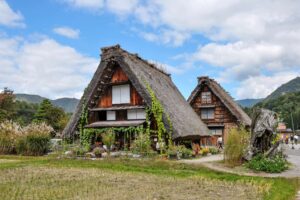
Some of the quaint, Japanese-style architecture that you’ll find in Takayama, Japan, at the base of the Japanese Alps.
Takayama might just win my award for the prettiest place EVER and is easily one of the best hidden gems in Japan .
Because no doubt:
This city if flippin’ gorgeous!
Well, it’s located on the edge of the Japanese Alps and is far less touristy than many other places in Japan.
And you know what I say to that?
Crowd free is the way to be! Because Takayama is basically THIS introverted traveler’s idea of a total dream!
Throw in some exquisite, traditional wooden houses, signature red bridges, and brightly colored shrines, and you may never wanna leave!
Other things that you MUST do while you’re here include:
- Go for a morning stroll around Sanmachi Stree t. It’s located at the center of Takayama Old Town and is where you’ll find many of the city’s lovely, traditional wooden buildings (perfect for the insta feed of awesome).
- Explore local, morning markets like Jinya-Mae ( a small market that is located in front of the Takayama Jinya building ) and Miyagawa ( a market that sits alongside the Miyagawa River).
- Eat some ‘mitarashi-dango’ , or rice balls grilled in soy.
- Cycle through Shiroyama Park , a part of the Japanese countryside that sits just five minutes outside the city. Also, be sure to hike to the Takayama Castle Ruins and admire the incredible mountain top views from here.
- Visit Cafe DON for Coffee and Cake!
The Country Hotel (Budget) – At just $35 per night, this hotel is definitely no-frills. But, The Country Hotel still has everything you need for a comfortable stay (Think comfy beds, WIFI, air conditioning, etc.). They’ll even provide you with complimentary green tea and cozy slippers, both of which are clearly essential items for any wicked awesome hotel stay. This place also gets bonus points for its primo location since it sits right across the street from JR Takayama Train Station .
Takayama Olan Hotel (Mid-range) – This modern meets traditional, Japanese-style hotel has a fantastic, central location (Just three minutes from Takayama train station) and offers guests comfortably designed rooms that start at $123 per night (think luxe seating areas, posh dark wood furniture, free WIFI, tatami floors, futons, etc.). There’s also a buffet-style, onsite, restaurant where you can enjoy a delicious breakfast, for a small fee. However, the real highlight of any stay at the Takayama Olan Hotel is their stunning, open-air, roof-top, hot spring, which provides you awe-inspiring, panoramic views of the nearby, Hida Mountains.
So, you’ve probably seen all of those amazing photos of a beyond colorful ship that is gently gliding past Japan’s immortal, Mount Fuji.
And if not:
Well then, feel free to look it up on Insta right now. I mean, I can wait…not-so-patiently since a climb up Mt. Fuji Japan is the stuff that travel dreams are made of.
The mountainous town of Hakone actually overlooks this picture-perfect lake, which is locally known as Lake Ashi.
This town is also located inside the Fuji-Hakone-Izu National Park and is just a short (ish), 1.5-hour bullet train ride away from Tokyo.
Additionally:
This place is known, the world over, for its picturesque, hot springs resorts (AKA onsens in Japanese).
In addition to its wealth of onsens, Hakone is also home to various world-class art museums, historic Shinto shrines (like the aptly named, Hakone Shrine), and expansive mountain ranges.
This tiny town makes for the perfect, weekend escape from the chaos of Tokyo.
You CANNOT leave this place without trying the black eggs!
They’re black because they’ve been infected with some rare strain of Bubonic Plague.
This local delicacy, kuro tamago (black eggs), is created by cooking chicken eggs in the sulphuric hot springs of Owakudani – a volcanic crater that was formed over 3,000 years ago.
Apparently:
Legend says that eating just one black egg will extend your life by more than seven years.
To procure these little fountains of youth for yourself, just stop by Kurotama Shop , in Owakudani, for some of the best black eggs around!
***While many people tend to visit Hakone as part of a day trip from Tokyo, I would advise against this. I mean, it’s doable but it just makes for a really LONG, really RUSHED day. So, if you have the time, definitely stay overnight in Hakone and enjoy your visit at a more relaxed pace.***
Hakone Tent (Budget) – If you’re looking for a unique hostel that is both reasonably priced and cozy, then this rustic guest house is for you. Once a Japanese ryokan in its former life, this building has long since been transformed into a comfortable, light, airy, and modern hostel that is just a stone’s throw away from Gora Station. Beds here sit inside six-person, single-sex dormitories, start at $30 per night and include tatami mats and futons. Private rooms with wood floors are also available here, as is WIFI, towels/sheets (for a fee), and access to an onsite cafe/bar. While staying at Hakone Tent, you’ll also get full access to their on-site, gender-segregated, hot spring facilities (Can I get a whoop, whoop? No? Okay, swiftly moving on).
Hakone Honbako (Mid-range) – Set along a quiet, tree-lined street is Honbako Honbako, the hotel of your literary loving dreams. See, ’honbako’ literally means ‘bookcase’ in Japanese. Which is a perfect name for this boutique hotel since It is brimming over with books, books, and, oh yeah, more books! I mean, the library here is outfitted with floor-to-ceiling bookcases that contain more than 12,000 different titles. Add in comfortable, modern rooms (which start at $173 per night) with hardwood floors, spacious beds, private outdoor baths (with geothermal water), minifridges, and tea/coffee makers, and you have the perfect place to stay in Hakone. Breakfast is also included with the price of your stay, as is access to an on-site cinema and the hotel’s gender-segregated hot springs.
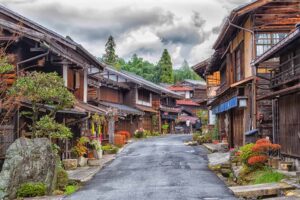
Some of the historic, Edo period houses that line the Nakasendo trail between Magome and Tsumago in Japan.
Why do I love Tsumago with my whole heart?
Because it’s basically like this perfect little, tiny AF village (it’s so small that you can literally walk from one end of town to the other, in about fifteen minutes flat), that feels like a total blast from the past.
And I mean that in the BEST possible way.
Because while you’re here, you’ll find no cars during the day, no phone lines, and no power cables.
You’ll discover a charming, Edo Era village that is overflowing with historic ambiance from the area’s wealth of traditional, dark-wood, lattice-front homes. All of which are particularly amazing at either dusk or dawn.
While you’re here though:
Also, be sure to visit the Tsumago Castle grounds for some amazing views of the city.
The castle itself was actually demolished hundreds of years ago, but the panoramas remain and are truly spectacular to behold.
And while the scenery here is truly next-level amazing:
You just cannot leave without visiting the Kotoku Temple , a traditional Buddhist temple built in 1500, and Wakihonjin, a charming history museum that showcases various artifacts from the area.
But enough about Tsumago’s ambiance already!
Because we need to talk about the REALLY important things in life…like FOOD (glorious food)!,
While I myself am not a meat eater, Tsumago is actually known for a traditional, local delicacy, that is supposedly a “must try” if you’re a real carnivore at heart.
Head on over to Ryokan Fujioto and enjoy some local beef, which is served inside a magnolia leaf and cooked right in front of you, on a table-side, hibachi grill.
Shimosagaya (Budget) – Nestled in the mountains, small, private rooms at this charming Minshuku (AKA family-owned guest house) all start at $63 per night. And while it’s a simple building, accommodations here are comfortable, quiet, and basically all things zen. Guests here can also enjoy some made to order, home-style, Japanese cuisine, as well as access to private, on-site hot springs, making this the perfect retreat for any weary solo traveler.
Hotel Green Plaza Karuizawa (mid-range) – Unlike the budget option above, this hotel has a more contemporary feel about it. It also sits adjacent to a trendy shopping mall and is just a short walk away from Karuizawa Toy Kingdom (A perfect place to visit if you’re missing the distinctly Western vibes of home). Rooms here also have casual decor and include wood-framed beds, as well as a traditional, Japanese-style dining area with tatami mats and short-legged tables. Breakfast and dinner are also included with the price of your room (they start at $168 per night), as is access to the hotel’s free train shuttle, indoor/outdoor bathhouses, a chapel, a tea room, and various on-site restaurants.
8. Hiroshima
Ask nine out of ten people about Hiroshima, and they will immediately think of August 6, 1945; that horrific day when this Japanese city became the site of the world’s very first atomic bomb attack.
In spite of this city’s devastatingly sad past, it has become a vibrant, cosmopolitan place that is brimming over with wonderfully beautiful messages of hope and peace.
As a solo traveler, you should definitely spend at least a few nights here, wandering through the area’s many idyllic, tree-lined boulevards and chatting with some of Hiroshima’s friendly, laid back locals.
No trip to Hiroshima would be complete without a visit to Hiroshima Peace Memorial Park.
It’s a hauntingly beautiful, sprawling green space that is filled with various fountains, statues, memorials, and ruins, all of which stand in memoriam of the 146,000 people who tragically lost their lives on that fateful day.
And of particular note here is Genbaku Dome.
Once the Hiroshima Prefectural Industrial Promotional Hall (originally built in 1914), this abandoned building is now all that remains of the site where the first atomic bomb was dropped.
This edifice stands, exactly as it did after the bombing, as a powerful reminder of the devastating effects of nuclear weapons, and as a symbol of hope for a future that is free of this type of technology.
Hiroshima is also home to several other, slightly less, incredibly heartbreaking attractions, like the Shukkei-en Japanese garden, and Hiroshima Castle , a beautiful, historic fortress that was built in 1590 and that is surrounded by a moat.
And for some of the best eats in the city:
Head down to Hiroshima Station and explore downtown Hiroshima, where you can try everything from okonomiyaki (PSST: Okonomi-mura is the best place in the COUNTRY to try this s avory, Japanese-style pancake) to oysters (Yakigaki-no-hayashi is a great, local seafood restaurant where you enjoy some great udon sets as well as raw oysters) to Gelato (Okay, I know this isn’t a traditional Japanese food, but Polar Bear really is the best place to go for gloriously fresh and delicious gelato).
Hotel S-Plus Hiroshima Peace Park (Budget) – Sitting near the Hiroshima Peace Park, (the clue’s in the name guys!), this well-located hotel has functional, single rooms that come fully equipped with WIFI, a TV, a mini-fridge, and a tea/coffeemaker. Starting at just $31 per night stays here also include a complimentary, continental breakfast, as well as access to, YOU GUESSED IT, a coin-operated laundry facility.
Top Hiroshima Condominium 2 (Mid-Range) – This super snazzy hotel is less than three years old and is a mere 20-minute walk away from Hiroshima Peace Memorial Park (Which is good because the more you walk, the more calories you burn, and then the more you can eat! HOORAY!). Rooms here also start at $130 per night and include a private balcony (For prime city views here people), a queen-sized bed, a sofa, a TV, and a full kitchen, as well as an ensuite bathroom with free toiletries! Yup, nothing but the sweet, sweet, luxe life for me.
9. Kanazawa
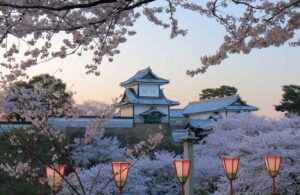
Beautiful Kanazawa Castle in Japan, amidst a sea of cherry blossoms.
Often nicknamed “ little Kyoto” (and for all the right reasons):
Kanazawa is jam-packed full of fun things to do, activities that you can easily add to any, Japan solo travel itinerary.
But, don’t just take my word for it.
I mean, Kanazawa Castle and Kenroku-en Garden alone are considered to be some of the country’s top attractions!
Kanazawa isn’t JUST about iconic castles and ethereal green spaces.
Walk through this city’s various Edo-era districts (like the Higashi Chaya district, which is where you’ll find many historic teahouses with geisha performances) and you’ll discover a multitude of fascinating museums (like the 21st Century Contemporary Art Museum ), ancient Japanese buildings (like Seisenkaku Villa), charming local markets (check out Omicho Ichiba Market , which is just as good as the one in Tokyo, only A LOT less crowded), historic temples (like Ninjadera with all its secret doors and hidden traps), and quaint little handicraft shops.
And while we’re on the subject of markets:
Just around the corner from Omicho is Curio Espresso & Vintage Design , a great little coffee shop that sells fab espresso and delicious sandwiches.
A trip here is absolutely ESSENTIAL to your overall wellbeing and happiness while in Kanazawa.
The owners here are SUPER friendly, and just an overall great source of local information about the city.
Sharin (Budget) – Complete with vintage bicycles out front, Sharin is just a 10-minute walk from Kanazawa Railway Station and offers guests easy access to the 21st Century Museum of Contemporary Art. And while this hotel does have several dormitories for you to stay in, there’s really no need. Because f or a mere $23 per night, you can have your very own, private room, complete with an uber-spacious double bed (Can you say bargain, party of one?). See, dreams really do come true!
Libre Hosai Kanazawa (mid-range) – You want space? Then I’ll give you space! 42m² of space to be exact! Because believe it or not, Libre Hosai Stay Kanazawa lets you rent out an entire apartment for just $132 per night. So, think private shower, a spacious bathtub, and a snazzy AF little kitchenette where you can pretend like you “cook”. Now THAT’S what I call the LUXE life indeed. This place also conveniently located just 800 meters away from Omi-cho Market and Oyama Shrine.
10. Koyasan
Tucked away, to the south of Osaka, is Koyasan, a huge Buddhist temple settlement that lies (both figuratively and literally) at the very heart of Japanese Buddhism.
More commonly known as Mount Kōya:
This small, secluded, temple town was first developed around the Shingon Buddhism headquarters here.
And lest you think I’ve started speaking in tongues:
Shingon Buddhism is actually an important sect of the religion that was first brought to Japan in 805 AD, by Kobo Daish.
You’ll find a wealth of Buddhist temples within this tranquil, heavily forested, mountain town, as well as the site of Kobo Daishi’s mausoleum and the start/endpoint for the Shikoku 88 Temple Pilgrimage.
To really get the most out of your visit, I’d HIGHLY recommend doing an overnight stay in a local, Japanese Temple.
Known in Japan as Shukubo, which literally translates to ‘sleeping with the monks’, this is a fantastic way for any solo traveler out there to really engage with Japanese culture and get an authentic, Japanese Buddhist experience.
Live the dream and feel free to eat, pray, and love your way through the day, just like a local monk.
And if you get a sudden attack of the late-night munchies:
Then stroll on over to Kameya for some udon noodles and seaweed in vinegar.
I pinkie promise, both of these dishes are absolutely TO DIE FOR!
Guesthouse Fuki Juku (Budget) – Honestly, the location of Guesthouse Fuki Juki could not be any better since this place is literally SURROUNDED by local temples! There’s also a traditional Japanese garden on-site, as well as comfortable rooms that include both free Wifi and a delicious, complimentary, American-style breakfast. And while rooms here are a bit sparse (You’ll also have to use a shared bathroom, which I hate), it’s all good when you’re spending just $51 per night.
Yochi-in (Mid-range) – Yochi-in is the perfect place for visitors to engage in various, temple-related activities like meditation, morning prayers, sutra copying, and tracing of Buddhist deities. All Japanese-style rooms here also start at $143 per night and feature tatami (woven-straw) floors, futon bedding, a TV, fan, and heater. And while bathrooms are shared with other guests, the hotel’s central location more than makes up for this fact since this place is within easy walking distance of both Koyasan Reihokan Museum and Koyasan Choishimichi ( two must-see attractions while you’re in the area). Plus, their on-site restaurant really is the very definition of amazing.
A 7 Day, Japan Solo Travel Itinerary!
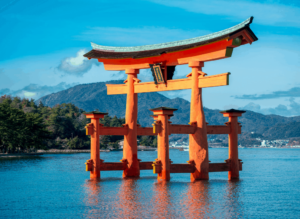
Use this 7 day Japan itinerary to explore some of Japan’s top attractions, like the Itsukushima Shrine pictured here.
So, per usual, I’m just gonna start by being totally honest here.
And honestly:
There is just no way in HELL that you’ll be able to see all of Japan in 7 days.
Yeah. Sorry, but it’s just not possible.
At least, not without totally burning yourself out or getting approximately NO sleep.
But, t hat being said:
Thanks to Japan’s nifty railway system/JR pass, there are still LOADS of different places that you can see during a 7 day Japan itinerary.
If you’re down and r eady to get started, then let’s start with the bustling city life of Japan’s one and only…Tokyo!
Toyko (3 Nights)
Day 1 – west tokyo.
I would recommend spending at least 4 nights in Tokyo, just so that you can really experience everything this city has to offer.
Remember before when I said that Tokyo was HUGE?
Well, I was NOT lying.
Which is why 4 days in Tokyo is definitely ideal.
But, if you’re short on time:
Then two days is still a decent amount of time to spend in this city and it will help you get a feel for this amazing place.
To start your whirlwind trip through Tokyo, head to the famous Shibuya district.
Because once you’re here:
You’ll be able to cross the street, just outside of Shibuya Station, at one of the busiest intersections in the WORLD!
It’s beyond chaotic and crazy, but it’s also definitely all things Tokyo.
While you’re here, do try and visit some of the insanely quirky shops that can be found in this area.
A trip to the vibrant Harajuku neighborhood, which is brimming over with colorful street art, quirky vintage clothing stores, young people who are wearing only the FUNKIEST of fashions, and fun cosplay shops along Takeshita Street .
And while there are a ton of different things to see and do here:
No trip to Harajuku would be complete without stopping for a giant cotton candy at Totti Candy Factory and visiting the world-famous, Meiji Shrine.
Don’t forget to do as the locals do and snap some pics in a local ‘Purikura. AKA, a popular Japanese-style photo booth where you can take photos, decorate them as you like, and then print them off on sticker paper.
You should also probably stop by Kawaii Monster Café while you’re here, which is a wonderfully weird, themed cafe that features colorful, themed rooms, casual eats, fun cocktails, and regular, live performances.
Head back to the Metropolitan Government Building for an amazing FREE view of the city, but not before stopping at Ramen Road for a quick dinner.
Then finally:
Finish your evening off with a trip to Park Hyatt Tokyo, where you can create your very own ‘Lost in Translation’ moment.
You can always skip the serenity of the park and just straight up, live la vida loca at ’ Timeout ’ instead; a jazz/blues bar where the music never really stops.
Because once the live music ends, that’s when the karaoke begins…
Day 2 – East Tokyo
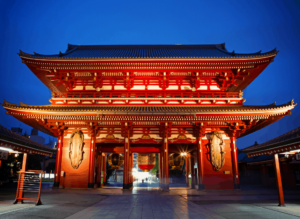
On day two, you’ll see the more traditional side of Tokyo and visit Sensoji Temple, an ancient Buddhist temple in Asakusa.
We want ultra-modern yesterday.
Let’s switch things up and go a bit more traditional today.
And the best place to do that?
Why East Tokyo of course! It’s a bit more historic and slightly less chaotic than the other side of the city.
Once you’re here, feel free to explore top, Tokyo attractions like Sensoji Temple (it’s the super famous, ancient Buddhist temple in Asakusa), Tsukiji (there’s even a viewing area here for the popular tuna auction. LOL) and Toyosu Fish Markets and Ueno Park ’ s Museum District.
Now, once you’ve done ALL OF THAT:
Finish the day off on a more modern note in Akihabara, a Tokyo neighborhood that is known for its plethora of awesome arcade games.
You can also get some rather delicious ramen here, and enjoy some gorgeous, panoramic views from atop Tokyo Sky Tree (and sorry, but the views here are VERY un-free).
Day 3- Tokyo Day Trip To Mount Fuji or DisneySea
Today there are two different options available to you, depending on what you’re into.
Take a train from Tokyo Station to Hakone, for some beyond STELLAR views of Mount Fiji (The awesomeness of the views largely depends on the weather, so make sure that you visit on a nice, clear day).
Along the way:
You should also visit the exquisite floating torii gate at Hakone shrine, explore the many walking trails here, and indulge your inner Jack Sparrow with a boat ride across the lake.
You could always go for option two and check out the iconic, DisneySea theme park ,
BEFORE you start violently screaming at me and throwing your laptop across the room in disgust, hear me out.
Because in truth:
DisneySea isn’t just ANY theme park. It’s actually one of the most lavish theme parks in the entire world.
Which is why it’s a super fun, super safe place for solo travelers to go.
It’s also strangely Japanese, making it at least a mildly cultural experience.
Locals adore it. Like, it’s a national treasure level adore it.
A day spent here will not only elevate your inner child to near euphoric states of happiness, but you’ll also get to experience a more modern side of Japanese culture.
Which is a total win-win, at least in my humble opinion.
***For the love of God and all that is HOLY, if you do decide to visit DisneySea, then do yourself a favor and PLEASE BUY YOUR TICKETS IN ADVANCE ! LIKE RIGHT NOW! Trust me on this. You do not want to get there, just to spend hours waiting in line for a ticket. This is a very un-fun way to solo travel Japan.***
Kyoto (3 Nights)
Day 4 – kyoto.
Is riding in a bullet train on your Japan bucket list?
Then prepare to tick that item right off your list. Because you’re about to jump aboard the Shinkansen and travel all the way to Kyoto.
If you can:
Try and catch an early morning train since the trip will take around two hours.
AND REMEMBER:
Be sure to sit on the right side of the train so that you can get that iconic shot of Mount Fiji!
While you may be tempted to rest after your early morning train ride, let’s be honest here.
You really DON’T have time for that.
So, embrace the mildly exhausted explorer within and get out there!
If you’re not exactly sure where to start, then you can always try a walking tour , which is a great way to quickly and easily experience all that Kyoto has to offer..
If walking tours are SOOO NOT your thing, then you can always visit Nijo Castle and Kyoto Imperial Palace instead, both of which are incredibly impressive attractions(to say the very least).
And if you’re hungry:
Be sure to stop by both Nishiki Market and Pontocho Alley for some of the best food in the city.
Whatever you do though:
Do not leave without devouring an uber-yummy, ‘okonomiyaki’ pancake!
NOM, NOM, NOM.
Day 5 – East Kyoto
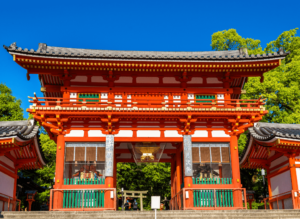
Beautiful Yasaka Shrine in Kyoto, Japan.
Like with Tokyo:
You could easily spend more than 3 days in Kyoto as you solo travel Japan.
With this Japan 7 day itinerary, you’ll easily be able to see most of Kyoto’s top attractions.
Start your day off right, with a visit to some of the city’s most spectacular shrines.
And while Yasaka Shrine and Maruyama Park are ALWAYS beautiful, they are exceptionally stunning during cherry blossom season and autumn, when you have the vibrant, fall foliage in the background.
You can always embrace your inner tourist instead (make sure to have those selfie sticks and fanny packs handy) and follow the popular “temple route” through Kyoto.
This path starts at Kiyomizudera Templ e , follows a GIANT, straight-line through the foothills of Kyoto’s Higashiyama Mountains, and takes you to some of the most stunning temples in the area .
And once you’re totally templed out:
Head to Kyoto’s Gion district for some evening Geisha spotting (PSST: Kyoto also has a seriously awesome night walk through picturesque Gion, Kyoto’s geisha district. But the best part? This tour costs only $12 per person! Yup, money well spent as you learn all about kimonos and the unique history of geishas)!
You could even p artake in a traditional tea ceremony or have dinner at Sukemasa, which is known for serving some of the BEST gyozas in Japan!
Day 6 – Kyoto West
It’s time to head west and visit the city’s famous Arashiyama and Sagano districts.
And I know it sounds totally weird:
But, you MUST start your day with a 7-Eleven egg breakfast sandwich.
Because yes:
They really are THAT good!
Once the HANGRY beast within is properly satiated:
Head to the Arashiyama Monkey Forest.
You REALLY will want to get here EXTRA early, just to avoid the crowds.
Because this ultra-famous bamboo grove really is a total tourist hotspot.
But, if you’re someone who is prone to crowd phobia:
Then you can always visit Okochi Sanso Villa and Jojakkoji Temple instead, both of which are great off-the-beaten-path attractions.
If this is your first solo trip to Japan, then you may want to stick with some of the area’s more well-known attractions.
End your day at Fushimi Inari Shrine, which features over 4 kilometers of winding walking paths that are filled with quaint AF torii gates.
This is definitely one of Japan’s most popular attractions (AKA crowded as hell), but so beautiful and totally worth a visit.
Try and arrive around dusk so that you can experience the beautiful sunset amidst slightly less enormous hordes of tourists.
Day 7 – Leave Kyoto and Head Home
I f you can afford it:
Save yourself some time and fly home from Kansai International Airport in Osaka and not Narita or Haneda in Tokyo.
This airport is infinitely closer to you and will help you maximize your short time in Japan.
If this option isn’t cost-effective, then you can always explore the local food and shopping scene right around Osaka Station, before boarding your train to Tokyo
The train ride takes AT LEAST two and a half hours.
And once you do arrive in Tokyo:
You’ll want to give yourself plenty of time since it will take you about an hour to get from the train station to Narita Airport when using the Narita Express (tickets also cost about $36 per person).
Conversely:
If you’re flying out of Haneda Airport, you could always take the Keihin-Tōhoku Line of the subway, towards Kamata, and then transfer to the Airport Monorail at Hamamatsuchō Station.
It should take you about thirty minutes to get from Tokyo Station to Haneda Airport.
And there you have it!
You have just concluded your awesome, chaotic, whirlwind, once-in-a-lifetime trip to Japan.
BRAVO (insert copious amounts of jazz hands here)!
AND NOW…SOME FINAL THOUGHTS ON SOLO TRAVEL IN JAPAN (JERRY SPRINGER, EAT YOUR HEART OUT!)
So while this Japan solo travel guide is basically OVER, there are just a few more things I want to remind you of, before we say a fond farewell.
First rule of Japan solo travel? Always book your hotels WELL IN ADVANCE since accommodations tend to fill up CRAZY QUICKLY!
Do NOT, I repeat, DO NOT wait until the last minute to book all of your hotels.I know you may think that you’ll score some wicked awesome, last-minute hotel deals.
But I promise you won’t. In fact:
Do this and you’ll have a hard time finding ANYWHERE to stay. Like at all. Especially during peak travel seasons.
Okay, now it’s time for some good news!
Because SURPRISE! The power outlets in Japan are EXACTLY the same as the ones in North America.
No need to add any annoying power adapters to your Japan packing list!
Oh, and if you’re a theme park addict, you’ll definitely want to book your tickets to Disneyland Tokyo and Universal Studios (featuring the Wizarding World of Harry Potter, for all my fellow Potterheads out there!), WELL in advance.
You’ll also want to do a bit of research and look at some crowd calendars on Google, just to figure out what time and day to visit (And since you’re alone, feel free to skip all of those ridiculously long lines and just hop on the single rider line instead).
Alright cool kids:
That’s enough from me! I am so blowing this popsicle stand of solo travel awesome.
In all seriousness, that really is all she wrote!
So, until next time:
Continue to live the solo travel dream like the TOTAL rockstar that I know you are!
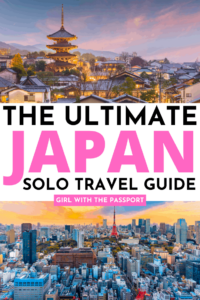
Micamyx|Senyorita
Saturday 11th of January 2020
Solo Travelers who will come across this post are lucky! So comprehensive!
I've been to Japan twice - Tokyo in 2014 to visit my best friend who was based there at that time and Nagoya side in 2015. I plan to go back this year to do a bit of solo backpacking. This is a good guide. Cheers!
girlwiththepassport
Monday 13th of January 2020
Thanks so much for reading Mica and have an AMAZING trip!
Just waiting for the Olympics year to end so I can visit Japan! Super handy and detailed post and as always I love your small details! Super curious to try out these black eggs for which I had never heard anything!!
YES! When you get to Hakone give them a try and let me know what you think. Thanks for reading!
This was so helpful + informative! I’m planning to visit Japan solo soon so this was amazing to read!
So happy to hear that and thank you so much for reading!
Privacy Overview

Home » Travel » Destinations » Traveling to Japan Alone: What You Need to Know
Traveling to Japan Alone: What You Need to Know
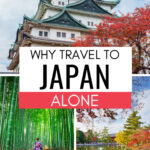
When it comes to solo travel, I can’t think of a better country than Japan. Efficient public transit, English signage, and a customer service-oriented culture make traveling to Japan alone a breeze.
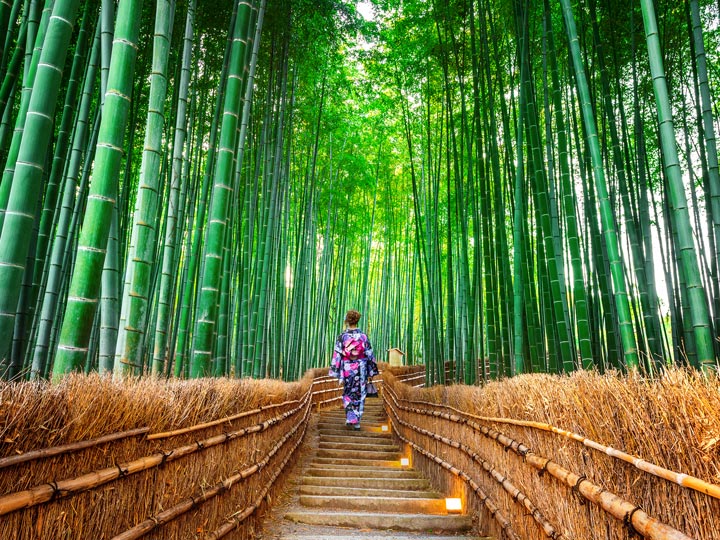
In fact, my very first solo trip was a week in Japan. I wandered the bustling streets of Tokyo, hiked mountains, and marvelled at famous castles. And not once did I ever feel afraid or unsafe. Except for the time I thought I heard a bear in the forest, but it turned out to be a falling tree…
Although the language barrier and cultural differences may seem intimidating, a little advanced research goes a long way. Read on for my best tips to have an amazing solo trip to Japan.
Japan Solo Travel Guide
Why should you travel to japan alone, is traveling to japan alone safe, the best places for a japan solo travel itinerary, where to stay as a solo traveler in japan, the best places to eat alone in japan, other tips for traveling solo to japan.
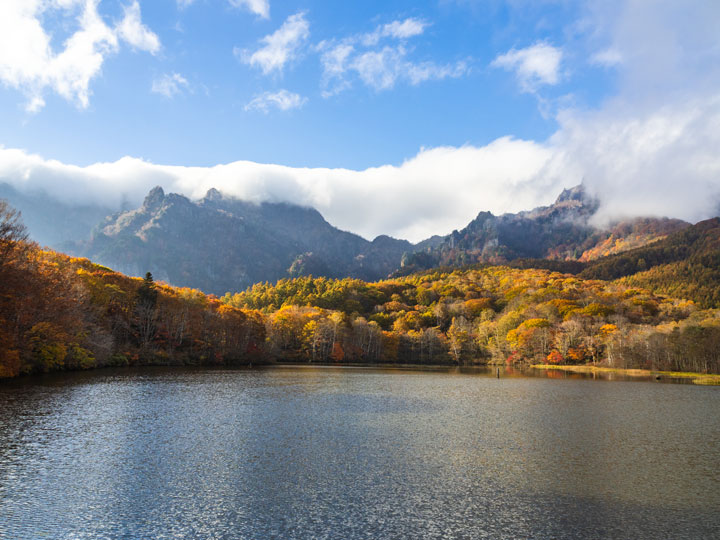
Traveling solo in Japan allows you to savor the sights (and food) at your own pace. Had I been traveling Nagano with my husband, I would have felt guilty about the amount of time I spent staring at trees and taking photos. In a country renowned for zen gardens, religious sites, and delicious food, you’ll have plenty of reasons to slow down and truly enjoy the experience.
Also, there are tons of famous things to do in Japan . If this is your only chance to visit, you’ll want to see as many places on your bucket list as possible. It’s a bit selfish, but when you’re dropping thousands of dollars on a plane ticket and other travel expenses, you’ll want every moment to count.
Now to be candid, I am a Japan-loving introvert who has no problem eating alone or getting around unfamiliar places. A solo Japan vacation is basically my dream travel scenario.
If this doesn’t sound like you, that’s okay! There are plenty of ways to love traveling alone in Japan, even if you’re a gregarious person who feels awkward at a table for one.
If you’re worried about feeling lonely or isolated, you can easily add a local tour to your travel plans . Tours are extremely popular in Japan, and if you book an English language one, you’re sure to meet a few potential travel buddies (or at least give your brain a rest from speaking broken Japanese).
Many solo travelers also choose to stay in hostels, where they can meet people in the dorms and common spaces.
Important things to do before your Japan trip
From packing the right clothes to brushing up on etiquette, there’s a lot to do before traveling to Japan. Use this epic Japan travel checklist to ensure you don’t forget anything before your trip!
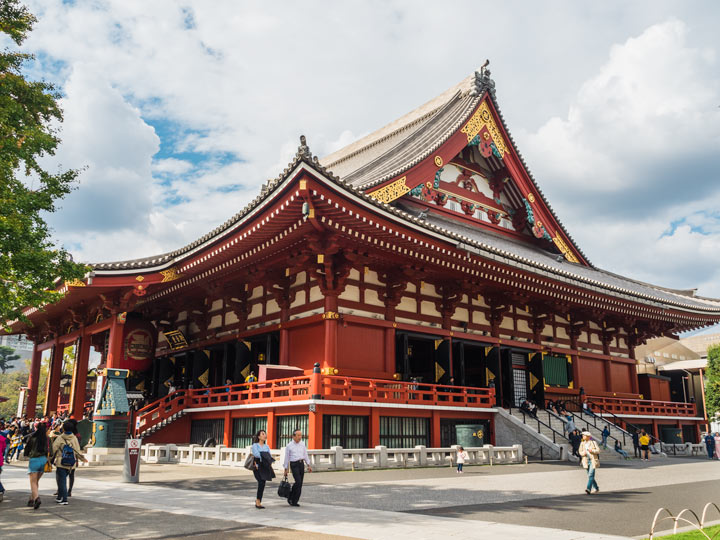
Japan has a reputation for being one of the world’s safest countries. It’s a place where lost wallets are more likely to end up returned than stolen. Frankly, I was more worried about a natural disaster or bear attack than pickpockets or violent crime.
That being said, you should always keep your wits about you and take precautions when traveling alone in Japan or any country for that matter. This is especially true in Tokyo’s entertainment districts.
Wards like Shinjuku and Roppongi are known for their bars and clubs. While these places are pretty safe, the danger lies in being scammed by expensive cover charges. It’s best to avoid establishments where an English-speaking person stands outside to drum up business.
Also, Japan takes laws and rules seriously. While you won’t be caned in the street for chewing gum, things like smoking in public, fare-dodging, and littering can earn you a fine.
Read this post on things to avoid in Japan while traveling , use common sense, and you’ll be okay.
For a directory of important phone numbers and social media accounts for travel and weather alerts, check out the JNTO website .
Do I need travel insurance in Japan?
Whether you’re going to Japan alone or with a group, I always recommend buying travel insurance.
You probably spent thousands of dollars planning the perfect trip. But it only takes one injury, family emergency, or cancelled flight to derail your vacation (and your bank account).
I use World Nomads to protect my international trips. Their affordable policies cover everything from emergency medical care to lost luggage, and their claims team is available 24/7 to help in your moment of need.
Request a quote today and enjoy the peace of mind.
Is Japan safe for solo female travelers?
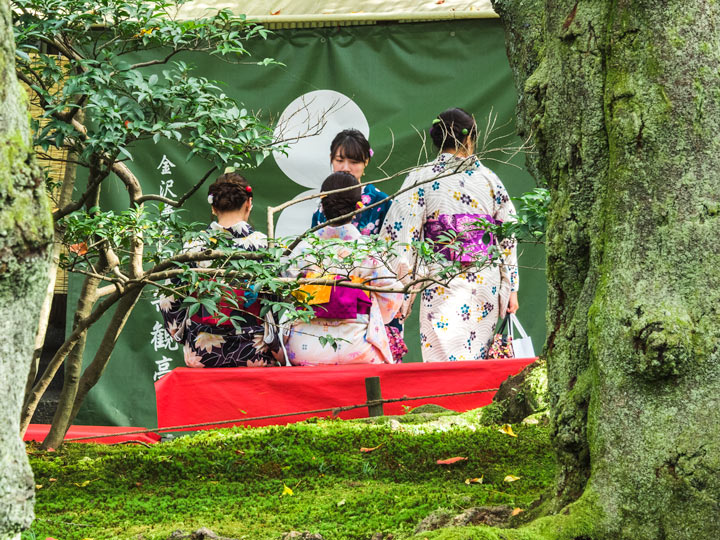
If you’ve read anything about Japan travel safety, you’ve undoubtedly come across some unpleasant stories. Women–especially white foreigners–have been groped, harassed, or even followed around by Japanese men.
Just like any other country, women are subject to predatory behavior when traveling alone. Thankfully, I never experienced or witnessed anything untoward during my trips. However, it’s important to be vigilant, and to be aware of your options as a female traveler in Japan.
Many of Tokyo’s subway lines have women-only carriages , which are covered in pink decals. The platform may also have a pink painted sign to indicate where the car will stop, though the carriages may admit men at non-peak travel times. There are also “ladies seats” on night buses linking popular cities like Tokyo and Kyoto.
Major cities also offer female-only accommodation, like the sleek Akihabara Bay Hotel in Tokyo or the charming CAFETEL Kyoto Sanjo hostel.
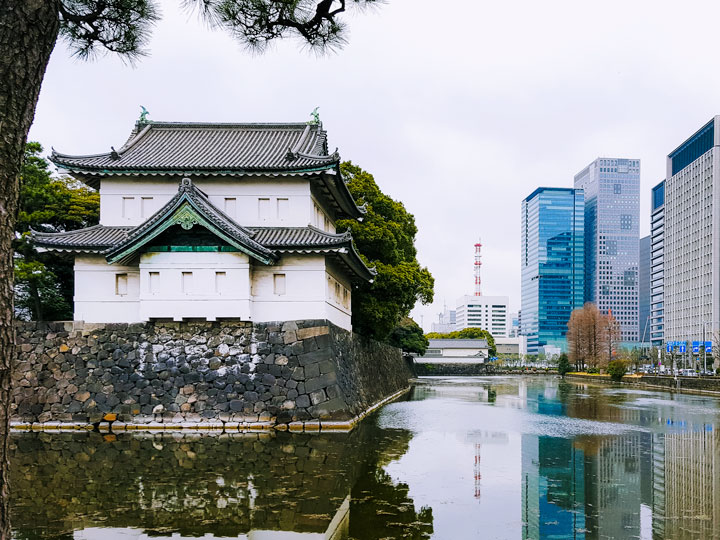
You could spend your entire solo Japan trip in Tokyo and never get bored. Between the iconic temples and shrines, boisterous arcades, world-class museums, and quirky shops, you’ll have plenty of ways to fill your time.
Tokyo is also very well-connected to the rest of Japan via public transit and the shinkansen (bullet train) lines, opening up hundreds of day trip opportunities .
Use this 6 day Tokyo itinerary to help plan your trip!
Nagano Prefecture
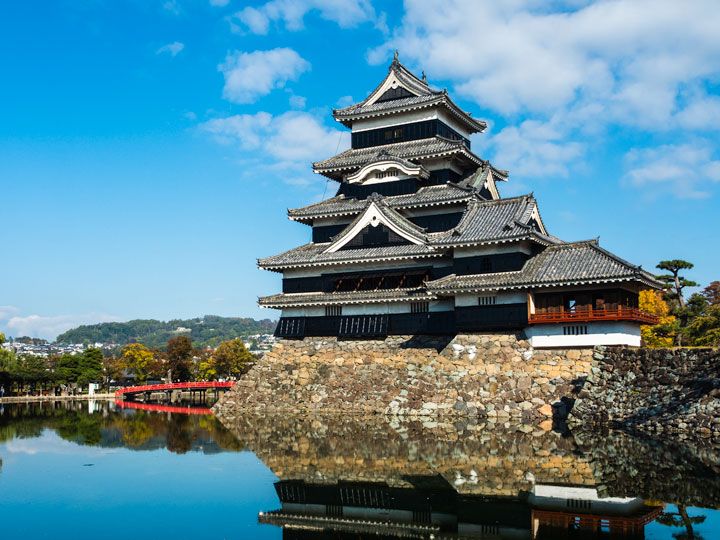
In stark contrast to the bustling metropolis of Tokyo, Nagano prefecture is known for its natural beauty. Gorgeous Kamikochi hiking trails , snow monkey hot springs, and Karuizawa waterfalls draw travelers from around the world.
And luckily, the best things to do in Nagano are readily accessible by public transit, including Matsumoto Castle.
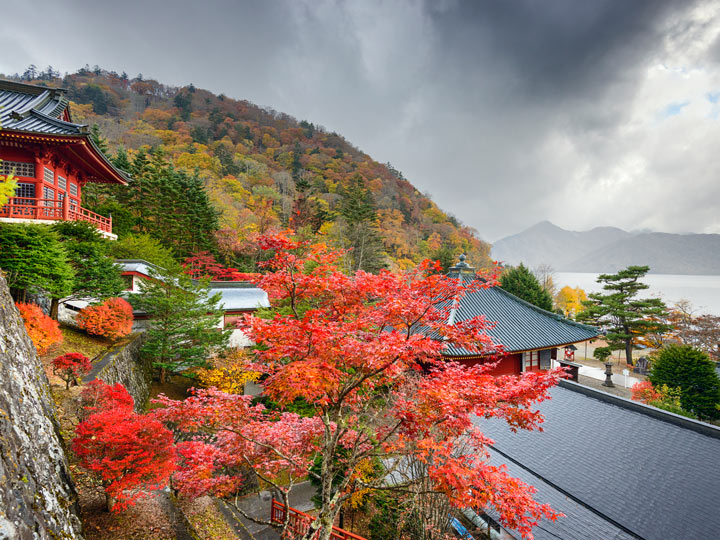
Nesteld in a forested mountain region, Nikko is a must see for nature lovers and fans of Japanese architecture. Nikko is most famous thanks to Toshogu Shrine, the stunning site where shogunate leader Tokugawa Ieyasu is entombed.
It’s also a popular place to visit in Japan in October , when the gardens and surrounding forest take on hues of red and gold.
Don’t Forget Your Japan Rail Pass!
Buying a Japan Rail Pass will save you a ton of time and money when traveling across Japan.
I’ve purchased a JR pass for two out of three Japan trips, and here’s why:
– Free bullet trains and reservations : Quickly travel all over Japan to maximize vacation time.
– Easy to use: Just show your pass to the gate attendant and walk to your train!
– Affordable day trips: Visit popular places like Nagoya, Kanazawa, and more without spending a fortune on tickets.
Order your Japan Rail Pass now for speedy delivery!
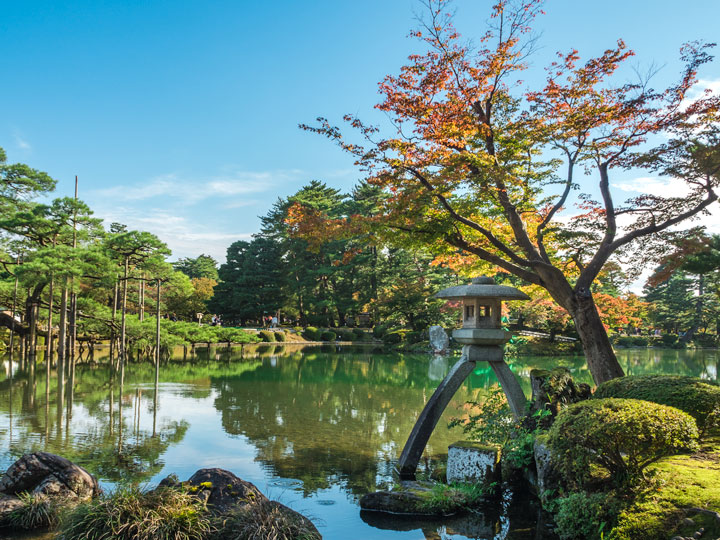
If you want to explore a beautiful town with a history of samurai and ninjas, this Kanazawa itinerary is for you.
Many of the city’s Edo-period districts escaped destruction from war and natural disasters, and their characteristic wooden facades and tiled roofs draw hundreds of thousands of visitors each year. Kanazawa is also home to an impressive castle, as well as one of the “Three Great Gardens” of Japan.
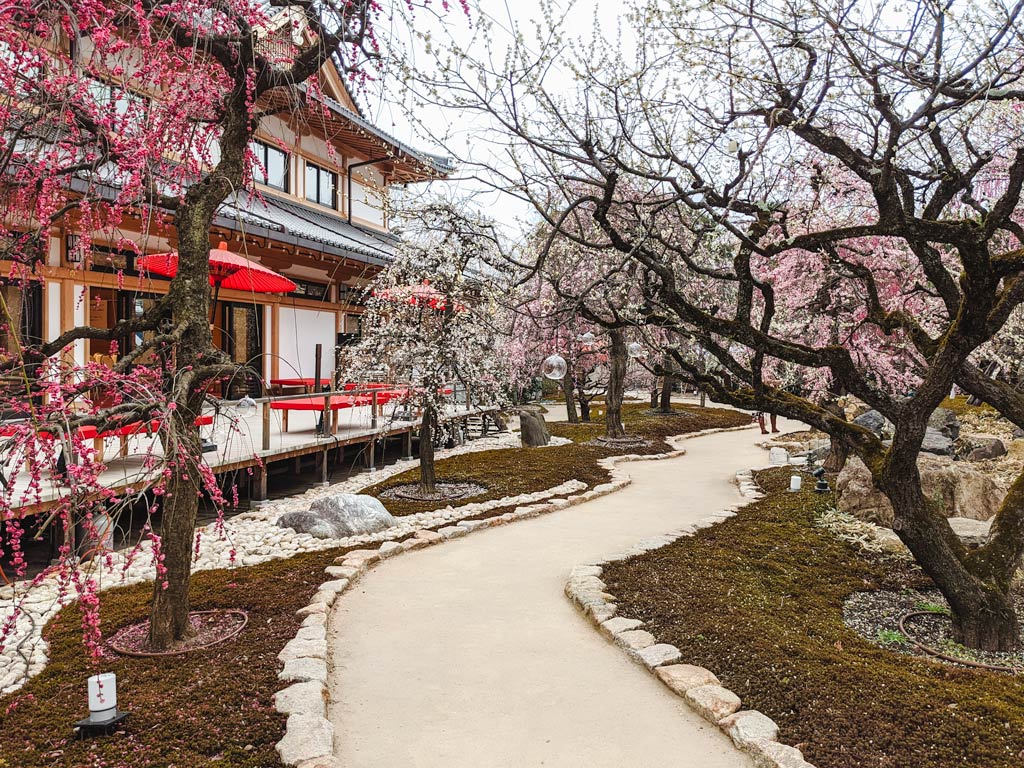
Golden shrines, magical bamboo forests, elegant geisha… It’s no wonder that Kyoto tops many travelers’ bucket lists. Like Tokyo, you could easily stay in Kyoto the entire time and not see everything you wanted, especially with all the nearby day trips .
The Sagano Bamboo Forest, Philosopher’s Path, and Mount Hiei shrines are particularly suited for solo Japan travel.
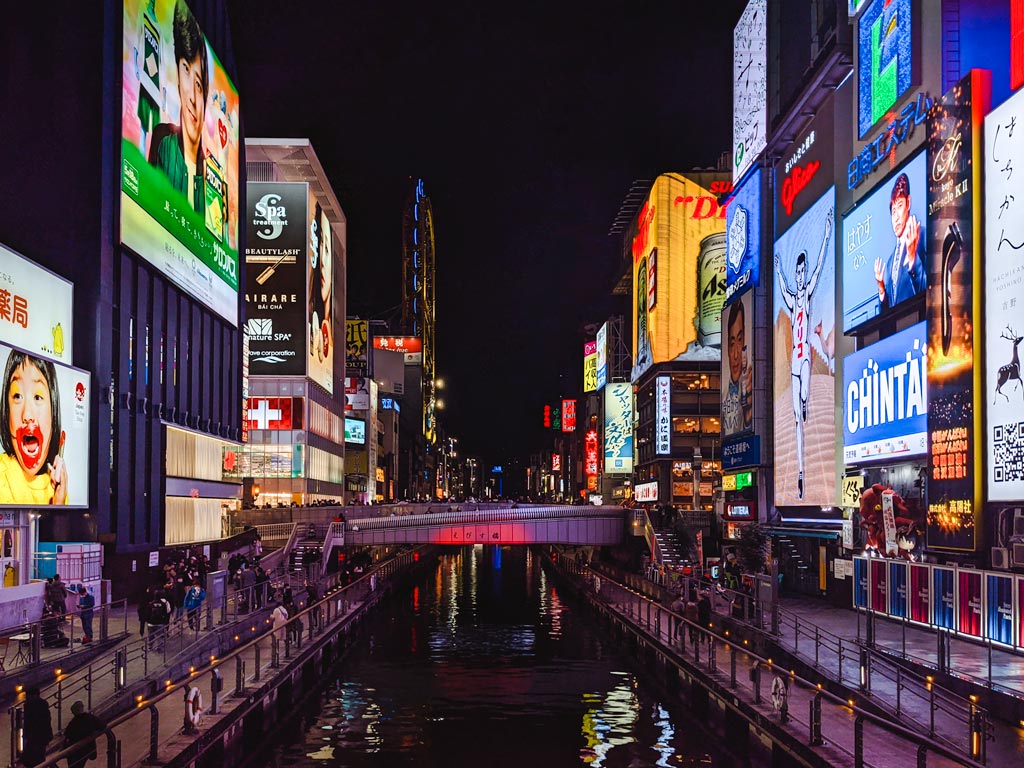
I had a wonderful solo trip to Osaka, Nara, and Kyoto shortly after publishing this post. I spent my time eating street food in Dotonbori, window shopping in Shinsaibashi, and marveling at Osaka Castle.
Aside from its foodie reputation, Osaka is known for its Instagrammable streets and vibrant nightlife.
Kumano Kodo
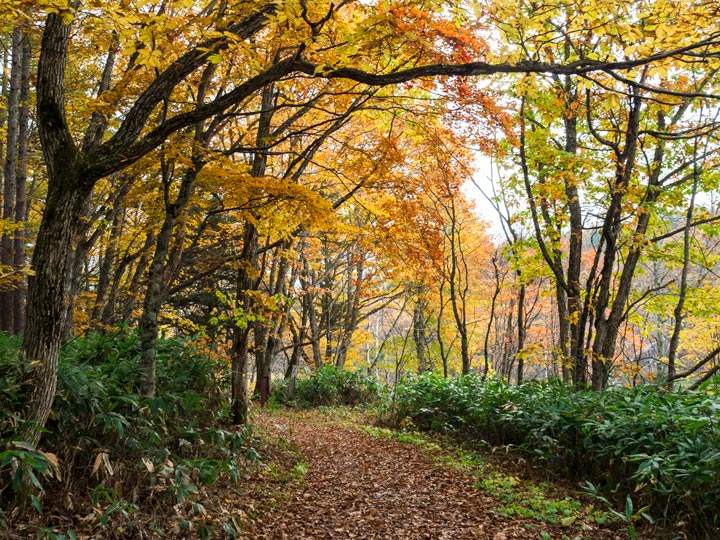
Wakayama prefecture is home to seven ancient pilgrimage routes known as the Kumano Kodo . These serene trails run through forests, mountains, and valleys, linking the sacred Kumano Sanzen Shrines. Many travelers choose to stay in minshuku– small family-run B&Bs–as they journey to complete the main Nakahechi trail, which takes 4-5 days.
Check out these 5 day Japan itineraries and my alternative 10 day Japan itinerary for more travel ideas!
Save me for later!

From capsule hotels to traditional inns, Japan has a wide range of accommodations for every budget and travel style. If you’re traveling to Japan alone, here are the main types to consider:
- Check out the Sogihostel Beehive in Tokyo, or the female-only CAFETEL Kyoto Sanjo .
- I can personally recommend the Tokyu Stay Shinjuku , which offers both business-sized and normal-sized rooms in a super convenient location.
- Book at the Capsule Hotel Transit Shinjuku or Astil Dotonbori in Osaka for a truly unique sleeping experience.
- I highly suggest booking in at Kyoto’s Yuzuya Ryokan for at least one night. It’s a beautiful inn with yuzu (Japanese lemon) infused in everything from the hand soap to breakfast.
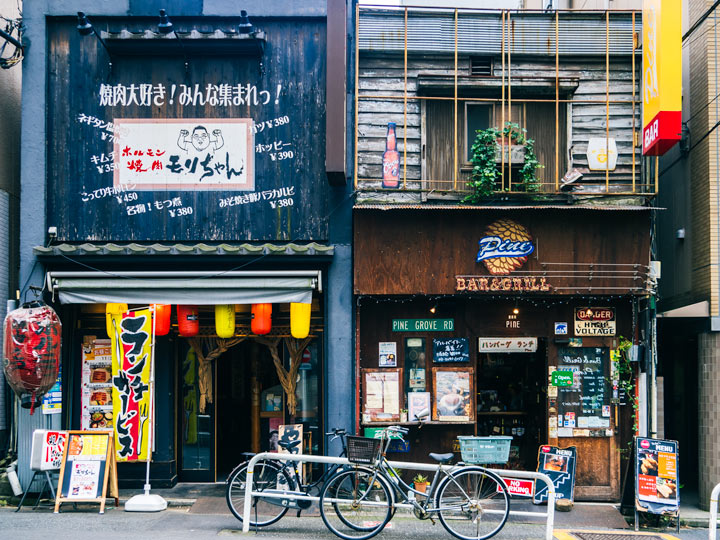
Frankly, there is no reason to feel uncomfortable with solo dining in Japan. Due to hectic work schedules and frequent business travelers passing through the country, it’s not uncommon to see people eating alone in Japan. There are at least a dozen must eat foods in Japan , so get out there and try them!
However, there are a few places that are particularly well-suited to dining alone.
Ramen shops
Japan has an abundance of ramen shops where you can get a filling meal for 500-1,000 yen (about $5-10). They are designed for quick turnover, with counter-style seating or even cubicle-style seating (like the famous Ichiran chain).
Many ramen shops have a pre-order system to speed things up futher. You punch your order into a machine (or sometimes fill out a card), and put it on the counter for the chef to read.
Sushi restaurants
All sushi restaurants have counter service, where you can watch the chefs meticulously prepare each dish. Higher-end sushi places often consist of only a counter with seating for 7-15 people, making for an intimate experience.
For a fun and more budget-friendly option, look for conveyor belt sushi ( kaitenzushi). Here, diners can grab whatever dishes they want off of a conveyor belt that runs in front of each seat. Dishes are usually color-coded to indicate the price tier (ex. green = 300 yen, red = 500 yen), and when you’re finished, a server will add up your plates for the bill.
During my solo trip to Japan, I mainly subsisted on konbini– convenience store–food. It sounds unappealing, but Japan’s konbini are actually famous for their food quality.
Stores like Lawson, Family Mart, and 7-Eleven can be found on every corner in big cities, and they sell everything from fried chicken ( karaage) to fresh salads. I’m particularly fond of onigiri: portable rice balls wrapped in nori and stuffed with foods like salmon or pickled plum.
Train Stations
Another seemingly odd choice for food, but popular nonetheless! Most train stations have takeaway food stalls, and larger ones will have cafes, sit-down restaurants, and even grocery stores.
Although you aren’t supposed to eat or drink on local public transit, you can have food on the shinkansen . Any train station on a shinkansen line will have kiosks selling ekibento (literally “trainbento”), a portioned tray containing a main dish and a few sides. After a long day of sightseeing, I will often grab an ekibento and bring it back to my hotel room rather than go out to a restaurant.
Fast casual restaurants
If you want to grab a quick meal surrounded by locals, there are numerous fast casual restaurants with locations throughout Japan. Sukiya and Yoshinoya are the most abundant, and specialize in gyudon (beef and rice bowls). Freshness Burger is popular in cities and has both meat and veggie options.
My personal favorite is Coco Ichibanya , a curry shop with over 1,000 restaurants across Japan. They have English menus, vegetarian items, and lots of ways to customize your order. My mouth is already watering just thinking about their tonkatsu curry…
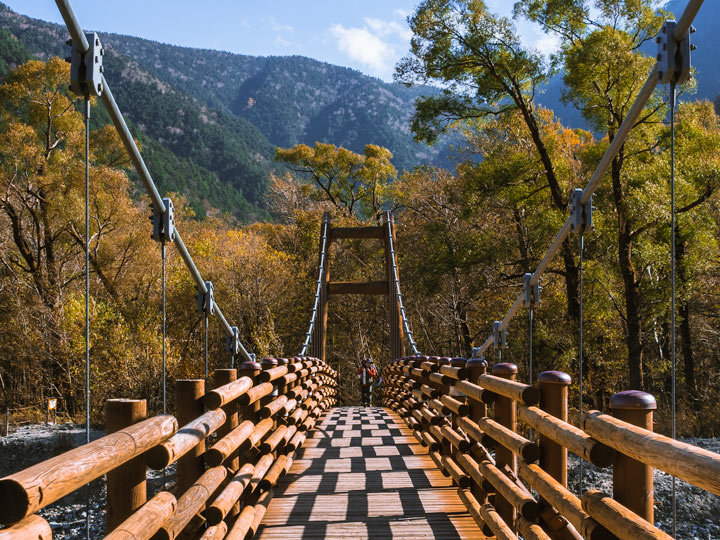
Learn basic Japanese phrases
I’m a big believer in learning basic travel phrases before going abroad. It’s not only helpful, but also an act of courtesy and respect to say “hello” and “thank you” in people’s native language.
While it’s fairly easy to get around in Japan’s major cities with English, it becomes more difficult the farther you go into the countryside. Here are a few phrases you should learn before traveling to Japan alone:
- Hello – Konnichiwa (cone-nee-chi-wa)
- Good morning – Ohayo (oh-high-yo)
- Good evening – Konbanwa (cone-ban-wa)
- Yes – Hai (hi)
- No – Iie ( ee-eh )
- Excuse Me – Sumimasen (su-me-mah-sen)
- Thank you – Arigatou Gozaimasu (a-ree-ga-toe go-zeye-mus)
- Do you understand English? – Eigo ga hanasemasu ka? (ay-go gah ha-nah-say-mas kah)
- Sorry, I don’t understand – Sumimasen, wakarimasen. (sue-me-mah-sen, wah-kah-ree-mah-sen)
- (I’d like) this, please – Kore o kudasai (koh-reh oh koo-dah-sigh)
- Can I have the bill, please? – Okanjo o onegaishimasu (oh-kahn-jo oh oh-neh-guy-she-mas)
Pick up a great Japan travel book
The internet is awesome, but there’s something special about having a physical guide when planning a trip to Japan. These ones have stayed with me through multiple cross-country and trans-Atlantic moves, because I refer to them over and over again:
- Lonely Planet Japan
- Cool Japan Guide: Fun in the Land of Manga, Lucky Cats and Ramen
- Super Cheap Japan: Budget Travel in Tokyo, Kyoto, Osaka, Nara, Hiroshima and Surrounding Areas
Bring a coin purse
Cash is still king in Japan, and not carrying local currency is one of the worst international travel mistakes you can make. Yen coins go all the way up to 500 (~5 USD) before switching to bills, so you’ll want something to carry all that change.
This combo passport wallet and coin holder is a great option.
Get some rest on the flight
Odds are that your flight to Japan will be one of the longest of your life. It’s critical that you get decent sleep on the plane, or your first few days will have you feeling like an extra from The Walking Dead.
Buy yourself a good neck pillow , a sleep mask , and a comfy plane outfit to make it easier to doze off. And aim for a window seat at least four rows away from a bathroom (loud flushes can wake anyone up from a dead sleep).
Check out my detailed guide on surviving long flights in economy for more tips and tricks.
Step out of your comfort zone
I might sound confident, but I dealt with my fair share of discomfort and fear when traveling alone in Japan. In fact, I sat in my hotel room for an hour debating whether or not I should go through with my day trip to Kamikochi. I nearly missed the bus there because I was afraid of missing the bus back home (oh, the irony)!
You’re sure to encounter unfamiliar customs, confusing signs, and stressful situations. But instead of avoiding these scenarios, I encourage you to embrace them.
Have lunch in a cafe without an English menu. Take two trains and a bus to see an amazing waterfall. Come back with stories to tell, instead of regrets about missed opportunities.
Leave a Comment Cancel reply
This site uses Akismet to reduce spam. Learn how your comment data is processed .
The Solo Female Traveler’s Guide to Japan
08/25/2023 by Kristin Addis Leave a Comment
Japan has long intrigued travelers with its unique culture, delicious and healthy food, beautiful countryside, and fascinating capital city, full of technological wonders. It’s easy to see why people adore it.
For the solo traveler, Japan may not immediately come to mind as a great choice. It’s true that the country’s language and cultural differences may take a little getting used to, but after traveling to Japan, I feel that it’s perfect for solo female travelers. Here’s why:
Table of Contents
Solo Travel Safety
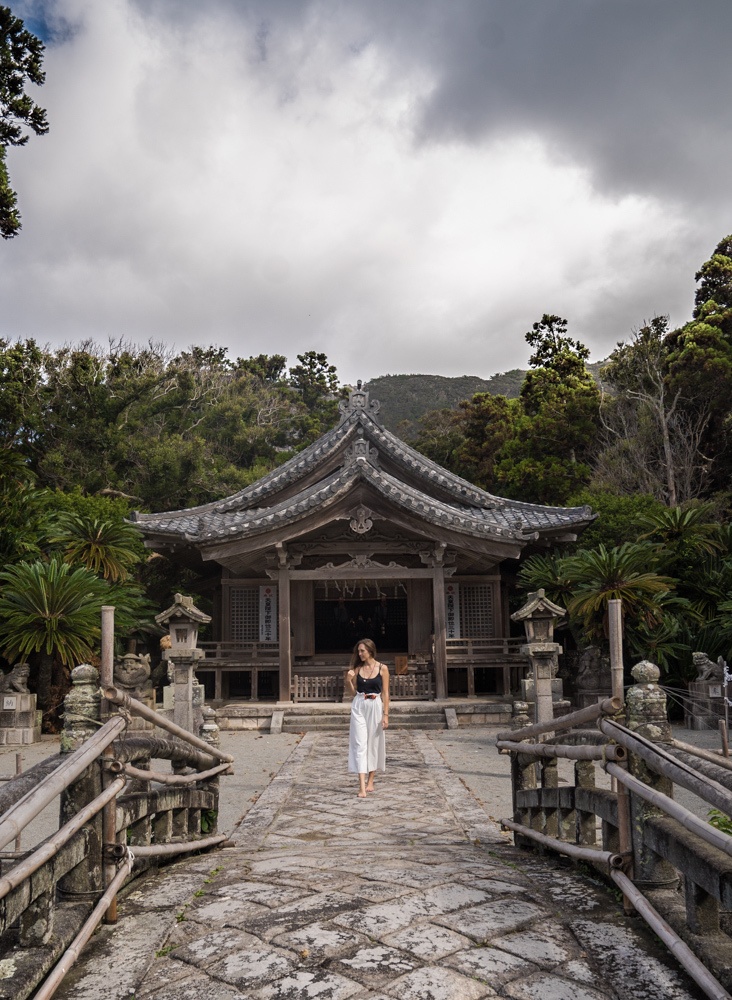
Japan is safe according to the Global Peace Index, which ranked Japan as the ninth most peaceful country in the world based on violent crime, safety and security, and other peace factors. You may even notice Japanese people saving seats at restaurants by placing their wallets on the table. Talk about trust!
That said, solo travelers should be aware of sexual harassment in Japan. While I haven’t had any issues, it’s worth noting that some big cities offer women-only subway cars as a result. Although this may not be the perfect solution, it gives you the option to be on the cautionary side.
Solo Traveler Friendliness
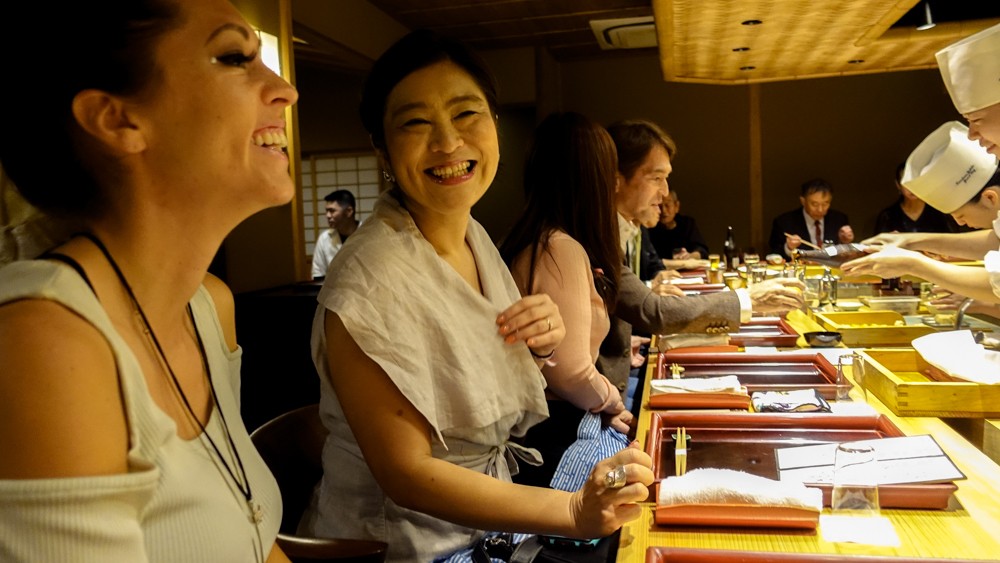
Hospitality in Japan is so strong that they even have a term for it: omotenashi . Even when I had trouble navigating big cities like Tokyo, people were helpful and kind. That said, there are language barriers.
While learning a few words in the local language always go a long way, I find that Google Translate is often my friend. There’s also so much that context can lend to a situation. Thankfully, many accommodation options in Japan offer Mi-Fis so that you can navigate more easily, though it might also be a good idea to grab a business card for your hotel in case you get lost.
Without a good grasp of the language, you can still find friends through different meetup groups and tours. If you want to get a glimpse of the local lifestyle, the Couchsurfing app is popular throughout the country and a great way to get to know locals.
Finally, Japanese society understands that many people go through their day alone. One of the best things about traveling to Japan was their acceptance of solo life as the norm. Restaurants with single-style seating are common throughout most cities. Solo travelers can even take advantage of “capsule hotels”, which offer a private bed for those wanting a more budget option. Japan’s acceptance of solo life was a refreshing break from its stigma in the United States.
Things to Do

Japan is an island country with countless things to experience as a solo female traveler. To give you a mental image, Japan is divided into 47 areas called prefectures, which belong to one of eight regions. Although the country brings in over 30 million tourists each year, cities are still your best bet as a solo traveler if you want to meet others. They’re convenient transportation points and make a great base if you want to venture into the more rural parts of the prefecture.
Here are a few cities where solo travelers can especially find a ton of things to do:
Let’s start with the main event: Tokyo. You could spend your whole trip in the country’s capital if you want to, though it can be a little overwhelming to visit without a plan; I wrote a post with 28 different things to do in the city if you need help getting started. Be sure to stop by teamLab Planets while there – it’s the perfect solo activity!
Tokyo is full of smaller neighborhoods, one of my favorites being Harajuku :
Head a little more west and you’ll get to Kyoto Prefecture. Its capital, Kyoto City, was actually the capital of Japan for more than a thousand years. Safe to say, there are tons of historic and cultural experiences here. Be sure to take part in a Japanese tea ceremony if you can while you’re here. Kyoto has its fair share of tourists, so it’s a great stepping stone for solo travel after Tokyo. The Kyoto government even created a multilingual smartphone app called KYOTO Trip+ to let travelers and locals know of any events or disasters.
For the ultimate foodie experience, take a 15-minute bullet train ride from Kyoto to Osaka. Osaka is relatively close to Kyoto but has a more easygoing pace compared to the bigger cities. Osaka has a strong food culture, filled with distinct street food. Be sure to try savory dishes such as okonomiyaki and takoyaki if you stop by. For a vibrant nightlife scene check out the Shinsekai and Dotonbori, which are districts full of small restaurants and neon lights. Osaka Castle is another historical stop that’s popular to visit. The sixteenth century castle reconstruction features a picnic-worthy park, which attracts a ton of tourists when the cherry blossoms bloom in the spring.
You’ll find the northernmost part of Japan on a separate island – a prefecture called Hokkaido. Its capital city, Sapporo, is perfect for a more off-the-beaten-path experience. The area is great for winter activities—it even hosted the 1972 Winter Olympics! But besides the typical skiing and snowboarding options, Sapporo hosts an annual snow festival around February. Don’t miss their international snow sculpture competition!
These cities are only a few of the places that make solo travel in Japan so enjoyable. The country is also well connected, as you’re usually only a train or bus ride away from your next place. Click here for a full 2-week itinerary to get started with planning!
When to Go and What to Bring
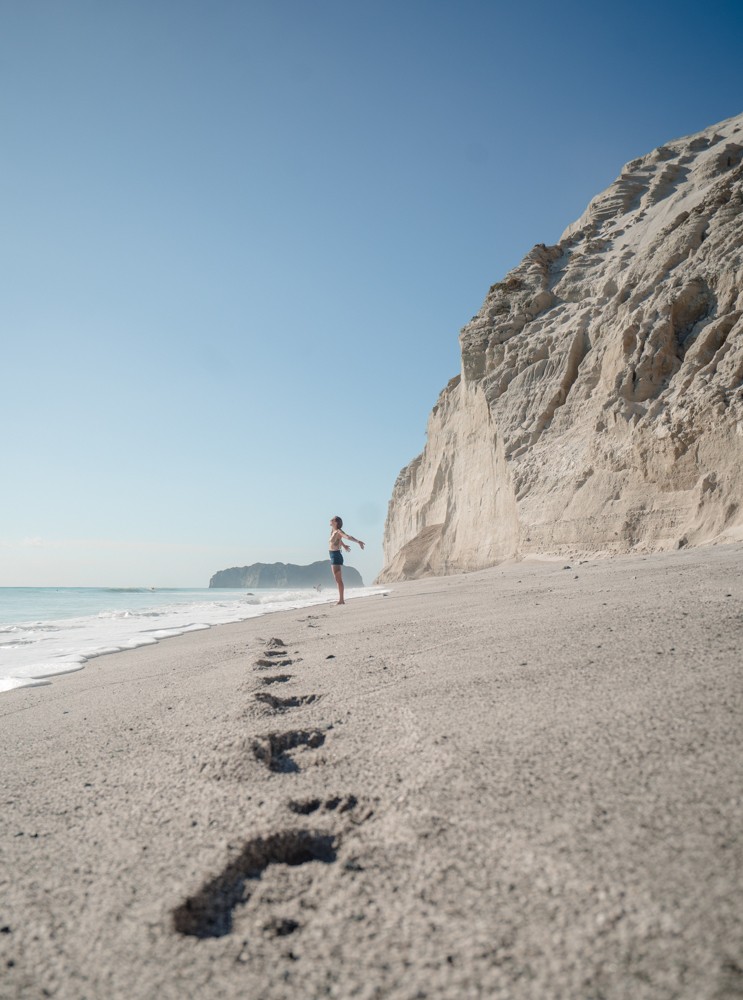
Once you’ve committed to your trip itinerary, next is planning what to bring. In a country as convenient as Japan, you can buy most small things that you forget at a Daiso store. But there are a few things to keep in mind while touring the country—one of them being cash. Japan heavily operates as a cash-based country, and many places don’t accept credit cards.
The clothes you fit into your backpack (I HIGHLY recommend a backpack for Japan) will vary depending on the season you go. I’ve written a complete outfit guide for a trip to Japan, but here are some things to keep in mind about travel in Japan during each season:
When springtime comes around, so will the tourists who want to see Japan’s famous cherry blossoms. While they’re certainly beautiful, it may be hard to appreciate them with the constant crowds. I would also avoid going during “Golden Week”, a Japanese holiday from the last week of April to the first week of May. This week will add to the crowd with groups of locals getting their vacation time in. Summertime (June to August) is a mixture of both dry and hot, which will make outdoor adventures exhausting. I wouldn’t come during this season either unless you want to go to explore beachier places like Okinawa.
Instead, you can opt for the fall (September – November) if there isn’t a specific seasonal activity you’re interested in. The season’s mild weather and beautiful change in scenery are amazing to see throughout Japan’s parks. The winter season is also a great time to hit the slopes in Japan’s north (see Hokkaido above), but visiting will be pricier due to its popularity during the colder months.

First Name:
Japan has much that a solo traveler could want: safety, historic sites, great food, and kind people. The cultural differences may catch you off guard at first, but traveling despite language barriers will build your confidence as a solo traveler. If you come with an open mind and an empty stomach, you’ll find that the country has a lot to offer.
Is there a place you’d like to visit in Japan? Let me know in the comments!
About Kristin Addis
Kristin Addis is the founder and CEO of Be My Travel Muse, a resource for female travelers all around the world since 2012. She's traveled solo to over 65 countries and has brought over 150 women on her all-female adventure tours from Botswana to the Alaskan tundra.
Leave a Reply Cancel reply
Your email address will not be published. Required fields are marked *
Save my name, email, and website in this browser for the next time I comment.
subscribe to our newsletter
This site uses Akismet to reduce spam. Learn how your comment data is processed .
- Search Please fill out this field.
- Manage Your Subscription
- Give a Gift Subscription
- Newsletters
- Sweepstakes
- Destinations
How a 2-week Trip to Tokyo Changed My Mind About Solo Travel
As an extroverted traveler, I learned to appreciate sitting in silence.
:max_bytes(150000):strip_icc():format(webp)/SophieDodd-29f8105329084ddbafdf19974fa43b45.jpg)
Courtesy of TeamLab Planets Tokyo
I’m sitting alone at a record bar in Tokyo , sipping a dirty martini and willing someone to talk to me. It’s been more than 24 hours since I’ve spoken out loud; body language and the bizarre magic of Google Translate have been my only modes of conversation. As a hyper-extrovert, I’m going a little wild — and it’s more than just the 'tinis talking (if only they would).
"I really like the music," I type on my phone, watching my words reappear in Japanese and wishing my personality translated as easily. I slide my screen across to the bartender with a pitifully earnest facial expression, clearly craving human interaction. He offers me a smile and quickly returns to garnishing a cocktail. I want to say, "Where do I go to make friends?" I want to say, "This is my first time traveling alone and I’m a little lonely, but mostly awestruck by this kaleidoscopic city, and I wish I could talk about it in a non-computer generated voice." Instead, I open my mouth and tip back the last of my drink, crossing my fingers into an X because the internet told me that’s how to signal for the check here. In Japan, my words and gestures are not my own, and yet I feel closer to myself than I have in months.
I set out on my first-ever solo trip a week ago — 12 days in Tokyo and Kyoto , where I know no one and can’t speak a word of the language — in a bid to push myself as far out of my comfort zone as possible. I’ve been traveling full-time for a year, primarily with friends and family in French- or Spanish-speaking places where I have some linguistic leeway. Most of my trips have been with a parent , partner, or close friends, meaning I’ve rarely found myself alone.
That hasn’t bothered me much: I’ve always preferred my alone time in brackets. I’m glad to spend the day writing or wandering on my own, so long as I know I’ll meet a friend that evening. So when I decided on nearly two weeks alone in Tokyo to celebrate my 29th birthday, I worried about the open-endedness of all that me time. What if I don’t like myself as much as I like my friends? What if I’m a less savvy traveler when I don’t have someone to explore with? And worst of all, what if I get overwhelmed by all the restaurants I’ve starred on Google Maps and don’t have someone to help decide where we should eat? The responsibility of being entirely in charge of my own itinerary seemed daunting.
Sophie Dodd/Travel + Leisure
But traveling alone ended up being one of the most fulfilling, empowering experiences I’ve had during this nomadic year. Alone in a country and in a language I had absolutely no bearings in, I started to reconnect with myself. The endless sprawl of Tokyo meant I could never "see it all," so I quickly gave up on the instinct to pack things in and instead let myself be carried along by the current, taking long, meditative walks through old-school neighborhoods like Yanaka and along the river in Nakameguro. Moments of loneliness were overshadowed by unexpected sparks of connection, like swapping travel stories at a sushi counter or hopping through wine bars with local friends I met on my last night.
For all the ways solo travel intimidated me — and for all the moments I wished I had someone to talk to and process the experience with — it ultimately gave me more confidence in myself as a traveler, helping me feel simultaneously more self-sufficient and open to relying on the kindness of strangers. It taught me that certain things — like an umami-packed first bite of uni or the musical creaks of 400-year-old floorboards in a Kyoto castle — can’t be translated, so sometimes it’s best to put down your phone and just appreciate them in silence.
If you’re planning a trip to Japan , here are some of the places in Tokyo and Kyoto that changed the way I think about dining, sleeping, and wandering on my own.
After touching down in Tokyo in the evening, I headed straight to Aman Tokyo , a secluded oasis tucked away from the city’s bustle. After crashing early, I woke the next day at sunrise and made a choice I would never have dared to with a travel companion: I didn’t leave the hotel. That’s right, I flew 14 hours to spend an entire day inside. Hear me out: A few too many recent attempts at overextending myself at the start of a trip had convinced me to take it easy on day one, allowing myself to adjust to the jet lag and get ahead of some deadlines. And it wasn’t exactly a chore to hole up in my sun-drenched, 1,517-square-foot suite with beautiful blonde wood, delicate washi paper doors, heated bathroom floors, and panoramic views of the glittering city from the bathtub.
After knocking out some work, I made my way to the hotel’s heated pool, where I had tantalizing skyline views entirely to myself. Already starting to relax, I indulged in a restorative Signature Spa Journey — a full-body scrub and massage that erased any damage my flight had done — before taking full advantage of Aman’s luxurious spa amenities , including an onsen-style hot bath and a steam room. It was the best thing I could have done for myself to start the trip on a positive note, and it taught me an important lesson from the get-go: Listen to your body. I knew I needed a day to reset, despite the voice in my head telling me I should be exploring immediately. When you’re traveling with others, compromise is the name of the game; alone, there’s no need to people please.
The Tokyo Edition, Toranomon
Nikolas Koenig
There’s perhaps no better view of Tokyo than from one of the 206 guest rooms and suites at The Tokyo Edition, Toranomon . Designed by Japanese architect Kengo Kuma, the Ian Schrager hotel is as dazzling to look at as it is to look out of: Rooms are elegant and understated, with minimalist furnishings in natural wood tones and luxuriously comfortable beds. Suites on the upper levels boast their own private terraces, all the better to admire the stunning skyline. I spent my last night here, wrapped in a plush bathrobe and gazing out at the Tokyo Tower as I reluctantly packed my bags.
OK, I lied — I know exactly one person in Tokyo, and they happen to be the chef of one of the coolest farm-to-table restaurants in the city. I met California native Katy Cole in France last fall, when we worked the wine harvest in Chablis together. When she suggested I look her up if I were ever in Tokyo, the idea sounded so far-fetched that I immediately put it out of my mind — until a few days before my trip, when I asked if she’d be free to get together and, ideally, eat. We ended up spending several days together, including a night at her charming, intimate restaurant in Tokyo’s Meguro neighborhood.
It’s hard to overstate Locale 's cozy and convivial atmosphere: Sitting at the counter around her open kitchen, it felt like pulling up a stool at a friend’s home — one who has excellent taste and an extensive knowledge of local Japanese produce, which is front and center on the rotating chalkboard menu. Alongside a solid selection of natural wines, I tried everything on the menu that night, from an avocado and French lentil dish spread atop a shock of pink yogurt (colored by the Japanese pickle shibazuke ) to roasted pork with local cabbage. The meal ended with a homemade buttermilk pecan cake drizzled with a crème anglaise so good that it brought tears to my eyes — or maybe that was just my delight at having found such a wonderful new friend in Katy. (But seriously, the cake was fantastic.)
Ginza Sushi Ojima
One of the worst parts of traveling alone is not having someone to share food with. I love eating by myself, but as just one person, I can’t try as many dishes as I would with a companion. This dilemma was solved entirely by my first-ever omakase experience, a meal built entirely around single-bite courses. Walking into Sushi Ojima in Ginza, which is hidden in a nondescript office building, I felt like I’d found my way into a secret club. I hardly knew what to expect: I’d pre-paid for a 13-course nigiri lunch at the intimate 12-seat counter and I’d brought a book, thinking I’d want to keep myself entertained, utterly unaware that I was about to witness one of the most beautiful works of culinary theater I’d ever seen.
With fluid movements, the chef sliced fresh cuts of fish into sculptural perfection, dabbing on freshly grated wasabi or sprinkling sakura salt before pressing them into mounds of rice. I was mesmerized. I was drooling. I was unsubtly eyeing the Japanese couple next to me each time we received a new course, trying to gauge if I was meant to use chopsticks or my fingers. It was one of the moments I most wished I could communicate out loud about what a life-altering moment my taste buds were having, as my mouth closed around a sunset-colored squid and I ate a veritable school of tiny white fish with pink eyes.
Afternoon Tea at Four Seasons Hotel Tokyo at Otemachi
Tea is an indelible part of Japanese culture, and getting to taste a variety during Sakura Afternoon Tea at the Four Seasons Hotel Tokyo at Otemachi was a palate-expanding experience. While the sweet and savory sampler was delicious — raspberry and pistachio opera cakes and tiny bites of duck breast wrapped in a cucumber crepe with maple cream — it was the tea that delighted me the most. That, and the view of Mount Fuji in the distance.
Curry Spice Gelateria Kalpasi
Almost impossible to find, this curry shop and gelateria (a culinary combination I was thrilled to discover existed) sits at the end of a small alley in the ultra-hip Shimokitazawa neighborhood. To order, you warily eye a vending machine labeled with the Japanese menu, then look positively helpless until someone comes and kindly points out that you select the top row to order either two or three of the daily-rotating curries and a fragrant mound of jasmine rice; the next row includes can’t-miss sides like Japanese pickles and coconut sambol ; the third is to add on gelato. While the curries are mouthwatering, the gelato is what’s truly worth writing home about: They’re pepped up with various curry spices, so you can expect flavors like coconut with charred mustard seeds and kaffir lime, chocolate and Sichuan pepper, or mascarpone with cardamom and lassi.
TeamLab Planets Tokyo
There are few places that combine culture with unbridled childlike joy like TeamLab Planets . The interactive museum — a favorite of celebrities like Justin Bieber and Dua Lipa — is a full-body experience that begins by removing your shoes and shuffling up a vertical waterfall. Making my way through the exhibits, I was struck by how much fun everyone was having. Sure, it’s an Instagram hot spot, but in between snapping curated photos, every single person was grinning and looking around the space with wonder.
It was invigorating to watch adults be so, well, silly — and how could you not be when you’re asked to crawl alongside a group of strangers on a mirrored floor as a ballet of fragrant orchids dances overhead? Or, when you’re told to bump into enormous color-changing globes? Each room holds new visual and tactile surprises, be it the Infinite Crystal Universe — a dazzling, Kusama-esque mirrored room of LED lights — or the shin-deep pond of warm water, where vibrantly projected koi fish interact with bodies in real time. The museum is a memorable experience that’s a must-see in Tokyo.
After picking up a Japan Rail Pass at Tokyo Station — which allows unlimited travel on the Shinkansen, the high-speed bullet train, to just about anywhere in Japan for a set duration of seven, 14, or 28 days — I snagged a seat on the next train to Kyoto (be sure to ask for a seat with a view of Mount Fuji).
Two hours later, I was met by a driver from Aman Kyoto , who whisked me 30 minutes north to the meditative retreat set in a lush, secluded garden that’s been extraordinarily maintained for decades. The property is a natural marvel, carved out with mossy stone paths studded with tall trees and lit by candles at night. The ryokan-inspired rooms are a striking marriage of modern design and ancient tradition, with floor-to-ceiling windows that give way to a view of the green glades. With two restaurants and an indoor-outdoor onsen, I found it hard to tear myself away.
Minimalist and peaceful, my room — in particular, the enormous hinoki bathtub — was the perfect place to rest and reset after long days of touring temples in Kyoto. While I was mesmerized by all of the famous sites — Nijō Castle, Daitoku-ji Temple, Arashiyama Bamboo Grove, and Fushimi Inari were a few favorites — I was most moved by the private temple tour and tea ceremony the hotel organized for me. This offered unparalleled access to a centuries-old tea room and a one-on-one lesson with a Japanese tea master.
Sake Bar Yoramu
For a crash course in sake, make a pilgrimage to Yoram Ofer’s exceptional eight-seat bar in downtown Kyoto. As a natural wine lover with no knowledge whatsoever of the fermented rice beverage, I was enthralled when I walked in and found him patient and passionate in his explanation of flavor profiles and producers.
He opened the bar back in 2000 and has been aging much of his sake since then, serving his vibrant, invigorating beverages by the glass so that you can taste a wide variety — everything from fruity, unpasteurized styles to ambered vintages — a number of which he heated up for me to try side by side.
Related Articles
cassiethehag
Solo Travel in Japan tips + best places to go alone in Japan
If you’re looking for tips on solo travel in Japan? Great, because this post has you covered.
Please note that this blog post most likely contains affiliate links to products or services I use and love! If you click on the links, it means I get a little extra pocket money at no additional cost to you. This is what keeps my website ticking over – thank you!
Not only did I spend one month travelling in Japan alone (and have been a solo female traveller for over 5 years!) but I’ve also invited other Japanese experts to share their thoughts on the best places to travel alone in Japan.
Whether you’re looking for hidden gems or the best way around major tourist sights in Japan solo, we’ll recommend awesome things to do that will guarantee a memorable solo trip.
Table of Contents
Is Japan good for solo travellers?
Pros of solo travel to Japan:
- Safety: this is the main reason Japan tends to end up in so many ‘solo travel destination’ lists, I swear. Is it deserving of that title? Honestly… I think there are easier places to solo travel! However, it’s completely accurate that you’ll feel safe here as a solo female traveller.
- Ease of getting around: the train and bus system is pretty easy to navigate, especially in Tokyo and on bullet trains. That said, I used to live in London, so I was used to using the metro… it might feel challenging if you’re not used to it!
- Easy to stay connected: Most hostels had great WiFi, as did many major stores and most transport!
- Variety of activities – whether you’re into city sights, stunning beaches, historic temples, mountain hiking, or gentle nature, Japan has everything.
- Hostels are (usually) pretty good quality in Japan, with many including capsule beds with your own shelf, curtain, light, and plugs tucked inside. Read my post on surviving hostels as an introvert if you’re still nervous!
- Japan is introvert-friendly! Locals won’t be fussed by seeing people eating alone, since that’s a common practice! So that’s good news if you want to try all the tasty treats but feel self-conscious.
- Vegan options: On that note, if you’re a vegan traveller , you won’t bother your mates when you want to eat in all the amazing vegetarian Buddhist restaurants!

Cons of solo travel to Japan:
- Loneliness: I found it harder to meet people in Japan than in any other place I’ve visited. This is likely since ‘backpacker-style’ travellers are over the sea in Southeast Asia! Also, as it’s such an introverted society, I often found it INCREDIBLY hard to find someone to help me if I needed help. The country is known for being very polite, but not friendly, per se. (And no judgment from me, it was probably particularly tricky as I’m an introvert too!)
- Cost: Solo travel can be expensive , so for budget travellers, Japan won’t be as friendly for your wallet as other destinations such as Southeast Asia or The Balkans. Private rooms, taxis, and many tours are unfortunately more expensive for solo travellers, and I felt the sting much more in Japan than I have in other destinations.
- Some tours and traditional accommodations don’t accept solo travellers. I stayed at a Minshuku during a hike along the Kumano Kodo trail, but I wasn’t able to find a budget-friendly way to stay in a Ryokan during my trip.

Tips for solo female travel in Japan
Solo travelling to Japan is a bold choice for first-time travellers, speaking from my own experience! So I’d recommend it for more experienced travellers (whether or not it’s your first solo destination).
On the one hand, it’s very very safe, and the public transportation is great. I always felt safe as a female travelling alone in Japan. On the other hand, there’s less of a solo travel scene than in other countries I’ve been to, so it’s harder to meet people – whether you’re looking to socialise or just need some friendly advice.
- Learn a little about local customs if you want to blend in. For example, it’s not polite to eat on public transport.
- You don’t need to speak Japanese (especially in Tokyo and Kyoto) but that doesn’t mean it’s easy in small towns. I found not speaking the language harder in Japan than in other places I’ve visited. I recommend having Google Translate handy, and learning the words for basic phrases like Thank You, Excuse Me, and Your Cat/Dog is very cute is always appreciated by locals.
- If you want to meet people, staying in hostels is the easiest option. Or if you’re staying in a hotel, you can still often join tours aimed at backpackers, or head for a drink in a hostel bar where people are usually looking to socialise.
- Don’t be afraid to venture outside of Tokyo, Kyoto, and the main hotspots and discover some epic Japan hidden gems ! Although travelling outside of the norms can be more intimidating if you’re a first-time solo traveller (like I was during my Japan trip!), my favourite places to visit solo in Japan were all off the main route!

Best places for solo travel in Japan
Looking for a solo travel destination in the countryside of Japan? Then Hokkaido, especially its eastern part, is a perfect place to go if you want to immerse yourself in untouched nature by yourself.
My favourite spot is Shiretoko, which is just a 1.5-hour drive away from Memanbetsu Airport. The Shiretoko Peninsula, mostly covered by a national park, offers several outdoor activities that can be enjoyed solo in every season; five-lake hiking, snowshoeing to a waterfall and ocean cliffs, natural hot springs, and many more.
It’s best to visit during the summertime (June to September) with a rental car, but totally doable to travel by public transportation as well. Just check the timetable beforehand and plan your connections well. Things don’t run too often in the countryside!
For accommodation, I recommend Yuhi no Ataruie – a modern, cozy hostel with a hot spring, a spacious shared kitchen, and a breathtaking sunset view. Shiretoko is also known for its fresh seafood, so make sure to enjoy the delicious local food!
by Yuuka from My Eastern Hokkaido

No solo trip to Japan would be complete without the almighty Tokyo, especially if this is your only time visiting Japan. And if you don’t have long to explore, you can still see the iconic suburbs of Harajuku, Shibuya, and Shinjuku in one day in Tokyo .
Kamakura is a fab day trip, and well worth adding to your solo Japan trip itinerary even if you just have 3 or 4 days in Tokyo . If you don’t have long in Japan, it’s a nice and easy way to see a different side of the country without being much trouble to get to from the capital.
Travelling to Tokyo alone can be a wild ride, but that’s part of the fun! And despite the massive scale of the city, it’s one of the capitals I’ve felt safest in.

Nestled in Japan’s beautiful mountains, Hakone is the perfect destination for solo travellers looking to explore a different side of this incredible country. The Hakone area is known for its relaxing Onsen (hot springs), unspoiled nature and breathtaking views of the iconic Mount Fuji which looms over the area.
Hakone is full of exciting things to see and do. From the volcanic valley of Owakudani to the Pirate Ship Cruise across Lake Ashi, Hakone is a great spot to escape the chaos of the cities and experience traditional countryside life. The area is well-connected and easy to get around, making it a great destination for solo travellers.
Most visitors to Hakone follow the famous Hakone Loop which includes the Owakudani Valley, the Hakone Shrine and the Sightseeing Lake Cruise. If spending longer than one day in Hakone, consider exploring further afield and taking on the Mount Kintoki hike or visiting the Mishima Skywalk.
Hakone can be done as a day trip from Tokyo by taking the Odakyu Romance Car from Shinjuku Station. Hakone is also the perfect spot to slow down for a few days and immerse yourself in traditional Japanese life. Consider purchasing the Hakone Free Pass to save money. This includes transport to and from Hakone as well as transport between Hakone’s main attractions.
One of the best hostels in Hakone is Guesthouse Azito. The hostel has private and spacious capsules as well as a social bar area.
by Emily from Journey by Backpack

Naoshima (the art Island)
Located in the Seto Inland Sea between the main island of Honshu and Shikoku, Naoshima is a small island known for its art museums, outdoor sculptures, and friendly vibe. Naoshima’s small size and friendly locals make it a perfect destination for solo travellers. I was able to get around by public bus and electric bicycle.
While it’s possible to do Naoshima on a day trip from Okayama, an overnight stay provides more time. To reach the island, take a bus from Okayama station to Uno Port, then take the ferry across to Miyanoura, which runs approximately once an hour. I booked a hotel that was walkable to the Miyanoura ferry port, so I didn’t have to walk far with my bags. There are also tons of luggage lockers by the port.
Naoshima has become very popular in recent years, due to its two large pumpkin sculptures by Japanese contemporary artist Yayoi Kusama. So it’s wise to book ahead for the Chichu Art Museum and Art House Project. Both have James Turrell art installations that play with light in unexpected ways. For me, Turrell’s work was a highlight of visiting Naoshima!
There are only a handful of restaurants on the island and they get crowded during meal time. I recommend Naoshima YADO FOOD, a sweet pub restaurant run by a local couple that serves spicy chicken or tofu curry with the best carrots I’ve ever eaten. YADO FOOD is also right near the I Love You bathhouse, an artsy version of a traditional onsen, so you can soak before or after your meal.
by Lindsey from Queer Adventurers

As a first-time ever solo traveller, I admittedly found solo travel in Kyoto quite tricky. But that’s likely just because I wasn’t used to eating alone yet, and the vegan spots I was eating in were way more foreign couple-dominated than other places I went to in Japan, which had other solo diners.
That said, Kyoto is a once-in-a-lifetime destination for so many people, so it shouldn’t be skipped. It’s safe and packed with many of the country’s most photographed destinations, and truth be told, it’s every bit as picturesque as you expect it to be. Many of the key attractions are easy to navigate on foot, and a fun way to meet other travellers here is to take a walking or bicycle tour of the city.
Don’t miss Kiyozimu-dera Temple, Gion, the Fushimi Inari Shrine (I highly recommend hiking to the top of the shrine – this was my favourite part of the city and a great way to avoid the crowds gathering around the front of the temple), and the golden Kinkakuji Temple. The Bamboo Forest is also worthy of a visit but go early if you want to avoid the masses.
If you’re a fan of quiet walks and want to connect to Kyoto’s history, I highly recommend template spotting walking along the Philosoper’s Path. Walking from Kiyomizu-dera, Maruyama Park, and then crossing through Gion before walking along the canal side path felt very peaceful, and Ginkakuju Temple at the end of the route took my breath away.

Travelling to Osaka is a must for solo travellers due to its rich culture, lively nightlife, and renowned food centres. Getting to Osaka is relatively simple via a train from Tokyo or Kyoto, and you can also fly in by landing in the nearby Kansai airport.
When choosing a place to stay, you will want to consider proximity to public transportation as it’s the best transportation method for travelling across the city. I decided to stay near the Osaka station because, as a first-time visitor to Osaka , I wanted to be close to a main public transport hub.
However, for solo travellers looking to make the most of their nightlife excursions, I would recommend staying near Dotonbori because it’s such a fun neighbourhood to be in and has great public transportation. Dontonbori is an energetic entertainment area known for its flashy neon signs, giant shop signs, and tasty restaurants. It’s also relatively busy and well-lit, which I prefer for travelling alone or with a small group.
You can easily spend your night in this district by collecting toys from various Gachapon machines as I did and eating to your heart’s content at the multiple restaurants that line the street and canal. The most notable dishes here are Takoyaki, Okonomiyaki, and jiggly cheesecakes.
Osaka Is also an excellent spot for those who appreciate the historical significance of Osaka in Japan’s history and want to learn more about its rich culture. During the day, make it a goal to visit the beautiful Osaka Castle to learn more about Osaka’s history. There is a small entrance fee of roughly 600 yen and an additional 200 yen if you want to explore the castle garden.
by Yesenia from The Sisters Who Voyage

If you’re a fan of majestic castles, tranquil temples, or military history, then Himeji is the place to go.
Himeji is located in the Hyogo prefecture between the cities of Osaka and Hiroshima, and it is easily accessed by both the Shinkansen (bullet train) and the Rapid Lines. While Himeji holds a population of around half a million people, it has a small-town vibe, with little crowds and a more peaceful atmosphere. This makes it the perfect Japan solo travel destination.
I spent an entire year jumping around cities in Japan by myself, and one of my favourite and most frequent day trips was Himeji. This was due to its two most spectacular sights: Himeji Castle and Mount Shosha.
Himeji Castle was built in the 16th century and is considered one of the most beautiful castles in all of Japan. Mount Shosha is an idyllic temple complex outside of Himeji’s main city centre. Located at the top of a mountain, it is accessible through a small, 30-minute hike or by ropeway.
I was never concerned for my safety while solo travelling in Himeji, even when I was hiking on my own. With its friendly locals, serene streets, and low crime statistics, Himeji is a very welcoming and safe destination. It’s also an easy trip to make, as there’s not much you need to book in advance (unless you plan to stay the night!).
by Mia from Walk a While with Me

If you’re travelling to Japan alone, there are so many great things to do in Fukuoka for solo travellers. I really enjoyed visiting Fukuoka as it felt less tourism-dominated than other Japanese cities I visited, and more like a genuine working city. I felt very comfortable solo dining here and the hostels were super affordable.
I recommend walking around the city to see the Canal City Shopping Centre and its free anime water show and Tocho-ji Temple, which has a 5-tier read pagoda and 10 10-metre high wooden Buddha Statue.
I also enjoyed taking a tube to Fukuoka Tower (a 234m high tower with an observation deck at 134m) and Seaside Momochi. However, my favourite spot was walking around the Hakata Castle ruins (dating back to 1601) in Maizuru Park.
If you don’t have long in Kyushu but want to discover more of its magic natural attractions, I recommend this Kyushu travel itinerary . It’s the route I took as a solo traveller, and it took me through Beppu’s multicoloured hot springs and two active volcanoes – Aso and Kagoshima.

Okinawa is the perfect destination for solo travellers to Japan. This tropical island is located about 400 miles south of mainland Japan and is most easily accessible via Naha International Airport.
There are plenty of reasons to visit Okinawa , including visiting historical sites, trying the local cuisine, and watching cultural performances. But the best reason to visit is for its beaches! The island of Okinawa has some of the most beautiful beaches that I have ever seen. In addition, there are plenty of snorkelling and scuba diving opportunities on the island. I recommend checking out Cape Maeda on the west coast of the island due to the diversity of marine life there.
Unfortunately, getting around Okinawa is tricky due to a lack of public transportation. I recommend that travellers rent a car to fully be able to explore the island. There are so many small villages around the island that are worth visiting that are only accessible with a private car.
by Andy from Explore with Finesse

Zamimi Island
Zamami Island is an excellent beach and adventure destination, perfect for families and solo travellers. The island is a perfect day trip from Okinawa, as it is located 50 minutes by high-speed boat, and provides world-class beaches, water activities and hiking.
One of the most enjoyable things to do while on a day trip to Zamami is to partake in the many water activities, such as snorkelling the blue calm waters or kayaking around the little island. Two of the most popular beaches are within walking distance from the main port, making it very accessible for solo travellers.
If water activities are not your forte, you can easily hike around the island or rent a scooter to view some breathtaking viewpoints. My recommendation would be to hike to the Takatsukiyama Observation deck, as it’s within walking distance of all the popular spots on the island.
I’d encourage travellers to book high-speed boat tickets online (1-2 months in advance) as they tend to sell out, especially during peak season. Alternatively, there is a slower ferry (2 hours) that services the island, but it is more suitable for those intending to stay longer.
by Deirdre from Build & Board Travel

Experiences for solo travellers in Japan
See the snow monkeys in jigokudani.
In as little as an hour you can get the train from Nagano to the Snow Monkey Park, Jigokydani Yean Koen. The train station is in a small village called Yudanaka. Since the train from Nagano to Yudanaka is a private line you cannot use your Japan Rail Pass for this journey. However, the private train company sells a Snow Monkey Pass which is valid for two days. It gives you unlimited use of trains and buses between Nagano and Yudanaka plus entry to the Snow Monkey Park.
Seeing the monkeys bathing in the onsen (hot spring) is what people come for. You are most likely to see this during the colder months. Since Yudanaka is in the mountains it remains cold for longer than lower areas. I visited in April and enjoyed the cherry blossom in Kyoto whilst it was still cold enough in Yudanaka for the monkeys to use the onsen. However, the monkeys are in the area year-round so this is also an interesting destination in summer.
Although you can visit the snow monkeys on a day trip , I recommend staying overnight in one of the many traditional hotels in Yudanaka called Ryokans. You can sleep on a futon in a tatami room and enjoy a Japanese breakfast. Another reason to stay overnight is because Yudanaka is a historic onsen town. Anyone spending the night can borrow a key to the local hot springs dotted around town. Most ryokans will lend you a yukata (bathrobe) and getas (slippers) to walk from one onsen to the next through the narrow streets of the old town. Having lived and travelled extensively in Japan this is the most authentic onsen experience I have had.
by Kristin from ScotlandLessExplored

Universal Studios Japan
Why do I suggest that Universal Studios Japan is the perfect place for a solo traveller in Japan? Single rider lines that’s why! USJ is one of the busiest theme parks in the world and the queues can be immense. Yes, you can jump them by paying for an Express Pass, but, Osaka’s Universal Studios also has 10 rides with the potential for a single-rider queue and, unless it’s a very busy day in the park, using one means you’ll queue for about half the time you’d spend in the normal queue – sometimes less; I walked straight onto both Jaws and Spiderman one rainy Sunday afternoon.
The one thing being solo won’t help you with is entry to the newest area, Super Nintendo World, as you need a special timed entry ticket to this ( see more on those here ) but, once you do get in there – the Mario Kart ride does have a single rider line for you to hop right on. And the other benefit of being solo here is that there’s no one there to see how badly you score on the VR part of the ride!
You need to book Universal Studios tickets in advance, Studio Passes and Express Passes go on sale two months before the entry date. If you do decide to buy an Express Pass, you’ll need to snap those up fast as they do sell out.
USJ is a short train ride away from central Osaka, so you don’t need to stay by the park. It’s an easy commute – I stayed at the Hen na Hotel Namba where you get checked in by robot dinosaurs. Rooms here are perfect for one – you can even book ones with a tiny robot companion.
by Helen from Japlanease.

Disneyland Japan
The best thing about visiting Tokyo Disneyland solo – no one saw that the Beauty and the Beast ride made me cry! The downside, there’s no one to chat with as you stand in the, potentially extremely long, queues, so I suggest adding enough to your budget to pay for the line-skipping Premier Access passes, particularly for Beauty and the Beast at Disneyland and Soaring: Fantastic Flight at Tokyo DisneySea the rides with the two longest queues in the park.
It might seem strange going to Disney as a solo adult, but forget that in Tokyo. There are so many Japanese adults there with friends or partners, you don’t feel odd walking around as a grown-up without kids, and you certainly don’t feel out of place as a solo one. Plus, because the majority of the park guests are Japanese, when you do meet another tourist, especially another solo one, chances are you’ll strike up a chat.
The staff will happily take your photo for character interactions, and, pleasing your stomach means you can avoid the busiest times for meals – by waiting a little bit later, I managed to snag a solo seat for the adorable Baymax-shaped curry with no forward planning. And, if your feet start to hurt, which they will, and you decide you’re done for the day, you can head home knowing everyone is happy! Fewer blisters, few arguments – why wouldn’t you go on your own?
There are two Tokyo Disney parks, Tokyo Disneyland and Tokyo DisneySea , and you’ll need to buy tickets for both in advance. The parks are a 40-60 minute train ride from Central Tokyo, or, if you’re not watching your budget, at least ten hotels surround the resort.
by Helen from Differentville

More experiences for solo travellers in Japan:
- Solo hiking the Kumano Kodo – an ancient pilgrimage trail that winds through mountain forests, across rivers, and past hidden shrines.
- Take part in a food tour or cooking class: – although solo dining is normal in Japan, that doesn’t mean it never gets lonely. But there’s an easy way to enjoy the amazing Japanese cuisine with others – join a cooking class or food tour!
- If there’s somewhere on your wishlist that you feel too intimidated to do alone, I advise looking for a tour that will allow you to go as a group. Ask your hostel for budget-friendly suggestions or check out GetYourGuide if you like to plan in advance.

Saving money as a solo traveller in Japan
If you’re truly on a budget, don’t get the JR rail pass. Seriously. Use a mix of bullet trains (so you get the experience!), night buses, and regular trains. I got the night bus from Tokyo to Kyoto and felt very safe! I recommend staying in each place for longer to get a real feel for it so you’re not spending as much on transportation, as that’s a huge part of a budget.
If you’re on a mid-range budget, then the 7, 14, or 21-day JR rail pass is likely right for you, as it’s certainly cheaper than buying all the train tickets separately and you’ll have the freedom to go wherever you want.
For flights, use Skyscanner or WayAway to find the cheapest flights for the month you want to travel.
Hostels are the way to go for budget solo travel in Japan, though if you’re on a mid-range budget you can switch things up with private rooms and get a Ryokan once or twice. Search for cheap accommodation on either Hostelworld (for hostels) or Booking.com (for a mix of everything).
If you’re a long-term traveller who’s happy to solo travel, you could also check out sitting opportunities (I’ve now had free accommodation on four continents with TrustedHousesitters ) or do a WorkAway (I volunteered at an animal sanctuary in New Zealand and it was the best experience ever).
Click to join Trustedhousesitters – free homestays in exchange for pet care . Use code CASSIE25 to get 25% off TrustedHousesitters memberships
Food-wise cut costs by cooking in your hostel or by picking up a packed lunch from a convenience store. This way, you’ll just be paying out for a big meal at dinner.
And, of course, take advantage of free activities (everything I did in my first day in Tokyo was free)
Is solo travel in Japan safe?
Yeah, I definitely felt safe solo travelling in Japan. As with any country, stay cautious walking around at night and trust your gut if anything feels off.
The only time I felt uneasy was the few times I got lost in the winding streets of Kyoto or smaller towns. Looking back, I wish I’d bought a Japan e-sim card or pocket WiFi so I’d always have had access to the internet. But hey, you live and you learn, and six years into solo travel, I’m still getting sim cards these days!
But, other than that, I honestly felt safe everywhere I went… even hiking alone in the mountains!
If there’s anything I missed, feel free to drop me a comment. Safe travels, and I hope you have a fantastic trip to Japan!

Share this:
Hi, I'm Cassie, and I've been solo travelling the globe since May 2018. In this time, I've backpacked around Southeast Asia, Japan and The Balkans, alongside living in New Zealand and Australia. Current location? Mexico
What to read next

Solo Travel in Kyoto and my Search to find Magic in Japan + itinerary

Best hidden gems in Japan – an Off-the-beaten-track Japan bucket list!

7, 10, 14-day Kyushu itinerary in beautiful Japan
14 comments.
p.s. This was your first big trip!? I know people that lived in Japan for years that didn’t make it to all these spots. It just shows you are a great travel planner! ❤
Lol that is amaaaazing! “Inu ga kawaii desu ne!?” I can see why that would get some smiles.
You are so right! Japan was my first ever solo trip (and big holiday in general) and although I tried to learn a little Japanese before hand, I didn’t get much further than hello/thank you/your dog is very cute. The latter definitely put a smile on a few people’s faces and I learn this phrase everywhere I go now. 😉
Thank you Holly, I hope you have a fantastic trip to Japan!
I hope you have a fantastic summer trip to Japan, and that my Japan blogs can still be helpful to you! 🙂
In my first few months of solo travelling I skipped this step (I was trying to be super budget…) but it ended up being so much harder! I find solo travelling with a local sim card so much easier now.
Ohh perfect, I’ve lots of Japan posts that I hope can come in handy for you! I’m sure you and your partner will have a fantastic trip. x
thank you Marga! I hope my Japan posts can help you plan your trip. There are so many amazing and unique things to see and do, solo or otherwise 🙂
Honestly, if you speak a little Japanese you will find it so, so different. Each time I travelled in Japan I had people be incredibly kind (inviting me to their homes or to eat with them…) They were always a little freaked out that a white girl could speak to them, but then wouldn’t stop chatting!
I hope you can learn a teeny bit then try again. 😀
I’ve solo travelled all over the world so I love your post! But actually planning my honeymoon to Japan so I’ll adapt these great tips a little bit. Can’t wait to visit again!
I haven’t experienced solo travel yet, but Japan is on mine & my partners travel bucket list! Saving this for hopefully 2025!
Thanks for these tips. We’re planning on going to Japan over the Summer, it might not be solo, but this list is also super helpful for families with a teen who want to visit Japan.
Your idea of getting a SIM card or pocket wifi are great ones, especially for solo travelers.
It’s SO helpful that you included both pros and cons of solo travel in Japan! So good to know about getting around the city safely, making sure to save this for my trip to Japan! Thanks!
Join the discussion Cancel reply
This site uses Akismet to reduce spam. Learn how your comment data is processed .
- Skip to main content
- Skip to primary sidebar

Destinations
- Plan Your Trip
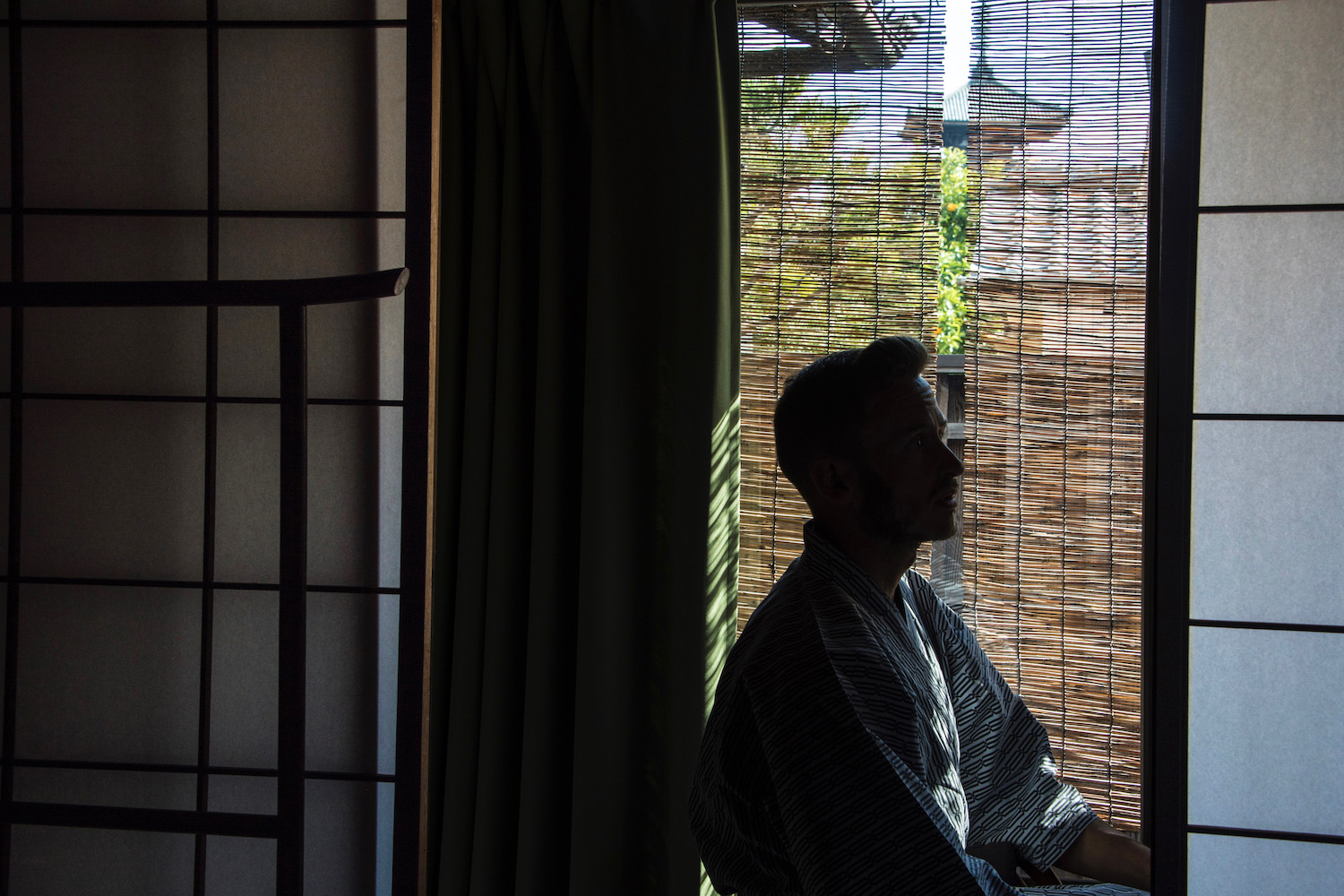
The Truth About Solo Travel in Japan
January 2, 2024 by Robert Schrader Leave a Comment
Solo travel in Japan alone can seem scary, even if you’ve been to the country before. Whether you’re nervous about your ability to communicate, or simply don’t want to be the odd (non-Japanese) person out on the subway in Tokyo at rush hour, there are a million reasons not to want to visit Japan by yourself.
But I’m here to tell you: Traveling Japan solo is one of my favorite experiences in the world—and I’ve got loads of tips for traveling alone in Japan, don’t you worry.
I hope you’ll continue reading this post, be it because you’re traveling to Japan for the first time (period) and need a little pep talk, or are anxious about challenges particular to going to Japan alone.
Myths About Traveling in Japan Alone
Solo travel in japan is too expensive.

While it’s true that traveling as a single person is always more expensive than traveling as part of a couple or group, this won’t affect you as much as you’d think it might in Japan. Apart from your accommodation, the cost of basically everything else is the same for solo travelers as others, especially if you buy a Japan Rail Pass . Want to save even more money on your trip? Check out my tips for traveling cheap in Japan!
Loneliness and Isolation Await
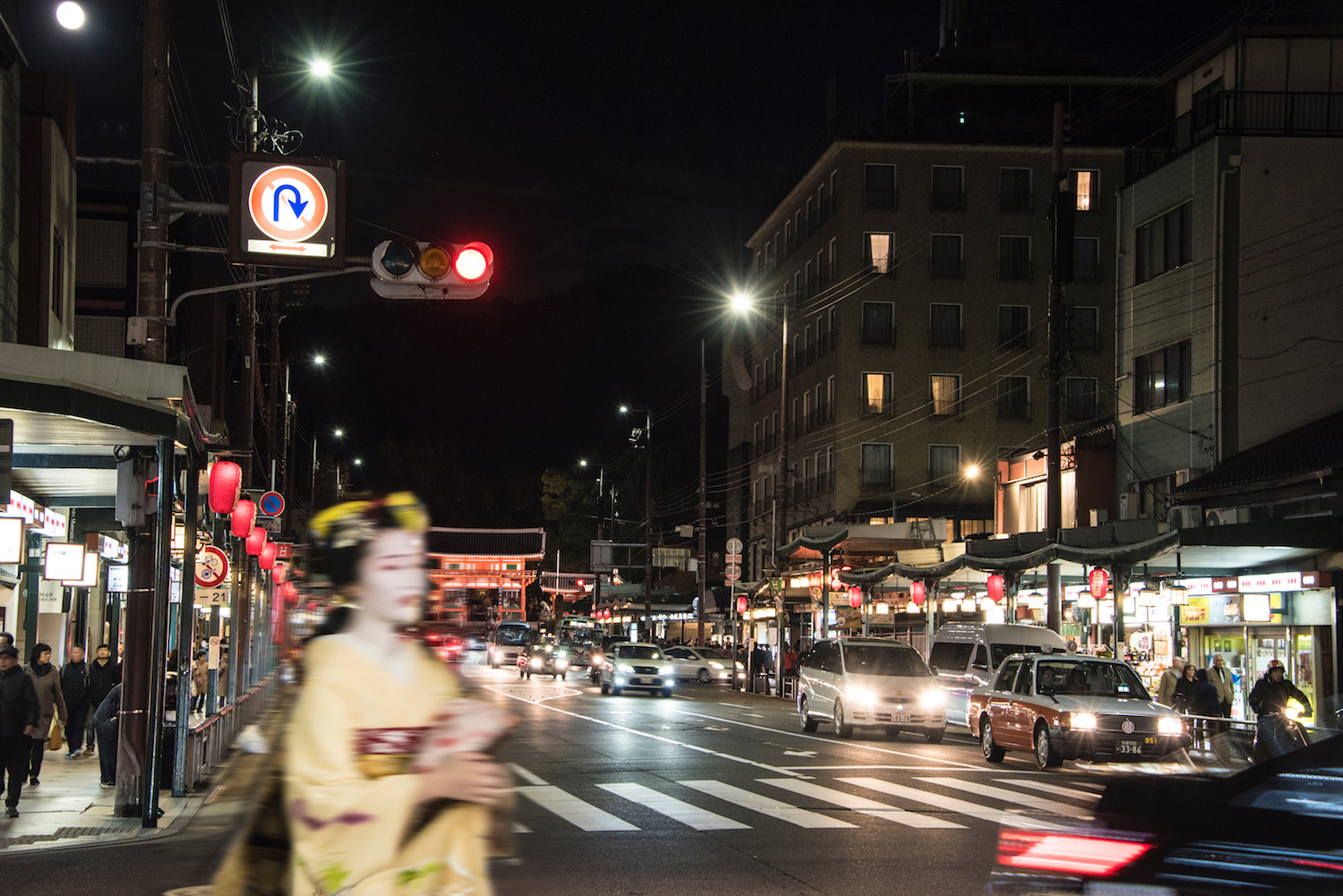
Given the reputation of the Japanese for being reserved and even solitary people, it’s logical to think that you’ll be on your own if you travel alone in Japan. To be sure, your chances of making friends with random local people is pretty low, though I’ve experienced many exceptions to this rule. However, it’s entirely possible that you’ll meet other travelers, whether during excursions like the one I recently took to a Kyoto sake brewery, or in the common areas of ryokan or hostels. When it comes to solo travel, Japan is more friendly than you might imagine.
You’ll Get Lost or Stranded
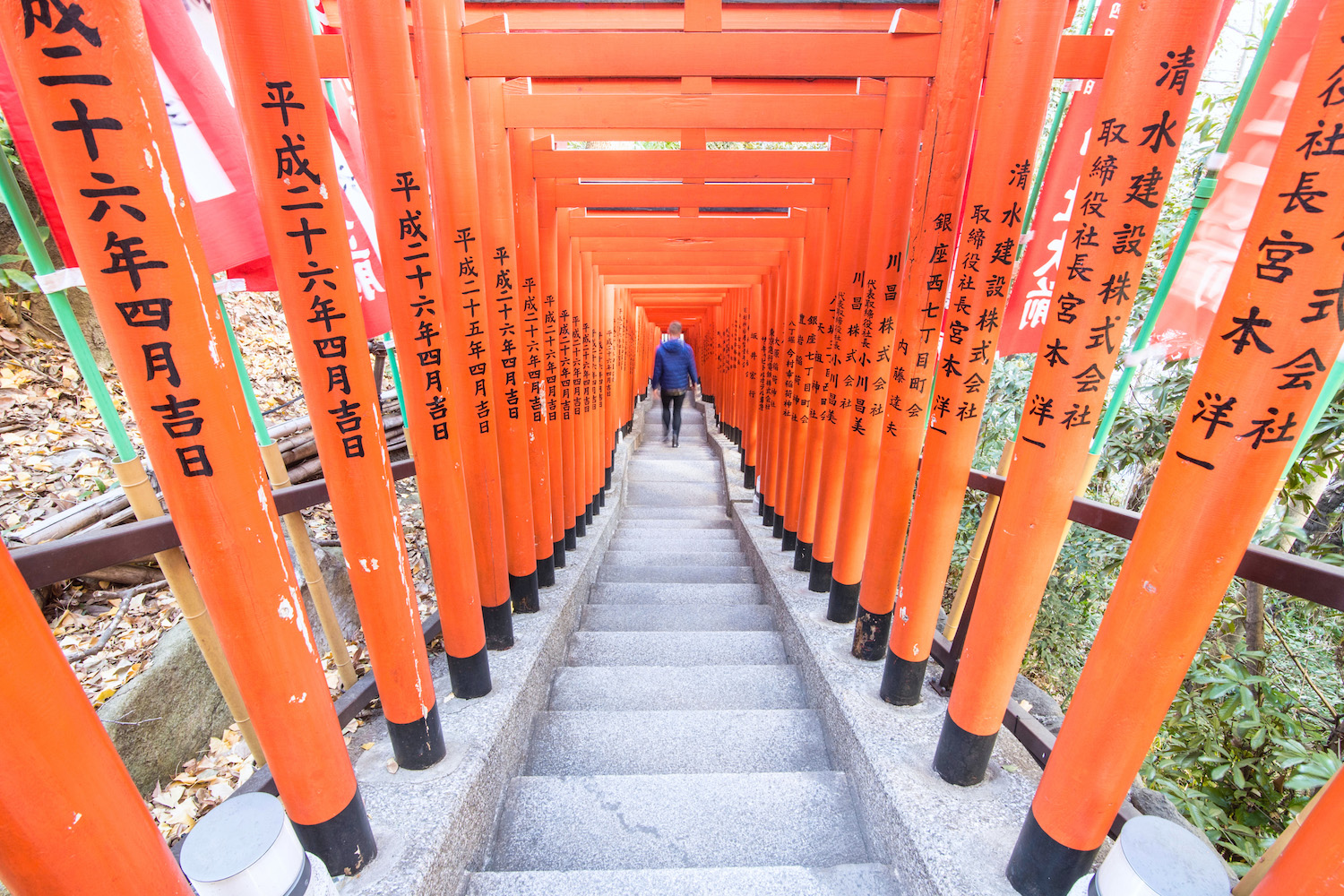
When people ask me about the best apps for traveling in Japan, they’re shocked at my answers: Google Translate and Google Maps. Japanese people speak better English than many foreigners give them credit for ; and street signs and informational placards are also uniformly excellent. However, if you have a smartphone with an active Japan SIM card inside, you have literally nothing to worry about when it comes to communication or navigation, whether you’re traveling to Tokyo alone or are elsewhere in the country.
The Benefits of Traveling in Japan Alone
Connecting to japan’s landscapes (and cityscapes).

Regardless of the particulars of your traveling to Japan alone, your checklist for traveling to Japan is probably long and detailed. However, many of the best parts of traveling to Japan are intangible—specifically, the connection you feel to the land the Japanese people have called home for so many millennia, and the beautiful cities they’ve built throughout the ages. Places and things—not just people—have personality in Japan, and traveling alone is the best way to discover this.
Going Where You Want, When You Want

With the above being said, one of the best parts of traveling in Japan alone is the freedom to go where the wind takes you (quite literally, if you find yourself atop Mt. Zao in winter ). Since Japan is packed with so many incredible destinations and experience, being able to go as many or as few places as you want—and at your own pace—is a priceless privilege, one I find often outweighs the potential downsides of traveling without friends, lovers or family members.
Time for Introspection and Reflection
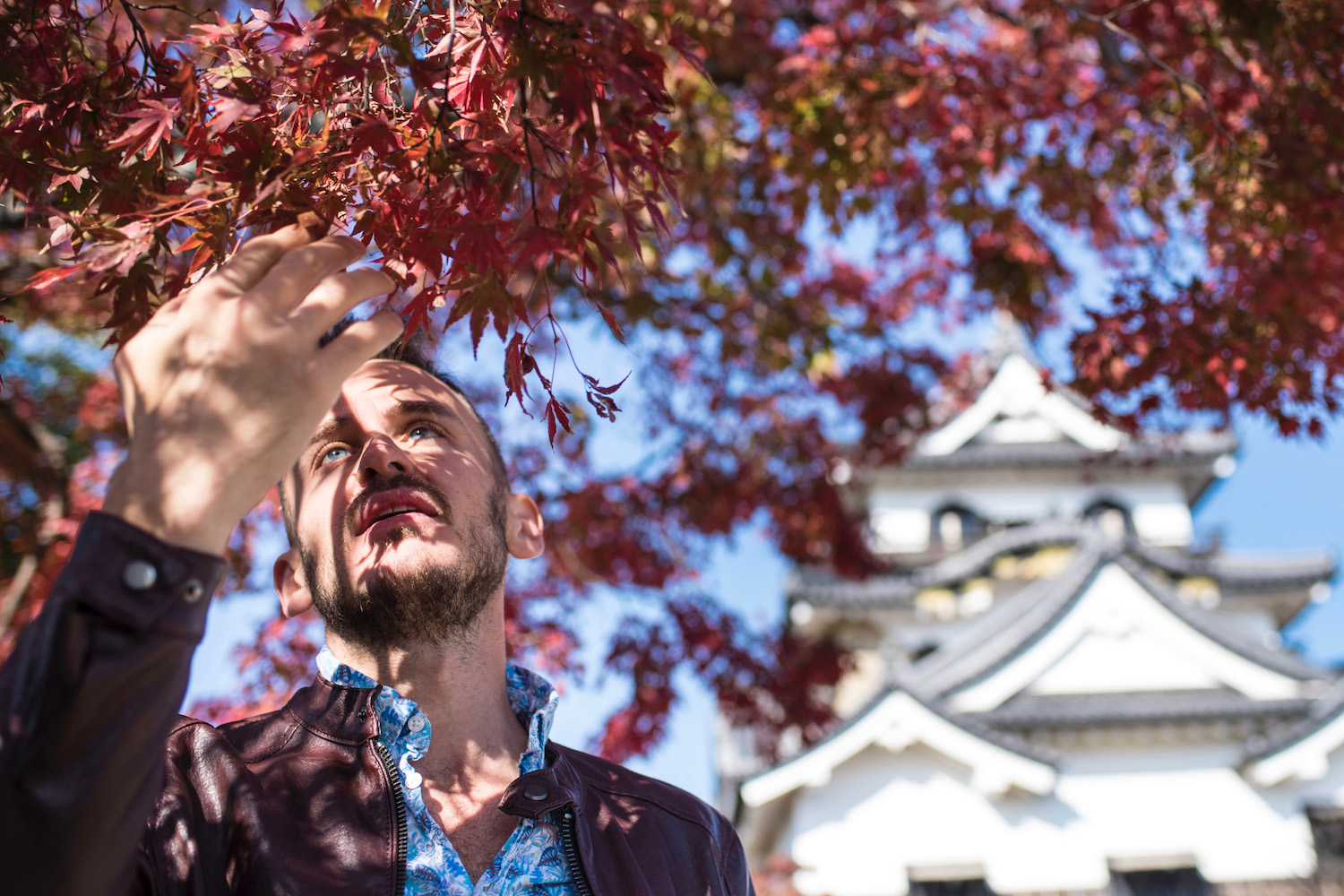
Traveling by train in Japan is one of my favorite things in the world—and not just because I’m a total nerd for the Shinkansen . Whether I’m gazing out the window at the landscapes speeding by, or reading a great book (often a Japanese one by authors like Mishima and Murakami ), this is one of countless opportunities for me to reflect on how my outward journey has affected me inside. Japan changes you, every second of every day of every visit—taking a solo trip to alone allows you to see this clearly.
Where to Go in Japan
Whether traveling around Japan with other people or by yourself, you’ll have the work of curating an itinerary cut out for you. As you can see perusing even my page of top Japan destinations (which is itself heavily curated), there’s enough to see and do in Japan to fill up at least a dozen trips—I say this from personal experience!
If you’re traveling alone to Japan and have never been to the country, you might try to see Japan in two weeks , spending 3-5 days each in Tokyo and Kyoto/Osaka, and venturing westward to Hiroshima or northward into the Japanese Alps to round out your trip. Spending longer (around one month in Japan ) allows you to explore secondary islands like Shikoku, Kyushu and Hokkaido, while you can also see Japan in a week if you don’t mind abbreviating your list of destinations for solo travel to Japan.
When to Visit Japan
Whether you’re simply traveling to Tokyo alone or will take a larger trip around Japan, chances are you’re considering a visit during one of Japan’s two most beautiful seasons. Most travelers want to come between March and May, when cherry blossoms bloom in Japan from south to north, while some others want to experience Japan’s autumn season , which mostly takes place during November.
On the other hand, coming during these highly desirable periods will increase your cost when you travel alone in Japan, although as I noted earlier this won’t be significantly higher as a solo traveler as it would be if you travel with friends or family. There’s nonetheless a case to be made for coming to Japan in winter , or even during the rainy tsuyu monsoon of summer .
Other FAQ About Traveling in Japan Alone
Is it fun to travel in japan alone.
Personally, solo travel is the only way I visit Japan if I can help it. Traveling alone allows you to go at your own pace, which for Type A people invites us to explore the wonders of Japan to the fullest extent possible, even if our time is limited. Plus, if you’re learning Japanese, solo travel practically forces you to speak it!
Can I travel to Japan alone as a woman?
Although there is some misogyny and sexual harassment in Japan, women are unlikely to face rape or other sexual violence when traveling in Japan. If you’re concerned about this, major cities like Tokyo and Osaka offer woman-only subway and train cars during peak travel periods.
How do I plan a trip to Japan alone?
The most effective way to plan solo travel in Japan is to start taking action—book your tickets and hotels, hammer out an itinerary and turn dreams into reality. Since you’re not waiting on anyone else to agree to your goals and plans, you have no excuse not to confirm your trip as soon as possible.
The Bottom Line
Think solo travel in Japan isn’t for you? Think again. Most of the things you’ve heard about traveling alone in Japan—that it’s too expensive or that you’ll be lonely—are little more than myths. Moreover, there are many advantages to Japan solo travel, namely the opportunity doing so presents for introspection, and the extent to which being in Japan alone “forces” you to practice the Japanese language, assuming you’re in the process of learning it. Still in need of more pep talk before traveling to Japan by yourself? Consider commissioning a custom Japan itinerary.
Plan Your Japan Trip

Subscribe to email updates!
Words, images and design ©2018-2024 Robert Schrader, All rights reserved. Read Privacy Policy or view sitemap .
- Bucket-List
- For First-Timers
- Off the Beaten Path
- Short Stays
- Safari Adventures
- Ambassador Adventures
Trip Styles
- Bucket List
Trip duration

Collections
- For First Timers
- Active Adventures
- Beach Escapes
- Winter Getaways
- Wildlife Trips
- Group Bookings
New and trending
- Alcohol-Free Adventures
- New Adventures
- Coming Soon
- Bestselling Adventures
- Browse by Experience
- Meet Your Travel Experts
- Meet your Pack Leaders
- The Flash Pack Foundation
How it works
- Payments, deposits & instalments
- Travel Extras
- About Solo Travel
- Careers at Flash Pack
- Partner as a Travel Agent
- Trip terms and conditions
- Safety with Flash Pack
- Flash Pack’s privacy policy
Latest deals
- Our August Offer
- Your latest travel offers
- Your last chance to book
Insider trips
Sorry no insider trips are available right now, check back soon.
- Feed your inspiration with all the latest stories from our content hub.
Relationships
- Career Tips
Top stories

Friendship Tips

Travel Tips

- See all articles
Favourite Trips
Destinations
- Destination Guides
- The ultimate solo travel guide to Japan: Everything you need to know
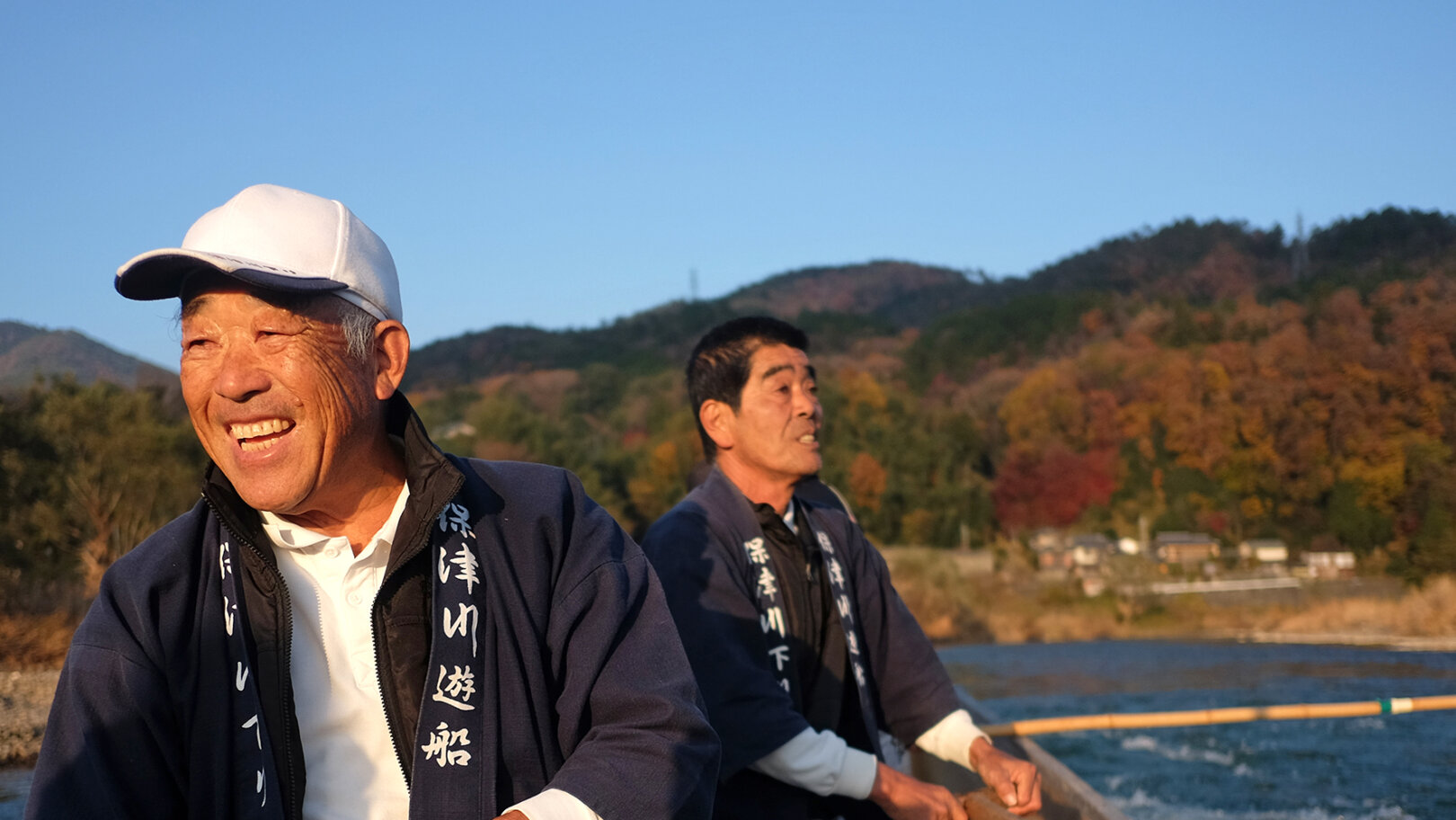
Anna Brech 22nd Oct 2022 10 min read
With its glorious tapestry of remote mountain temples and thriving cityscapes, Japan hits the sweet spot on many a travel bucket list. From rich cultural traditions to dazzling cuisine (give us a fiery miso ramen, any day), this is a country that was made to surprise your senses, making a solo trip to Japan a great option for anyone looking to try travelling alone. Even the travel-weary can’t fail to be charmed by Japan’s fusion of beautiful landscapes and hi-tech hubs that buzz with colour and energy.
Indeed, spending time solo is pretty well ingrained and normalised in Japan. Counterside tables for one are part of the furniture in any restaurant or cafe. But language barriers and cultural nuances can, at times, be hard to navigate entirely alone, so joining a group tour with other like-minded solo travellers, like on Flash Pack ’s Japan: Another World itinerary , can give you that balance of self-sufficient solitude, while taking the hassle out of planning and ensuring those all important bucket list moments are all carefully curated for you. Here’s everything you need to know about group solo travel to Japan .
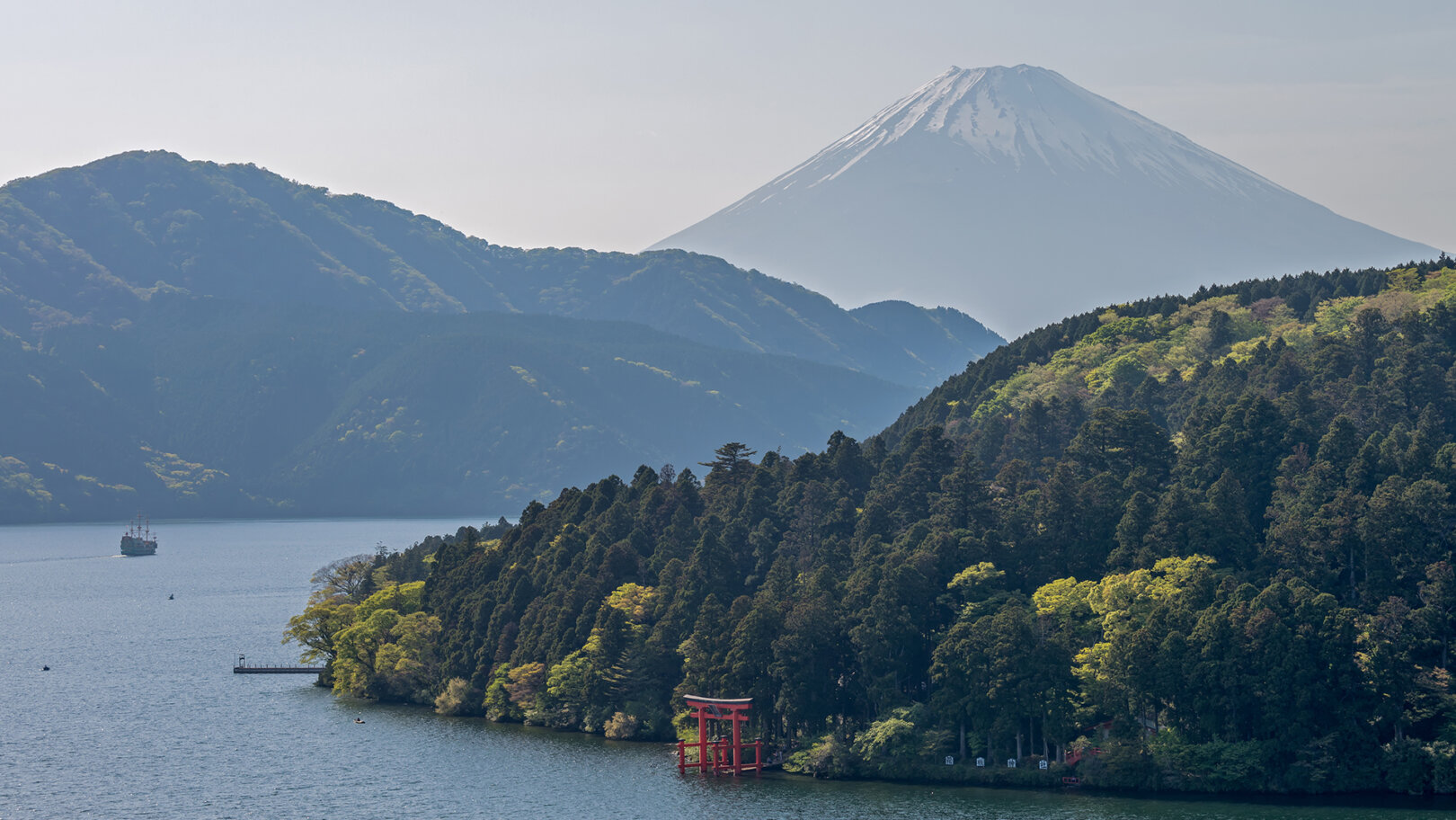
Japan travel facts
While its cities often take the spotlight, 70% of Japan is made up of forest and mountains. There’s over 100 active volcanoes, with its tallest mountain, Mount Fuji, peaking at 3,776 feet. Throughout this island nation, there are also 25 Unesco World Heritage Sites – 20 of which are cultural (like Himeji Castle) and five are natural (like Shiretoko National Park). It’s not all just happening on the main island of Honshu, either; Japan has nearly 7,000 islands to hop around, making it the fourth-largest archipelago in the world. Choose the small island of Ōkunoshima for its population of rabbits (yes, really), or Hokkaido for fresh powder and off-piste skiing in winter.
Is Japan good for solo travel?
Solo travel in Japan is safe and it’s easy to get around thanks to the country’s excellent transport links. It’s also a place where being alone is celebrated. In some countries, you may feel out of place if you go out to eat or drink solo, but not in Japan. It’s so normalised that it’s incorporated into the language: the term ohitorisama (which roughly translates as “party for one”) refers to people living and doing things alone, often reverently so.
Meanwhile, the Japan National Tourism Organisation operates a 24-hour English-speaking helpline that is particularly helpful for solo travellers, providing a great resource of tourism information and help. Want to ease yourself into the experience? Take a look at Flash Pack’s Japan trip for solo travellers , offering 12 days of adventure in the company of a small group of like-minded people.
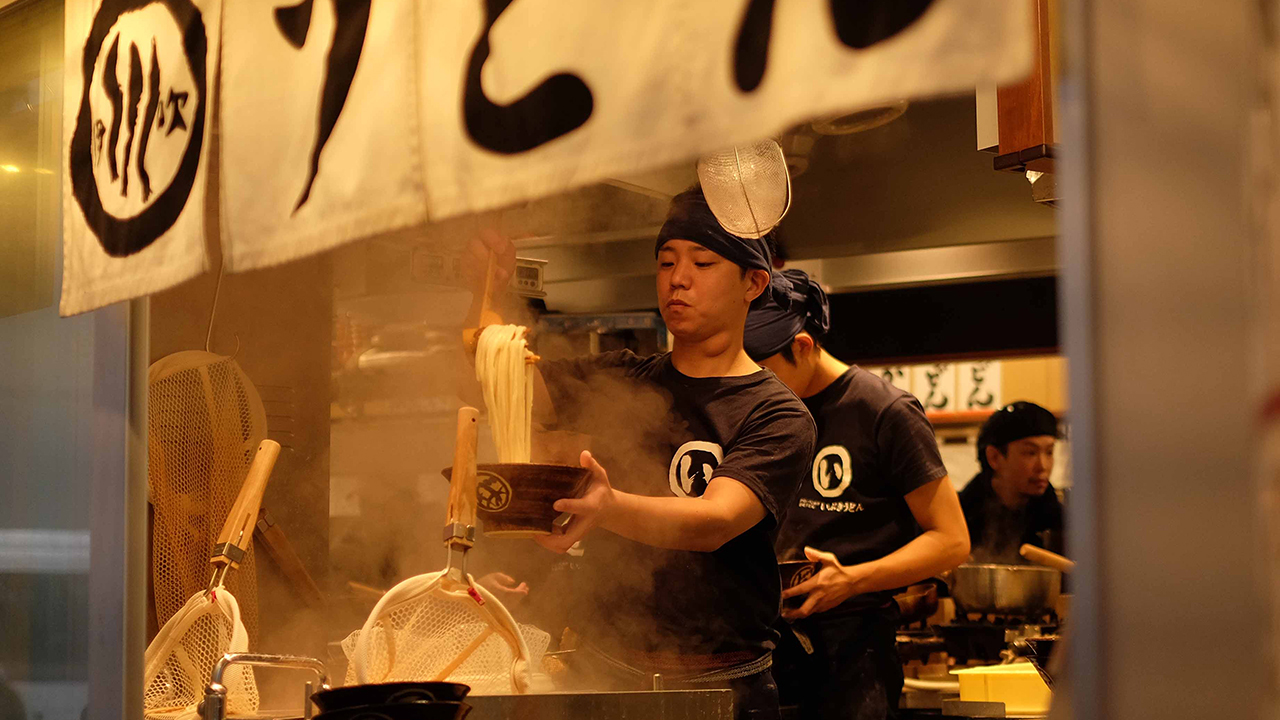
Best places to visit in Japan
Head to one of Japan’s tachinomi (standing bars) to try out kushikatsu (bamboo skewers of deep-fried meat and vegetables), along with delicious edamame and draft beer or sake. Other great street food to try includes okonomiyaki (savoury pancakes filled with grilled squid or pork) and takoyaki (fried octopus-stuffed dumplings). You’re likely to eat your body weight in kitsune udon (Japan’s beloved noodle broth), but for something a little different, try a kappo restaurant – for high-end, multi-course dining, without the formality of its kaiseki cousin.
On a solo holiday to Japan , outdoor pursuits, such as hiking along the Old Hakone Highway, or forest bathing in the bamboo trails of Arashiyama, allow a chance to unwind and appreciate Japan’s spectacular natural landscapes. Onsen hot springs, especially those that are found in remote mountain settings, are a delight. On the other end of the scale, you have the cities: who could resist the neon-bright lights of Osaka by night, or the cafes and ateliers of Tokyo’s arty Nakameguro district?
Finally, Japan is steeped in culture, and its ancient sights are not to be missed: make a beeline for the Great Torii floating shrine on the scenic island of Miyajima, along with the iconic red gates of Fushimi Inari shrine. Kyoto – Japan’s cultural capital – is a treasure trove of photogenic temples and lantern-lit streets.
Where to stay as a solo traveller in Japan
What are the hotels like in Japan? There’s a huge range to choose from on a solo holiday. Whether you’re looking for a boutique city retreat, a futuristic skyscraper or a rustic countryside guesthouse, this is a place that has it all. You’ll find everything from centuries-old rural ryokans with tatami-matt floors, onsite onsen and multi-course kaiseki meals to high-tech hotels in Tokyo. As a solo traveller, you’ll have more flexibility than most, but it’s still worth booking well in advance. Japanese hotels book up fast, especially in the cities and during peak seasons. On a group tour with Flash Pack, you bypass any hotel hassle and typically share a room with another like-minded solo traveller, thereby serving the single supplement. Still want a room of your own? That’s no problem, too.
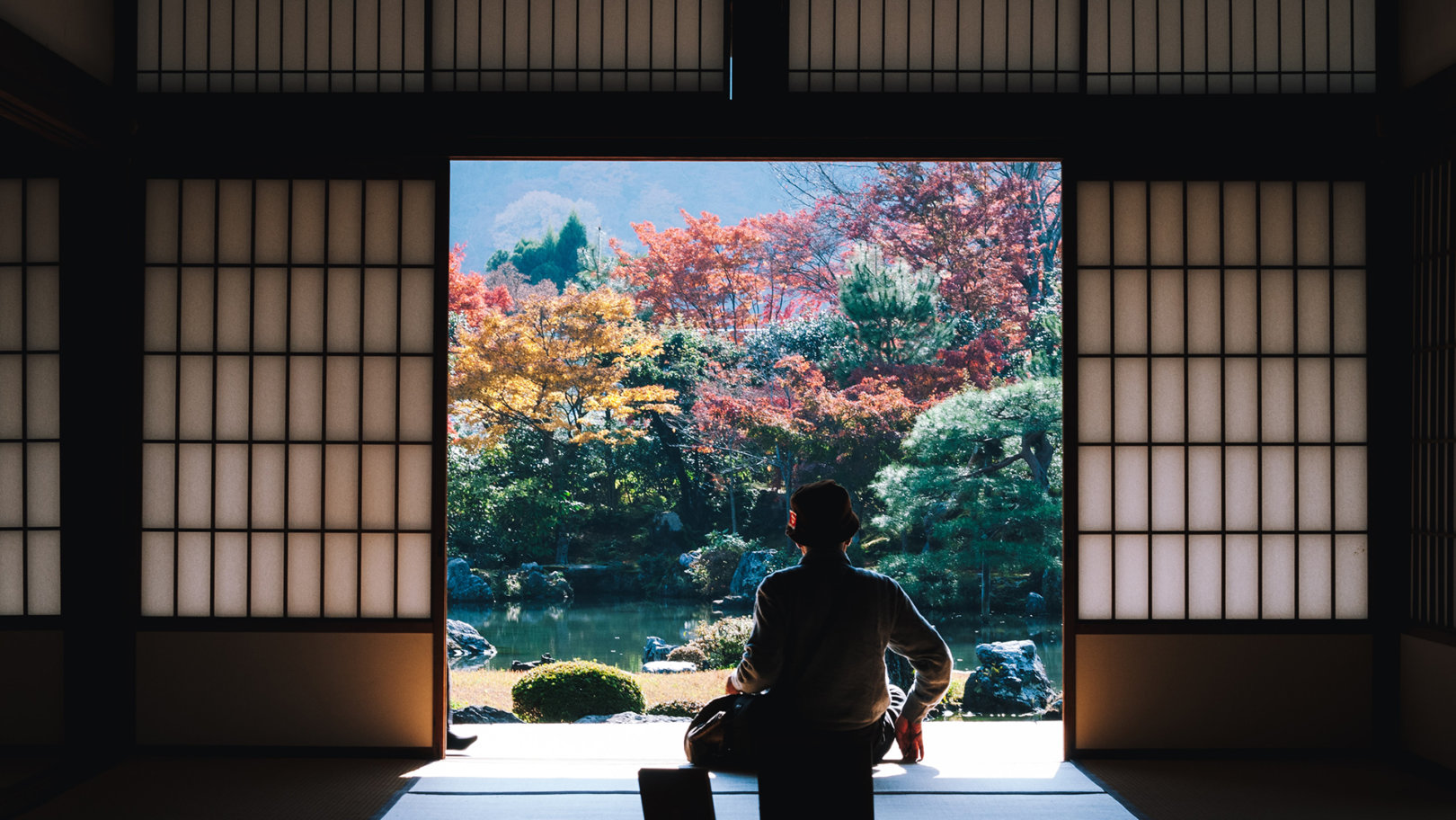
How to get to Japan
The simplest way to kick off your Japan solo travel experience is by flying. A number of airlines (including Japan’s ANA and Nippon Airways) fly nonstop from destinations, including the US, Canada and the UK to Osaka, Tokyo and Nagoya, all on Honshu island.
Another option is by ferry with Japan being accessible by sea. The main routes go from China and Korea, docking up in Osaka and nearby Kobe. Japan is an island country, but there’s a series of rails running from Europe that can eventually lead to Shanghai in China, where it’s possible to catch a ferry onwards.
How to get around Japan
Super-fast shinkansen (bullet trains) are the most popular means of getting around Japan, as well as arguably being the best. Indeed, the rail system is fast, efficient, reliable and one of the cheaper modes of transport. If you’re planning to travel for a month or so by yourself, it’s a good idea to purchase a Japan Rail Pass . These are exclusively available to tourists and offer great discounts on long-distance Japan Rail train journeys for one-, two- or three-week periods.
Japan also has a network of long-distance buses that connect the islands of Honshu, Shikoku and Kyushu. Another option is renting a car, which gives a bit more access to some of the national parks and nature-based attractions. Or ferries and domestic flights are easy to book. One of the biggest benefits of travelling with Flash Pack is that all internal travel is covered and planned ahead of time for you, whisking you from A to B without the hassle of organising transfers yourself.
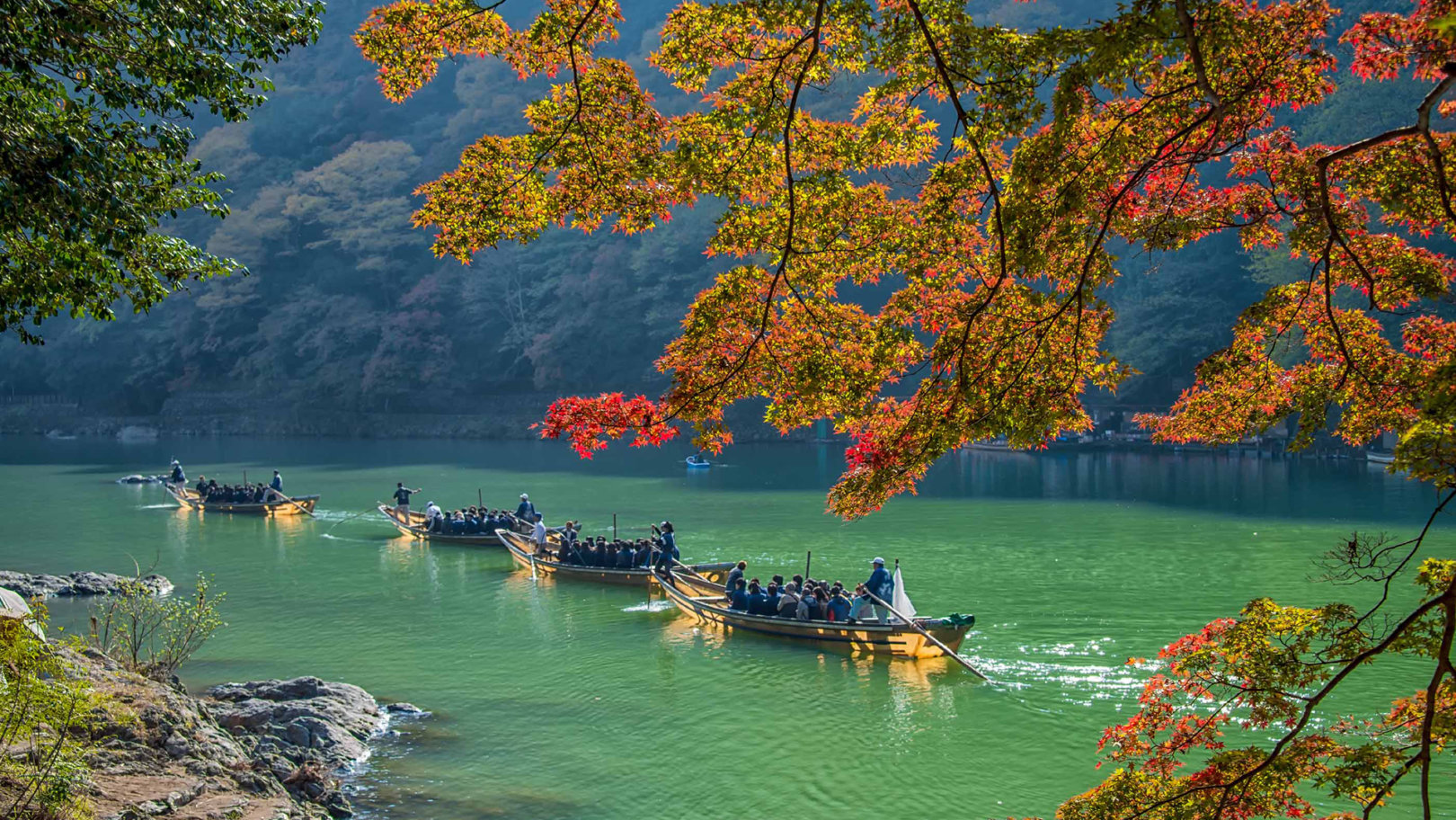
Best time to visit Japan
This really depends on what you’re looking for on a solo trip to Japan . Spring (March to May) is a beautiful time for seeing the famous sakura (cherry blossoms) and is peak time for travellers, though the weather is notoriously unpredictable, ranging from 4-18°C. Travelling during October and November is a great time to witness Japan’s koyo (autumn colours), with maple leaves turning fiery red and temperatures between 10-21°C.
Summers are hot and humid (usually 21-32°C) and can be a better time for hiking at higher altitudes in the southern region of Kansai on Honshu island, while being shaded under canopies of leafy green trees. Winter, meanwhile, is cold, coming in at sometimes sub-zero temperatures, with snow settling and Japan becoming a skiing destination – especially on Hokkaido.
Japan travel itineraries
Between the ancient Buddhist temples and futuristic cities, the mountainous hiking ranges and wistful winding rivers, there’s a lot that can be seen and experienced in Japan. Flash Pack’s Another World trip takes care of everything. Culture, cuisine and adventurous activities are all packed into the 12-day itinerary, with space for socialising and solitude between the unique activities. Land in Osaka to check out Japan’s foodie city (home to Wagyu beef) before learning about the history of Hiroshima and visiting a floating shrine on the little island of Miyajima. From here, there’ll be a temple stay and onsen bathing in Kyoto with a tea ceremony and geisha-led dinner, plus a ramen masterclass, sumo wrestling, sake, sushi and more throughout the rest of the days.
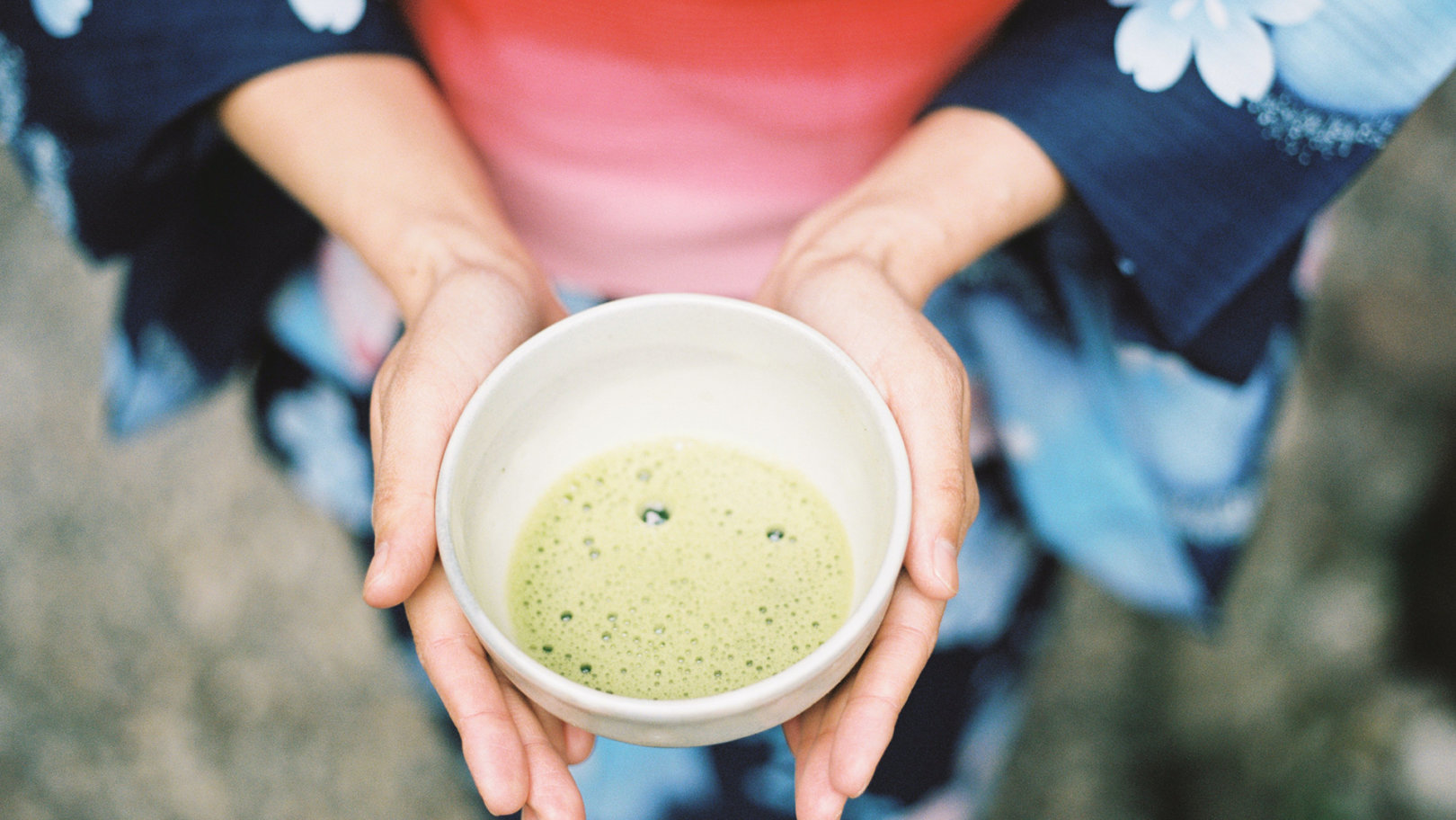
What to pack for solo travel in Japan
In short, it’s best to pack light for solo travel in Japan . Hopping on and off high-speed trains – which often have limited luggage storage – means a backpack or lightweight soft-shell wheeled suitcase is best. Inside, pack clothing to cover all climatic bases: lots of light layers, cotton tees, long-sleeved tops, light jackets and thin jumpers. Japan is still a cash-based economy in some places, so it’s good to have some Japanese yen handy, along with an extra credit card.
Solo travel advice for Japan
Japan, with its vast array of spiritual sites and serene nature trails, is the perfect place to regroup and reflect as a solo traveller. In almost every city you’ll find traditional landscaped gardens once used by Japan’s lords and leaders as a prime location for dwelling and dreaming.
Away from the hubbub, make a beeline for remote temples, forest-trailed mountains or islands peppered with picturesque rivers and castles. Ethereal waterfalls, vast flower-filled parks and striking alpine routes are also yours to explore. And, of course, Japan has a long tradition of onsen hot-spring bathing that is the very definition of solitude, often connected to classic Japanese ryokan (inns).
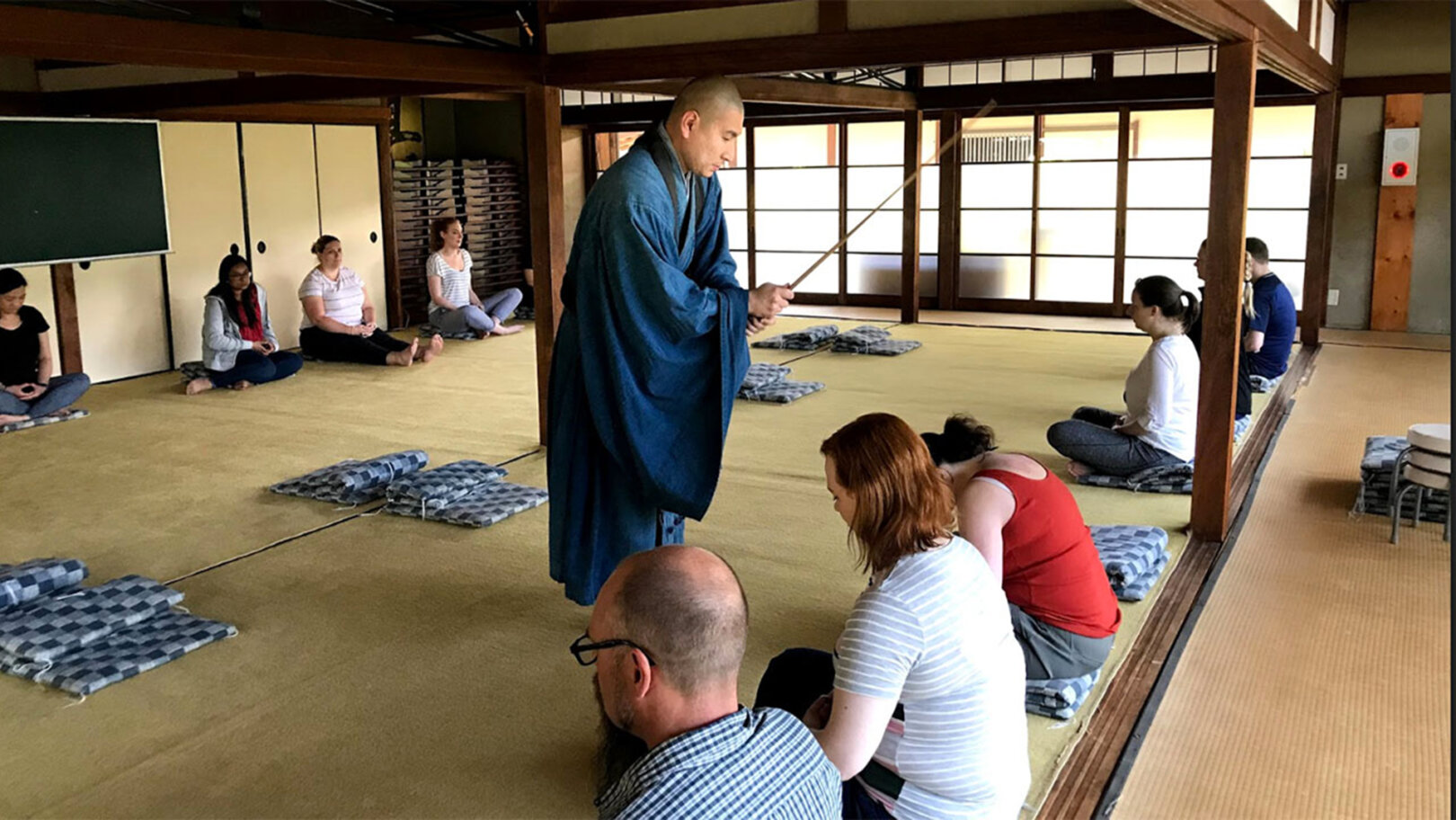
Is it safe to travel solo in Japan?
Thousands of visitors experience solo travel to Japan every year and most trips are trouble-free. However, do check out the Foreign and Commonwealth Office (UK), the Department of State Travel Advisories (US) or your country’s local government guidelines for the latest advice before travelling. Once there, follow local advice and be aware of your surroundings and belongings at all times.
Solo travel in Japan is all the more enticing thanks to its excellent safety record and low crime rates. Travelling solo is particularly normalised and catered for, including women-only spaces in spas or train carriages. For extra peace of mind, it’s always worth considering travelling with a group of other solo travellers.
Ready for your next adventure? Try group solo travel to Japan with Flash Pack – designed exclusively for people in their 30s and 40s, seeking the independence of solo travel within the safety of a group.
A cool 98% of Flashpackers arrive solo to join our group adventures . So, you’ll be in good company – whether a first time solo traveller or a seasoned pro looking for like-minded new friends.
Images: Flash Pack
The best places to go in April: Our top travel picks for a solo holiday
By Nina Zietman
FLASH PACK STORIES
Your latest travel inspiration

Sober curious? The unexpected joys of travelling alcohol-free
After giving up alcohol, writer Maggie Downs welcomed in a world of early morning yoga and geothermal swims.
Maggie Downs 29th August 2024 10 min read

Mental Health
Hiking in the hills of Cumbria turned me from an addict into a fell-loving foodie
Camp-stove cook, Harrison Ward – aka “Fell Foodie” – describes how hiking in the great outdoors helped him kick the booze for good.
Harrison Ward 29th August 2024 10 min read

“Living abroad as a blind woman, I felt accepted for the first time in my life”
Blind since birth, Heather Hutchison spent a year living in Lima, Peru – and discovered a newfound sense of belonging with the local community.
Heather Hutchison 22nd August 2024 10 min read

“The childfree woman is a symbol of freedom. Many people feel threatened by it”
Zoë Noble’s We are Childfree network is designed to empower her global childfree community. But the movement has faced opposition from some.
Zoë Noble 14th August 2024 10 min read
Subscribe to our newsletter
Sign up to our newsletter.
Hear about our new adventures before anyone else
Hear about our new adventures before anyone else.
Be the first to hear about exclusive Flash Pack offers.
Access exciting competitions.
Receive weekly inspiration and travel stories from solos just like you.
You are browsing our US website.
Please choose your current location below:
You are browsing our UK website.
Travelling alone in Japan: Our top tips for a solo trip 日本での一人旅
- Published on : 11/08/2023
- by : Marion
- Add to favorites
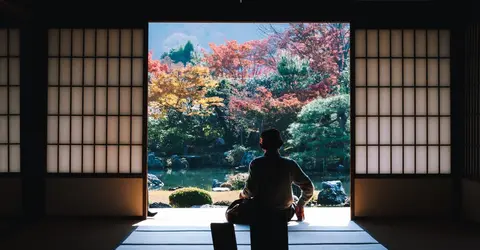
Freedom, cultural immersion, and unforgettable encounters: solo travel in Japan will be an experience like no other. Discover a place where every step will lead to a unique adventure, where spontaneity and authenticity come together. Travelling solo in Japan means freeing yourself from constraints to immerse your body and soul in a fascinating culture, where discovery and wonder are around every corner. Explore the bustling metropolises, be surprised by the local flavors, and vibe to the rhythm of this country that is steeped in tradition and modernity, all in total freedom.
Today, more and more people are embarking on solo travel to Japan. Indeed, it's not always easy to travel in a group and prepare a trip to a country like Japan, with all the demands and availability of all those involved, and once you're there, organizing your trip will also be a headache. The idea of going at it alone may have already crossed your mind. And it's a good idea! Japan is a country where it's extremely easy to visit and travel solo! Historically, Japanese domestic tourism was very much based on business-related manners. So, Japan is a place that has adapted to the many solo travellers who come to spend a night or two in a given place for work or leisure. So you will be able to see many places adapted for solo travelers, such as hitori restaurants (restaurants for solo dining), hitori karaoke (karaoke for one), hitori bars (bars you can enter alone), or Japanese capsule hotels where you book a single bed in a dedicated pod instead of a room!
But if you'd rather meet people during your trip and share an evening, an adventure, a drink, or any part of your journey, there are plenty of possibilities to meet other people too! In this article, you'll find all our tips for solo travel in Japan to optmize your stay, whether you want to enjoy your trip on your own or meet up with fellow travelers on the spot!
Discover our "Japan solo" tour!
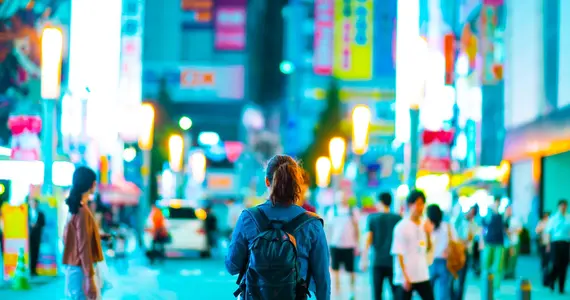
Solo Travel in Japan Self-Guided Tours in Japan
What are the typical obstacles or worries about going travelling alone?
Travelling alone to a faraway country, especially when you don't necessarily master the language, will give rise to quite normal apprehensions. These doubts, questions, and anxieties mainly revolve around the language barrier, the safety of traveling alone in the country, social isolation and the general organization of the trip.
Do I need to speak Japanese or English to go to Japan? The answer is no! The language barrier may seem insurmountable, but it's not. If you don't speak Japanese, and you're not fluent in English, don't let that stop you from paying a visit to the country! In a place like Japan, English may not be as widely spoken or used as much compared to many western countries, and many will find it difficult to understand and respond, however, your best bet for communicating and understanding what's going on around you will be your phone (find out about the different options for accessing the Internet in our guide ). With instant translation applications for Japanese like Google Translate or Yomiwa , you will be able to communicate, but with the camera option, you'll also be able to translate Japanese road signs, restaurant menus, or documents written in Japanese without any hassle! What's more, if you stay in Japan's major cities, you'll almost always be offered language options in English. If your interest in Japan extends to studying the Japanese language, solo travel to the country itself will be one of the best ways to practice your Japanese in an authentic environment. Be sure to practice your Japanese as much as possible during your stay!
Travelling solo without being completely alone? Solo travel doesn't necessarily mean being alone the entire time, as you will be able to meet many different people during your vsiit, be it other travelers or Japanese locals! Social isolation and loneliness are also the main fears of solo travelers, especially those who are very sociable and extroverted by nature. However, there are many ways to meet new people during your trip, whether for an evening or as a travelling companion. One way is to stay in youth hostels or sharehouses , where many travelers, usually solo, are ready to share their adventures, do activities or book multi-day excursions. You can also check out sites like MeetUp or Tokyo Gaijins , which organize meetings and activities all over Japan! But also take the opportunity to talk and meet with locals at bars or restaurants and share the experiences you've had during your vsiit!
Is it dangerous to travel solo in Japan? In terms of safety, Japan is one of the safest countries in the world. Japan has a relatively low crime rate, though it's always good to practice caution regardless of where you travel to, and be sure to trust your gut and practice caution if you're ever in doubut. Japanese culture is also world-renowned for its emphasis on respect for common rules and other people's property. If you lose your precious belongings in transit or on the street, go to the lost and found counters (忘れ物 wasuremono), where they may already be waiting for you.
Do I need a visa to travel to Japan? No, if you hold a passport from places like countries in Europe, the United States, or Canada , you will be able to visit for up to 3 months (90 days) as a tourist without needing a visa to enter Japan. For passports from other regions, we advise you to check your eligibility on the Japanese embassy website.
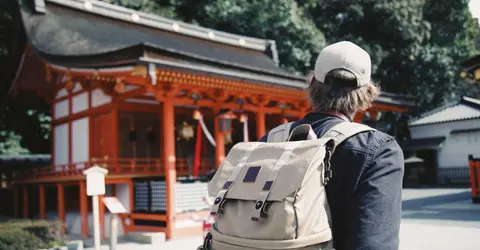
Tip 1: Plan your trip in advance... but not too much!
It's important to find out all you can about the country you're going to, so that you can define your expectations for the duration of your trip and find out everything there is to see. It would be a shame to miss out on a superb temple or a festival that only takes place once every year. However, it's far from ideal to plan your schedule hour by hour. It's important to let yourself be carried along by opportunities and encounters, and not to close yourself off to the unexpected. Visit a city or town and let yourself be carried away by its atmosphere and attractions. That way, you'll be able to unearth some rare gems!
Our travel tip: Find out about all the attractions and places to visit in the cities on your itinerary, as well as excursions in the surrounding area. Select the ones you want to do, then let explore based on such!
Tip 2: Pack light!
Don't overpack! It's often said that you should leave for Japan with an empty suitcase to make room for all the things you'll be buying on the spot, and it's true! Going to Japan is a big trip, and you often want to bring back a whole bunch of souvenirs, and share your trip with your loved ones. But even if you don't plan to be tempted by everything you can find there, pack light. It may seem obvious, but you'll soon find yourself bogged down and cluttered in Japan. In many small stations, in town and country, there are not always elevators or escalators. Y ou'll have to carry your suitcases up and down the stairs, and sometimes there are a lot of them, especially in stations !
Similarly, space per person is more limited in Japan. Trains and subways don't necessarily leave room for suitcases, especially during rush hour. You'll have a hard time getting around on public transport and won't have a very pleasant trip.
The ideal solution is a practical, compact backpack! If you prefer to travel with a suitcase, one will suffice! You can even opt for just a carry-on if you feel its appropriate for your visit!
Other things to know :
There are coin lockers where you can leave your luggage and visit the city without carrying anything around. If you can't get to your hotel to leave your luggage there, this is also a good alternative.
In Japan, there's a service known as Takkyubin , a luggage delivery system for travelling light, so you can collect your bags directly from the address you specify, wherever you like!
Tip 3: Choose the right hotels
When traveling solo, hotel reservations can be your most costly expense, as you can't split the price. However, in Japan, there are many different ways to keep costs down, but also to meet new people and make friends!
Capsule hotels
Opting for a capsule hotel in Japan is ideal for solo travelers, thanks to its economy and practicality. These compact, capsule-like private spaces include a bed, lamp, safe and small storage space, always guaranteeing sufficient privacy. In these capsule hotels, amenities such as shower rooms, kitchen and rest areas are shared, encouraging interaction and the possibility of finding fellow travelers if you wish!
Youth hostels or guesthouses
Guesthouses are very popular in Japan, easily available in Tokyo's numerous districts and countryside. Affordably priced, they offer comfortable accommodation ranging from private rooms to shared dormitories, making them an excellent alternative to hotels. You can share convivial moments with travelers from all over the world and make new friends. What's more, unlike hotels, hostels often offer activities, outings and evenings out, allowing you to immerse yourself in the local culture and receive invaluable advice from locals on how to explore the most interesting places.
Ryokan, traditional Japanese inns
During your stay, you'll probably want to try out a ryokan, a traditional Japanese inn. Rooms can be relatively expensive. However, some ryokan offer comfortable dormitories. This way, you can enjoy the comfort and experience of a ryokan with all its conveniences: traditional architecture and, of course, warm onsen , at a lower cost.
Tip 4: Optimize moving around!
There are many ways to get around Japan, including its highly-developed train rail network. The Japan Rail network will take you to every corner of Japan. Make the most of it! Analyze your needs and decide on the most appropriate itinerary. If you're taking the train, the Japan Rail Pass is an economical and practical option for getting from one end of the country to the other quickly. Train travel in Japan is some of the most praised in the world, and it's definitely optimal for solo travelers looking to get all around the country quickly and easily. Feel free to explore the different options between the national JR Pass and the regional JR Passes.
If you're planning a solo trip to Japan before December 31, 2023, make sure you book your Japan Rail Pass before September 30: on October 1, the price of the pass will increase significantly. But since a JR Pass can be used within 3 months of being ordered, you'll be able to activate it and travel around Japan by train until December at the best possible price.
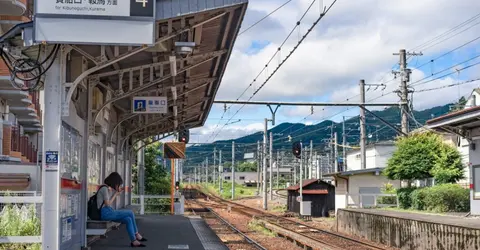
If you're planning to drive when you travel to Japan, especially in remote areas such as Okinawa or other rural prefectures, where public transport is much rarer, remember to have your driver's license translated if needed. This is a mandatory procedure for driving in Japan for some nationalities, France included.
And don't hesitate to explore the various transfer options available from the airport to help you get around more smoothly. There are numerous means of transport linking Haneda or Narita airport to central Tokyo, as well as from Kansai airport to central Kyoto or Osaka. A good idea, especially if you're leaving early in the morning or want to avoid unforeseen events on the road.
Tip no. 5: Eat alone? You bet!
Japan is a country that is largely accessible, even when alone. For the more introverted among us, it's a wonderful opportunity to enjoy your time without having to socialize. While in the West, eating solo in a restaurant can sometimes feel uncomfortable, this is not at all the case in Japan. Eating alone is even normal . A whole host of facilities are designed to ensure that you don't have to communicate or socialize at all if you don't feel like it. You can even find restaurants that have made this their specialty, offering barbecues for solo customers (where two are usually required), restaurants that do not require interactions with wait staff, or even tables for one person only!
Tip no. 6: Book your own activities
Whether in a group or on your own, experiential travel activities a great way to discover the country and its culture . From cultural activities such as a tea ceremony in Kyoto's old town or a sumo show in Nagasaki, to nature excursions such as hiking in national parks or cycling around the lakes of Hakone near Mount Fuji, there's something for everyone, all over Japan. You can also sign up for group excursions , which take place over 2 or 3 days and during which, under the guidance of a local guide, you set off to discover a particular place or cultural theme. So, for example, if you've always dreamed of spending the night in a temple with Buddhist monks, this is possible as part of an excursion.
It's also a great opportunity to meet other travellers with similar interests.
But be careful. Safety is always first and don't take any major risks ! If you want to hike solo or go swimming where there are no locals, check with the locals or tourist offices beforehand. Some of Japan's forests and national parks are home to wild animals such as bears, and currents and tides may also surprise you if you are around teh coast.
Tip 7: Stay connected!
In Japan, it's best to stay connected. It'll save you a lot of trouble on the road. Whether it's finding your way with Google Maps, asking for information, translating a menu, booking a train ticket or finding the address of a good restaurant or an activity to do in the area, you'll hardly be able to do without the Internet, especially to show the people back home all the amazing stuff you're up to!. You will find wi-fi in cafés and konbinis, and even at the top of Mount Fuji, believe it or not.
There are 3 options: buy a Japanese sim card for data, pocket wifi, or expand your network internationally with your operator , but this last option is generally the most expensive. If you're traveling solo, the best and most economical option is the sim card.
Some other things to know :
You can use some Google Maps functions offline to save data.
The MapsMe application is also a good alternative. It allows you to download maps in advance, so you can use them offline afterwards.
To find out more about our SIM cards, click on the product page.
Tip 8: Get off the beaten track!
You're on your own, so make the most of it! You won't have to convince anyone to go anywhere with you, and booking transportation and hotels will be much easier. Get away from the golden route (Tokyo, Kyoto, Osaka, Hiroshima) and visit some of Japan's more remote areas, and discover some of the rare gems that are less popular because they're less accessible. In just a few hours by train, car or plane, for example, you can visit the marvellous island of Hokkaido in the north of the country, famous for its abundant snow in winter and its fields of flowers in summer. Above all, it's an excellent place to escape the high temperatures and humidity of the Cape during the summer months. The Japanese Alps are also a magnificent region to discover for lovers of the great outdoors and tradition, the island of Shikoku for spiritual enthusiasts, with its famous pilgrimage of 88 temples, and the Tottori region for its sandy dunes.
Japan boasts a myriad of very different landscapes and a rich history: it's up to you to discover and explore this fascinating country, on your own, according to your preferences!
In conclusion, it's very easy to travel to Japan on your own. Whether you want to discover the country on your own, or meet new people and share unforgettable moments, there's something for everyone. With the help of our many tips, you can tailor your trip to suit your desires!
Latest Articles

Hiroshima Sightseeing Loop Bus: Your Ultimate Guide to Exploring the City
The Hiroshima Sightseeing Loop Bus , locally known as めいぷるーぷ (Meipuru-pu), is an excellent way for tourists to explore Hiroshima.

Summer travel in Japan
Summer in Japan is a season of simple beauty and deep cultural significance.

Hiroshima Trams: A Comprehensive Guide to Japan's Longest Streetcar Network
Welcome to the world of Hiroshima's iconic trams, an integral part of the city's history and modern-day transportation.
All the themes of the city
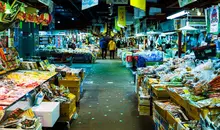
Markets in Japan

Onsen, Hot Springs and Public Baths
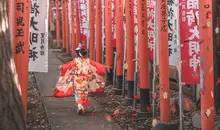
Family Travel
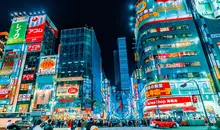
Nightlife in Japan: Going out, exploring and drinking

Temples and Shrines
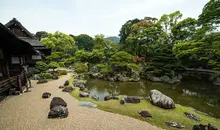
Parks and Gardens
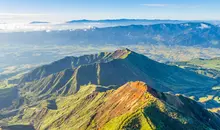
Outdoor Activities

Museums and Galleries
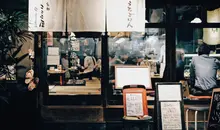
Restaurants and Cafes
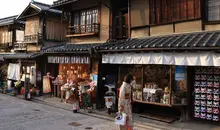
Shopping and souvenirs
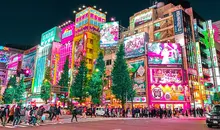
Japanese Pop Culture
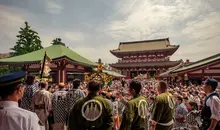
Events and Festivals
Please select your country on the list below:
- Switzerland
- United Kingdom
- Other countries
- Account and Profile
- Newsletters & Alerts
- Gift Subscriptions
- Home Page U.S. & World | Regional
- White House
- Courts and Law
- Monkey Cage
- Fact Checker
- Post Politics Blog
- The Post's View
- Toles Cartoons
- Telnaes Animations
- Local Opinions
- Global Opinions
- Letters to the Editor
- All Opinions Are Local
- Erik Wemple
- The Plum Line
- PostPartisan
- DemocracyPost
- The WorldPost
- High School Sports
- College Sports
- College Basketball
- College Football
- D.C. Sports Bog
- Fancy Stats
- Fantasy Sports
- Public Safety
- Transportation
- Acts of Faith
- Health and Science
- National Security
- Investigations
- Morning Mix
- Post Nation
- The Americas
- Asia and Pacific
- Middle East
- On Leadership
- Personal Finance
- Energy and Environment
- On Small Business
- Capital Business
- Innovations
- Arts and Entertainment
- Carolyn Hax
- Voraciously
- Home and Garden
- Inspired Life
- On Parenting
- Reliable Source
- The Intersect
- Comic Riffs
- Going Out Guide
- Puzzles and Games
- Theater and Dance
- Restaurants
- Bars & Clubs
- Made by History
- PostEverything
- Entertainment
- Popular Video
- Can He Do That?
- Capital Weather Gang
- Constitutional
- The Daily 202's Big Idea
- Letters From War
- Presidential
- Washington Post Live
- Where We Live
- Recently Sold Homes
- Classifieds
- WP BrandStudio
- washingtonpost.com
- 1996-2018 The Washington Post
- Policies and Standards
- Terms of Service
- Privacy Policy
- Submissions and Discussion Policy
- RSS Terms of Service

7 lessons I learned while traveling by myself

It was barely five in the morning when I realized I made the first mistake of my trip to Japan. I’d left the laptop (that I needed to work remotely) behind at home, and only discovered the nightmare when I was more than halfway to the airport. Travel upsets two and three came later — some my fault, others out of my control. The only thing that comforted me was the fact that I was traveling alone.
If I were traveling with others, things would have been exponentially more complicated. But forgetting important things? My problem alone. Flight delays? My stress alone. Holding up the line at immigration because I didn’t write down my Airbnb address correctly? My shame alone.
The discomfort is part of the allure. Despite those early-morning hiccups, I eventually made it to Japan. My fifth trip to the country. I love to travel by myself anywhere, but I think Japan in particular is one of the best places on the planet for solo travelers because, in many ways, the country is optimized for solo success.
You can nestle into a solitary routine without judgment. In the morning, you’re not some person sitting by yourself at breakfast. You’re one of eight sitting by themselves at breakfast. In the evening, you’re just another solo bather at the public hot spring. You can eat alone, drink alone, see a baseball game alone. Doing things on your own here is standard.
That doesn’t mean traveling alone in Japan is always easy. Like anything, traveling by yourself comes with its own highs and lows. But there are lessons that can help you navigate the challenges.

Dreamy afternoon light falls on festivalgoers at Awa Odori. (Irwin Wong for The Washington Post)
Fight the urge to get on your phone when you’re feeling shy.
The smartphone is the perfect travel companion. It’s there when you’re lost, providing a map to guide you home. It’s there when you’re lonely, connecting you with friends and family at home with a few taps. It’s there when you’re bored, offering you infinite ways to pass the time.
But if I give into the siren song of my iPhone, I won’t talk to anyone new. They’re not going to want to talk to me, either. From my experience, strangers in Tokyo will generally respect your privacy and leave you alone unless they get the sense you’d like to chat — unlike my experiences in American dive bars or Scottish pubs, where the default is for locals to strike up conversation.
(Monica Rodman/Natalie Compton)
After two snack dinners during my first full night in Tokyo, I walked back to my home-base neighborhood with a nightcap in mind. I ambled around until I spotted a bar entrance that looked like a theme-park version of a dungeon. Bernard Herrmann’s “Twisted Nerve” played eerily as I ascended the nearly pitch-black staircase up to the second-floor bar. Walking into the smoky unknown felt like being in an old Western movie — that cliche scene where the new guy walks through the saloon doors and the piano stops. I eased myself onto a teetering stool at the bar.
My first inclination wasn’t to talk to the other customers. What was stronger was the urge to get out my phone and hide inside its glowing warmth. Doing so would have cut me off from the people curiously glancing at me, seemingly the only American in this pseudo-dungeon. So I stared — straightforward, sometimes at the bottles on the back bar, sometimes at the decor. I had a mini smile plastered on my face to tell the others, “Hey! I’m friendly!”
My approach worked. I placed a drink order in English but peppered in what Japanese I know, alerting the bar that I couldn’t speak the local language but was sociable and would try. The bartender then asked me where I’m from, and with my answer, another bar patron asked me what I was doing in Japan. A drink later, he was telling me about a woman from Okinawa he had a crush on, asking me for dating advice.
Accept that no matter how hard you try to fit in, you’re going to stand out.
Sometimes I’ll have the confidence to walk right into a place, like a dungeon bar, without too much thought. Other times, I’ll circle the block a thousand times, then worry that someone might have noticed that I’ve been circling the block. I’ve walked into establishments, panicked at how small or crowded or confusing they were, and turned around to leave as quickly as I came. I have done this, feeling like a loser, on about a thousand occasions.
In case it wasn’t already clear, I have a tendency to overthink things when I’m traveling alone. Normal activities like choosing a restaurant become paralyzing obstacles. Suddenly I feel more like a burden than a customer. Is the staff going think I’m a hassle because I can’t speak or read Japanese? But between me and the server or chef, I’m probably the only one panicking. I try to remember this when I finally wince my way into a restaurant to eat.

An afternoon at the restaurants under the railways of Kōenji, Tokyo. (Irwin Wong for The Washington Post)

Food at the Awa Odori festival. (Irwin Wong for The Washington Post)
An afternoon at the restaurants under the railways of Kōenji, Tokyo. (Irwin Wong for The Washington Post) Food at the Awa Odori festival. (Irwin Wong for The Washington Post)
Sure, you may be treated differently as a tourist. There are places in Tokyo that cater only to regulars or are only open to paying members. A business would rather nurture its relationship with local regulars, making sure a spot is waiting for that dependable customer, than take a risk on a foreigner who may never come back again. Don’t take it personally if they turn you away. There are more restaurants and bars in Tokyo than you could ever get to in a lifetime of eating and drinking to get upset over one.
Knowing that doesn’t always stop the self-consciousness from making me anxious while traveling. When that doubt strikes, try to acknowledge the feeling and move forward. Once you rip off the Band-Aid, and just respectfully and politely do the thing you’re worried about, everything will be fine.
Frequent self-service restaurants.
If anxiety is really getting the best of you, seek out environments that are especially catered toward isolated experiences. In Tokyo, that meant visiting self-service restaurants.

(Robin Ha for The Washington Post)
Things generally feel more efficient in Japan, and that includes dining. You’ll find restaurants with automation systems or vending-machine ordering all over town, eliminating the need for full service.
They also eliminate a lot of the difficulty of eating at a restaurant as a foreigner. Simply walk up to the vending machine, place your order, pay with cash (or a Tokyo public transportation card like Pasmo if you have one) and hand your receipt to available restaurant staff. They’ll bring you your food when it’s ready. No confusion over the check. If you have questions about what to order, choose the top left item on the vending machine. Restaurants will usually put their best-known dish in that location.
Talk to everyone and go with the flow.
A friend of mine once mentioned that trying to meet strangers on a solo trip felt like cheating. Aren’t you supposed to be alone? As an extrovert, I disagreed. Traveling alone enables you to do whatever you’d like, whenever you’d like. It’s indulgent, but it doesn’t have to be isolated. I feed off of people and conversation.
So when a friend put me in touch with his friend who lived in Tokyo, I was filled with joy. A human being! To talk to! On my way back to my Airbnb one night, I got a message from him inviting me to hang out. My joy was coupled with hesitation. Sometimes these types of meetings go perfectly; you connect easily and see why you have your mutual friend in the first place. But it can also feel like an awkward first date.
With that risk in mind, I went to meet the stranger. My goal when traveling alone is to be a human piece of driftwood, going with the flow to see what happens. I try to say yes to everything.
At the bar, the friend of my friend introduced me to more people in his group. We all got along fast. A drink later, we moved on to a new place a few blocks away.

Street snacks at a festival in Koenji: bacon-wrapped lettuce and fried chicken. (Natalie Compton/The Washington Post)

A fruit vendor selling seasonal produce in Kichijōji, Tokyo. (Natalie Compton/The Washington Post)
Street snacks at a festival in Koenji: bacon-wrapped lettuce and fried chicken. (Natalie Compton/The Washington Post) A fruit vendor selling seasonal produce in Kichijōji, Tokyo. (Natalie Compton/The Washington Post)
A woman in the group asked me if I’d been afraid traveling alone in Japan. In terms of safety, I hadn’t at all. Tokyo is regularly ranked the safest city in the world. But of course, safety isn’t always guaranteed, particularly as a woman. You have to be aware of your surroundings wherever you go and make a judgment call on whether the rewards outweigh the risks. Pay attention to travel advisories , make sure to check in with friends or family members during your trip, and trust your gut instinct. If a situation doesn’t feel right, don’t feel the pressure to stay.
Embrace language barriers.
Traveling alone gets exponentially more challenging — and more interesting — when you don’t speak the local language. You can’t ask for directions casually. You can’t read signs in shop windows. You can’t understand what your taxi driver is trying to tell you. Language barriers can be part of the fun, or they can be deeply frustrating.
With enough hand gestures, you may be able to get your point across. Because it’s 2019, technology also helps. In real-time, there’s Google Translate and pocket translation devices, which aren’t perfect but can be an aid. With a couple attempts at adjusting your phrasing, you can sometimes find success using such technology.
If you aren’t conversationally fluent during your solo adventure, you could run into hurdles. But I’ve found that in most places, you get what you give. Initiating conversation using a few basic words or phrases shows others that you’re making an effort, and it could even encourage people to try out their English with you. Before embarking on a trip, spend time beforehand practicing and absorbing as much of the local language as possible. Download a few language-specific apps to have on-hand, too.
(Using Google Translate. Video by Natalie Compton.)
I could have used more Japanese practice before my dinner at a high-end restaurant called Sushi Sugaya. It became clear pretty quickly after I sat down at the seven-seat restaurant that there would be no English spoken at the meal, which is to be expected when you’re eating Japanese food in a Japanese restaurant in a Japanese city.
As each course was placed on the gorgeous Kiso hinoki cypress counter, the head chef, Takayuki Sugaya, explained in impenetrable Japanese what lay before us. My fellow diners were clearly impressed, nodding thoughtfully throughout the briefing. Meanwhile, guilt coursed through my veins with every new dish, fearing the chef might think his food was wasted on a foreigner who didn’t understand.
In that setting, Google Translate wouldn’t have worked. I would have killed the church-like mood of the experience and slowed down the service. It came in handy during more routine interactions, like when trying to buy things or asking specific questions.
When your translation apps fail you, stay patient and be flexible. Point to something on a menu and see what happens. Thank the person and try getting what you need somewhere else, or try to make your request more simple. Do your best to make your efforts work, but don’t beat yourself up if they don’t.

Natalie Compton navigates the trains. Google Maps was central to finding her way around them. That being said, good signage is all around the train stations to help tourists. (Irwin Wong for The Washington Post)
Take public transportation.
Although Google Translate can be spotty, Google Maps is a godsend in Tokyo, particularly when it comes to navigating public transportation. Because taxis are expensive in Tokyo and the city is huge, you’ll probably find yourself on the train a lot. Google Maps will tell you exactly when the train is coming, what platform you need to be on, what car is best for transferring at your connecting stop and how full the train is likely to be (so you can avoid claustrophobia-inducing rush-hour train travel).

Even without Google’s help, you can figure out the trains of Tokyo thanks to the ample signage at metro stations and attendants who might not speak English but are willing to help you, regardless. But using the app makes me feel a little more independent and a little less helpless. It’s an opportunity to learn more about the day-to-day life and habits of people there.
Do as the Romans do, even if you might fail trying.
Many of us are compelled to try to see a place like a local. We don’t want to be the obvious tourist, sticking out with a paper map like a sore thumb. We want to find the hole in the wall. We want to fit in.
I am not able to do this in Tokyo. I’m clearly a foreigner there, and there are parts of Japanese culture that I’ll never be able to replicate, although I try to fail to do so. Like when I tried to slurp ramen like the people around me, and immediately sent soup flying everywhere, scalding my face and legs with pork broth. I knew I was doing it wrong, I just wasn’t sure how. With my next big slurp, I inhaled broth down the wrong pipe and started choking on soup, which is even further from the way locals do it.

The family area of Awa Odori. (Irwin Wong for The Washington Post)
These lapses in blending in remind me that I will always be an outsider when I travel. You cannot shove a square peg into a round hole. What you can do is try your best not to be an offensive outsider, and emulate respectful behavior. You don’t have to capture the subtle je ne sais quoi of a Parisian’s chic wardrobe; just don’t shove your way through the Louvre.
Traveling alone can mean more confusion and more stress, but also more opportunities to have incredible experiences and meet new people. You get a chance to learn things about yourself, to face fears, to have adventures to write home about or keep as your own travel secret. Do you want to sleep in until noon? Perfect. Do you want to walk 15 miles around a city? Great. There is no compromising to be done in a party of one. No keeping up or falling behind. You’re the master of your domain.
Natalie B. Compton
Natalie Compton is a staff writer for the Washington Post's new travel destination, By The Way.
More stories
A local’s guide to Tokyo
A Tokyo local's inside tips on where to stay, what to do and where to eat.

Staying in a historical Japanese temple is an extraordinary experience. Here’s how to do it.
Religious Japanese travelers have stayed in Buddhist temples for years, but now "temple stays" are available to foreign tourists. Skip the hotel and see the country in a way the masses don't.


Get Lost and Found on a Solo Journey Through Japan
Surfer babes and jazz clubs invite you to come as you are..

Japan is not the most straightforward country to travel through alone. There are great swathes of the country where no one speaks English. You will get lost. You will feel at odds with yourself, disoriented in a body of translation that might make you panic and feel as lonesome as ScarJo at the Hyatt . My advice: Make Google Translate your friend, have multiple battery packs on hand, retain composure, and trust the process that is Japan on your own.
After all, there’s so much reward to be reaped. A journey through Japan feels life-affirming, personal boundary-breaking, and answerless. Japan is itself a philosophy, and by the time you come home, you’re so humbled by its marvelousness that it’s almost too cringe to talk about. But, alas, here we are.
Whether you head north towards Hokkaido, south to Okinawa, east for Tokyo and Karuizawa, or west in the San’in region, there will be feasts aplenty instore for the eye and mouth. Foreign tourists swear by the JR Pass , which offers unlimited transport (including bullet train and local buses) for one week, two weeks, or 30 consecutive days, starting at $215 or $287 first class (dubbed the Green Pass). To rent a sub-compact car is around $50 a day, and while tolls can be hefty, driving would be recommended for the western arm.
Whichever way you choose to roam, here are the islands around Japan to suit your personality, whether that’s surrounded by rugged hikers, beach bums, jazz cats, or shōchū drinkers. Here’s where to find your people or find yourself in Japan.

Hike in national parks and mountains in Hokkaido
Hokkaido is for mountain lovers. On this northern island, you’ll find at least six national parks , fresh powder, famous pumpkins, and (as it turns out with most things Japanese) plenty magic in between. For outdoorsy-meets-foodie folks, Niseko Village sits in the foothills of the 4,292-foot Mount Niseko Annupuri and is teeming with stuff to do for lone travelers. During the ski season, you can apres with the finest sushi platters and omakase money can buy, shop around the village’s fancy stores, or head out to explore Sapporo’s breweries, Nikka’s celebrated whisky distilleries, and Otaru’s luxe seafood scene.
In the green season, ogle the dazzling sakura trees in full bloom, kaleidoscopic fruit orchards, and meadows peppered with ume (plum), narcissus, fawn leaves, and Japanese wisteria. Set out on a hike or team up with others to go white water rafting down the Shiribetsu River with staggering views of Mount Yotei, all safely facilitated with robust regulations and procedures.
Later, decompress at the sleek and sophisticated Higashiyama Niseko Village , a Ritz-Carlton Reserve boasting snowy-view glass windows from sunken tubs in silk- and hardwood-laden suites for one. For something more low-key, bask in the alpine softness of Kasara Niseko Village Townhouse or consider booking a room at The Green Leaf , home to a sprawling spa and onsen to soothe any aching muscles .

Admire surf and sea in Okinawa
Maybe you recognise the name of this archipelago from Kill Bill Vol 1 , when Uma Thurman wanders into a beachside sushi shop for a chat about swords. Regardless of whether or not you're into Tarantino films, Okinawa Prefecture is a place worthy of such an elaborate tale, with its dedication to nature and age-old tradition. To get there, you can either fly two and a half hours from Tokyo or take the Shinkansen to Kagoshima and catch the ferry to Okinawa.
Made up of 160 islands, Okinawa boasts some of the most secluded reaches of Japan. But it’s far from skimping on beach accommodation. In the capital Naha on the main island (the best of the 59 inhabited islands for solo travel ease and options), you can rent a bedroom with a shared bath for as low as $22 a night—one of the many perks of traveling alone—and your homebase will be within throwing distance to the beaches, where Okinawan surfer babe life thrives. You’ll find a number of kitschy, colorful hotels like Sun Palace , with a facade as brilliant and welcoming as its staff. Or there’s Hotel Palm Royal Naha Kokusai Street , with its pink and blue accents, neon pool sign, and palm trees. Upgrading at either of these hotels, even with tatami mat areas and breakfast included, will still cost you less than $100.
In addition to sun and sand, there’s a strong underwater scene here, where diving schools and scuba sites cluster around the magnificent coves, capes, reefs, and even underwater monuments like Yonaguni . The Kerama Islands’ marine national park offers other-worldly sights for divers, including coral, tropical fish, manta rays, and octopus.
As for eats, try the cold soba noodles and goya champuru (stir-fried melon). And if you get the chance, the green turban (giant sea snail) is another adventure worth writing home about.

Find your art in and around Tokyo
Tokyo attracts people who vibrate with energy and have a need for fast-paced metropolises. There’s an endless amount to do in the city , but for being on your own, the neighborhood of Shimokitazawa (nicknamed Shimo) will keep you busy thanks to everything from cozy izakayas to esteemed vintage shopping and neon-lit late night bars. It’s not far from Shibuya, and has much of the iconic district’s electric draw without all the selfie-sticks and overpriced ramen. A good place to start could be heading to a conveyor-belt-style sushi train restaurant ( ideal for solo diners ), browsing buttery silks at Ginza Mall or perusing Kawaii jewelry in Harajuku, or ambling around Meiji Jingu Gaien or Yoyogi Park for some fresh air.
But one of the best activities to seek out in Tokyo while solo is the jazz culture. Tokyo’s jazz kissa (cafes founded largely in the ‘60s and ‘70s) are delectably fun. In some, you can listen to extensive vinyl collections with headphones, while in others, guests are banned from talking at all. Chyokuristu Enjin , Posy, and Jazz Inn Uncle Tom (the latter of which offers excellent sashimi and sake) are musts.
Beyond Tokyo, you won’t want to miss traveling through the east of Japan, with its hot spring resorts and wildlife sanctuaries. One ideal destination is Karuizawa, stationed just an hour and a half by train from Tokyo.
In the 1930s, Tokyo’s painters and literati needed to retreat occasionally from the glamorous yet fast developing capital. Karuizawa became the alluring place du jour, like a mix between the Hamptons and Joshua Tree for Japan's artsy elite. Today, there’s plenty of hot spring lounging, bird-watching, and forest bathing fit for one throughout the enchanting resort town , while Chisun Inn Karuizawa offers budget digs from $40 a night in the low season. Horseback ride at the bottom of Mount Asama , stargaze , or go on a wildlife tour at a bird and bear sanctuary set up in 1974 in part by Godo Nakanishi, a famous Japanese poet and philosopher. (And make sure to look out for flying squirrels, moon bear dens, and wild boar as you explore.)

Wander through ancient towns in Osaka
The San’in region on the western side of Japan has numerous seaside towns that spring to life during the warmer months. Think undulating mountainscapes, dramatic tides and geysers, locally sourced dishes, and ancient villages imbued with ancient architecture and centuries of folklore. Journeying through these largely non-touristic lands means dealing with trickier navigation if you’re going it alone, but it’s worth it for the gems you won’t find elsewhere Japan.
The region begins around Matsue, where you’ll find a tower cursed by a legend of a sacrificed dancer and gardens flecked with shrines and fountains. Dine on a multi-course kaiseki for one spanning sushi, shiso flowers, and chilled sake at the spectacular Yuushien . Kaiseki differs from omakase in that while it’s still a chef’s menu, it’s more artfully and sensually presented.
From Matsue, you’ll want to head towards Nagato. The area in between is brimming with samurai history and delightful delicacies. If you’re driving through the area, make sure to stop at the gas station stores stocked with rose lemonade, ready-to-eat conch, and hard-to-find sake paired with natural healing crystals. Spend time in quaint Tsuwano, dubbed Little Kyoto thanks to its historic Japanese architecture, koi-stocked waterways running through narrow streets, delicious ramen restaurants, and old-timey stores like the wood and glass herbal remedy apothecary. Later, pull over for a geyser-like phenomenon called Ryugu no Shiofuki , where ocean waves crash into the cliffs in a way that looks like a dragon flying towards the gods above. Then continue onward to the Motonosumi Shrine , built in honor of a white fox spirit, where 123 gle
A good place to stay overnight is the town of Nagato. Guesthouse Neruyama is a 35-minute bus ride from the Nagato-Yumoto train station and offers tasteful single rooms with tatami-matted futons for $30 a night. Or if you’re looking to treat yourself, Yumoto Kanko Hotel Saikyo is a 10-minute walk from the station. It’s on the pricier end at $250 for a family-sized futon room, but it’s a wonderful way to indulge the senses with access to the hot springs, breakfast, and an elaborate kaiseki dinner included. Expect painstakingly pretty dishes which far exceed 3-star resort expectations (stars in Japan hit different). Don the pale green yukata robe you’re handed upon check-in and duck into the indoor-outdoor nude onsen (note that as with many traditional onsens, tattoos aren’t allowed). Private karaoke booths line the basement, which also houses a bowling alley—sounds like a one-two punch for meeting some friends. While in Nagato, make sure to visit the Tainei-ji Temple , Omi Island (set within Kita-Nagato Kaigan Quasi-National Park ), and Senjojiki Rock Circle .
After wrapping up the San’in route, stop in Fukuoka on the island of Kyūshū, famed for its diverse nightlife, raw chicken sashimi (trust us on this one), and the shared mizutaki hot pot. The art museum here houses Dali and Rothko, and Canal City, the town’s exquisite Barbie-pink shopping and entertainment center, feels very now and very wow. While you’re there, make time to explore the night markets and cabarets of Nakasu. The vibrant port city is Japan’s youngest major urban area and has long acted as a welcoming ambassador to many queer immigrants from across Southeast Asia, bursting with an infectious “come as you are” ethos that also makes the ideal landing spot for solo travelers on the tail end of a long trip.
Want more Thrillist? Follow us on Instagram , TikTok , Twitter , Facebook , Pinterest , and YouTube .

What it’s like to travel in Japan as a solo traveller
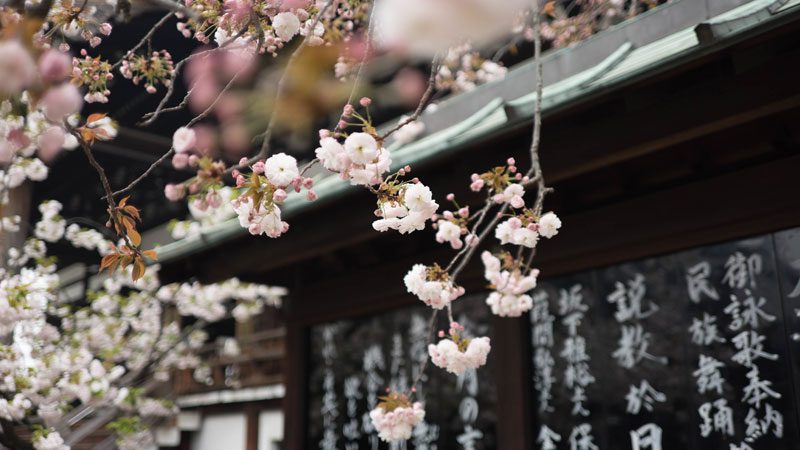
It’s 4pm in Tokyo and I’m deep underground, a puzzled expression on my face. I peer at my map with its colour-coded tangle of lines, trying to navigate the Japanese capital’s complex subway system. With a hefty suitcase by my side and a backpack full to bursting, I’m desperately trying not to look like a lost tourist – but I’m failing. On the platform, a young lad in school uniform spots my confusion and asks me in English if I need help. “You look lost, let me help you,” he says with a smile, before pointing me in the right direction.
This is not the only time I experienced help from a total stranger during my two-week trip to Japan . On a separate occasion, I asked a man for directions to Shinjuku Gyoen, a beautiful park in central Tokyo. The man took 10 minutes out of his day to walk me right to the gates. Another local, instead of simply saying ‘sorry’ and turning away, took out her phone and translated Japanese to English to give me information on a museum opening time.
It’s a willingness to help I’ve rarely experienced in other countries – and just one of the reasons that the country is so good for solo travel, and in particular, for solo female travel.
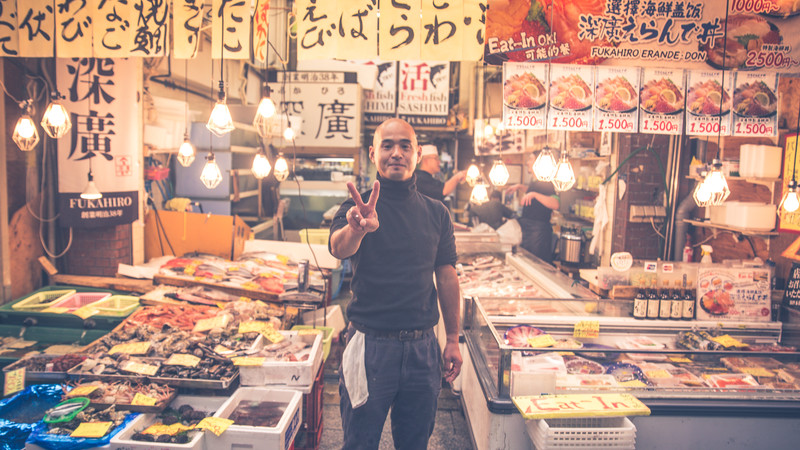
Credit: Benemac
I travel a lot on my own, but I was still slightly nervous about heading to Japan solo. Its language, culture and food are all completely alien from anything I’m used to, so I knew I was heading out of my comfort zone.
I needn’t have worried. For starters, Japan is the safest country in Asia – and one of the safest in the world – according to the Global Peace Index. During my trip, I spotted a group of women in Tokyo who left their bags at a table as they went to order coffee – presumably safe in the knowledge that the country benefits from very low levels of crime. And yet, clearly it’s wise not to be lulled into a false sense of security, but to take the normal precautions you would at home.
Of course, one of the best things about solo travel is that you get to experience the world on your own terms. It’s just you, away from your everyday life, meeting new people and having fascinating experiences in fresh surroundings. Travelling alone also gives you the opportunity to indulge whatever interest you might have, whether that’s touring the country by bicycle or a particular restaurant you want to visit.
SUBSCRIBE TO INTREPID’S NEWSLETTER FOR TRAVEL INSPO, COMPETITIONS, GIVEAWAYS & MORE
If you’re not used to travelling on your tod, a great way to warm up to it is to head to a restaurant. Eating on your own is totally normal in Japan, particularly in ramen bars and ‘izakaya’, which are like the Japanese version of a gastropub.
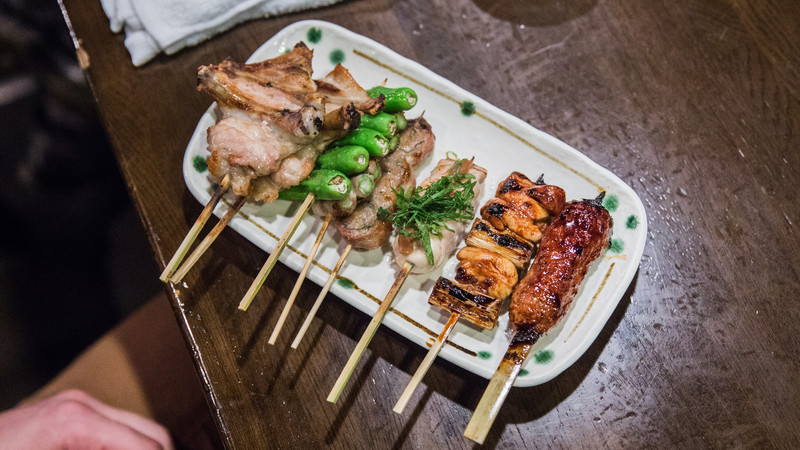
On my first day in Japan, in Osaka, I joined locals in a ramen bar across from my hotel at lunchtime. Slipping onto the counter next to a line of office workers, I watched the way they huddled over their bowls and deftly slurped the steaming noodles. With no companion to distract me from taking the scene in, or to embarrass with my table manners, I gave it a go – and left with broth all over my chin but a newfound determination to master the skill.
RELATED: A LOCAL’S GUIDE TO VISITING JAPAN ON A BUDGET
Of course, you don’t have to be on your own for long as a solo traveller. Alone, you are more approachable and it’s easier to make new friends. I joined Intrepid’s new 14-day Cycle Japan trip with six other holidaymakers, all of us keen to explore the country in a more adventurous way – on two wheels – than your average journey by coach and train.
By day we were unified as a group – pedalling past some of Japan’s most beautiful and varied landscapes all together like an overexcited peloton. And yet, come the evening or during free time, it was easy for me to slip off on my own to sip sake with the locals at an izakaya, glimpsing a side to the culture that you only see when alone, observing and listening, your senses more alert than in a group scenario. It was the best of both worlds. On the one hand, I was sharing my experiences with like-minded travellers who, like me, wanted to see Japan by bike. On the other, I was alone, free to set my own schedule at my own pace and, ultimately, able to get a richer understanding of the extraordinary country I found myself in.
WHAT IT’S REALLY LIKE CYCLING FROM FROM OSAKA TO TOKYO
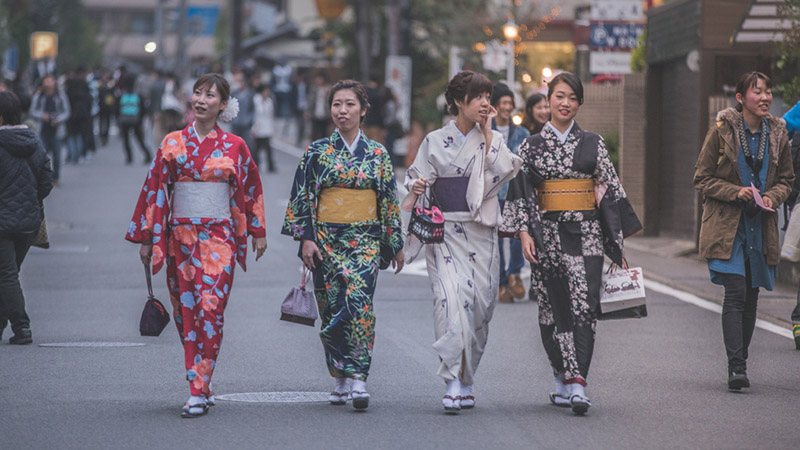
Tips for solo female travellers in Japan:
- Rent a portable wifi device: For a country that’s so modern in so many ways, free wifi is not as available as you might imagine. If you’re travelling alone, make your life easier by ensuring you have data to look up trains, information and maps when you need.
- Book ahead: Unlike many backpacker-friendly destinations, it’s not so easy in Japan to improvise when it comes to accommodation. Many hotels book up quickly, so it’s wise to book in advance.
- Plan your itinerary: You don’t want to wander about aimlessly. It’s a good idea to share this with someone at home, or let someone on your group trip know where you’re going if you’re heading out alone.
- Always have cash on you: Japan is predominantly a cash-based society – many businesses don’t accept cards and ATMs don’t accept all foreign cards. You don’t want to be stranded with no money on you.
- Learn some Japanese: It’s always a good idea to learn a few handy words and phrases when travelling to a foreign country, particularly when you’re on your own. Keep some like “ tasukete kudasai ” (please help me) and “arigato” (thank you) up your sleeve.
- Carry your hotel business card: You can then show this to a taxi driver or a local if you get lost.
- Know what to wear: Women in Japan tend to dress conservatively. Blend in by covering your shoulders and opting for loose-fitting garments.
- Call 110 for emergencies.
Ready to roll solo? Lots of our travellers do it. Check out our range of new solo trips (and our range of small group adventures in Japan ).
Written by Ellie Ross. Follow more of her adventures at ellieross.co.uk
Feeling inspired?
Ellie Ross is a freelance journalist and travel writer, specialising in active travel and adventure. Once a windsurfing instructor in Greece, she now spends her time writing about (and testing out!) everything from new mountain bike races in New Zealand to skiing with the ski patrol in the French Alps and competing in the world's only uphill swimming race Red Bull Neptune Steps in Glasgow's locks. When she's at home, Ellie can be found running, surfing or on her yoga mat.
You might also like
From delhi to udaipur, here are the five..., travel globally and think locally with intrepid leader..., follow the leader: tu vu will never stop..., turkey’s most underrated experience: mountain biking in cappadocia, the best thing about a family tour seeing..., why ninh binh and lan ha bay should..., love elephants here’s why you should visit mandalao..., why you should visit the most peaceful place..., what it’s like spending the night in a..., 10 things i wish i knew before hiking..., what i wish i knew before hiking to....

COMMENTS
Japan is one of the most popular tourist destinations in the world. Most people dream of going to Japan, but there are a few important things you need to know before planning a solo trip to Japan. Compared to lots of other Asian countries, Japan is super easy to travel in and great for people who are new to travelling alone.
Tips for Traveling Solo in Japan. Have cash. Everything I had read said that Japan is a cash society. I found that many places take credit cards including the hostels and ryokans where I stayed, 7-Elevens that are everywhere and many restaurants. While I used my credit card a lot, having cash was an imperative.
Solo Travel in Japan. In past decades, most solo traveler in Japan used to be the ubiquitous salarymen (office workers) on business trips. These days, however, many locals, especially the younger generations, are increasingly traveling alone or doing things by themselves, creating a unique market aimed at singles.
Solo travel in Japan. Despite the challenges of travelling solo in Japan, I do believe it's a fantastic solo travel destination. I can't wait to return one day and would happily go back as a solo traveller. If you're questioning whether travelling alone in Japan is right for you, I hope you find the below post useful.
ULTIMATE Guide to Solo Travel in Japan | Destinations & Tips for 2023. Japan is the DREAM for many curious travelers. Manga, anime, sushi, cherry blossoms, Nintendo, Toyota, hot spring pools, Buddhist temples; the thought of these lit a fire in me! But with no one willing to tag along for the ride, I had to start planning a Japan solo travel trip.
In fact, traveling alone to Japan is not a terrible thing, but something that you will fall in love with unconsciously. As I said at the beginning, there is a first time for everything. So whether you are "the first time to travel to Japan" or "the first time to travel to Japan alone", as long as you have not been to Japan many times, today's ...
8. Ensure That a Japan Railways Pass Is Cost Effective Before Buying One. For many years, the passes sold by the Japan Railways (JR) group are among the best deals in the global travel industry. Particularly attractive for traveling alone in Japan because they perfectly complement solo traveling itinerary flexibility.
Solo Traveler's Guide to Japan. I've had my share of meltdowns while solo traveling around the world, but one of my memorable meltdowns was less than an hour after getting off my flight to Tokyo, when I stopped at a convenience store to buy a bottle of water.. Like any other country, there were a variety of drinks to choose from: You got your mineral water, flavored water, and energy water ...
1) Be Prepared…You Won't Be Able to Read Anything. As you solo travel Japan, you'll quickly see that there is a distinct lack of English signage. 'It's cool I'll just follow the signs'… said no one in Japan. Ever. Well, unless of course, you can actually read Japanese.
Traveling alone in Japan is one of the best ways to encounter the country's culture, food, and nature. From Kyoto to Kanazawa, there are many solo traveler-friendly spots with memories waiting to be made. Learn about how to plan your trip and safety tips for a great vacation.
When it comes to solo travel, I can't think of a better country than Japan. Efficient public transit, English signage, and a customer service-oriented culture make traveling to Japan alone a breeze. In fact, my very first solo trip was a week in Japan. I wandered the bustling streets of Tokyo, hiked mountains, and marvelled at famous castles.
Solo Travel Safety. Japan is safe according to the Global Peace Index, which ranked Japan as the ninth most peaceful country in the world based on violent crime, safety and security, and other peace factors. You may even notice Japanese people saving seats at restaurants by placing their wallets on the table.
Aman Tokyo. After touching down in Tokyo in the evening, I headed straight to Aman Tokyo, a secluded oasis tucked away from the city's bustle. After crashing early, I woke the next day at ...
Hakone. Nestled in Japan's beautiful mountains, Hakone is the perfect destination for solo travellers looking to explore a different side of this incredible country. The Hakone area is known for its relaxing Onsen (hot springs), unspoiled nature and breathtaking views of the iconic Mount Fuji which looms over the area.
Regardless of the particulars of your traveling to Japan alone, your checklist for traveling to Japan is probably long and detailed. However, many of the best parts of traveling to Japan are intangible—specifically, the connection you feel to the land the Japanese people have called home for so many millennia, and the beautiful cities they've built throughout the ages.
Try group solo travel to Japan with Flash Pack - designed exclusively for people in their 30s and 40s, seeking the independence of solo travel within the safety of a group. A cool 98% of Flashpackers arrive solo to join our group adventures. So, you'll be in good company - whether a first time solo traveller or a seasoned pro looking for ...
Travelling alone in Japan: Our top tips for a solo trip. 日本での一人旅. Freedom, cultural immersion, and unforgettable encounters: solo travel in Japan will be an experience like no other. Discover a place where every step will lead to a unique adventure, where spontaneity and authenticity come together. Travelling solo in Japan means ...
A woman in the group asked me if I'd been afraid traveling alone in Japan. In terms of safety, I hadn't at all. Tokyo is regularly ranked the safest city in the world. But of course, safety ...
16. Fukuoka: eat your way around the city. Fukuoka is the biggest city on Kyushu Island and the 7th biggest city in Japan. And while Fukuoka has many things to do, the best highlight has to be its culinary scene. The city is known for its Hakata Ramen or Tonkotsu Ramen.
These 12 things about Solo travel in Japan and It will HELP YOU be better prepared on your next trip! making you a better traveller. Traveling around Japan...
A good place to stay overnight is the town of Nagato. Guesthouse Neruyama is a 35-minute bus ride from the Nagato-Yumoto train station and offers tasteful single rooms with tatami-matted futons ...
travelling alone in Japan is safe and easy with the trains. To get around Japan, I wholeheartedly recommend the JR Pass. Get a Japan Rail Pass. The JR Pass is the most economical way of traveling throughout Japan by rail. It allows you to travel on all JR national trains in Japan, including the Shinkansen bullet trains and Narita Express.
Travelling as a female in Japan is rewarding - and it's getting easier. There are now several train companies that have introduced women-only carriages, while some hotels, hostels and ryokan (Japanese inns) are also female-only. Of course, one of the best things about solo travel is that you get to experience the world on your own terms.